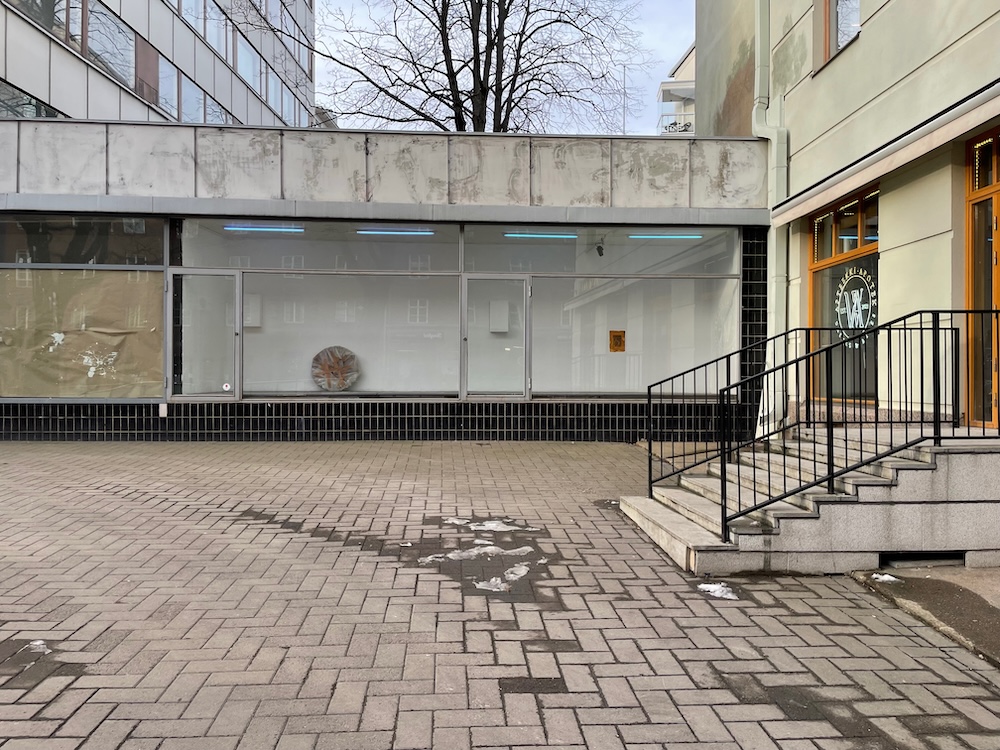
[FIN] LUKAS MALTE HOFFMANN on Helsingissä asuva taiteilija joka työskentelee kuvanveiston ja installaation parissa. Malte Hoffmann teki Alkoviin muuntuvan näyttelyn käyttäen tilaa vuoden ajan. Näyttely oli esillä lokakuusta 2024 lokakuun 2025 loppuun asti.
[ENG] LUKAS MALTE HOFFMANN is an artist based in Helsinki working with sculpture and installation. Malte Hoffmann made a changing exhibition to Alkovi utilising the space for a year. The exhibition was on view from October 2024 until October 2025.
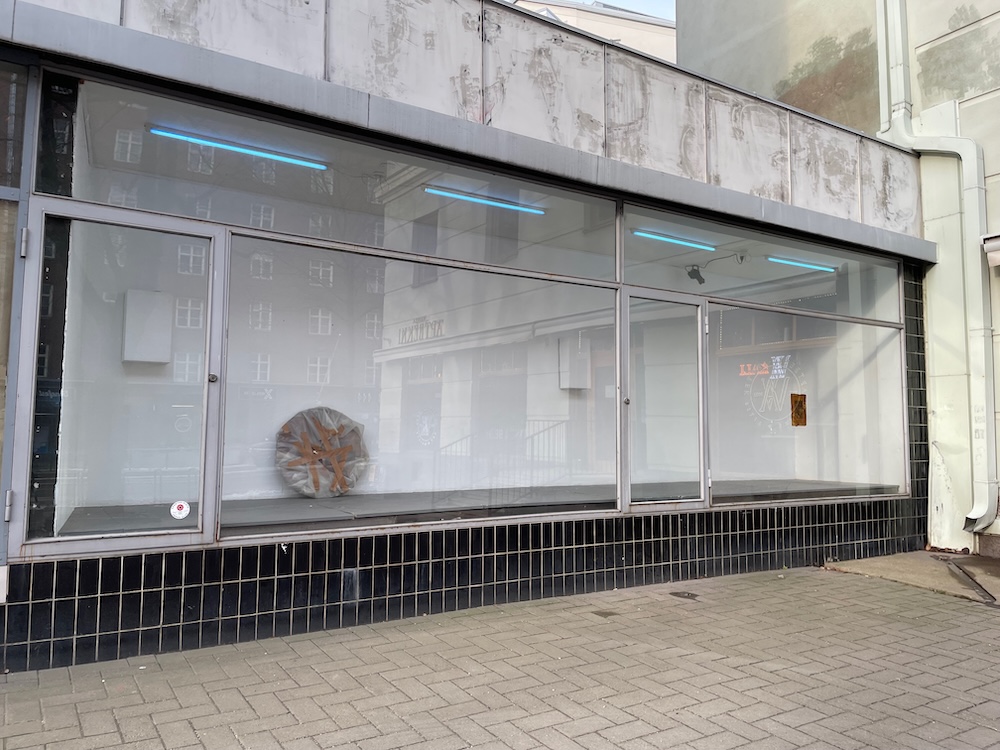







MIA WENNERSTRAND
[FIN] Mia Wennerstrand otti Alkovin tilan haltuunsa kesäkuussa 2023 ja on esillä syksyyn 2024 asti. Mia Wennerstand on taiteilija, joka työskentelee monipuolisesti eri ilmaisumuotojen kanssa. Alkovissa oli esillä tekstejä joissa Mia oli kirjoittanut auki sitä kaikkea mikä tulee työn eteen, henkilökohtaisista kriiseistä politiikkaan.
[ENG] Mia Wennerstrand was presented in Alkovi from June 2023 until September 2024. Mia is an artist having a multifaceted approach to art-making. Presented in Alkovi were her texts in where Mia wrote open all that which becomes in front of the work(-in-progress), from personal crises to politics.
& Mia took over also ALKOVI's Instagram until Autumn 2024.






TOP / YLÖS
KAKSI RUNOA: Eeva Kilpi, Naiset huutakaa & Harry Salmenniemi, Lumisella rannalla
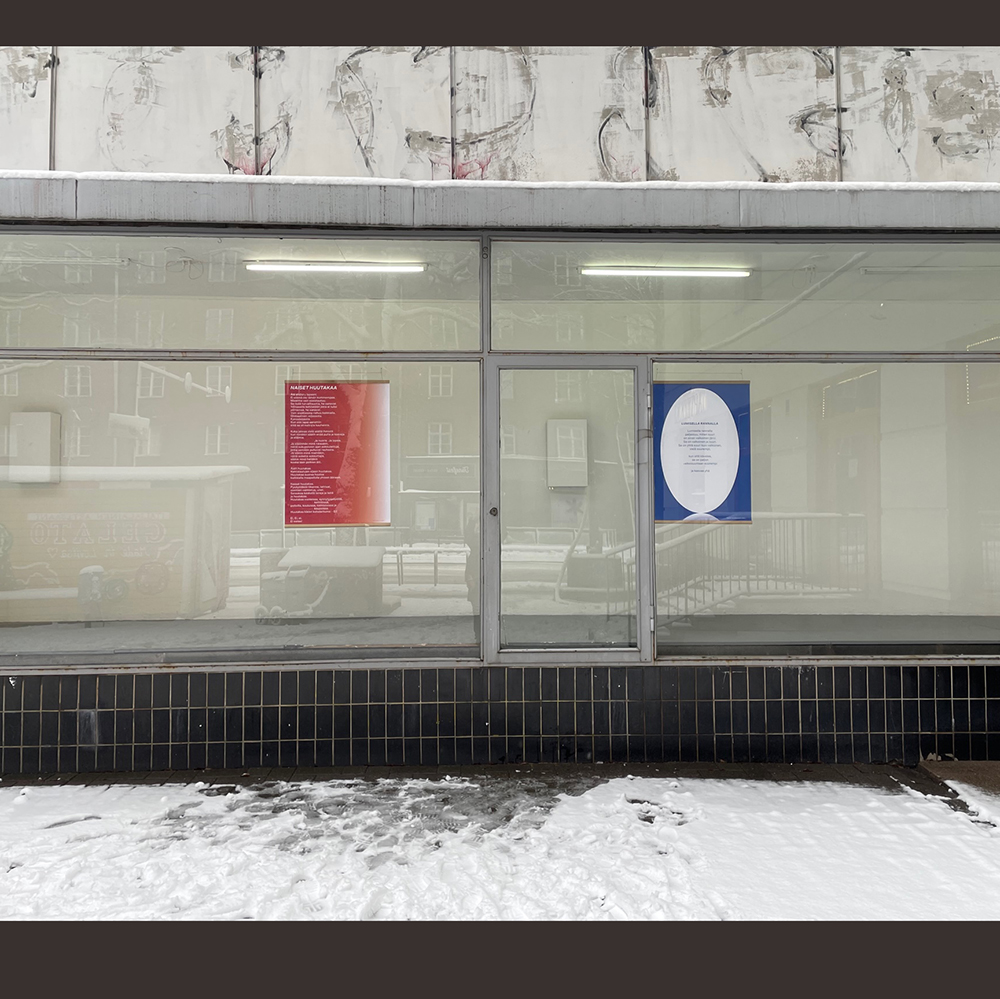
18.2.-28.5.2023
[FIN] Esillä oli kaksi runoa: Eeva Kilven Naiset huutakaa ja Harry Salmenniemen Lumisella rannalla.
Runot olivat esillä vuoden 2022 Rauma Triennaalessa Imagine! Mitä jos!
[ENG] Displayed were two poems in Finnish: Naiset huutakaa (Women, Shout) by Eeva Kilpi and Lumisella rannalla (On a snowy beach) by Harry Salmenniemi.
Poems were a part of Rauma Triennale 2022 Imagine! What if!
Imagine! Mitä Jos! -näyttelyn kuraattorit olivat Rauman taidemuseon intendentti Heta Kaisto ja taiteilija Teemu Mäki./ The curators of the Rauma triennale were the chief curator of Rauma Art Museum Heta Kaisto and artist Teemu Mäki.
Julisteiden graafinen suunnittelu: / The graphic design of the posters by Teemu Mäki & Jaakko Pietiläinen.
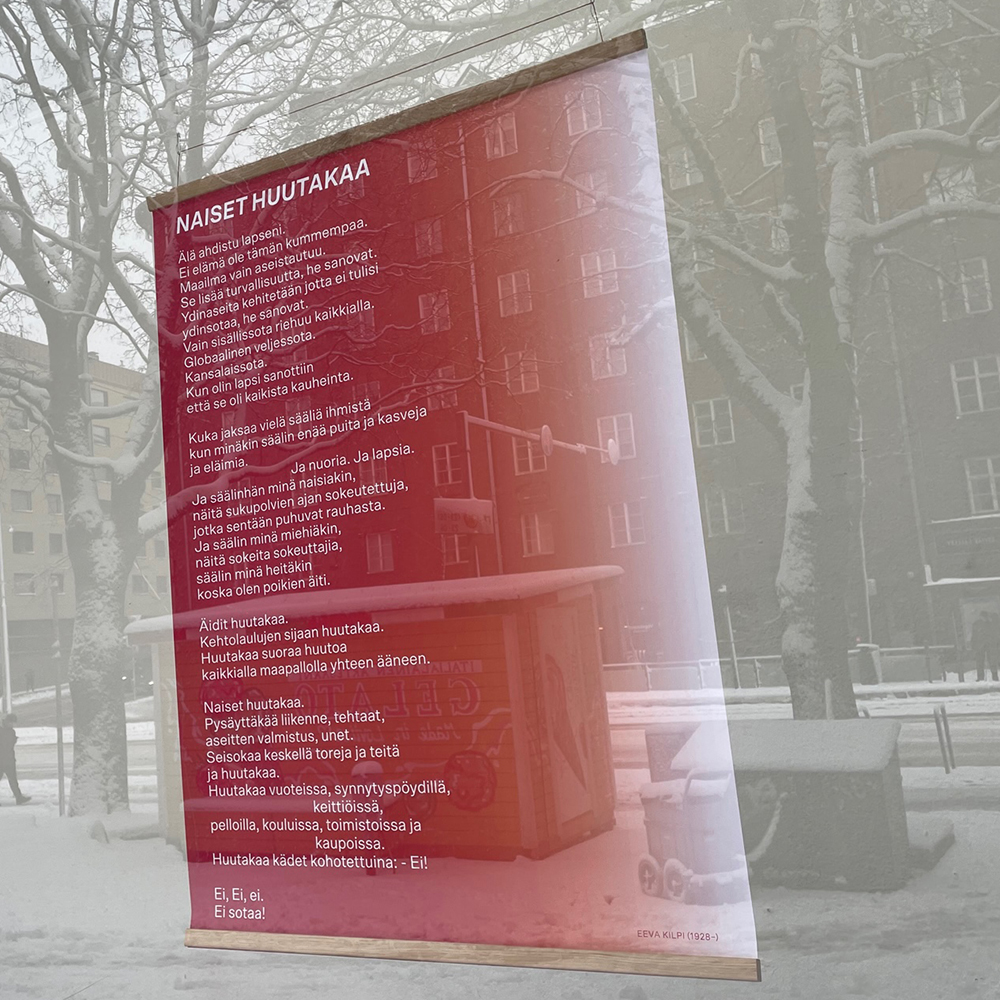

TOP/ YLÖS
Esitys hyväksi elämäksi osa 2. | Joulukalenteri / Christmas calendar
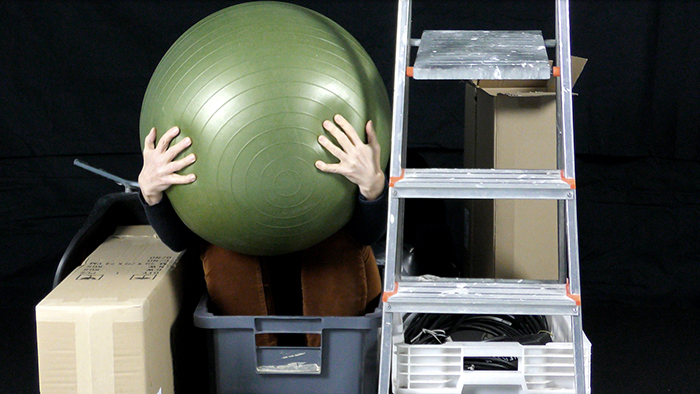
[FIN] Esitys hyväksi elämäksi on kolmiosainen esitystaiteen hanke, joka saanut alkunsa Tuuja Jänicken ja Marja Silden pohdinnoista liittyen hyvinvointivaltion tulevaisuuteen maapallon rajattujen resurssien kontekstissa. Maailma on monimutkaistunut merkittävästi, länsimainen käsitys demokratiasta, hyvinvointivaltiosta, kansalaisuudesta ja humanitaarisuudesta on tullut erilaisille rajoilleen. Projektin ensimmäinen osa oli esillä vuonna 2019 Nykytaiteen museo Kiasmassa ja myöhemmin Helsingin kaupungin kirjastoissa. Nyt esitetty toinen osa toteutui kahtenakymmenenäneljänä lyhyenä videoteoksena. Väljänä kehyksenä oli joulukalenterin muoto, missä joka päivä vaihtuva videoteos projisoitiin 24 päivän ajan paikassa, jossa on kuhinaa ja mahdollisuus yllättää satunnaiset ohikulkijat ja hengailijat. Videoiden läpikäyvänä teematiikkana on muutos. Käynnissä olevan globaalin muutoksen yksikkönä kuvissa on ihmisruumis.
[ENG] Esitys hyväksi elämäksi (a presentation/proposal for a good life) is a performance project divided in three parts. It has begun from the thoughts of Tuuja Jänicke and Marja Slide touching on the future of the welfare state in the context of the limited resources of the planet. The world has become more complex, and western concept of democracy, welfare state, citizenship, and humanity have all come to their various borders. The first part of the project was presented in 2019 at the Contemporary Art Museum Kiasma and later at the libraries of the city of Helsinki. At Alkovi presented second part consisted of 24 short video works. As a loose framing of the concept was the form of a Christmas calendar, where a video work changed daily and was projected to a site that has activity and the possibility to surprise the people passing by and hanging around. The thematic of the videos is change. And the unit of the ongoing global change is the human body.
Teksti / Text by : Tuuja Jänicke, Marja Silde
Tapahtuma-aika / The duration: 1.-24.12.2022
Tapahtumapaikka / Location: Alkovi, Helsinginkatu 19, Kallio
Työryhmä / Working group: Tuuja Jänicke, Hilla Kurki, Marja Silde
Tekniikka / Techical staff: Steve Mahler, Pietu Pietiäinen, Thomas Södergård
Esiintyjät / Performers: Markku Arokanto, Max Bremer, Wilhelm Grotenfelt, Tiina Huczkowski, Laura Jänicke, Hilla Kurki, Marjut Ollitervo, Soili Huhtakallio, Marja Silde, Mervi Varja
Tuotanto / Production: Teatteri Venus / Universum
TOP / YLÖS
Yun-Jung Hsieh & Praejeen Kunawong :
KINSHIP
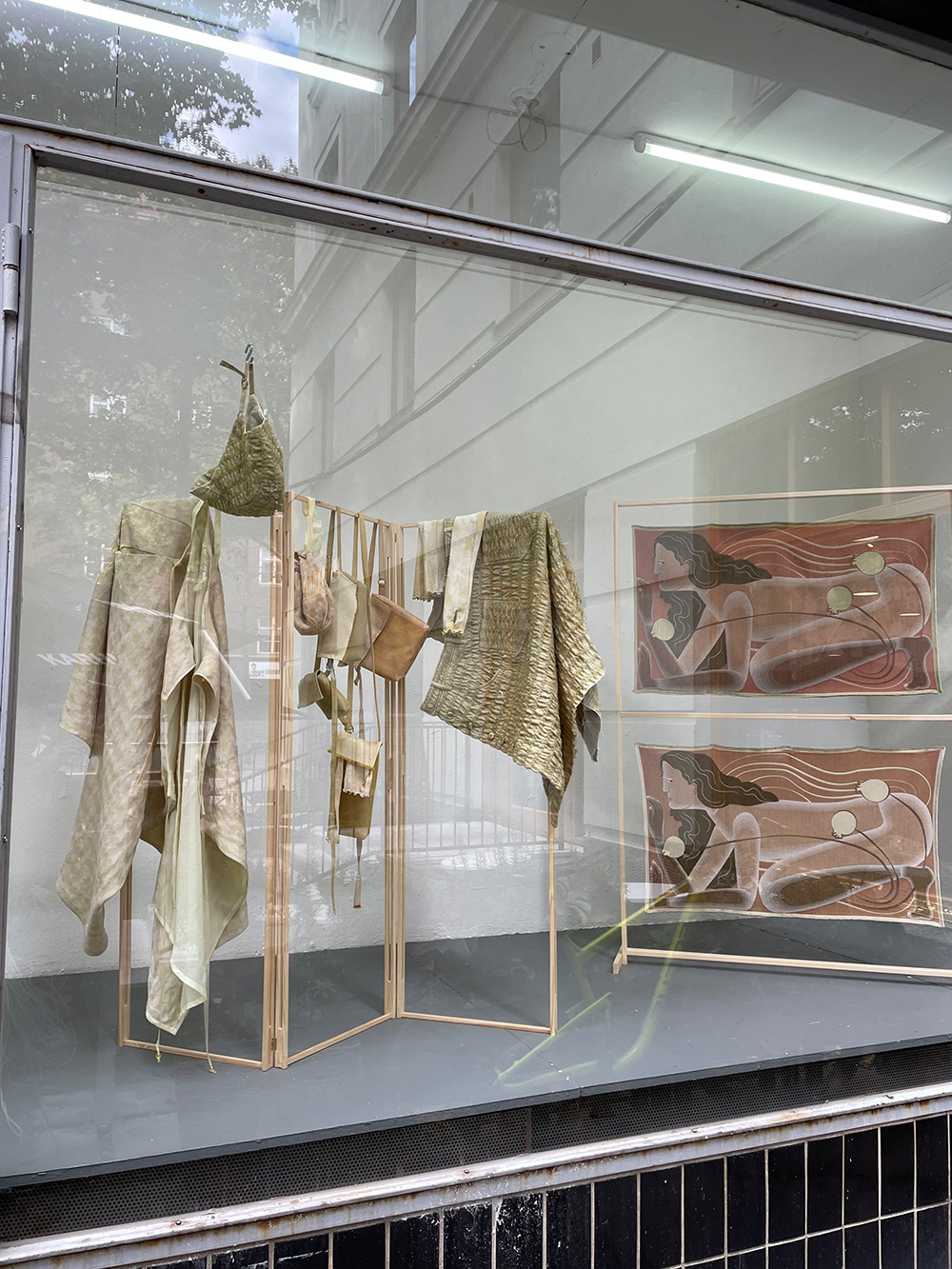
Yun-Jung Hsieh & Praejeen Kunawong :
KINSHIP
[FIN] Alkovi syleili 'näyteikkunuuttaan' näyttelyssä Kinship jossa oli esillä kahden (vasta valmistuneen ja valmistuvan) tekstiilisuunnittelijan Praejeenin ja Yun-Jungin teoksia. Nimi "Kinship" edusti heille luonnon ja ihmisen välistä sidettä - joita kumpikin suunnittelija tulkitsi omalla tavallaan tutkailleessaan luonnonväreillä värjäämisen mahdollisuuksia.
"Praejeen tutkii keinoja joiden kautta eri kutomistekniikat voivat tukea luonnon väreillä värjäämistä. Hänen tavoitteenaan on esittää, että luonnonväreillä värjätty lanka on kestävä ja esteettinen vaihtoehto tekstiilien luomisessa. Ollen huolissaan suuresta määrästä luonnonvaroja joita tarvitaan kasvattamaan raaka-aineita teolliseen laatuun vaadittavaan tekstiintuotantoon sekä suuresta määrästä ruoka-jätettä joka päätyy kaatopaikalle kulutuksen jälkeen, Praejeen päätyi käyttämään langan värjäysporsessissaan ruuan tuotannon sivutuotteita. Materiaalit - kuten granaattiomenan kuoret, käytetyt kahvinpurut, avokadon kivet ja kuoret, sekä punaisten ja keltaisten sipulien kuoret - on kerätty lahjoituksina ruuan toimittajilta Helsingin ja Espoon alueelta. Langastaan toteutetuissa seinävaatteissa Praejeen ilmaisee arvostustaan luonnolle ja värjäämistaidolle. Raaka-aineiden muodot vääntyvät abstrakteiksi viivoiksi, samalla kun herkät värit päällystävät naisen käsiä ja jalkoja esittäen tahroja värjääjän iholla rankan päivän jälkeen.
Yun-Jungin pyrkimyksenä on tuoda yhteen luonnonväreillä värjäämisen taito ja koulutuksensa muodin ja tekstiilisuunnittelun saralla. Hankettaan varten hän loi vaatteita ja asusteita esittääkseen sipulinkuorilla värjätyn tekstiilin potentiaalia, joka on suunniteltu erityisesti muotikäyttöön. Hänen matkansa alkoi kuosien kehittelemisestä ja sopivan materiaalien valinnasta jokaiselle suunniteltavalle kappaleelle, jota seurasi tarkka ja huolellinen kokeilu eri lämpötiloilla ja värjäysyhdistelmillä. Hänen prosessinsa toi myös odottamattomia yhdistelmiä, kun kudotut rakenteet ja pinnan värit muuttuvat värjäämisen jälkeen. Nämä muutokset dokumentoitiin jotta lopulta saavutettaisiin suunnittelijan haluamat vaikutukset. Tämän mini-kokoelman kappaleet luotiin jokaisen tekstiilin uniikin olemuksen perusteella ja viimeisteltiin kietomalla tekstiilit hyvin vapaasti mannekiinien tai ihmiskehojen päälle. Tekstiilit ohjastivat Yun-Jungia ja antoivat hänen suunnittelunsa kasvaa orgaanisesti."
[ENG] ALKOVI space embraced its 'display-windowness' in the exhibition that was presented up until the beginning of October.
Kinship was a co-exhibition on natural-dyed textiles created by Praejeen and Yun-Jung, two textile designers (one recently graduated and one graduating). The name "Kinship" represents for them the bond between nature and humans - a concept interpreted uniquely and separately by the two designers as they explore ways to bring natural dye to sophisticated production.
"Praejeen explores ways that weaving practices can complement a variety of natural dye colors. Her work aims to present natural-dyed yarn as a sustainable and aesthetic option for textile creation. Concerned with the vast resource needed for growing industrial-grade raw materials and the large amount of food waste headed toward landfill after consumption, she opted to use food by-products for her yarn-dyeing process. Her materials--donated by food providers in the Helsinki and Espoo area - included pomegranate rinds, used coffee grounds, avocado pits and peels, and skins of red and yellow onions. In the wall -hanging textiles she created with her yarn, Praejeen expresses appreciation to nature and the art of dyeing. The shapes of the raw materials distort into abstract lines, while delicate colors cover the women's arms and legs in a representation of the stains on dyers' skins after a hard day's work.
Yun-Jung seeks to bring together the art of natural dyeing and her training in fashion and textile design. For her project, she created garments and accessories to showcase the potential of her onion-dyed textile, designed specifically for fashion usage. Her journey began with pattern developing and material selection for each design, followed by meticulous experimentation with different temperature and dye combinations. Her process sometimes brought about unexpected results, as woven structures and surface colors can change after dyeing. These changes were documented to ultimately achieve the designer's desired effects. The pieces in this mini fashion collection were created based on the unique character of each textile and were completed by wrapping textiles freely on mannequins or human bodies. The textiles guided Yun-Jung and allowed the design to grow organically."
Näyttely-teksti / Exhibition content writer: Naomi Hwang
Praejeen Kunawong:jeenku.cargo.site
Yun-Jung Hsieh: hsiehyunjung.cargo.site
TEKIJÖIDEN HAASTATTELU /
AN INTERVIEW OF PRAEJEEN & YUN-JUNG: INTERVIEW
TOP / YLÖS
JUHA VALKEAPÄÄ:
TULIPÄÄ / FIREHEAD
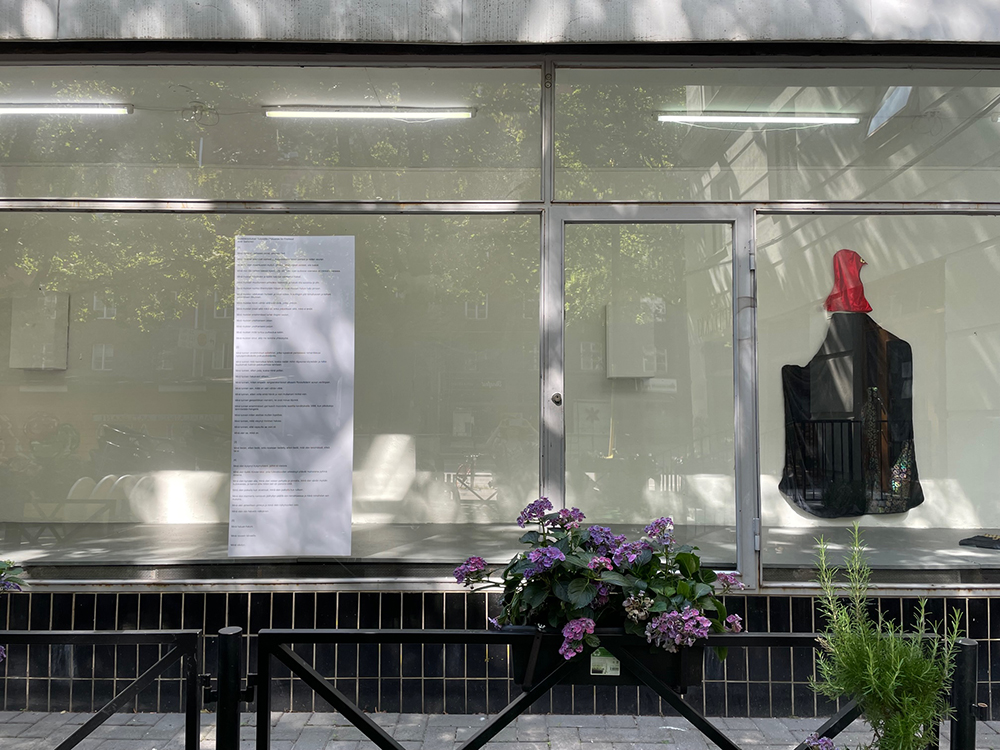
[FIN] Alkovissa oli esillä Juha Valkeapään jatkuvan perfomanssin 'Tulipää' esitysasun osia, sekä filosofi Antti Salmisen teosta varten toteuttama muistokirjoitus, joka on osa muistokirjoitusten sarjaa, joita Valkeapää on lukenut osana perfomanssiaan.
Valkeapää kirjoittaa:
"Monille se on ollut selvää jo pitkään, ja jotkut ovat jopa uskaltaneet tunnustaa asian. Valtavirtaa siitä on tullut vasta nyt, mutta yhä jotkut kieltäytyvät hyväksymästä sitä, kun taas jotkut käärivät häikäilemättä kaikki taalat taskuun. Nimittäin jos poltamme kaikki maassa olevat fossiiliset polttoaineet, kaiken hiilen, öljyn, kaasun - maailma palaa. Tulipää on muistokirjoitus fossiilisille polttoaineille ja maailman hallitsijan, valkoisen, keski-ikäisen cis-miehen, omakuva. Mitä tuli tehtyä? Kaduttaako häntä? Hävettääkö? Yhäkö hän luulee olevansa kuolematon?
Lainaan Richard Powersin Ikipuut-romaania (suom. Sari Karhulahti): "Eräs toimittaja kysyi kerran Rockefelleriltä, mikä riittää. Hän vastasi: 'Se, että saa vielä vähän lisää.'"
Tulipää on performanssi, katuruno, hautakivi, olento joka ilmestyy. Se on taiteilijanimi, jota en alkanut koskaan käyttää. Se on palavan öljyn kohinaa rikkauksien keskellä.
Tulipään suullinen ilmaisu on enimmäkseen sanatonta mutta aika ajoin hän tarttuu megafoniin ja puhkeaa huutamaan, kuiskaamaan, resitoimaan, laulamaan fossiilikapitalismille kirjoitettuja muistokirjoituksia, joita olen pyytänyt kirjailijoilta, tutkijoilta, toimittajilta.
Kadulla, toreilla, kaupungintalojen, valtuustosalien ja fossiilikapitalismiin selkeästi liittyvien rakennusten läheisyydessä, julkisissa sisätiloissa. Erilaisten festivaalien yhteydessä ja ilman festivaaleja. Fossiilimaailman merkkipäivinä.
Vuodesta 2022 kunnes fossiileja ei enää polteta.
En ole tehnyt Tulipäätä yksin. Keskustelukumppaninani on toiminut Arttu Merimaa, asun on suunnitellut ja toteuttanut Tero Nauha. Asun taidegrafiikka ja Tulipään käyntikortit ovat Tero Nauhan ja Vargas Print Studion käsialaa. Saappaat tuunasi Sam-Sam. Juha Valkeapään Ääni on tuottanut ja Taiteen edistämiskeskus tukenut. Kiitos! Kiitos myös muistokirjoittajille!"- Juha Valkeapää
Kaikki muistokirjoitukset luettavissa: Muistokirjoitukset Tulipäälle.
[ENG] On display at Alkovi were parts of the attire of Juha Valkeapää's ongoing performance 'Firehead' as well as an obituary written by philosopher Antti Salminen. (In Finnish only). Valkeapää recites as part of the piece obituaries written by different authors.
Valkeapää writes in relation to the work:
"Many have known it for ages, and some have even dared to admit the fact. Only now it has become mainstream but still there are people who refuse to accept it, while some pocket all the money there is to be made with it. Namely, if we burn all the fossil fuels there is in the ground, all the coal, oil, gas - the world is going to burn. Firehead is an obituary for fossil fuels, and a self-portrait of the emperor of the world, white, middle-aged, cis male. What has he done? Does he regret, feel shame? Does he still think he is immortal?
In his novel, The Overstory, Richard Powers writes, how a journalist once asked Rockefeller, what is enough. Rockefeller answered, if I could get a little bit more. Firehead is a performance, a street poem, a tombstone, a creature that appears. It is the stage name I never started to use (my family name is translated usually as whitehead but it can be translated as firehead, too). It is burning oil roaring in the midst of wealth.
The majority of Firehead's vocal expression is wordless but now and then he grabs his megaphone and speaks out, recites, yells, whispers obituaries for fossil capital(ism). Various writers - authors, researchers, journalists - are writing obituaries for Firehead to perform.
In the streets, at close proximity of parliament buildings and those of big oil, public indoors. At various festivals and without festivals. On the anniversaries of the fossil world.
Starting in 2022 and going on until we don't burn fossils anymore.
I've not made the Firehead all by myself. Arttu Merimaa has discussed it with me. Tero Nauha designed and crafted the attire, and Tero, with Vargas Print Studio, designed the art graphics for the attire & business cards. Sam-Sam tuned the boots. Juha Valkeapää's Voice has been producing and Arts Promotion Centre Finland has supported the work. Thank you all! And thank you, all obituarists!" - Juha Valkeapää
All the obituaries can be read: Obituaries for Firehead.
-- Tulipää ilmestyi Alkoville 28.8. kello 15:00-16:00 & 2.9. kello 15:00-16:00.
Firehead was present at Alkovi on 28th of August from 3pm to 4pm and on 2nd of September from 3pm to 4pm.
---- Aiemmat ilmestymiset / Earlier appearances: Helsinki (Muu | Myymälä2 | Lunastakaa lupaukset -mielenosoitus / Fulfill the promises demonstration | sunnuntaikruisailu x 6 / Sunday cruising x 6 | päiväkävely x 1 / Afternoon walk x 1), Espoo (Fortum).
Kaikki muistokirjoittajat / All of the obituary writers: Felipe de Ávila Franco, Nnimmo Bassey, Taru Elfving, Megan Grumbling, Pasi Heikkurinen, Jenni Laiti, Lasse Leipola, Michael Marder, Grace Nichols, Emma Puikkonen, Tuulia Reponen, Antti Salminen, Ann Wroe / The Economist.
TOP / YLÖS
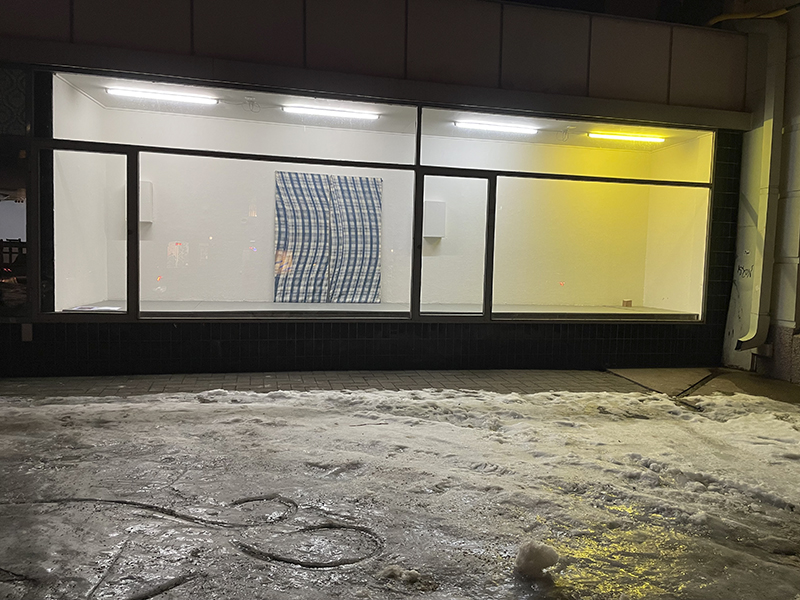
Mikko Kuorinki: S/T
12. Helmikuuta - 12. Toukokuuta 2022 / 12th of February to 12th of May, 2022*
*Extended a bit after / Jatkui hieman
Mikko Kuoringin näyttely S/T rakentui ja muuntui esilläolonsa ajan, ainesosat sekä teot luetteloitiin verkkosivuille:
/
Mikko Kuorinki's exhibition S/T was build and changed during its presentation. Ingredients and acts were listed to the website:
https://kuorinki.com/works/st/
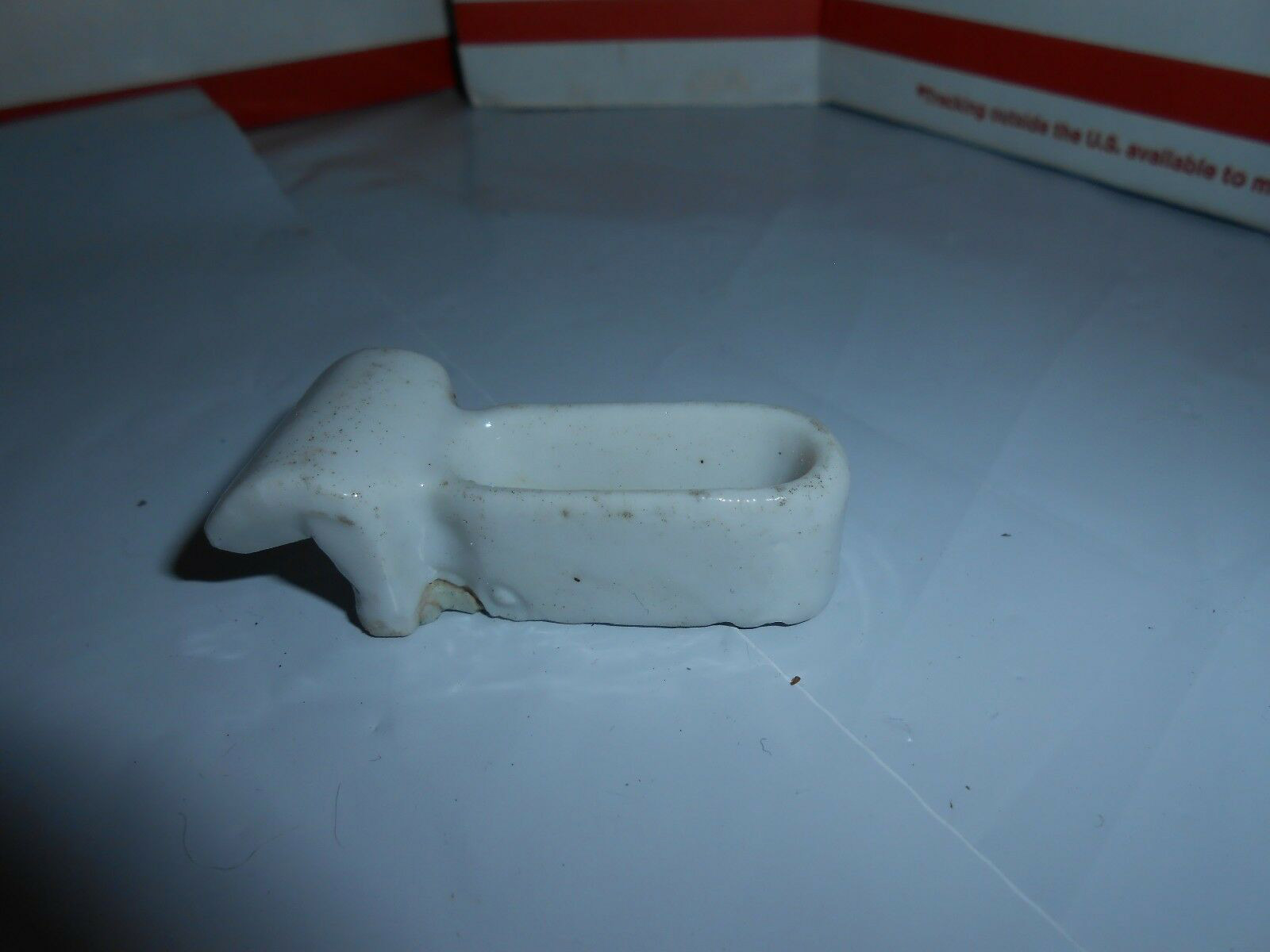
Kuva/Image: richer treasures 2012/ Ebay.
RARE CRUDE VTG/ANTIQUE PORCELAIN BIRDCAGE SMALL GRAVEL SEED TREAT FEEDER "GOOD CONDITION FOR IT'S AGE. HAS SOME AGEING, WEAR, SMALL MINOR NICK MANUFACTURE FLAW POSSIBLE HERE OR THERE. DOES NOT LEAK, IS NOT CRACKED. NO SERIOUS CHIPS. A BIT OF DUST, DIRT, IN SPOTS. SIGNED JAPAN. NOTE, FLAWS, DUST, DIRT WILL BE MAGNIFIED BY THE CAMERA. PLEASE VIEW THE PHOTOS CLOSELY, I DO MY BEST TO DESCRIBE THE CONDITION, NOTING ANY FLAWS. HOWEVER I'M ONLY HUMAN AND I MAY MISS SOMETHING"
ESSAY:
Let's start by attuning to some words. Alkovi is an art space set in a display window. That in Finnish is 'näyteikkuna' and could literally also be translated as 'a sample window'. This opens for me an avenue into thinking about the things placed inside it as samples of material thinking - thinking in materials as ways of exposure. What art is in some form of essence.
This is what the current 'exhibition' has subtly but directly been, placing "things" on view. 'Näyttely' which is the Finnish word for 'exhibition' has for me the connotation of 'vilauttelu'. That is perhaps best translated and described as an act when someone very briefly shows him or herself (or some object) to others/viewer(s). "Flashing" maybe in correlating word in English. Something that has a hint of sinister in it. But more so something that is not in full view, nor could be but temporarily seen, in a moment in sight.
As exhibition builds up so that the 'finished' piece is presented - or in a case when trying to evade that (that the thing in view is constantly being build or reshuffled, becoming temporally performative) - the element of announcement becomes a site of tension and decision.
Proclaiming that something is done, a deed is conducted, is found in the practices seeking closure, even if it might only be some form of a rest (and) stop. Found in situations when a statement is to be made to satisfy both the audience and the one looking for a resolution (for a while at least). That is the lure of a 'finished work' or an exhibition as well.
The impossibility of denying the desire for this moment becomes clear when you find yourself faced with the notion of 'termination' - an ending to your process, project or "journey" so to speak. You can say that everything in essence is a constant movement, but just like returning from a holiday or a trip 'outside' (a walk perhaps) - there has been points of entry and exit. You have made them with varying level of intention perhaps, but seeking to solidify the experience they are there.
An artwork and an exhibition as such provide these solidifications and moments for trying to grasp something because escape from these solidifications also becomes tangible. What did I look here if no-thing? Meaning making is also about getting lost in discoveries.
But, here I'll return to the thing 'in place': announcement of the - not culmination - but perhaps ' compilement' of acts done with materials presented in Alkovi by Mikko Kuorinki under the title S/T during the timeframe of mid February 2022 until mid May 2022. It's not a resolution but I think it might feel like it.
I think highly of artists performing 'aesthetic care'. Maggie Nelson writes in her book 'On Freedom: Four Songs of Care and Constraint' (2021)': "[...] aesthetic care is of a different order from other forms of care. It appears not care directly for others because it doesn't. Aesthetic care entails caring about other things, such as paper quality, pigment, gravity, oxidization, chance, pattern, the dead, and the unborn. All of this is also the world, also constitutes forces to which one might feel compelled or obliged. That such forces do not always make their claim on us via human bodies or ethics is no reason to doubt the intensity of vitality of their calls."
Text by Miina Hujala
Aloitetaan tarkastelemalla joitain sanoja. Alkovi on taidetila, joka sijaitsee näyteikkunassa. Joka siis voisi myös tarkoittaa näyte-ikkunaa. Tämä kuljettaa ajatteluani kohti näkemystä, että asiat joita asetetaan Alkoviin ovat jonkinlaisia 'näytteitä aineellisesta ajattelusta' - ajattelusta, joka ilmenee materiaalien esille asettamisen tapoina. Jota taide siis on jonkinlaisessa olemuksellisuudessaan.
Nyt esillä oleva näyttely on ollut juuri tätä, eli hienovaraista mutta suoraa "asioiden" asettamista nähtäville. Minulle 'näyttely' suomen kielen sanana rinnastuu sanan 'vilauttelu' kanssa. Joka tarkoittaa lyhytkestoista paljastamista, pitäen sisällään myös eräänlaisen "tuhman" tunnun. Mutta ennen kaikkea jonain jota ei voi nähdä kuin hetkellisesti ja ohimennen.
Näyttely rakentuu sille, että 'valmis' teos esitetään - ja tilanteessa jossa pyrkimyksenä on paeta tätä (eli kun se mitä laitetaan esille on koko ajan rakentumassa ja uudelleen muodostumassa olevaa, hetkellisesti esityksellistä) - tulee julkistamisesta ja julkilausumasta jännitteinen päätöksenteon kohta.
Kun väitetään että 'jotain on tehty' ja 'teko on toteutettu', etsitään tällä julistavalla käytännöllä päätepistettä - vaikka se olisikin vain hetkellinen pysähdys (ja) tauko. Julkilausuma tehdään tyydyttääkseen sekä yleisöä että sitä joka etsii edes väliaikaista ratkaisua. Tähän perustuu koko houkutus tehdä 'valmis teos' tai 'näyttely'.
Mahdottomuus kieltäytyä halustaan tähän 'pysähdyksen hetkeen' kohdataan ajatuksessa "lopettamisesta" - joko prosessin, projektin tai niin sanotun "matkan". Voidaan sanoa, että kaikki on olemuksellisesti liikkeessä, mutta kuitenkin palaamiseen lomalta tai retkeltä - jostain "ulkoa" (kävelyltä kenties) - sisältyy niin ulos menon sekä sisään paluun kohdat. Nämä ovat muodostuneet kenties eri tasoisin huomionannon muodoin, mutta kun tavoitellaan kokemuksen haltuunottoa ne paikantuvat.
Taideteos ja näyttely sinänsä tarjoavat näitä tiivistymiä, ja hetkiä jolloin yrittää tavoittaa jotain, koska pako näistä huomionannon kiinnityksistä myöskin tulee käsin koskeltavaksi. Mitä katsoin, jos en-mitään? Merkityksen muodostamisessa on kyse myös löydöksiinsä eksymistä.
Mutta tässä kohtaa palaan asiaan, jonka 'äärellä' olemme: ilmoitukseen, kenties ei lopputulemasta, mutta 'kasaantumasta' tekoja materiaaleilla joita esitettiin Alkovissa Mikko Kuoringin näyttelyn S/T aikana helmikuun 2022 puolivälistä jatkuen toukokuun puoliväliin 2022 asti.
Se ei ole loppuratkaisu, mutta voi tuntua siltä.
Arvostan paljon taiteilijoita jotka harjoittavat 'esteettistä huolenpitoa'. Maggie Nelson kirjoittaa kirjassaan 'On Freedom: Four Songs of Care and Contraint' (2021): [...] esteettinen hoiva on erilaista kuin muut hoivan muodot. Vaikuttaa ettei se suoraan välitä muista koska se ei välitäkään. Esteettinen huolenpito tarkoittaa muista asioista välittämistä; kuten paperin laadusta, väriaineesta, painosta, hapekkuudesta, sattumasta, kuvioista, kuolleista ja syntymättömistä. Kaikki tämä on myös maailmaa, ja myös muodostaa voimia jotka joku voi kohdata määräävän kutsuvina tai velvollistavina. Vaikka tällaiset voimat eivät aina esitä vaatimustaan ihmiskehojen tai etiikan kautta se ei ole mikään syy epäillä niiden kutsun elinvoimaista vahvuutta."
Teksti: Miina Hujala (Maggie Nelson lainauksen käännös omani).
TOP / YLÖS
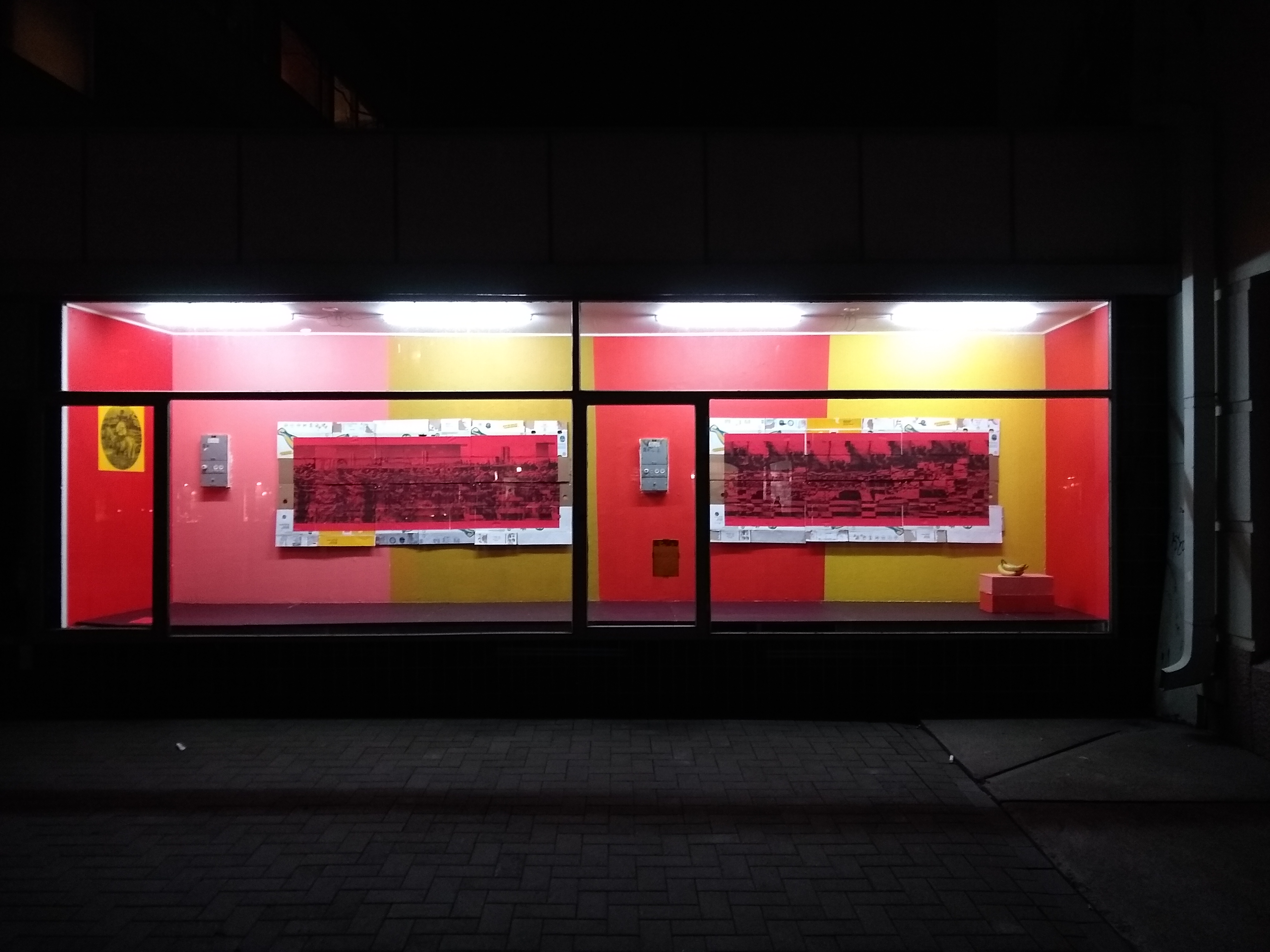
Pattern is the Detail of Movement
A process-poetry installation by RED FOREST.
Es la hora de los hornos, y no se ha
de ver más que la luz.
JOSE MARTI
Provocation No.1
* Forced displacement, erosion, and exhaustion is the pattern of the present domination.
* Extractivism is the motor of imperialism.
Extractivism can be understood as the result of a one-directional attention to environments. Capitalist conceptions of economic growth, encoded in technologies of engagement, impose a rhythm to the organic composition of energy by turning it into a speculative value measured in its propensity to extraction. These dynamics are further linked to anthropocentric and colonialist-driven conceptions of how life should be lived, which is at heart of contemporary alienation.
It was on April 1967, in La Habana, Cuba, where the Organization of Solidarity with the People of Asia, Africa, and Latin America-OSPAAAL received Ernesto Che Guevara's letter questioning the 21th anniversary of cease to the Global Conflict. Underlining the cynicism of United Nations' peace celebrations, Che dared to ask "21 years without World War?" This letter remarked on the ongoing military interventions led by the United States and their affiliated imperialist nuclear block, weaving the flag of liberal order and capitalist progress, to justify war crimes to date unaccounted. Che Guevara's addressed people's revolutionary necessity: "It is up to us, the exploited and wretched people of the world, to eliminate the bases of imperialism's sustenance." The call remains valid, as the voracity of capitalist exploitation grows in the time of a global catastrophe. Today, the Zapatista Army continues to remind us that we live a time of total war, a war threatening our capacity to sustain life on Earth. In the need to reclaim potentialities that are immanent to the liberation of time and the time for liberation: Revolt, repair, and restore our relations with land and imagination!
RED FOREST is a collective that grounds together research, art, political imagination, and social actions thriving for transformative justice and ecological reparations. In 2021 they initiated a pan-continental research focusing on the intersections between contemporary extractivism and datification processes. Red Forest assembles and organises their work with infrastructures of collective reciprocity and interdependency as actual potentiality. Their research contributes to the theoretical framework of Energetic Materialism to conceptualise urgent cultural and social processes in the defence of life and the construction of pluriversal futures in dignified flux.
Red Forest is mobilized by David Muñoz Alcántara, Diana McCarty, Mijke van der Drift and Oleksiy Radynski, after their collective practices collided during a 2019-2020 BAK Fellowship in Utrecht. It unfolds as a growing constellation of artists, activists, researchers, media producers, filmmakers, philosophers, educators and time travellers realizing interdisciplinary projects.
The current Red Forest research project Energetic Materialism Laboratory is done with the support of the Kone Foundation.
TOP / YLÖS

ELINA JUOPPERI
valokuvanäyttely / photography exhibition
-
nimetön
digitaalinen vedos silkille / digital print on silk
2020, Frankfurt
-
Taivaskokoelma / Collection of Skies
L.A, Pariisi, Ranska Etelä-Korea, Suomi, Frankfurt / L.A, Paris, France. South Korea, Finland, Frankfurt
Digitaalinen vedos silkille / Digital print on silk
2011- jatkuva (on going)
-
nimetön (Jälki)
digitaalinen vedos diasecille / Digital Print on Diasec
2016 /2021
Nimetön ja Taivaskokoelma teosten tuotantoa on tukenut basis e.V./ AIR_Frankfurt. / The execution of 'nimetön' and 'Taivaskokoelma' has been supported by basis e.V./ AIR_Frankfurt
nimetön (Jälki) teoksen on mahdollistanut Alkovi. / 'nimetön (Jälki)' work has been made possible by Alkovi.
Seinän väri / wall colour: Rabb's fringe-limbed treefrog,
Ecnomiohyla rabborum, extincti 2016
Lattian väri / floor colour: Pinta Giant Tortoise
Chelonoidis abingdonii, extincti 2015
Värien valinnassa työkaluna IUCN Red List: sukupuuttoon kuolleet lajit - extinct, EX. Red list on raportti, johon on koottu tieto eliölajien uhanalaisuudesta ja niiden
uhanalaisuusluokituksesta.
Red List has been used as a tool in the the selection of the colors in the space.
extinct: according to the International Union for Conservation of Nature (IUCN) Red List of Threatened Species, the world's most comprehensive inventory of the global conservation status of biological species.
Ripustuksessa käytetyt käsintehdyt tiilet ovat Torniosta 80-luvulla puretusta 1700-luvun talosta. / The hand made clay bricks used in the installation are from 18th century house that was dismantled in Tornio at the 1980's.
[FIN]
Tilan tavalla
Elina Juopperin lähestymistapa välttelee perinteisiä taiteentekemisen väline- ja lajirajoja. Tekninen riippumattomuus avaa hänelle mahdollisuuksia tutkia ideoiden ja sisältöjen ilmenemistä mitä moninaisimmissa materiaaleissa, sosiaalisissa vaikutussuhteissa ja historiallisissa konteksteissa. Teosten aihepiiritkin ulottuvat laajalle, henkilökohtaisten tunteiden ja kokemusten tulkinnoista kollektiivisen muistin merkityksiin.
Pitkään Ranskassa asuneena ja siellä opiskelleena Elina Juopperi luo hienovaraisia mentaalisia tiloja, jotka kytkeytyvät ennen kaikkea historiaan kiinnittyvään ja modernismin traditioita purkavaan käsitetaiteen keskieurooppalaiseen kehikkoon. Esimerkiksi ajan kuluminen on Juopperin 'menetelmänä' pidempiaikaisissa prosessiluonteisissa teoksissa, joista huokuu kunnioitus olemassaolon haurautta ja häviävyyttä kohtaan. Samalla hän ready made -hengessä kyseenalaistaa taideobjektin alkuperäisyyden ideaalia. Valokuvaus on hänelle ennen kaikkea käsitteellinen menetelmä, jossa kokemuksen henkilökohtaisuus korostuu ja samalla haastaa perinteisiä käsityksiä dokumentaarisesta totuudesta. Erityisesti Juopperi on kiinnostunut niistä taiteen aistienvälisistä ja aineellisista merkityksistä, joita älyllinen logiikka ei yksin kykene paljastamaan.
Alkoviin Elina Juopperi on luonut kokonaistaideteoksen, jossa sisätilaan ripustetut valokuvaperusteiset printit toimivat ikään kuin sidosaineina sisä- ja ulkotilan rakenteellisille yksityiskohdille ja kulttuurisille kerrostumille. Taiteilijana Juopperi ei kuitenkaan halua tarjota 'valmista' ratkaisua, vaan jättää tilaa katsojan omien assosiaatioiden yhdistelylle. Teoksen tulkintahorisontti on tälläkin kertaa avara, ja näkökulmista riippuen ajatukset voivat kiertyä henkilökohtaisista kokemuksista yleisiin ja metaforisiin sisältöihin ja merkityksiin.
Tekstin on kirjoittanut kuraattori Marketta Haila.
Näyttelyn on kuratoinut Miina Hujala & Arttu Merimaa.
[ENG]
Following the Space
Elina Juopperi avoids in her artistic approach the traditional limits of art fields and techniques. Her technical independence offers her possibilities to explore the manifestations of ideas and contents in a multitude of materials, social interdependencies and historical contexts. The themes of her works vary widely from interpretations of personal feelings and experiences to meanings of collective memory.
Juopperi has studied in France and lived there for many years; she creates exquisite mental spaces which draw upon the central European tradition of conceptual art, sensitively connected to history and critical of modernist traditions. For example, Juopperi uses the passing of time as a ''method'' in her long term process-type works which display respect for the fragility and evanescence of existence. At the same time, in a ready-made spirit, she questions the ideal of the originality of the art object. For her, photography is above all a conceptual method which puts emphasis on the personal nature of experience and simultaneously challenges traditional notions of documentary truth. In particular, Juopperi is interested in the multi-sensorial and material meanings of art that the intellectual logic alone cannot reveal.
In Alkovi, Elina Juopperi has created a total work of art in which photographic prints hung indoors act as binders for the structural details and cultural layers of the interior and exterior. But being an artist, Juopperi does not want to offer a"complete" solution; instead, she offers for viewers space to build up their own associations. Once again, the horizon for interpretations is left open; depending of the perspective, thoughts can circulate from personal experiences to shared metaphorical meanings and contents.
Text has been written by curator Marketta Haila, and translated by Haila and Juopperi.
Exhibition has been curated by Alkovi / Miina Hujala & Arttu Merimaa.
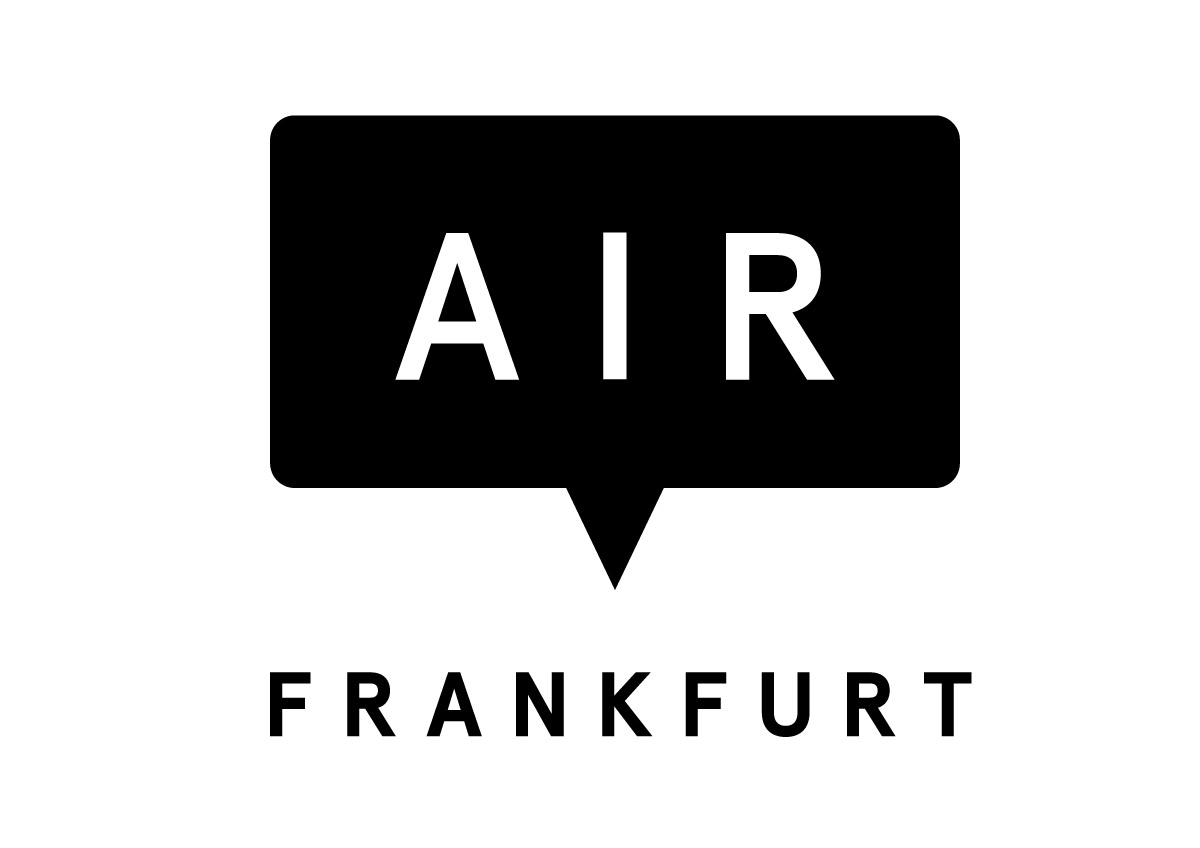
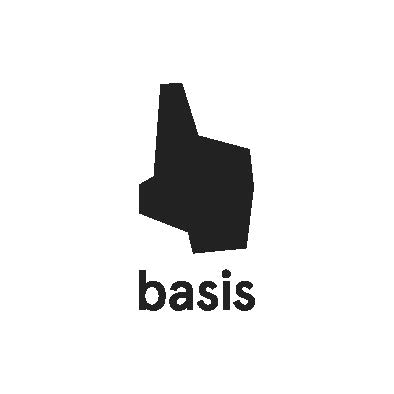
TOP / YLÖS

[INTERMISSION-SARJA / SERIES]
RYBN.ORG
THE GREAT OFFSHORE
5.6.-13.6.2021
[FIN] Intermission-sarjassa esitettävät näyttelyt ovat lyhytkestoisia sekä projektiluonteisia. Tämän näyttelyn toteutuksesta taiteilijoiden kanssa vastasi m-cult - mediataiteeseen ja digitaaliseen kulttuuriin keskittyvä organisaatio.
The Great Offshore on taiteellinen tutkimusprojekti joka käsittelee veroparatiisitalouden sisäisiä mekanismeja, verkostoja ja toimijoita sekä sitä, kuinka offshore-talous vaikuttaa lainsäädäntöön ja luo vyöhykkeitä sen tavoittamattomiin.
RYBN.ORG esittää Alkovin näyttelyssä sarjan kaavioita, jotka kuvaavat veroparatiisiyritysten keinoja maksimoida voittoa: Keinoja ovat mm. verosuunnittelu, rahanpesu kryptovaluuttojen tai taiteen avulla sekä keinottelu vastuuvapaudella ja oleskeluluvilla.
RYBN.ORG tarjosi myös Offshore-kierroksia Helsingissä. Offshore-kierrokset ovat kollektiivisia psykogeografisia harjoitteita, jotka perustuvat Panaman paperien paikannusdataan sekä ICIJ -tietokantaan. Osallistujat kutsutaan mukaan tutkimaan monikerroksista kaupunkitodellisuutta, metsästämään haamuyhtiöitä ja keräämään hienovaraisia vihjeitä, joita Offshore-talous jättää jälkeensä urbaaniin ympäristöön.
Näyttelyn tuotti taiteilijoiden kanssa m-cult osana European Media Art Platform EMAP-residenssiverkostoa.
RYBN.ORG on pariisilainen taiteilijakollektiivi joka tutkii monialaisesti talouden ja teknologian todellisuuksia.
RYBN.ORG
The Great OffShore
[ENG] 'Intermission' is a series of exhibitions that have a shorter duration and are project-based in their nature. This exhibition is executed as a collaboration between the artists and m-cult - an organization focusing on media art and digital culture.
The Great Offshore was a long term artistic research on offshore finance that aims to highlight its inner mechanisms, its networks and agents, and how it shapes legislations and creates new extra-territorialities.
In Alkovi, RYBN.ORG exhibited a series of conceptual diagrams of optimization processes, the Algoffshores, designed from the perspective of the ultimate beneficiaries and conceived to maximize profitability through tax evasion, launder money through art or crypto-currencies, get rid of liability, liquefy citizenship, etc.
RYBN.ORG also invited participants to Offshore Tours in the city of Helsinki. Offshore Tours are collective psychogeographic dérives based on geolocalized data of the Panama Papers and the ICIJ Database.
Participants are invited to explore the city's multi-layer realities, hunt ghost companies and collect the discrete signs offshore finance has left on our surrounding urban environments.
The exhibition is co-produced by the artists and m-cult in context of the European Media Art Platform EMAP's residency programme.
RYBN.ORG is an artist collective based in Paris, leading extradisciplinary investigations on
complex systems within the realm of finance, economics and technologies (High-
Frequency Trading, Algorithmics, Offshore Finance, etc.).
RYBN.ORG
The Great OffShore
m-cult is an agency to develop and promote new forms of media art and digital culture, with a focus on cultural and social aspects of media and technology. A Helsinki-based non-profit organisation founded in 2000.
TOP / YLÖS
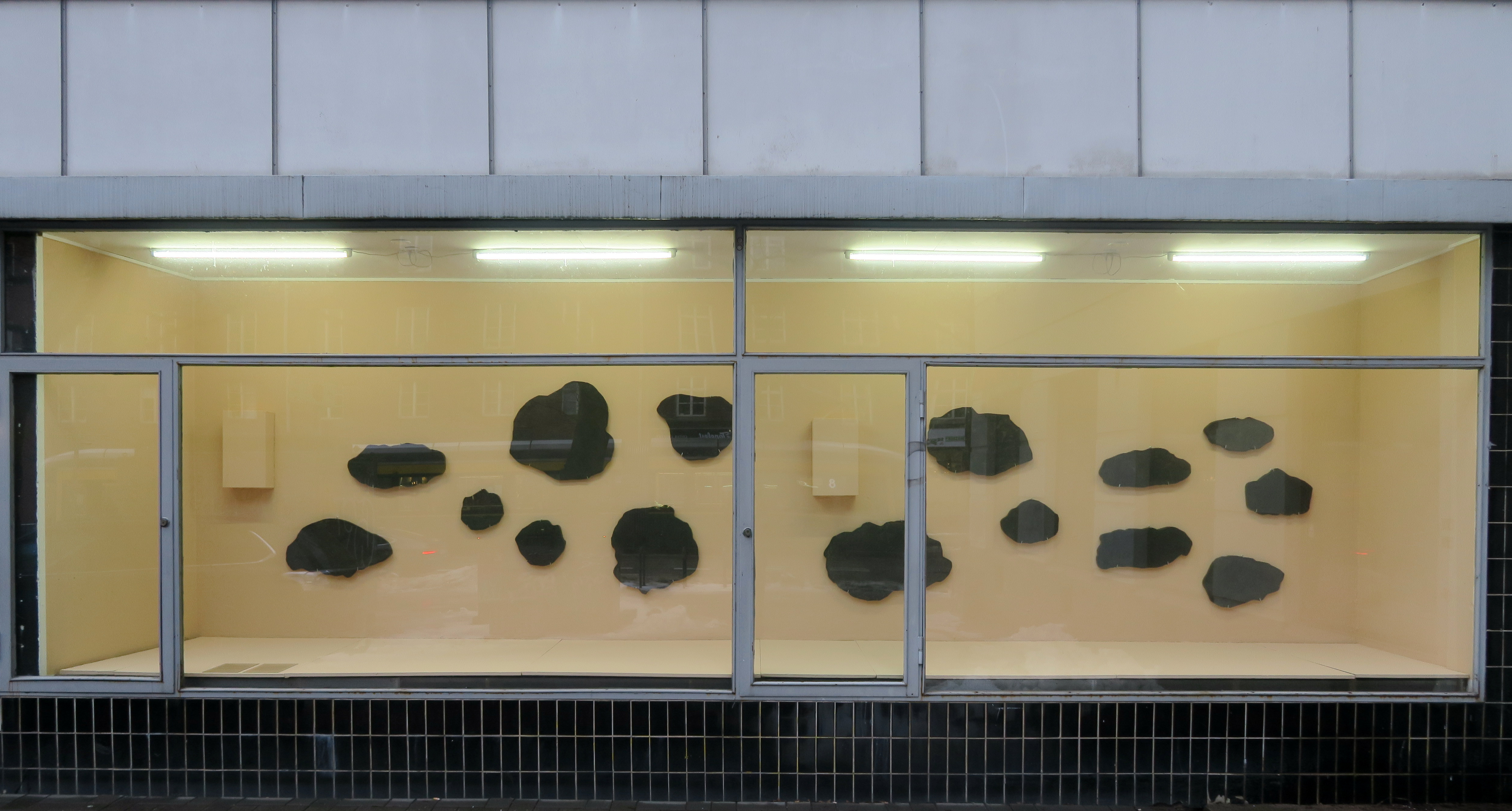
ELIZAVETA KONOVALOVA:
Script, 2021
-
[FIN] Valettuja jäljennöksiä jalkakäytävän pinnasta, jossa on jälkiä jään rikkomisesta
Alkuperäinen materiaali: asfaltti
-
'Script' teos tarjosi "arkeologisen perspektiivin" nykykaupungin maisemaan. Huomionkohteena olivat jään pintaan vahingossa jätetyt jäljet, jotka ilmestyvät Moskovan kaduille tietyn toiminnan - jään rikkomisen - seurauksena. Venäjällä käytetään työkalua nimeltä «лом» (lom) tähän tarkoitukseen.
Lom on eräänlainen esihistoriallisen keihään perijä, anakronismi, "yksi kaikkein vanhimmista työkalutyypeistä jonka ihmiskunta tuntee" (kuten venäläisessä Wikipedia artikkelissa ilmaistaan). Sitä ei käytetä vain jään rikkomiseen, vaan lom on niin sanotusti monikäyttöinen. Sen on tarkoitus rikkoa mitä tahansa - esimerkiksi vaikka seinän taikka oven. Palomiehet samoin kuin myös ryöstövarkaat käyttävät sitä. Lomtermi tulee verbistä 'lomat' - rikkoa. 'Lom' sanalle ei ole suoraa vastinetta muissa kielissä. Venäjäksi lom tarkoittaa myös romumetallia. Tämä saa työkalun vaikuttamaan vielä alkeellisemmalta, eräänlaiselta pohjaavalta voimavaralta. Huomionarvoista on, että lomin keksimisen jälkeen, sen muoto tai käyttötapa eivät ole muuttuneet. Lom on periaatteessa pysynyt samanlaisena raskaana metallitankona, jonka käyttöön liittyy raakaa voimaa.
Jään rikkomisen jälkiä löytyy kaikkialta: asfaltista, katukivetyksestä - erityisesti, ja erityisellä tiheydellä - rakennusten sisäänkäyntien luota, bussipysäkkien ympäriltä sekä suojateiltä. Jäljillä on erilaisia muotoja: pyöreitä, pitkulaisia, teräviä tai tylppiä tangon kärjen mukaan - ulottuen myös eri syvyyksiin jalkakäytävän päällysteen sekä iskun kovuuden mukaan. Jäljet muodostavat erilaisia yhdistelmiä, sekalaisia tai järjestäytyneempiä, tuoden esiin kenties käyttäjän luonteen tai mielialan, muistuttaen jonkinlaisia fossiileja tai salattua nuolenpääkirjoitusta. Teksti: Elizaveta Konovalova
Elizaveta Konovalova (s. Moskova 1986) opiskeli Ecole Nationale des Beaux-Artsissa Pariisissa ja vuonna 2018 väitteli tohtoriksi monitieteellisen tutkimushankkeensa 'K' tiimoilta, joka käsitteli Kaliningradia - venäläistä erillisaluetta Itä-Euroopassa.
Hän yhdistelee työskentelyssään kenttä- ja dokumentaarista tutkimusta, ja Konovalan teoksiin kuuluu niin installaatioita, filmi-, sekä valokuvapohjaisia teoksia kuin paikkasidonnaisia teoksia. Vuonna 2019 Elizaveta Konovalova oli kolme kuukautta HIAPissa residenssissä liittyen yhteistyöhön Vladivostokissa sijaitsevan Zarya taidekeskuksen kanssa.
Näyttely on osa residenssiorganisaatio HIAP:in (Helsinki International Artist Programme) venäläis-suomalaiseen yhteistyöhön keskittyvää Connecting Points-ohjelmaa, sekä liittyy erityisesti vuosien 2017-2020 aikana toteutettuun 'Useissa raunioitumisen vaiheissa'-tutkimushankkeeseen. Hanke keskittyi erilaisten käsitteiden tarkkailuun liittyen tiedon muodostumiseen ja informaation levittämiseen, maisemaan, matkustamiseen, muistiin, historiaan, museoihin ja raunioihin - ottaen erityisesti taiteellisen työskentelyn metodit ja muodot osaksi tutkimusta.

[ENG] Casted replicas of pavement surfaces presenting traces of ice breaking
Original material: asphalt
'Script' offered "an archaeological perspective" on the landscape of a contemporary city. Traces, left accidentally by a person on a surface, were in focus. These traces are noticed on the streets of Moscow due to a specific practice - the ice breaking. In Russia a tool called «лом» (lom) is used for this purpose.
Lom is a kind of an heir to a prehistorical spear, an anachronism, "one of the most ancient types of tools known to mankind" (states the Russian wikipedia article). It is not used for ice breaking only, lom is multipurpose, so to say. It is meant to break anything - it could be a wall, or a door. Firemen use it, as well as robbers. Lom comes from the verb 'lomat' - to break. There is no exact equivalent of 'lom' in other languages. In Russian lom also means scrap metal, which makes the tool look even more elementary, as a kind of primary resource. It is noteworthy that since the invention of lom, its shape and method of use have not undergone any changes. Lom basically has remained a heavy iron stick, and its use is associated with brute force.
Traces of ice-breaking are found everywhere: in asphalt, in paving slabs - especially and with particular concentration at the entrances of buildings, around bus stops and pedestrian crossings. The traces have different shapes: round or oblong, sharp or obtuse, defined by the shape of the spearhead, and depth, depending on the hardness of the pavement and the force of the impact. They make up different compositions, chaotic or more orderly, probably translating the mood or the character of the user, and resemble some kind of fossils or encrypted cuneiform. Text by Elizaveta Konovalova.
Elizaveta Konovalova (b. Moscow, 1986) studied art at the Ecole Nationale des Beaux-Arts in Paris, and in 2018 defended her PhD in visual arts with a multidisciplinary research project «K», dedicated to the Kaliningrad region, exclave of Russia inside Eastern Europe. In her practice, she combines field and documentary research. Her works include installations, film- and photography-based works, site-specific interventions. In 2019 Elizaveta Konovalova stayed three months in Helsinki as artist-in-residence as a part of a collaboration with Zarya Center for Contemporary Art in Vladivostok.
Exhibition was a part of residency organization HIAP's (Helsinki International Artist Programme) Connecting Points-program that focuses on collaboration and exchange between Finnish and Russian art practitioners. This exhibition is related to a research project 'In Various Stages of Ruins' that was conducted over the years 2017-2020. The project was an examination of the concepts of knowledge formation, information distribution, landscape, travelling, memory, history, museums and ruins - utilizing especially the methods and means of artistic work on the research.
TOP / YLÖS
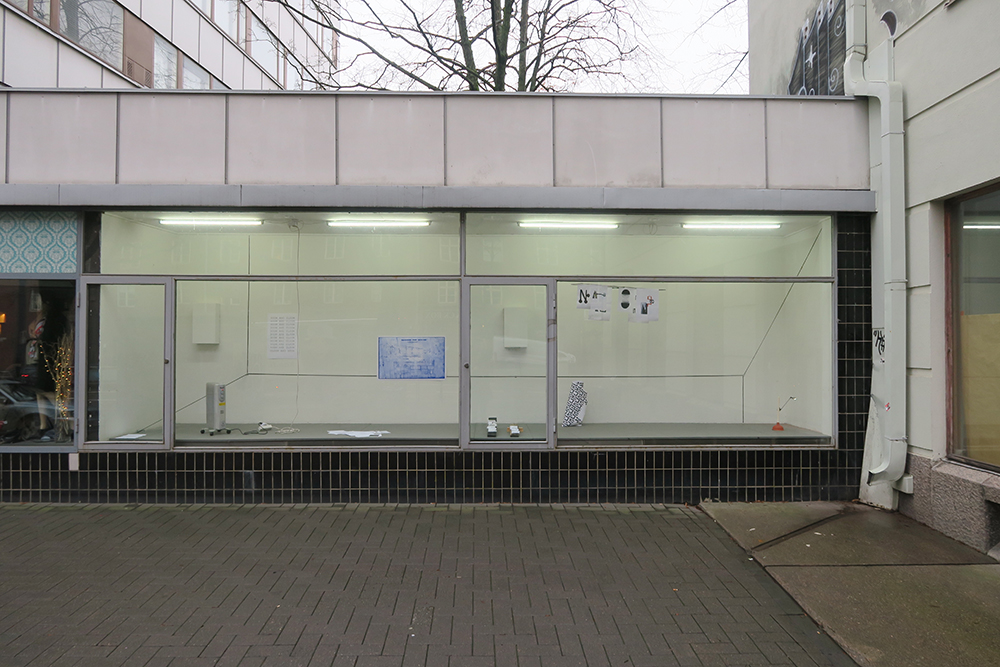
SHY PLUMBER Shy Plumber Exhibition # 1.
[FIN] Näyttely rakentui .pdf formaatissa jaettavan julkaisun SHY PLUMBER ympärille, jonka ensimmäinen numero ilmestyi syyskuussa 2020. Shy Plumber keskittyy taideteoriaan, sekä taiteen filosofiaan julkaisten taideteoksia - eräänlaisia taiteellisia ideoita graafisessa muodossa - verraten julkaisualustaa suoraan taiteen esittämiseen galleria- tai museokontekstissa.
Julkaisu on taiteilija/teoreetikoiden Ilja Orlovin ja Matthew Cowanin kehittämä, ja Alkovissa nyt esillä olevaan näyttelyyn osallistuvat taiteilijat heidän lisäkseen ovat: Anastasia Artemeva, David Foggo, Genevieve Banana, Kaisu Koivisto sekä Semyon Motolyanets.
Näyttely oli osa Alkovin ja HIAP:in suomalais-venäläiseen yhteistyöhön keskittyvän Connecting Points ohjelman yhteistä toimintaa. Ilja Orlov oli residenssissä HIAP:issa Suomenlinnassa loka-marraskuun 2020.
[ENG] The exhibition presented at Alkovi was build on the .pdf distributed journal 'Shy Plumber' of which the first issue was launched in September 2020. This periodical on 'art and anti-art' focuses on art theory as well as the philosophy of art, publishing artworks or "ideas in graphic form" comparing this format directly to exhibiting art in gallery or museum context. The publication is invented by artists/theorists Ilya Orlov and Matthew Cowan and in addition to them the participating artists in this now presented exhibition at Alkovi are: Anastasia Artemeva, David Foggo, Genevieve Banana, Kaisu Koivisto and Semyon Motolyanets.
This exhibition was a part of joint programming with HIAP / Connecting Points-programme that is focused on collaboration and exchange with Russian art field and its practitioners. Ilya Orlov was a resident at HIAP for October - November 2020.
Works and contributors (alphabetically):Anastasia Artemeva (Finland). Cruelty. 2020. Electric heater on timer, turning on 10 minutes a day.
David Foggo (UK). Happy Ending. Print.
Genevieve Banana (Finland). Inappropriate Proposition II. 2020. Black cord, stretched.
Ilya Orlov (Finland). Museum Item. 2020. Coat, plunger, bicycle mirror.
Kaisu Koivisto (Finland). Yes-No. 2020. Collage, metal rack.
Matthew Cowan (Germany). The Proposed Funny-Land. The Plan for the Failed Amusement Park on the Auckland Waterfront of 1927. 2020. Print.
Semyon Motolyanets (Belarus). Soap for Tears. 2020. 5 pieces of soap and soap wrappers printed.
Shy Plumber, a Journal of Art and Anti-Art (ISSN 2736-8203) is a new independent international art periodical issued 6 times a year in Helsinki, focused on conceptual art today in its varied forms.
The journal is made by artists and looks at the questions concerning art theory and philosophy of art, as well as publishes artworks realized in the graphic form.
The journal is spread in a form of free to download online pdf.
Issue 1, that was out on the 25th of September 2020, can be accessed at https://www.ilya-orlov.com/shy-plumber.TOP / YLÖS
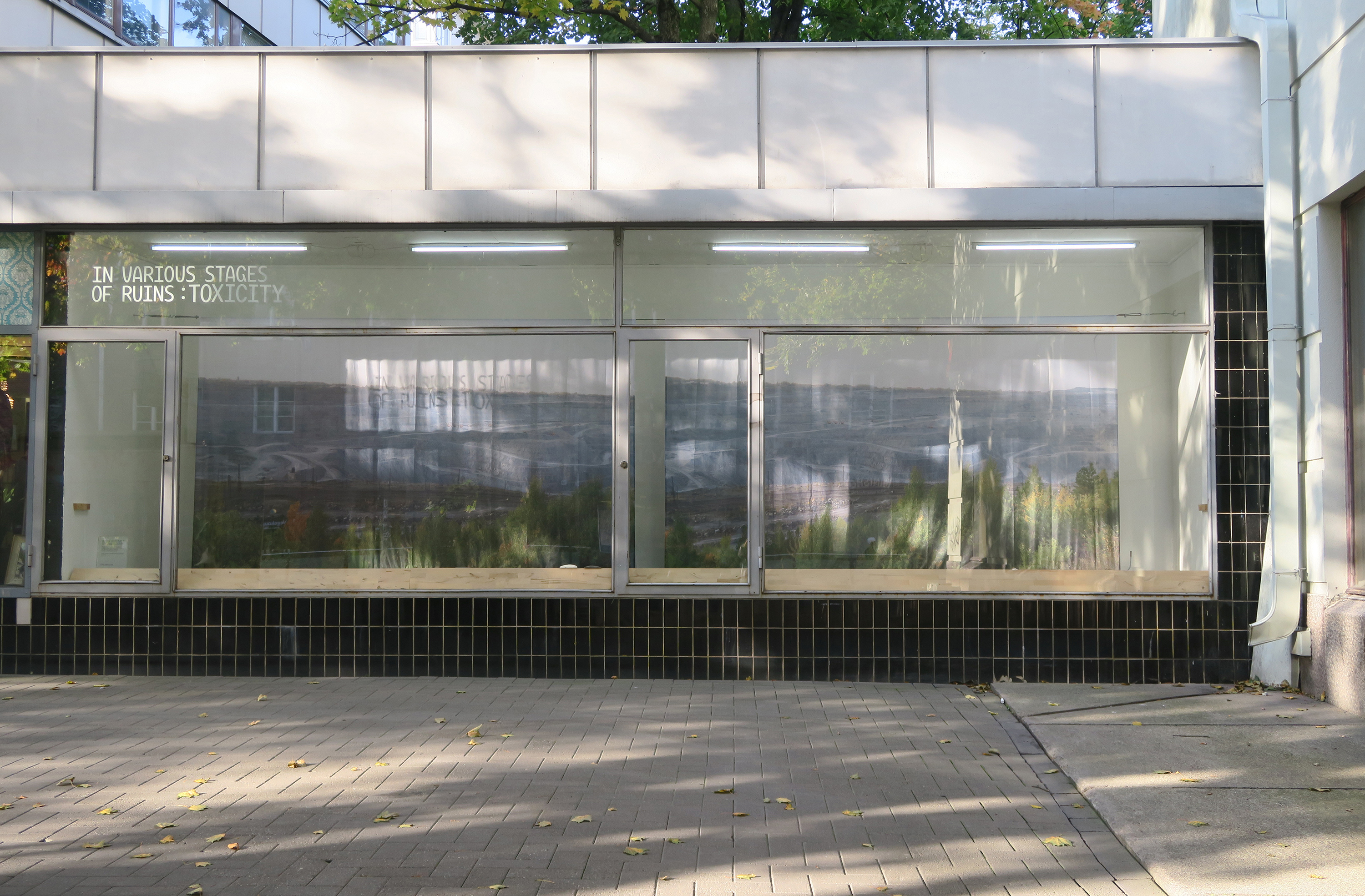
IN VARIOUS STAGES OF RUINS: TOXICITY
[FIN] Näyttely oli toinen osa sarjasta 'näytteille panoja', joiden kautta toimme esiin eri osa-alueita ja perspektiivejä 'matkan varrella' kohtaamistamme asioista hankkeessa 'In Various Stages of Ruins' [Useissa Raunioitumisen Vaiheissa], jonka otsikko on muistutus 'raunioitumisen' jatkuvasta muodostumisesta. Se kiinnittyy ajatukseen edistymisestä ja kehityksestä, joka ilman hajoavaa kaaoksen ja hävityksen puoltaan, on kykenemätön uusiin muodostelmiin ja jäsennyksiin. Materiaalien elämän-kierrossa mikään ei ole koskaan 'raunio' pysyvästi, ja raunio on aina todistus menneen läsnäolosta nykyhetkessä. Katsomalla sitä 'mitä täällä on' tavoitteenamme on ajatella elämis- ja kulttuuriympäristöissämme läsnä olevia mahdollisuuksia sekä todellisuuksia.
Toxicity' näyttelyssä esillä oli kuratoriaalinen taustakuva, joka oli otettu asbestikaivoksella Asbestin kaupungissa Venäjällä, sekä teokset Eero Yli-Vakkurilta ja Elina Vainiolta. Teoksiin voi tarkemmin tutustua näyttelyn sivulla: ''TOXICITY'
Linkki hankkeen verkkojulkaisuun: invariousstagesofruins.wordpress.com[ENG]This exhibition is part in a series of exhibitions that depict different aspects of the things encountered - along the way - in a project with the title 'In Various Stages of Ruins' that is a reminder of the constantly forming and gradual process of 'ruinification' It links to the idea of progress, that without its derelict inverse of chaos and loss, it would be insufficient to make new compositions and arrangements. As in the life-cycle of materials, nothing is a ruin permanently, a ruin is a testament to the past in present. With the notion of 'looking at what's here' we aimed to think about the possibilities and actualities of our cultural and lived environment.
'Toxicity' exhibition contained a curatorial background image that was taken from asbestos mine in the city of Asbest in Russia, as well as artworks from Eero Yli-Vakkuri and Elina Vainio. Works can be explored further on the website: ''TOXICITY'
A link to the online publication of the project:invariousstagesofruins.wordpress.comTOP / YLÖS

IN VARIOUS STAGES OF RUINS: DENIAL
[FIN] Tutkimushankkeessamme, jota olimme tehneet 2017-2019 tarkastelimme erilaisia käsitteitä liittyen tiedon muodostumiseen ja informaation levittämiseen, maisemaan, matkustamiseen, muistiin, historiaan, museoihin ja raunioihin, ottaen erityisesti taiteellisen työskentelyn metodit ja muodot osaksi tutkimusta; löytämistä ja etsimistä ja tässä yhteydessä liittyen moninaisiin perspektiiveihin suhteessa Venäjään; ei vain maana; maantieteellisena alueena, jolla on historiansa ja kulttuurinsa, nykyisyytensä ja menneisyytensä; vaan myös jatkuvana tarinana, käsityksenä venäläisyydestä jonka muodostamme kun kuvailemme sitä.
Tässä hankkeessa halusimme liudentaa tarvetta tuottaa tulos, joka tiivistäisi hankkeen - toisi esiin ne asiat, joita on koettu, katseltu ja työstetty. Mutta samalla kun ajallisten prosessien kapseloiminen sinänsä on mahdotonta - on se myös vääjäämätöntä; taiteilijat ja muut kulttuurin toimijat esittävät valmiita perspektiivejä ja löydöksiä - muodostavat ja muodottavat taideteoksia.
Tämän installaatio kokonaisuuden alaotsikko 'torjuminen' ('Denial') viittaa mahdottomuuteen esittää 'kaikkea' - se ilmentää, että kun jotain asetetaan esille, samalla jotain myös rajataan pois. Tämä on tilanne, jossa rajaamisesta tulee paitsi tuottava ele - sallien mahdollisuuden aktivoida ne asiat joita haluaa tuoda esiin - mutta 'torjumisen' liittyen myös hyvin konkreettisesti omien uskomusjärjestelmien turvaamiseen - jossa se mikä ei sovi tai 'käy järkeen' kielletään. Vaikka tämä kieltäminen siis varsin tehokkaasti mahdollistaa toimintaa ja ajattelua (kun asiat, jotka ovat eivät sovi faktoiksi suljetaan pois), se myös ylläpitää itsepetokseen kietoutunutta torjuntaa vastustamalla aidosti uusia mahdollisuuksia ja käsityksiä. Mahdollisuus liikkua (vieraalla) alueella perustuu lähtökohdalliseen ja perustavalaatuiseen 'tuntemattoman' hyväksymiseen.
Näyttelyssä kolme teosta taiteilijoilta Elina Vainio, Eero Yli-Vakkuri ja Iona Roisin lähestyvät hankkeen aiheita muodostamalla ääni-arkiston ('datapakin'), joka on kerätty junamatkalta, ja johon voi saada yhteyden Alkovin sijainnissa (Yli-Vakkuri), esittämällä Svetlana Aleksivitsin kirjasta lainatun kangaspohjaisen lauseen installoituna jättömailla Viipurissa ja Vladivostokissa (Vainio) sekä 'Muksis' hahmoon perustuvan kokoelman (Roisin)- 'Muksis' (Cheburashka) on kirjailija Eduard Uspenskin luoma neuvostoaikainen lastenkirjallisuuden hahmo ja hänen mukaansa "eläin jota tiede ei tunne".
NÄYTTELYN VERKKOVERSIO / EXHIBITION AVAILABLE AS AN ONLINE VERSION:invariousstagesofruins.html
Graafinen suunnittelija Matti Kunttu on valinnut hankkeessa käytettävät fontit (BC Mikser & Helvetica) ja Katja Kalinainen on toiminut assistenttinamme hankkeessamme olleilla matkoilla.
Jussi Kiven näyttely Alkovissa (joulukuu 2019-helmikuu 2020)'Sortunut Kaivos' oli osa 'In Various Stages Of Ruins' - hankettamme.
Tätä projektia on toteutettu Koneen Säätiön tuella (2017-2019) - alunperin käsitellen propagandaa ja disinformaatiota - sekä Suomen Kulttuurirahaston tuella (2019-2020) liittyen itään päin suuntautuvaan juna matkailuun osana taiteellista työtä. Projektia on toteutettu osana residenssiorganisaatio HIAP:in suomalais-venäläiseen yhteistyöhön keskittyvää Connecting Points-ohjelmaa.
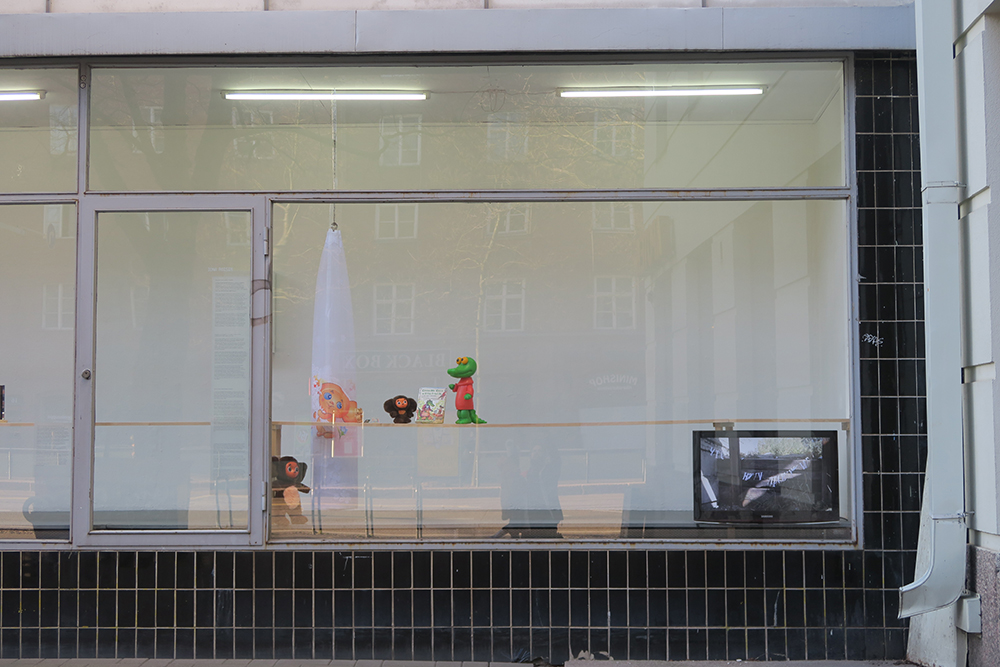
[ENG] Exhibition at Alkovi's display window space at Helsinginkatu, as well as online is an outlet for a research project that has been conducted over the years 2017-2019. The project developed as an examination of the concepts of knowledge formation, information distribution, landscape, travelling, memory, history, museums and ruins. It is an artistic research project - tackling the methods and means that artists work with when embarking on a mission of discovery and expedition. In this case, in connection with 'Russia; and the multiplicity of perspectives tied to it (as a country; as a geographical terrain with a history and culture attached to it, with a past and a present.) But it is also a constant true fiction - a notion of 'Russia' we form when trying to describe it.
In this project we have wanted to focus on counter-balancing the need for A result that would distill the things experienced, looked at or worked with, by offering some continuity and versatility in the presentation. Whilst the encapsulating of temporal processes is impossible, it is also inevitable - it is the task that artists and other cultural producers embark on when presenting their perspectives and findings - when formulating artworks.
'Denial' is the subtitle of our first instalment, it points to the inability to present "everything" - as with something 'denied entry' even though this act of limiting becomes productive - framing, enabling, allowing those things to be present that one is seeking to activate. It is also concretely related to safe-guarding one's belief-systems; as in denial of things that don't fit or make sense. Even though the effectiveness of denial (of something that seems counter-factual) is proven to be a sound tactic for sustaining the ability to think and act, self-delusional denial is the act of stubborn resistance to new concepts and possibilities. The ability to move on (foreign) terrain necessitates accepting elemental unfamiliarity.
The three works presented here from artists Elina Vainio, Eero Yli-Vakkuri and Iona Roisin in this instalment as an exhibition approach the project's subject matter by forming an archive (a database) - sounds collected from the experience of train travel and accessible only at the location of Alkovi (Yli-Vakkuri); the installation of a fabric sentence from Svetlana Alexievich's book: Secondhand Time, stretched across two derelict sites in the cities of Vyborg and Vladivostok (Vainio); and a Cheburashka collection (Roisin), a character of Soviet era children's literature from author Eduard Uspensky, according to whom it is "an animal unknown to science".
Graphic designer Matti Kunttu has selected the fonts (BC Mikser & Helvetica) used in the project, and our assistant during our trips on this project has been Katja Kalinainen.
The exhibition 'Collapsed Mine' by artist Jussi Kivi (December 2019 -February 2020) was a part of this 'In Various Stages of Ruins'- project.
This project has been done with the support of Kone Foundation (2017-2019) - initially starting as a project dealing with propaganda and disinformation as themes - and with the support of The Finnish Cultural Foundation (2019-2020) focusing on east-bound train travel as an opportunity for artistic work. The project has been done in the context of the Finnish-Russian Exchange programme Connecting Points, of the residency organization Helsinki International Artist Programme (HIAP).
TOP / YLÖS
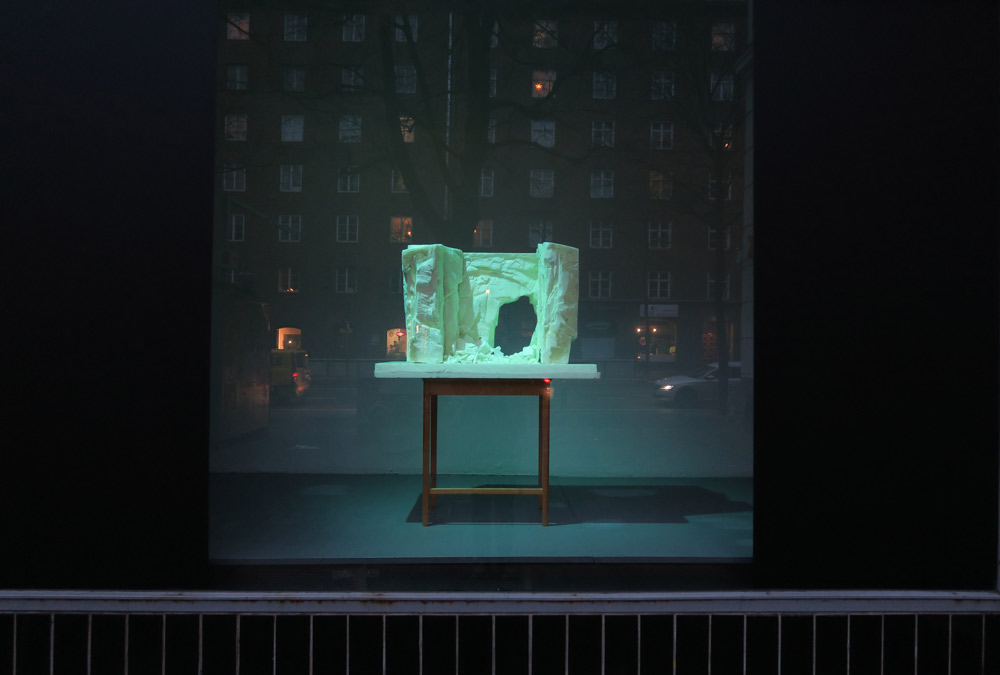
JUSSI KIVI:
SORTUNUT KAIVOS / COLLAPSED MINE
[FIN] Esillä oli installaatio, jossa materiaalina oli eristevaahto sekä puu. Installaation lähtökohtana oli Kiven tutkimusretket maanalaisissa tiloissa kuten kaivoksissa, hylätyissä sotilaskomplekseissa ja urbaaneissa tunneliverkostoissa.
Jussi Kiven kattava taiteilijan ura on pitänyt sisällään useita tutkimusmatkoja sekä lukuisia näyttelyitä, joista yksi tunnetuimpia lienee Venetsian Biennaalin Aalto Paviljongin näyttely Fire & Rescue Museum vuonna 2009. Viimeisimpänä Kiven teoksia oli esillä A-tishoo, A-tishoo, We All Fall Down -näyttelyssä Viron nykytaiteen keskuksessa (CCA) 2019 sekä yksityisnäyttelyssä syvällä / DEEP DOWN UNDER Helsingin taidemuseossa (HAM) vuonna 2018. Kivi sai vuonna 2009 Ars Fennica-taidepalkinnon.
[ENG] Presented was an installation made of insulation foam and wood. The starting point for the installation was exploration trips made at underground spaces - like mines, abandoned military complexes and urban tunnel networks.
Jussi Kivi's long artistic practice including multiple expeditions stretches over several decades - during which he has presented works in many occasions notably those such as Venice Biennial's Aalto Pavilion in 2009 (Fire & Rescue Museum) and participating recently on exhibitions like A-tishoo, A-tishoo, We All Fall Down at the Estonian Centre for Contemporary Art (CCA) (2019) and a recent solo exhibition syvällä / DEEP DOWN UNDER at Helsinki Art Museum (HAM) (2018). At 2009 he received Ars Fennica-prize.
TOP / YLÖS
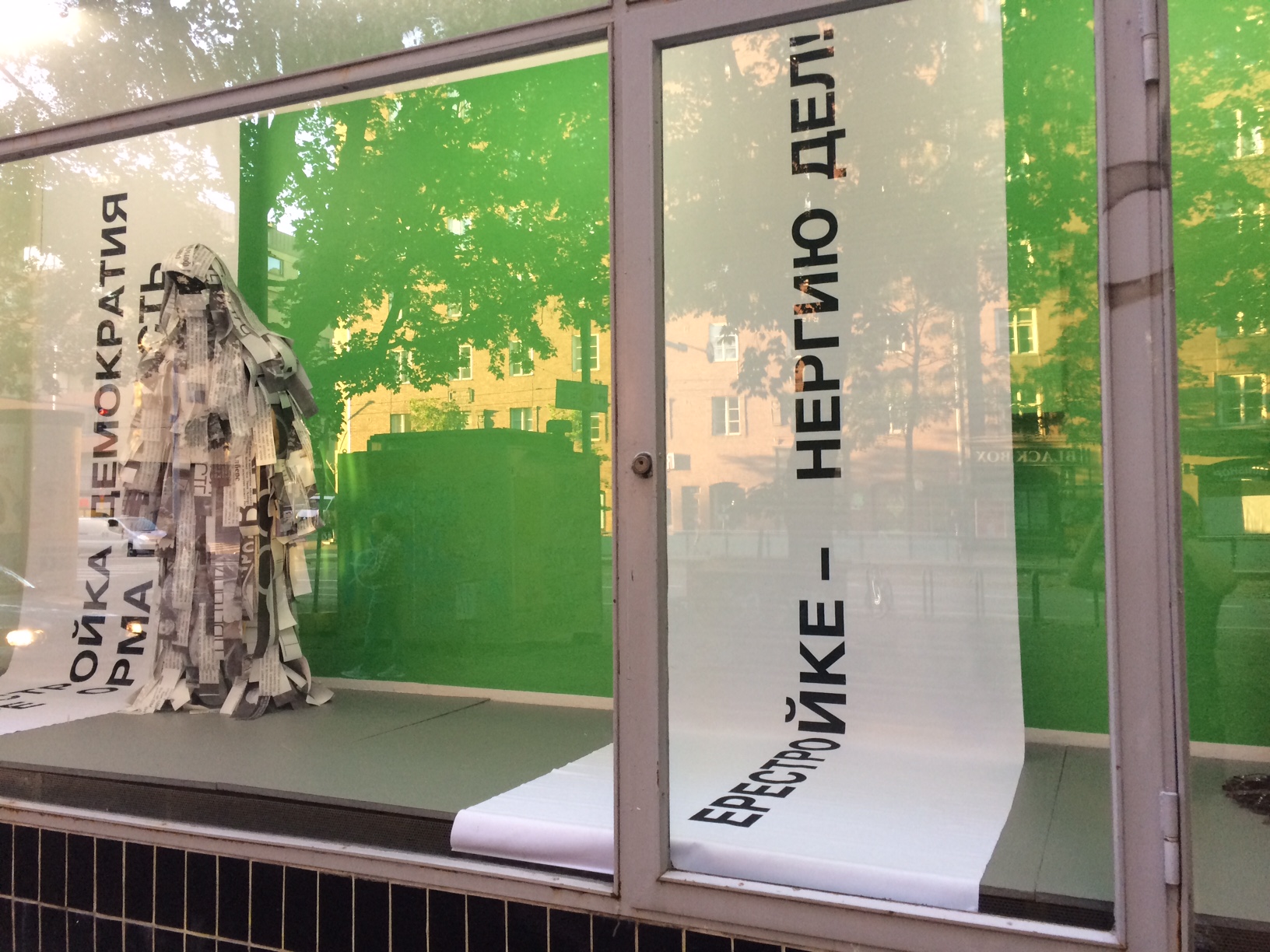
AGENCY OF SINGULAR INVESTIGATIONS (STANISLAV SHURIPA, ANNA TITOVA):
SEMIONAUTS IN THE FOREST
[FIN] Alkovissa esillä ollut näyttelykokonaisuus rakentui taiteilija-duon Anna Titova ja Stanislav Shuripa / Agency Of Singular Investigations (ASI) laajemman teossarjan kahdesta elementistä: 'Semionaut's Travel Gear' (koostuu eräänlaisista salaisten agenttien, tiedustelijoiden ja metsästäjien asuista, joita käytetään matkustamiseen, tarkkailuun ja erilaisiin kokeisiin, sekä ritualistis-symbolisiin toimiin ei-lineaarisissa vuorovaikutus-ympäristöissä) sekä 'Thicket of Slogans' (esimerkki semioottisesta hypertilasta, joka muodostuu Perestroikan ajan iskulauseista) jotka olivat osa Moskovan modernin taiteen museossa alkuvuonna 2019 esillä ollutta 'FLOWER POWER.ARCHIVE' näyttelyä. Näyttely käsitteli laaja-alaisesti ajan käsitettä, sen ilmenemismuotoja ja esittämisen tapoja, arkisto- sekä jäännösmateriaaleja sekä rekonstruktioina, joka liittyivät Flower Power-yhteisön (rakennettuun) tarinaan.
Tämä näyttely liittyi Alkovin painotukseen HIAP:in Connecting Points-ohjelman puitteissa keskittyen tiedon tuotannon ja tiedon muodostumisen kysymyksiin. ASI:n praktiikka huomioi oleellisesti jatkuvan tarpeemme tulkita, aktivoida ja muokata havaitsemaamme, sekä myös sitä millä keinoilla vuorovaikutamme.
ASI: Agency Of Singular Investigations (ASI) on näyttelyihin, keskusteluihin, esityksiin ja muihin taiteellisia käytäntöjä nykyisissä sosiaalisissa ja kulttuurillisissa prosesseissa tarkasteleviin tapahtumiin keskittyvä yhteisö. Stanislav Shuripa ja Anna Titova perustivat ASI:n vuonna 2014, vuodesta 2015 ASI on toiminut Moskovassa Fabrika- taidekeskuksen tiloissa. Näyttelyiden, seminaarien, keskusteluiden ja erilaisten esityskäytäntöjen välimaastossa toimiva ASI tarkastelee työssään esteettisten kokemusten ja historiallisten tilanteiden suhteita, sekä taiteellisten sisältöjen esiin tulemisen mahdollisuuksia julkisessa tilassa. ASIn järjestämät tapahtumat liittyvät ajankohtaisiin, kulttuurillisten ja taiteellisten ympäristön aiheisiin. Nämä aiheet tarttuvat taiteellisen praktiikan kontekstiin ja vaikutukseen tietoyhteiskunnassa, kuten vuorovaikutukseen taiteilijan ja katsojan kanssa, havaintoon ja keskusteluun, visuaaliseen sekä sosiaaliseen, ja kuvien virtuaaliseen luonteeseen ja sosiaalisen toiminnan todellisuuteen, esteettiseen kokemukseen ja moninaisiin tiedon muotoihin
[ENG] Alkovi presented an exhibition compiled of two fragments of a project 'FLOWER POWER. ARCHIVE' by Agency of Singular Investigations / Stanislav Shuripa and Anna Titova. 'Semionaut's Travel Gear' (reconstructed outfits for secret agents, scouts and hunters that were used for travel, observation, experiments and ritualistic-symbolic activity in non-linear communication environments)and 'Thicket of Slogans' (an example of semiotic hyperspace formed by specially germinated slogans of the Perestroika era) were presented jointly as elements of engagement of 'political environmentology of meanings (PEM, as it is described by ASI)' [the belief that] 'hyperspaces formed by discursive flows can [...] yield better opportunities to develop alternative versions of history and ritual hunting of semiofauna.'
The 'FLOWER POWER. ARCHIVE' was initially an exhibition held at Moscow Museum of Modern Art from February to April 2019 and consisted of multiple pieces dealing with the concepts of time and its depiction, its presentation as archival and residual materials, as reconstructions and with visual and semantic guides - all tied into the reconstructed story of a secret society called 'Flower Power'. This installment at Alkovi consisted of just a couple of elements from this exhibition entity, the costumes of semionauts and the slogans, that form their own display of re-routing and re-viewing the past as attached to a possibility of "unearthing" techniques of history-making as materializations of time.
When dealing with the past, we deal with the concept of the (de-)pressing present. As Stanislav Shuripa states in the catalogue publication related to the MMOMA exhibition that: "The most important thing for us is the present. It is in any case comprised of both past experiences and future expectations. Many avenues of historical experience and expectations are almost or completely invisible, forgotten, lost. But then you have the torrents of messaging and data that not only conceal the opportunities and erase memory but also, conversely and unexpectedly, uncover the forgotten and lost, reanimate images that seemed to have been neglected to the past for good. The present of today is full of reflections of other eras, resuscitated patterns, something along the lines of undead modernity. A prominent attribute of our time us that the image of the future has lost its usual appeal. It appears to have been washed out, lost the energy of popular hopefulness; there is no longer certainty in the conviction that progress will bring about happiness for all. The place of future images has been taken by images of the past. They come from different worlds and histories. A key role in our practices is taken by the feeling of co-presence of different times and versions of history. And we engage this multiplicity to speak about the splendors and miseries of hope for more just and freer world."
Tied to the focus that Alkovi has had within the collaborating project under the HIAP's Connecting Points-programme on 'knowledge production' (or knowledge formation as we like to see it) ASI's focus and artistic practice points to the incessant need to interpret, activate and adjust what we perceive and through what means we engage on this correspondence. Signaling systems form their own landscapes or terrains, through the navigation of which is not a simple task of exposure. Anna Titova (quoted from the same publication): "We believe that the reality that surrounds us is not a homogeneous panorama of events that happen around a subject but a large number of collisions, fusions, transitions between contexts. The echoes of what could be called zeitgeist-under the tension that emerges as a result of numerous collisions of expectations, interests, notions. This differentiation, intercrossing of realities id the subject in many of our projects. This is not about "objective" knowledge but rather about inconspicuous, damped, weak effects of communications. The projects of ASI are not so much some "pure art" but acts of communication, attempts to exchange signals. Each object is a witness or a place of transition between different worlds. Objects and images combine into a kind of map of parallel reality."
About the ASI The Agency of Singular Investigations (ASI) is a platform for exhibitions, discussions, performances and other events aimed at a rethink of the role of artistic practice in current socio-cultural processes. The ASI was founded in 2014 by Stanislav Shuripa and Anna Titova. Since 2015 ASI has been operating from the Centre of Creative Industries Fabrika. The ASI aims to explore the relations between aesthetic experience and historical conditions, and also the potential to produce artistic meaning in a public space. The ASI was set up to become the platform for the development of scenarios operating at the intersection of exhibition, seminar, discussion and presentation formats. The events organized by the ASI are dedicated to issues indicative of the current cultural and artistic environment. These key topics concern the context and impact of artistic practice in the communications society, such as the interaction between the artist and viewer, perception and discourse, visual and social, the virtual nature of images and reality of social action, aesthetic experience and various forms of knowledge.
TOP / YLÖS
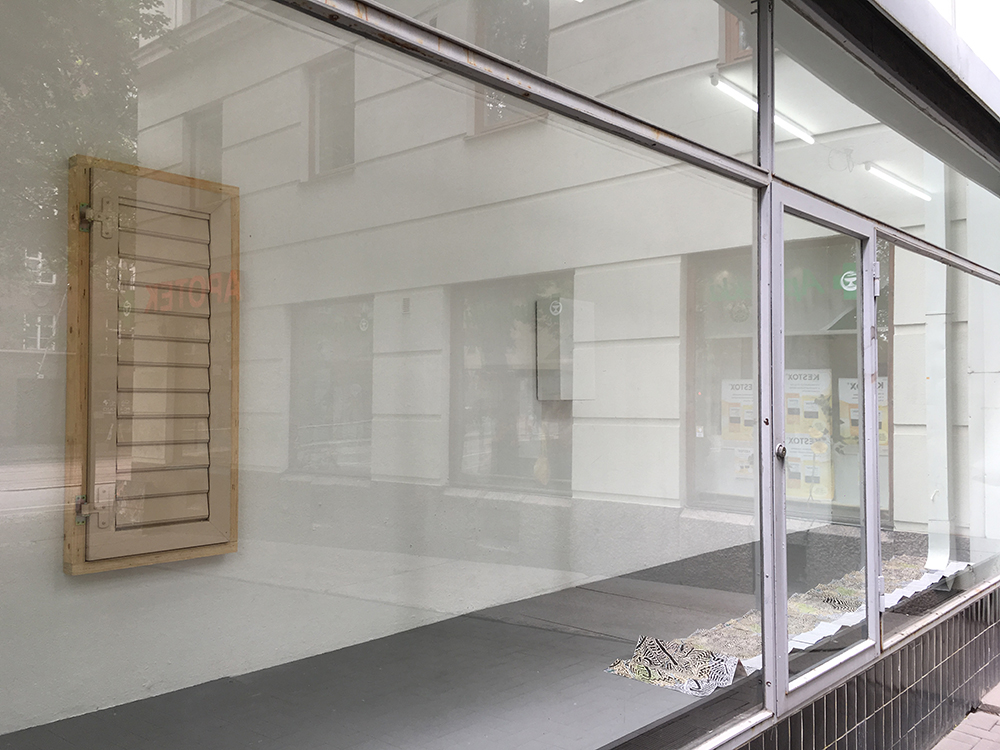
DYLAN RAY ARNOLD:
Deep Dreams (Paris) [Drawing on maps], 2019 |
DENISE ZIEGLER:
Window Shutters [Reconstructed situation: window shutters, wood], 2010
Presenting two works together: Dylan Ray Arnold's 'Deep Dreams (Paris)' from 2019 and Denise Ziegler's 'Window Shutters' from 2010.
TOP / YLÖS

INTERMISSION:
I was there but you didn't see me*
a project by Sheung Yiu and Samra Šabanovic.
"I was there but you didn't see me* is a series of research-based public interventions on photographic images curated by Samra Šabanovic and Sheung Yiu. These interventions use images as starting points of inquiry about their indisputable impacts on philosophy, history, literature, technology, science and visual culture. Through prolonged looking and peripheral vision, the duo revisits images (or the lack of them) and situates them in new discourses that extends beyond visual arts. This involves doing double-takes on images seriously and regularly, writing footnotes on and around photographs to rediscover 'what was there' and 'what was not seen' at first glance." Text by Yiu and ¦abanovic.
Sheung Yiu (b. 1991) is a Hong Kong image-based artist and writer based in Helsinki. Taking inspiration from both art and science, he poses critical enquiry on the moments when perception is turned into cognition. His work is exhibited internationally, including Guangzhou Image Triennial 2017, Hong Kong International Photography Festival Satellite Exhibition 2018 and International Summer School of Photography 2016 & 2018. He is currently a master student in Visual Culture and Contemporary Art at Aalto University.
Samra Šabanovic (b. 1992, Bosnia and Herzegovina) is a visual artist currently based in Helsinki. In her practice, she addresses issues on the photographic and its various existences in everyday life, public spaces and its relation to theory. In the process that oscillates between the subjective and theoretical- video, photography and narration become her tool. Samra graduated from Academy of Arts in Novi Sad and is finishing her Master degree in Visual Culture, Curating and Contemporary Art at Aalto University.
[intermission is a series of exhibitions that have a shorter duration and are more instant in the nature of presentation.]iwastherebut.com
TOP / YLÖS
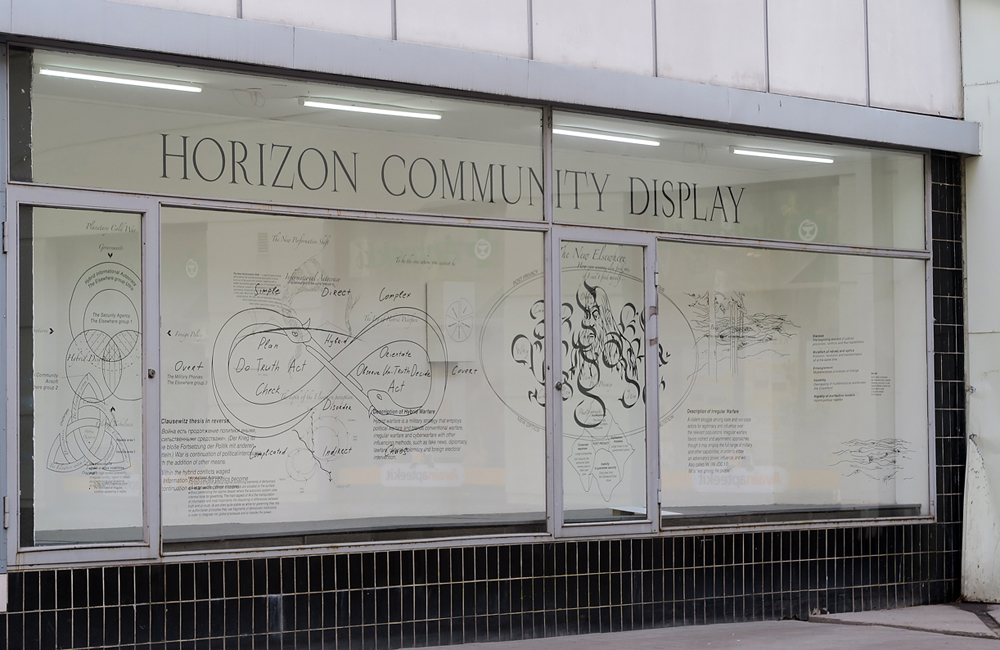
KIRILL SAVCHENKOV:
Horizon Community Display
/ Yhteistyössä /
With assistance of Daria Kalugina In collaboration with Marina Valle Noronha
Horizon Community(1) Display
Planetary Cold War
Informational Autocracy
Hybrid Disorder
The New Elsewhere
The Depth of the Elsewhere Perception
The New Performative Shift
Post Privacy
The Fog of Hybrid Warfare
[FIN] Marina Valle Noronha kirjoitti näyttelystä: "Horizon Community Display on graafinen kolmiulotteinen tieto-runo, eräänlainen ekosysteeminäkymä, joka on esillä Alkovissa. Siihen voisi viitata myös kahdeksana tiedon blokkina, tai leijuvien teemojen kollaasina. Sen kaksois- (moninainen) luonne kuuluu jonnekin kirjan, rituaalin tai vähemmän tunnetun alueen välille. Ystävä, joka tuli katsomaan installointia, sanoi että tuntui kuin tulisi tietoiseksi meidän olemassaolostamme spekulatiivisessa-tieto-mystisessä-tilassa(2), jossa kaaviot ja symbolit helpottavat 'siirtymä-ajoitus-merkitystä' - ulottuvuutta jossa me kaikki olemme osana, ja jota me emme ole vielä täysin ymmärtäneet. Installaatio kutsuu tietoa muokkautumaan ja muuntumaan aikana, jolloin meidän havaintomme on sirpaloitunut toimien sijaisena tämänhetkiselle epäjärjestyksen tilalle.
.example {
/Horizon Community Display/
transition-timing-function: ease;
}
Kirillin työskentely on viime aikoina keskittynyt kehittämään kartastoja, jotka tarkastelevat ja arvioivat informaation itsevaltijuutta(3), termi joka viittaa hybrideihin poliittisiin hallintoihin, jotka perustuvat sorrolle ja ovat tuoneet esiin uuden hallitsemisen muodon, jossa informaation manipulointi on keskiössä. Horizon Community Display on tutkimuksellinen installaatio, joka esittää mysteereitä paljastettavaksi - tai sitten ei. Se sisältää osia useista Kirillin aiemmista teoksista. Termit kuten The Elsewhere (4), (toiseus paikkana / toisaalla / toiseudessa) viittaavat erityiseen myöhäisneuvostoliittolaiseen ilmiöön, jossa merkityksiä muunnellaan poliittisten rituaalien kautta useissa yhteisöissä. Nämä ovat toistuvia elementtejä Kirillin teoksissa ja linkittyvät aiempien teosten sisältöihin. The New Elsewhere puolestaan on ehdotus kansalaisille - kutsu toimintaan. Tai kenties vielä enemmän se on kuvaus, joka voi muuttua toiminnaksi. Vaikka suuri osa näyttelyn sisällöstä käsittelee poliittisia tapahtumia jotka sijoittuvat neuvostoajalle, Venäjän nykyisen tilan analysointi ei ole välttämätöntä muodostaakseen yhteyden teokseen - ilman suurempia vaikeuksia voi löytää yhteyspinnan muihin outoihin poliittisiin muodostelmiin.
Vaikka Horizon Community Display saattaa aluksi tuntua melko ylivoimaiselta esitykseltä - tilassa on paljon informaatiota - yhtymäpinta siihen mitä tilassa on, tapahtuu ajan kanssa. Ei ole tarvetta lukea tai ottaa kaikkea sisään kerralla. Installaatio huomioi, että asioita voi vastaanottaa osissa. Yhtymäkohtia eri alueisiin Alkovin näyteikkunassa (myös niihin, jotka avaavat tämän tekstin) voi löytää hitaasti. Välimatka graafisten objektien ja poliittisten objektien välillä muuttuu. Spekulatiiviset logiikat nousevat ja laskevat epätasaisesti. Ja näkökulmasi muuntaa esilläolevan ulottuvuutta kun liikut ohitse - ikkunasta, kadulta tai jostain toisaalta, vapaasti muotoutuvassa ajallisessa järjestyksessä." Teksti: Marina Valle Noronha
(1)Horizon Communityn perusti aikamatkaaja John Titor. Se on spekulatiivinen järjestö, joka yhdistää dataa jota kerätään sen toimintojen kautta saadakseen ja sijoittaakseen metakognitiivista tutkimusta ajasta, tiedosta, meditaatiosta, hominologiasta (villien kaksijalkaisten kädellisten tutkimus), ja selviytymistaktiikoista hybrideissä poliittisissa hallinnoissa. (2) Viitaten Cyclonopediaan: Iranilaisen filosofin Reza Nagarestanin ajatukseen nimettömien materiaalien yhteensovittamisesta. (3) Information Autocracy viittaa hybrideihin sorrolle perustuviin poliittisiin hallintoihin, jotka ovat tuoneet esiin uuden hallinnon muodon, jossa tiedon manipulointi on keskiössä. Katso Sergei M. Guriev ja Daniel Treisman, Informational Autocrats (Heinäkuu 5, 2018). Saatavilla:https://ssrn.com/abstract=3208523. (4) Antropologi Alexei Yurchakin teos Imaginary West The Elsewhere of Late Socialism, saatavilla Everything Was Forever, Until It Was No More: The Last Soviet Generation, 2015. https://muse.jhu.edu/chapter/1228348.
Kirill Savchenkov (s.1987 Moskova, Venäjä) työskentelee useilla eri välineillä - niin performanssin, installaation kuin videon kautta. Kirillin taiteellinen työskentely tapahtuu asioiden välittämisen ja opettamisen suhteiden keskellä nykyisessä geopoliittisessa, media-luonto-kulttuuri maailmassa. Proxy-logiikan läpitunkema maailman tilanne muuntaa ihmisen ja objektien suhteet suhteiksi tiedon ja datan välille digitaalisessa ja sosiaalisessa media-ajassa. Uudelleenjäsennelty vuorovaikutus teknologian ja käytänteiden, armeijan tai siviilien, kehon ja älyn, annettujen tai valmistettujen välillä tuottavaa hybridejä poliittisia hallintoja ja piilotettuja vallan muodostelmia, jotka vaativat kartastojen tuottamista. Kirill on osallistunut 12. Gwangjun Biennaaliin vuonna 2018 sekä 4.Ural Industrial Biennaaliin vuonna 2017. Kirillin yksitysnäyttely Office of Sensitive Activities/Applications Group, oli V-A-C säätiön toteuttama ja tapahtui Modernin taiteen museossa (MMOMA), Moskovassa 2017. Kirill on saanut Venäjän Innovation Art- palkinnon vuonna 2018 sekä Garage Nykytaiteenmuseon palkinnon vuonna 2017. Kirill on opettanut Rodchenko taidekoulussa Moskovassa vuodesta 2013 lähtien.
[ENG] This is what Marina Valle Noronha wrote about the exhibition: 'Horizon Community Display' is a 3D graphic knowledge poem, a display ecosystem on view at Alkovi. One might refer to it as 8 blocks of knowledge or a collage of gravitational themes. Its double (multiple) nature belongs somewhere in between a book, a ritual, and a less-familiar zone. A friend who came to see the install said it felt like being aware of our existence within a speculative-knowledge-mystical-space (2), where diagrams and symbols ease the transition-timing-function - a dimension which we are all part of, we have just yet not fully understood that. The installation calls for the ability of knowledge to mutate and transform, in a time where our perception is fragmented and works as a proxy in a current state of disorder.
.example {
/Horizon Community Display/
transition-timing-function: ease;
}
Kirill's work has recently focused on developing cartographies that speculate on information autocracies (3), a term that refers to hybrid political regimes that are based on repression and have introduced a new governing model where the manipulation of information is at its core. 'Horizon Community Display' is an investigative installation that features mysteries to be (or not) uncovered. It has components from various of Kirill's previous works. Terms such as 'The Elsewhere' (4), a specific late soviet phenomena of shifting meanings within political rituals inside various communities, are recurrent in Kirill's works and add to the common narrative between previous artistic works. In turn, 'The New Elsewhere' is a proposal for citizens, calling for action. Moreover, it's description model which could become an action. Though much of the content in the show derived from political events dating back to soviet times, analysis of Russia's current state is not mandatory to feel a connection to the work" without much effort you might find resonance with other strange political constitutions.
Though 'Horizon Community Display' might come first as an overwhelming exposure - you are confronted with a space that contains a large amount of information - your connection to what is there happens over time. One should feel no pressure to read (all of) it at once. Different areas of Alkovi's vitrine (including the ones that open this text) will find interlinks between each other slowly. The distance between graphic objects and political objects will shift. Speculative logics will rise and fall irregularly. And your perception will transform the display's own dimension as you pass by, from a window, from the street and from elsewhere, in a free-flow temporal order." Text: Marina Valle Noronha(1)The 'Horizon Community', founded by time traveler John Titor, is a speculative organization that synthesizes data obtained through the course of its operations to facilitate metacognitive research on time, knowledge, mediation, hominology (the study of wild bipedal primates), and survival tactics in hybrid political regimes. (2)In reference to Cyclonopedia: complicity with anonymous materials by Iranian philosopher Reza Nagarestani. (3) The term 'Information Autocracy' refers to hybrid political regimes based on repression that have introduced a new governing model where the manipulation of information is at its core. See Sergei M. Guriev and Daniel Treisman, Informational Autocrats (July 5, 2018). Paper available at https://ssrn.com/abstract=3208523. (4) See anthropologist Alexei Yurchak's 'Imaginary West The Elsewhere of Late Socialism',in 'Everything Was Forever, Until It Was No More: The Last Soviet Generation', 2015. https://muse.jhu.edu/chapter/1228348.
Kirill Savchenkov (b.1987 in Moscow, Russia) works in various formats including performance, installation and video. Kirill's artistic practice appeals to the relations between mediation and education produced in the current geopolitical and media-nature-culture world. Infiltrated by proxy-logic, the world status transforms interactions between human and objects into relations between knowledge and data in the digital and social media age. The readjusted interactions between technology and policy, military and civilian, body and intellect, given and manufactured produce hybrid political regimes and hidden power formations, which demand the production of cartographies. Kirill participated in the 12th Gwangju Biennale, 2018 and in the 4th Ural Industrial Biennial, 2017. Kirill's solo show, 'Office of Sensitive Activities/Applications Group', was organized by the V-A-C Foundation and took place at MMOMA, 2017. Kirill was awarded the Russia's Innovation Art Prize in 2018 and received Garage Museum of Contemporary Art's scholarship in 2017. Kirill teaches at The Rodchenko Art School in Moscow since 2013.
TOP / YLÖS
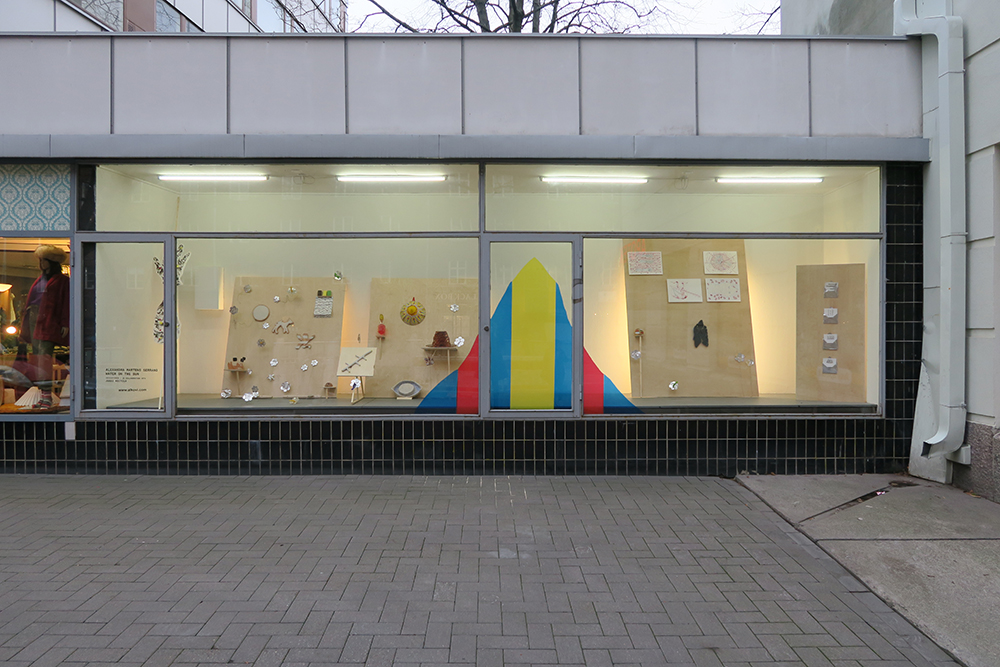
ALEXANDRA MARTENS SERRANO
Water On The Sun
Curated by Jussi Koitela
[FIN]'Water On The Sun' näyttely oli taiteilija Alexandra Martens Serranon ja kuraattori Jussi Koitelan pitkäkestoisen projektin 'Dragged Ways of Knowledge' ensimmäinen julkinen osa. Projekti ymmärtää taideteokset ja objektit säiliöiksi, jotka "raahaavat" tietoa mukanaan haastaen eri aikakausien ja kulttuurien totuttuja rajoja ja representaatioita. Se ehdottaa erilaisia, uusia tietämisen tapoja tuomalla yhteen taideteoksia, tekstejä ja viittauksia eri ympäristöistä tuottaen uusia yhteyksiä ja eroja Martens Serranon teoksen ympärille.
"Objektit sisältävät aina kertomuksen riippumatta siitä pyrkiikö siihen vain ei. Niissä on olemassa 'rationaalinen' narraatio, jota ei voi välttää." - Ennustaja, Espoo, FI
"Henkilökohtainen vaistonvarainen yhteys ilmenee kun objektilta riistetään ilmiselvät säännöt ja suunnat, kontrastissa niihin joilla on niiden omat käyttöjärjestelmät joiden kautta ne voi ymmärtää." - Luiden tulkitsija eroista liittyen löydettyjen tai tehtyjen objektien (riimujen) suhteesta Tarot-korttien käyttämiseen ennustamisessa, New Orleans, U.S.A
Objektit kantavat mukanaan tietoa historioista ja uskomusjärjestelmistä, joita ei voi hahmottaa ihmiskeskeisessä länsimaisessa epistemologisessa järjestelmässä. 'Dragged Ways of Knowledge' ehdottaa kokonaisvaltaista tietämisen tapaa, joka haastaa normalisoituja objektien luokitteluja ja rooleja. Näyttely yhdistää samalla Martens Serranon työskentelyä ja tutkimusta New Orleansista vuodelta 2018 hänen vanhempiin teoksiinsa. Hänen työskentelynsä keskittyi keväällä 2018 ymmärtämään selvän näkemistä, kuten luiden lukemista, New Orleansiin monimuotoisessa kulttuurisessa ympäristössä.
Teksti kirjoitettu yhdessä Martens Serranon & Koitelan kanssa.Kiitokset: Deltaworkers-residenssi (Maaike Gouwenberg ja Joris Lindhout), STROOM Den Haag ja Helinä Rautavaaran museo
Alexandra Martens Serrano (s.1991) asuu Haagissa, Alankomaissa, ja on suorittanut BFA-tutkinnon vuonna 2014 (The Royal Academy of Arts / Haag). Installaatioiden, piirustusten, veistosten ja viime aikoina myös äänen, sekä tekstipohjaisen työskentelyn kautta hän pyrkii ottamaan uudelleen käyttöön erilaiset kertomukset ja kielen mielikuvituksen työkaluiksi. Hän sai Mondriaan Fundsin 'nouseville' taiteilijoille tarkoitetun apurahan vuonna 2017 sekä STROOM Den Haagin tuen työskentelylleen vuonna 2016. Hänen viimeisimmät projektinsa ovat olleet kahden kuukauden tutkimusvierailut El Salvadorissa ja Guatemalassa vuonna 2017, sekä kuukauden kestävä paikkasidonnainen työskentelyjakso ja näyttely Mexico Cityssä vuonna 2018. Hän työskenteli Deltaworkers-residenssissä New Orleansissa, Lousianassa 2018. Residenssin yhteydessä julkaistiin Taal-is-man julkaisu, joka pohtii New Orleansin kulttuurisia kerroksia.
Jussi Koitela (s.1981) on aiemmassa kuratoriaalisessa työskentelyssään hahmottanut taiteilijoiden ja muiden taidekentän toimijoiden toimintaa liittyen talouden rakenteisiin sekä niihin liittyviin keskusteluihin Skills of Economyn kuratoriaalisen tutkimuksen kontekstissa. Viime aikoina hän on ollut kiinnostunut länsimaisen ontologisten, epistemologisten ja taloudellisten rakenteiden krittisestä tarkastelusta. Koitela on kiinnostunut kehittämään kokonaisvaltaisia kuratoriaalisia ja institutionaalisia työskentelymuotoja taiteelliselle työskentelylle, tutkimukselle ja politiikalle. Hän on aloitti Frame Contemporary Art Finlandin ohjelmapäällikkönä elokuussa 2018. Hänen kuratoriaalinen työnsä on pitänyt sisällään projekteja kuten Entanglements, Embodiments, Positions (Treignac Projet), In the Dark I Don't Have Four Limbs (Trøndelag Centre for Contemporary Art), Entangling Matter and Meaning / Intra-Structures - Monster of the Seven Lakes -näyttely (Treignac Projet), Agency for De-development for Tromsø (Vårscenefest 2017 Festival), Mattering City (SixtyEight Art Institute), City Agents (EKKM), Skills of Economy Sessions (Teatterikorkeakoulu, Baltic Circle Festivaali ja Kiasma Teatteri). Vuosina 2015/2016 Koitela osallistui De Appel -kuraattoriohjelmaan.
[ENG] A collaborative exhibition by artist Alexandra Martens Serrano and curator Jussi Koitela; Water On The Sun was an offspring of their long term project Dragged Ways of Knowledge. Through a playful approach and the act of associating use and meaning, both real and fictitious; this presentation suggested certain artworks and enigmatic objects as vessels of information capable of transmission and transformation. These items are then 're-tuned' to be able to perform differently, as every tune becomes an ode for the ontological secrecy of an object.
Influenced through her recent research in New Orleans (U.S.A) Martens Serrano's work in Water On the Sun connected the endurance of an object, with culturally diverse yet universally human systems and narratives, which have informed and are reflected in various aesthetic, social and epistemic traditions. As a technique to reconsider what at first sight appears to be disjointed, certain practices were explored such as divination, which encompasses objects in its activities i.e. bones, tea leaves and shells amongst others, in order to 'read' and extract knowledge.
'Objects contain an inevitable narrative for humans, whether you are aiming for this or not. There exists a 'rational' narrative within them that cannot be avoided.' Fortune teller, Espoo, FI
'A personal instinctive connection and communication occurs with an object which is devoid of obvious rules or directions, in contrast to those which have their own systems of use already established for you to understand them through.' Bone Reader speaking of the differences of using found or made objects (runes) in contrast to using Tarot Cards for divination, New Orleans, U.S.A
The collaborative project aims to speculate on the capacity of (artistic) objects to 'drag' certain knowledge, beyond the time span of their creator and the effects these kinds of narratives have on areas such as history, belief systems, anthropology, and economy. Enforcing and celebrating the ability of these processes to challenge the normalized ontological order of the 'human' subject - the object - and the non-human production relationship. The focus lies on the perception of an integrated approach to reality rather than an anthropocentric one. Fundamentally, Dragged Ways of Knowledge aims to draw light on new ways of 'knowing' by suggesting certain artworks, texts and references in order to understand Martens Serrano's work and its meaning in relation to certain urgencies relevant to crises of Western knowledge, epistemologies and the role and functions of objects, time and taxonomies within it.
Text written in collaboration with Alexandra Martens Serrano and Jussi Koitela.With thanks to Deltaworkers Residency (Maaike Gouwenberg and Joris Lindhout), STROOM Den Haag and Helinä Rautavaara Museum.
Alexandra Martens Serrano (b.1991) Currently based in The Netherlands, she received her BFA at the Royal Academy of Arts, The Hague in 2014. Through installations, drawings, sculptures and most recently audio and text based work she aims on playing and re-claiming narratives and language as tools for the imagination. She is a recipient of the Mondriaan Fonds Emerging Artist Subsidy (2017) and the STROOM Pro Invest Subsidy (2016); participating in STROOM's network and curatorial studio visits program related to the subsidy. Martens Serrano's recent projects include: a two-month long exploration in El Salvador and Guatemala (2017), a month long site-specific research and final exhibition in Mexico City (2018) and most recently a research Residency with Deltaworkers in New Orleans, Louisiana (2018) including the production of a small publication 'Taal-is-man" in which the development of associations and beliefs within the mystic south were explored through the layers of its hybridized culture.
Jussi Koitela (b.1981) In his earlier curatorial practice he has been looking into artistic responses to economic structures and discourses in the context of Skills of Economy curatorial research. Koitela has been interested in developing pervasive curatorial, institutional and discursive practices for merged artistic practice, research and politics. Lately interested in (posthuman) critique on Western ontological, epistemological and economical structures and institutional forms. Koitela is currently working as a Head of Program at Frame Contemporary Art Finland. His curatorial work include for example Entanglements, Embodiments, Positions at Treignac Projet, In the Dark I Don't Have Four Limbs at Trøndelag Centre for Contemporary Art, Entangling Matter and Meaning / Intra-Structures - Monster of the Seven Lakes exhibition at Treignac Projet, Agency for De-development in Tromsø at Vårscenefest 2017 Festival, Mattering City at SixtyEight Art Institute, City Agents at Estonian Museum of Contemporary Art (EKKM), Skills of Economy Sessions at Finnish Theatre Academy, Baltic Circle Festival and Kiasma Theatre. During 2015/2016 Koitela was participant of De Appel Curatorial Programme.
TOP / YLÖS
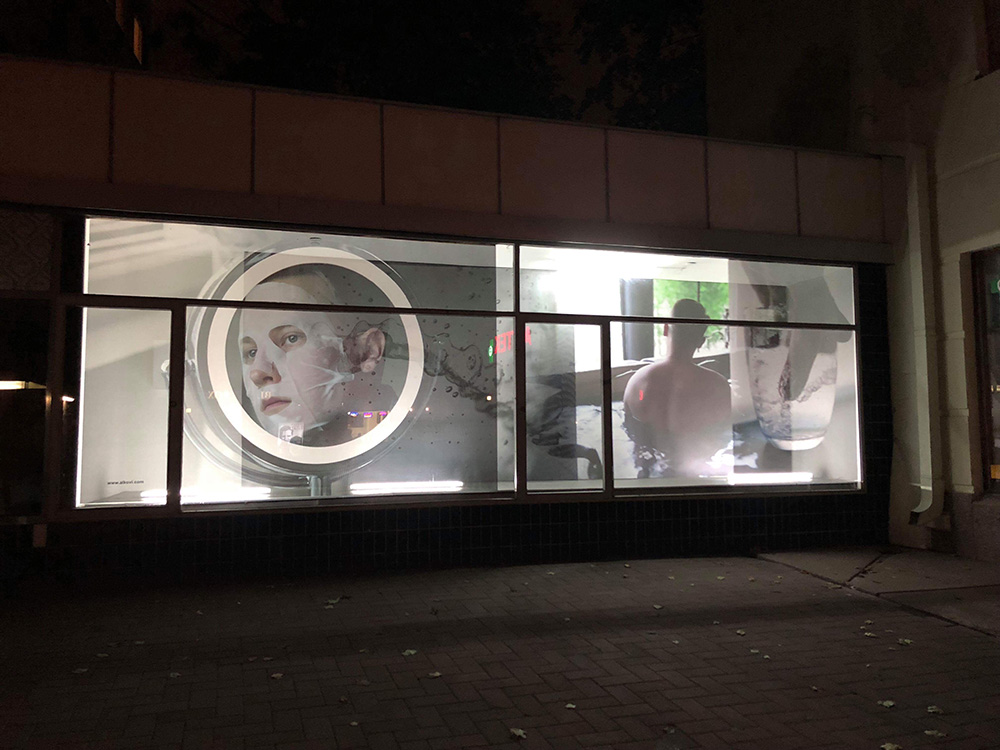
ARTOR JESUS INKERÖ:
Straightener
[FIN] Artor Jesus Inkerö (s.1989) työskentelee muodonmuutoksien, performanssin, valokuvan ja videoiden kautta, jotka muodostavat kokonaisuuden keholliselle hankkeelle joka on alkanut vuonna 2015. Inkerö on käsitellyt - esimerkiksi kehonrakennuksen ja äänenmuokkauksen kautta - sitä kuinka muuttaa kehoa siten että se edustaa kaikkein tavanomaisinta maskuliinisuuden muotoa. Tässä näyttelyssä esillä oli kokonaisuus kuvia, joiden taustalla oli Inkerön kokemus ajan viettämistestä vanhempiensa luona.
Inkerön teoksia on esitetty esimerkiksi New Museumissa New Yorkissa, Wäinö Aaltosen museossa Turussa, Kunsthal Charlottenborgissa Kööpenhaminassa, EMMA Espoon modernin taiteen museossa, SALTS galleriassa Baselissa, sekä Saariaho Järvenpää galleriassa Helsingissä kuin myös Nykytaiteen museo Kiasmassa.
'Straightener'
Olen tänä kesänä viettänyt paljon aikaa perheeni kanssa. Asun siellä heidän talonsa vierashuoneessa, vain viikonloppuisin käyn kotonani Helsingissä. Suuhygienistini Katja suositteli minulle hammaskiven poiston yhteydessä hampaiden suoristusta, ilmeisesti se olisi aivan helppo toimenpide ja hänen kaverinsa tekee sitä. Nykyään on tuollaisia läpinäkyviä hampaiden suoristajia, Invisalign merkkisiä.
Suoristajia suositellaan pidettävän vähintään 22 tuntia päivässä suussa, optimal wear 22 hours lukee säilytysrasian pohjassa. Laitan ne aina kylpyhuoneessa juomalasiin huuhtoutumaan ja laitan veteen liukenevaa tekohampaiden puhdistusainetta, se on jotain klooria. Maistuu ainakin vähän samalta kuin vanhempien poreamme tuoksuu.
Järjestin siskoni kanssa photoshootin, hän otti kuvia kun minä poseerasin. Halusin, että kuvat näyttäisi jotenkin mainoksellisilta, vaikka olisikin dokumentaarisia taidekuvia. Teksti: Artor Jesus Inkerö
[ENG]Artor Jesus Inkerö (b. 1989) works with self-transformations, photographs and videos, which are all part of a holistic bodily project that started in 2015. Inkerö has dealt with the subject matter - through for instance bodybuilding and voice therapy - on how to transform their body to represent the most generic type of contemporary masculinity. In this exhibition at Alkovi Inkerö presented images that tapped into the experiences gathered at Inkerö's parents house and also from the experience of spending time there.
Inkerö has exhibited in a variety of art institutions and galleries such as New Museum, New York City; Wäinö Aaltonen Museum Of Art, Turku; Kunsthal Charlottenborg, Copenhagen; EMMA Espoo Museum Of Modern Art, Espoo; SALTS gallery, Basel Switzerland; Gallery Saariaho Järvenpää, Helsinki; Museum Of Contemporary Art Kiasma, Helsinki.
'Straightener'
"My aligners are floating in a drinking glass on the counter of my parent's utility room, which has the weirdest light box type walls. Apparently, it is the latest fashion in interior design. The aligners, floating gently, are of a light plastic 3D printed material.
Before relaxing in the whirlpool, I remove my South Korean face mask sheet and massage the rest of the formula on my face and on my neck. Dripping in lotion I dip into the water. The whirls are creating air bubbles in my swimwear, and they detach the skin's surface. The tension in my body releases.
These liquids absorb and react against my body, they change it and rearrange it, they caress and also become part of me."]
Text by Artor Jesus Inkerö
TOP / YLÖS

MARIA & NATASHA ARENDT:
Toinen Puškin / The Other Pushkin
[FIN] Maria ja Natasha Arendt ovat työskennelleet vuodesta 2010 teossarjan parissa, joka käsittelee Aleksandr Puškinia, Venäjän kuuluisaa ja keskeistä runoilijaa. Puškinin historia on linkittynyt heidän oman taustansa kanssa - Arendtien isoisoisä oli lääkäri, joka hoiti Puškinin ampumahaavaa viimeisessä kuolemaan johtaneessa kaksintaistelussa, jossa Puškin sai osuman taistellessaan vaimonsa Natalian kunnian puolesta ranskalaisen sotaherran ja diplomaatin Georges d'Anthèsin kanssa.
Arendtien teokset kuvittelevat toisenlaisia tarinoita ja menneisyyksiä Puškinille. Yksi näistä pohjautuu Pu¨kinin perimälle: hän oli Afrikasta tuodun palvelijan Abram Petrovich Gannibalin jälkeläinen. Gannibal oli tuotu Venäjälle lahjaksi Pietari Suurelle, jonka suosikiksi hän sittemmin tuli saavuttaen - aikakaudessaan poikkeavan harvinaisen - uran armeijan, insinööritöiden ja hallinnon saralla. Arendtien mielikuvittelu on mytologisia mittasuhteita saava spekulaatio siitä mitä Pu¨kinista olisi tullut, jos hän olisi selvinnyt kaksinkamppailusta, joka päätti hänen elämänsä. (Puškin oli kuolemansa aikaan parhaillaan kirjoittamassa kirjaa Abram Gannibalista.)
Arendtien teokset ottavat lähtökohdikseen henkilöhistoriat sekä kulttuurillisen yhteisen -kyseenalaistaen historiallisia hegemonioita mielikuvittelun ja vaihtoehtoisten luentojen kautta. Ensi näkemältä tämä vaikuttaa yksinkertaiselta leikiltä faktan ja fiktion kanssa, mutta itse asiassa osoittaa kohti sitä mitä tällainen toiminta itsessään voi tehdä: kaivautua ongelmallisuuteen tiettyjen historiallisien ajatusten, tottumusten, tapojen ja 'totuudellisuuksien' kuten nationalismin, eurooppakeskeisyyden, rodullisuuden, perinnöllisyyden sekä jatkuvuuden käsitteessä.
"Kuvittele että runoilijamme selvisi ihmeellisesti, mutta käydessään läpi kliinisen kuoleman muuttui dramaattisesti. Niin paljon, että hän jopa hylkäsi kirjallisuuden, ja ollen se mikä hän oli, riidanhaastaja, flaneeraaja, unien tulkitsija ja ennen kaikkea Venäläisen kitschin isä ... hän päätyi etsimään toisia tapoja ilmaista itsenään." (Lainaus tekstistä, jossa Arendtit kertovat projektistaan teosten esittämien yhteydessä Puškin-talossa Lontoossa 2011 ja Puškinin talomuseossa Pietarissa 2014.)
Maria Arendtin kirjontatyöt esittävät kuvitellun, ja jollakin tapaa vääristyneen, afrikkalaisen maiseman, joka on yhdistetty Pu¨kinin läsnäoloon - joko hahmona tai lainauksina hänen kirjoistaan ja runoistaan, kuten Kapteenin tyttärestä ja Jevgeni Oneginista. Tekstit viittaavat tuleviin katastrofeihin ja huonoon onneen - yhdessä pellavaliinassa ennustetaan lumimyrskyä ja toisessa on viittaus huonoon enteeseen: jänikseen juoksemassa pellon poikki. Tässä jänis on kuvattuna poikkeuksellisen laihana norsuna. Natasha Arendtin Pu¨kinin rintakuva tuo itse päähenkilön lavalle.
Tässä yhteydessä on aiheellista tuoda esiin myös se mistä puhutaan 'toiseuttamisena' - läntisestä perinteestä, joka jatkuvasti rakentuu asioiden eksotisoimiselle. Siinä tehdään rajat sen välille, mikä on tuttua, ja mikä on vierasta kyllästäen prosessin vallalla erottaa ne. Taiteelliseen toimintaan (kuvitteellisena ja toisia vaihtoehtoja esiintuovana) liittyy elementti - että tätä voi tehdä ainoastaan kiinnittämällä huomion niihin vikoihin ja epäonnistumisiin jotka kulkevat mukana kulttuurillisesti painottuneiden ja puolueellisten näkemysten kanssa.
Maria ja Natasha Arendt kasvoivat 'Maslovka' taiteilijakylässä Moskovassa, jossa heidän isöäitinsä, kuvanveistäjä Ariadne Arendt opetti heitä taiteen saralla 70-luvulla. Maria Arendt valmistui M.I.Kalininin ammattikorkeakoulusta 1988 ottaen osaa näyttelyihin aktiivisesti sen jälkeen. Natasha Arendt valmistui Stanislavkyn teatterikoulusta lavastajaksi ja muutti valmistumisensa jälkeen Lontooseen 1991. Hän asuu Moskovan ja Lontoon välillä ja on pitänyt näyttelyitä kansainvälisesti 1970-luvun lopusta lähtien.
Maria Arendtin teoksia useissa kokoelmissa kuten Venäläisen museon (Pietari), Trejakov-gallerian (Moskova), Schusevin arkkitehtuurimuseon (Moskova) ja I.Ajvazovskyn gallerian (Feodosia) kokoelmissa sekä yksityisissä kokoelmissa kuten Alberto Sandrettin kokoelmassa, Italiassa, Ranskassa (Toulouse) ja Englannissa (Brian Enon kokoelmat). Natasha Arendtin teoksia on myöskin Venäläisen museon ja Tretjakov-gallerian, sekä myös Moskovan arkkitehtuurimuseon kokoelmissa, ja Venäläisen nykytaiteen museon kokoelmissa (Jersey Cityssä, Yhdysvalloissa), I.AIvazovskiy galleriassa (Ukrainan kansallismuseossa) ja N.Kournikova gallerian kokoelmissa, kuten myös The Nukus museossa Uzbekistanissa, M. Voloshin museossa (Koktebel, Krimin niemimaa), Leonid Talochkin valtiomuseossa, sekä Moskovan yliopiston humanististen tieteiden osaston kokoelmissa (RGGU), ja useissa yksityisissä kokoelmissa.
[ENG]
Maria and Natasha Arendt have been working on the series of works about Alexander Pushkin, the seminal Russian poet, since 2010, continuously adding pieces to the series. The history of Pushkin is intertwined with theirs - Arendts' great grandfather was the doctor who treated Pushkin for the eventually fatal gunshot wound suffered in a duel fought over the honour of his wife Natalia with a French military man and diplomat Georges d'Anthès.
Arendts' works imagine different kinds of histories for Pushkin. One of these alternative histories built on the heritage of Pushkin: he was a descendant of Abram Petrovich Gannibal - an African servant send as a gift for Russian tsar Peter the Great, whose favorite he then became, having - during the times unusually - prominent career in military, engineering and governance. In the center of this imagination is the speculation of mythological proportions of what Pushkin might have become had he survived the duel that ended his life. (With a nod to the fact that in the time of his death he was on the process of writing a book about Abram Gannibal, his maternal ancestor.)
The pieces take as their points of entry the issues of family histories and cultural commons with the questioning of historical hegemonies through imagination and alternative readings. Something that can be firstly seen as a mere play between fact and fiction actually points towards the core of what this kind of exercise can do: excavate the problematics of certain historical notions, conventions and truisms such as nationalism, eurocentrism, race or concept of heritage and linearity.
"Imagine that our poet did miraculously survive, but having gone through clinical death he changed dramatically. So much so that he even abandoned literature, and, being as he was, a troublemaker, flâneur, dream interpreter and, after all, the father of Russian kitsch... he went on the lookout for other means of self-expression." (Quote from the text where Arendts' explain about the project that was previously presented in occasion of the exhibitions of the series in the Pushkin House in London in 2011 and in the Pushkin Apartment Museum in St Petersburg in 2014.)
Maria Arendt's embroideries show imagined and somewhat warped African landscapes combined with the presence of Pushkin - either in figure or as quotes from his books and poems, such as The Captain's Daughter and Eugene Onegin. The texts suggest upcoming catastrophes and bad fortunes: in the one linen cloth a snowstorm is prophesized, and in the other a reference to a bad omen of a hare racing through the fields is referenced - here the hare depicted as an abnormally skinny elephant. Natasha Arendt's Pushkin bust brings the main character to the stage.
It is relevant to discuss also the "othering"- a western tradition that builds on 'excotising' things and thus making the boundaries between familiar and foreign constantly laid with power to distinct them - artists built on this this by adding a layer that points to the function of art (as imaginative and alternative) - that can only be done by opening up the understanding of the faults and failures that travel within these culturally biased notions.
Maria and Natasha Arendt grew up in the 'Maslovka Artist Village' in Moscow where their grandmother, sculptor Ariadne Arendt, tutored them in arts in the 1970's . Maria Arendt graduated from M.I. Kalinin applied arts polytechnic in 1988 and has been taking part in exhibitions actively ever since. Natasha Arendt, after graduating in stage design from The Stanislavsky Theatrical School, moved to London in 1991. She currently divides her time between London and Moscow. She has been exhibiting internationally since the late 70's.
Maria Arendt's works are in the collections of the museums: Russian Museum (St. Petersburg), State Tretyakov Gallery, Schusev - State Museum of architecture (Moscow), National Picture Gallery of I.Ajvazovsky (Feodosia), Alberto Sandretti collection (Italy) and private collections in France (Toulouse) and England (the collection of Brian Eno). Natasha Arendt's works are in the State Russian Museum (St. Petersburg), State Tretyakov Gallery, The Moscow Museum of Architecture (MUAR), Museum of Contemporary Russian Art (Jersey City, US), I. Aivazovsky Gallery (State Museum Ukraine), N. Kournikova Gallery (Moscow), The Nukus State Museum (Uzbekistan), M. Voloshin State Museum (Koktebel, Crimea), Leonid Talochkin State Museum, Moscow university's humanist departments collection (RGGU), as well as a number of private collections.
TOP / YLÖS
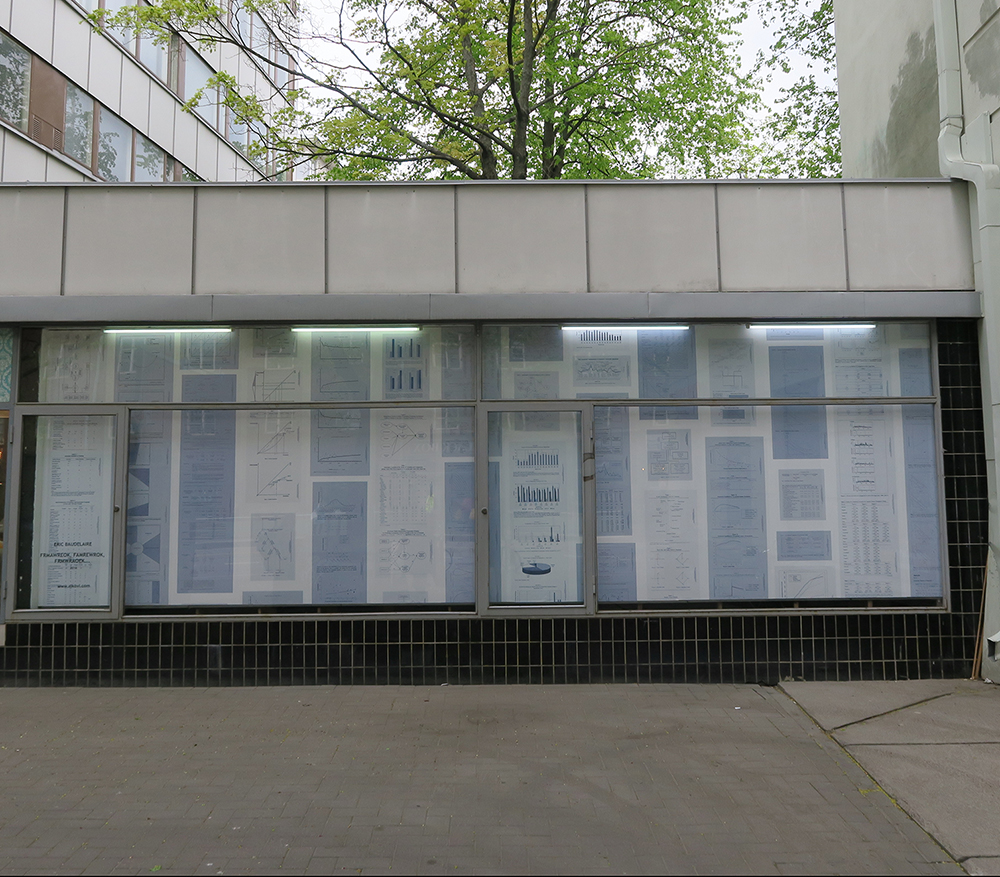
ERIC BAUDELAIRE:
FRMAWREOK, FAMREWROK FRMWRAOEK...(2016)
[FIN]Elokuvantekijä/kuvataiteilija Eric Baudelairen teoksessa FRMAWREOK, FAMREWROK FRMWRAOEK... (2016) on tapetille tulostettuna akateemisten julkaisujen artikkeleista kerättyjä kaavioita ja diagrammeja jotka kuvaavat terrorismia. Teoksen esittäminen liittyy kolmivuotiseen Koneen säätiön tukemaan tutkimushankkeeseemme, jossa käsittelemme tiedon muodostumiseen liittyviä kysymyksiä.
"Terrorismia on vaikea ymmärtää, se on moninaista sekä monista lähteistä kumpuavaa. Eräänlaisena datamassan (datakertymän) ilmentymänä nämä kaaviot kuvastavat pyrkimystä, sekä yritystä, ymmärtää ja tarttua aiheeseen. Kokonaisuudessaan kokoelma sisältää 423 kaaviota/kuvaa. Niiden moninaisuus muodostaa haasteen kuvastaen samalla myös sitä mahdottomuutta mitä aiheen käsittämiseen liittyy.
Aikana, jolloin vaihtoehtoiset totuudet nakertavat myös pohjaa tiedon käsitteen alta on tärkeää tuoda esiin tiedon muodostumiseen aina liittyvää epävarmuutta. Tutkiminen on tuon epävarmuuden vähentämistä, kulkemista kohti varmuutta, muttei koskaan kohti yhtä totuutta, eikä varsinkaan kritiikittömyyttä.
Se, mistä keskustellaan, tarvitsee kannattimia, ja kun puhumme määritelmistä, joudumme aina hyväksymään tietyn täydellisen viestinvälityksen mahdottomuuden, joka liittyy tulkinnan rooliin vuorovaikutuksessa.
On puhuttava myös tästä tulkitsemisesta, niistä keinosta ja uskomusjärjestelmistä jotka liittyvät asioiden esille tuomiseen. Samalla kun on mahdoton tiivistää asiaa kaavioon, on se kuitenkin aito pyrkimys ottaa selvää mistä on kyse. Kyse on loppujen lopuksi siitä, millaisia keinoja meillä on arvioida sen totuudenmukaisuutta." [Teksti: Miina Hujala]
ERIC BAUDELAIRE (s.1973) FRMAEOWRK niminen nättely oli esillä myös Fridericianumissa, Kasselissa vuonna 2014. Terrorismin aihe on ollut myös mukana Baudelairen aiemmissa teoksissaan kuten 'THE ANABASIS OF MAY AND FUSAKO SHIGENOBU, MASAO ADACHI AND 27 YEARS WITHOUT IMAGES' vuodelta 2011, jossa japanilaiset Punaisen Armeijan terroristit kertovat tarinansa, sekä viime vuonna valmistuneessa 'Also Known As Jihad' teoksessa, joka kertoo maiseman ja virallisten dokumenttien kautta pariisilaisen miehen matkasta Ranskasta Syyriaan ja takaisin.
[ENG] A work FRMAWREOK, FAMREWROK FRMWRAOEK... (2016) by Eric Baudelaire depicts charts, diagrams and graphs that are collected from various articles published in academic journals. Displaying the work in Alkovi is connected to a tree-year research project dealing with questions about knowledge and information supported by Kone Foundation.
"It is really difficult to understand terrorism, in many meanings, it is multifaceted and deriving from multiple sources. The data mass presented in the work, the charts, graphs, and diagrams, show the cacophony connected to the pursuit and the aspiration to depict the subject. At its entirety, the collection consists of 413 charts/graphs. The multiplicity of the material visualizes the challenge and a certain impossibility connected to the effort. In a time when 'alternative truths' threat to corrode also the credibility of research and knowledge production, it is important to point out the always inherit insecurity that is connected to the pursuit of knowing something. Researching is a way to decrease the insecurity but not a road towards certain truths, and in no ways lack of doubt or criticality.
Concepts and terms point towards things that happen and are active in the realm of discourse. Due to the role of interpretation we are always faced with limitations, as well the multitudes readings of meanings. Thus, we have to talk about the ways with which we understand, as well as the belief systems that are connected to bringing things forward, voicing things out. At the same time that it is perhaps futile and impossible to distill a subject to a graph, or describe it as a term, it also a genuine effort to depict something - what we are talking about in the end it boils down to questions relating to what we have as ways to assess the validity of information."
[Text: Miina Hujala]
ERIC BAUDELAIRE (b. 1973)FRMAEOWRK named exhibition was also presented in Fridericianum, Kassel at 2014.Baudelaire has dealt with the subject of terrorism also for instance in his works 'THE ANABASIS OF MAY AND FUSAKO SHIGENOBU, MASAO ADACHI AND 27 YEARS WITHOUT IMAGES' from 2011, where Japanese red Army terrorists tell their stories, or more recent film 'Also Known As Jihad' (2017) tells a journey of a Parisian man from France to Syria and back depicted through landscapes and official documents.
TOP / YLÖS

[Kuva/ Image: Nana Maiolini 'Red Rectangles']
RED MAY | Punainen Toukokuu
Kino Club + Reading Club An event at International Workers Day (1.5.2018) at 6pm and an exhibition until 9th of May that took place at Alkovi.
Students of The Fine Arts Academy from Kino Club and Reading group organized a special happening for the opening. It was a festive event celebrating the International workers day and Vappu. Kino Club and Reading Group collaborated on a public performance for the opening of the exhibition. The performance involved music and a video screening followed by serving soup to the public.
The theme of the exhibition and collaboration is 'Networks' and 'Reverse Images' reflecting on the history of dominant modes of mass-communication in relation to urban collectivism, student organizing, and community insurgency.
VIDEOORATOR was the installation in Alkovi shaped out of the digital works curated specifically for Red May by TMNW (This Might Not Work- working group). The concept by Ilya Orlov referencing the avant-garde artist Gustav Klutsis's the 1920s' utopian propaganda machine 'Radio Orator' In the installation, Klutsis 'Radio Orator'paper layouts, that were never implemented in his time, became real by turning into a VIDEOORATOR a new virtual platform for sharing today's artistic, political, social ideas, and critical thinking.
In the Screening:#1 SEMAPHORE Flatchestedmama
#2 SCREENINGS Kasra Rahmanian
#3 WHY DON'T YOU SPEAK FINNISH? Fatmir Mustafa-Karllo
#4 MEDIATED PRESENCE/ PERFORMANCE Ksenia Yurkova
#5 GO BACK GO LEFT Arash Akhlaqi
#6 SANTA CLAUS IS COMIN' TO TOWN, (YOU BETTER WATCH OUT) Hami Bahadori
#7 UNTITLED - Jo Kjaergaard
#8 CHINOISE2018 Jani A. Purhonen
#9 THE COST OF PRIVACY Jessica Escobar
#10 61217 Verneri Salonen
#11 Jo Kjaergaard
#12 PERUNA SAARI. KANAVA Sashapasha
#13 RED PRESENCE Esther Planas
#14 NANA MAIOLINI
#15 JAANA KOKKO
#16 PAOLA FIGUEROA
Music performance: Burdo Rotts Pavel
"What is it that today some of us are connected to all parts of the world via internet (and might even know hundreds of colleagues internationally) but we might not know any of the people who live with us in the same apartment complex? At the same time, many others around the world are in constant state of fear and paranoia form war and terror."
Kino Club:Paola Figuero
Lasse Krister Vairio
Verneri Salonen
Theo Tornberg
Rotts Pavel
Sekular Tomasz
Marie Boisson
Ignat Burdo
Reading Group:
Linda Ciesielski
Arash Akhlaghi
Hami Bahadori
Jo Kjaergaard
Gökce Sandal
Ilya Orlov
The exhibition was supported by Kuvataideakatemia. RED MAY [https://www.redmayseattle.org/] is a month-long festival of Radical Art and Thought taking place at Seattle, in United States. In the festival various speakers deal with the questions linked with the contemporary cultural situation and for instance capitalism. Alkovi was one of the offsite partners of the event also in 2017.
TOP / YLÖS

DAVID TER-OGANYAN
[FIN] Suuret kankaalle tulostetut printit valtasivat Alkovin ikkunavitriinitilan lähes koko tilan leveydeltä. Koska Alkovi (läpi vuorokauden esillä olevana taidetilana) on jatkuvassa vuorovaikutuksessa ympäröivän kadun elämän kanssa, halusimme esittää Ter-Oganyanin töitä, jotka ovat voimakkaasti lähtöisin julkisesta toimijuudesta ja kaduilta.
Alkovissa esillä olleet teokset ovat suurennoksia vuosina 2001 - 2003 tehdystä digitaalisten piirrosten sarjasta. Karkeasti pikselöityneestä mustavalkoisesta kuvamassasta nousee esiin kuvia: ihmisiä, lippuja, kohotettuja nyrkkejä, toimintaa, sekasortoa. Kuvia mielenosoituksista ja marsseista. Teokset muistuttavat katsojaa julkisen tilan olennaisesta tärkeydestä yhteiskunnallisen mielipiteen esilletulon alustana, mutta myös mielenosoittamisen toistuvasta ja kehällisestä olemuksesta. Erityisesti nyky-Venäjällä mielenosoittajat ovat jatkuvasti kasvotusten julkisen kokoontumisen äärimmäisestä tärkeydestä sekä samanaikaisesta turhuudesta, kun valtio kiristää otettaan julkisen puheen sekä kokoontumisen suhteen. Mielenosoituksia tapahtuu, mutta muutos jota niin kipeästi kaivataan odottaa tulemistaan.
David Ter-Oganyan (synytynyt 1981) tuli mukaan taidemaailmaan hyvin nuoressa iässä. 1990-luvun lopulla hän yhdessä ystäviensä, isänsä - sekä vanhempien kollegojensa Moskovan aktionistisestä liikkeestä kanssa - järjestivät tilaisuuksia, jotka yhdistelivät taidetta ja poliittista anarkismia. Tämä toiminta jatkui 2000-luvulle asti, kun Ter-Oganyan oli mukana perustamassa Radek- taiteilijaryhmää. Ter-Oganyanin taide koostuu piirtämisestä, maalaamisesta, objekteista, digitaalisesta taiteesta ja performatiivisista tilanteista. Sen perustana toimii vaihtoehtokulttuureihin liittyvä ajatus, jossa taide luo toimijuutta sekä päin vastoin.
David Ter-Oganyan on ollut esillä yksityisnäyttelyissä MUMOK Nykytaiteen museossa (Wien), Multimedia Art Museum:ssa (Moskova), XL-gallery:ssä ja Guelman Gallery:ssä (Moskova) sekä Prometeogallery:ssä (Milano) ja DiehlCUBE:ssa (Berliini). Hänen teoksiaan on ollut esillä myös lukuisissa taidemuseoissa ja tapahtumissa kuten: New Museum (New York), Varsovan Nykytaiteen museo, Künstlerhaus Bethanien, Manifesta 4 (Frankfurt), 10. Istanbulin biennaali, Moskovan Biennaali (2005) ja Torinon Triennaali (2005). Ter-Oganyanille on myönnetty "Black Square" taidepalkinto (Moskovassa 2004) sekä Henkel Art Award (2011).
[ENG] Two large scale prints on canvas occupied almost the full length of the display window (vitrine) space. Alkovi (as a 24/7 public art space) is in ongoing interplay with the surrounding life on the street - the reason behind our aspiration in showing Ter-Oganyans work, that of which is heavily rooted in public action and the street.
The works on display in Alkovi were enlargements from a series of digital drawings from the years 2001 - 2003. The crudely pixelated black and white pictorial mass creates a pattern from which images arise: people, flags, raised fists, action, upheaval. They are street views of demonstrations and marches. The work reminds us of the acute importance of public space as the platform for societal opinion, but also the repetitive and cyclical nature of public manifestations. Especially in contemporary Russia, people are constantly reminded of the simultaneous urgency and, on the other hand, futility of demonstrating while the state power tightens its grip towards the rights for public speech and gathering. The demonstrations keep happening, but the change they so desperately seek for keeps on awaiting.
David Ter-Oganyan (b. 1981) got into the art world in a very young age. Together with his friends, father and more veteran colleagues from the Moscow actionist movement in the end of 1990's they created various actions combining art and political anarchism. This continued to the 2000's when Ter-Oganyan organized events and made art as a co-founding member of the Radek Group. Ter Oganyan's art consists of drawing, painting, objects, video, photography, digital art, performative actions. It is founded in the counter-culture situation where art creates agency and vice versa.
David Ter-Oganyan has been presented in solo shows in Museum of contemporary art MUMOK (Vienna), Multimedia Art museum (Moscow), XL-gallery (Moscow), Prometeogallery (Milan), Guelman Gallery (Moscow) and DiehlCUBE (Berlin). His work has also been on display at New Museum (New York), Warsaw Museum of Contemporary Art, Künstlerhaus Bethanien, Manifesta 4 (Frankfurt), 10th Istanbul Biennale, Moscow Biennale (2005 ) and Turin Triennal (2005). Ter-Oganyan is the winner of "Black Square Art Price" (Moscow, 2004) and Henkel Art Award (2011).
TOP / YLÖS
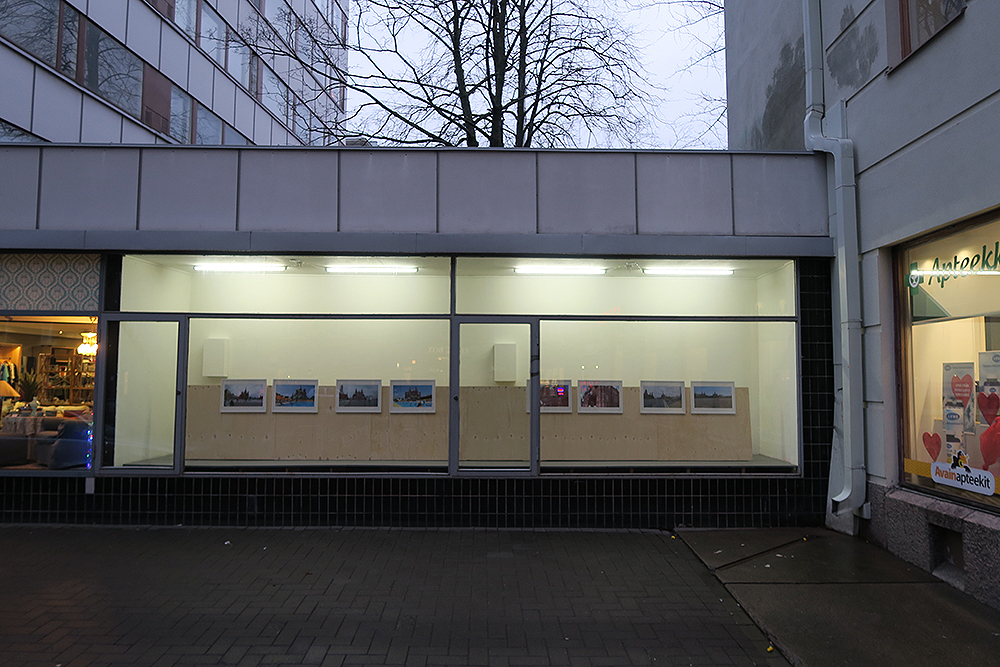
ANNA JERMOLAEWA:
Kremlin Doppelganger
(2008-2009)
Location 1: Moscow, 2008, Red Square
Location 2: Turkey, Antalya - the Kremlin Palace Hotel, a "doppelganger" of the Moscow original completed in 2003
[FIN] Esillä oli osuus valokuvasarjasta 'Kremlin Doppelganger', jossa Anna Jermolaewa on kuvannut sekä "aitoa" Kremliä Moskovan Punaisella torilla, että siitä tehtyä kopiota Antalyassa, Turkissa. Aurinkoisessa ympäristössä ja uima-mahdollisuuksilla paranneltuna, Kremlistä tulee eräänlainen soihtu sille, miten valta - myös poliittisen vallan kuva - on kiinni mielikuvissa. Teoksessa metaforisesti ilmentyy pyrkimys perustaa vallan viihdekeskuksia - tällä tavoin hämätä, hämärtää, hapertaa ja huojuttaa sekä etäännyttää julkista kosketusta siihen mitä on valta paradoksaalisesti tuomalla sen julkisivun lähemmäksi, turvallisemmaksi ja tutummaksi, samalla vahvistaen kulissien takana tapahtuvaa vallankäyttöä.
Näyttely on osa laajempaa hanketta, jossa tarkkailemme totuuden sekä tiedon muodostumisen kysymyksiä. Erityisesti myös propagandan, disinformaation ja tiedonvälityksen merkitystä. Painotuksellisena tapahtuma-alueenamme on Venäjä, ja yhteistyökumppaneinamme venäläiset, venäjällä toimivat - tai venäjää käsittelevät - taiteilijat, kuraattorit, taide-toimijat sekä tutkijat. Hanketta toteutetaan Koneen Säätiön tuella.
Anna Jermolaewa (s.1970) on kotoisin Pietarista, Venäjältä ja on asunut sekä työskennellyt Wienissä, Itävallassa vuodesta 1989. Hän on suorittanut maisterintutkinnon taidehistoriasta Wienin yliopistosta sekä maalauksen ja graafisen taiteen / uuden median osastolta Wienin taideakatemiasta. Videoissaan, valokuvissaan, sekä installaatioissaan hän analysoi sosiaalisia keskinäisriippuvaisuuksia sekä jokapäiväisen elämän poliittisia tilanteita. Hänen töidensä hienovarainen huumori paljastaa historian ja vallan esiintulemisen yksilön kokemuksessa. Hänen viimeisimmät yksityisnäyttelynsä ovat olleet 21 Haus (Wien), Johan Widauer Galerie (Innsbruck), Kerstin Engholm Galerie (Wien), Kunsthaus Nexus (Saalfelden), ja Kansallisessa nykytaiteen keskus Zachetassa Varsovassa. Tämän lisäksi hänen teoksiaan on ollut esillä Kiovan, Moskovan ja Berliinin Biennaaleissa, sekä hän osallistui 2014 ISCP residenssi studio-ohjelmaan New Yorkissa.
Tässä kontekstissa Jermolaewan näyttelyyn liittyy myös samanaikaisesti Viipurissa Aalto-kirjaston lastenosastolla esillä ollut Pilvi Takalan videoteos 'Real Snow White'(2009). Teoksessa Takala on pukeutunut Lumikin asuun ja ilmestyessään Pariisin Disneylandin sisääntulo portille aiheuttaa hämmennystä, tuoden esiin kysymyksen: Mikä on "oikea" Lumikki? Mihin aitous kytkeytyy, ja miten sitä hallinnoidaan? Teoksesta ja sen installoinnista kirjastoon lisäinfoa löytyy täältä:alkovi.linnake.net/Takala.html >>>> Real Snow White in Vyborg
[ENG]Exhibition showed photographs that were a part of the photoseries 'Kremlin Doppelganger' by Anna Jermolaewa. She has photographed the "real" Kremlin at the Red Square in Moscow as well as its copy located at Antalya, Turkey. In a sunny environment with added swimming facilities Kremlin becomes a sort of a "beacon" for how power - the image of political power - is attached to creating impressions. In the piece the aspiration to build entertainment centers of power resonates metaphorically. This is a way to disguise, delude and shatter as well as distance public or common attachment of what power is by paradoxically bringing its façade closer, making it safer and seem familiar, at the same time strengthening the use of power that happens behind the scenes.
This exhibition is a part of a wider project, where we deal with the questions concerning the formation of truth as well as knowledge. Specifically, the notions of propaganda, disinformation and information transformation that is connected to this. Our focus of interest is Russia, and we collaborate with Russian artists, curators, researchers, and other active participants in the realm of art - also with people working with emphasis' or themes connected to Russia. This project is being supported by Kone Foundation.
Anna Jermolaewa (b.1970) is from St. Petersburg, Russia and has been based in Vienna, Austria since 1989. She holds a Master in Art History from the University of Vienna and a Master in Painting & Graphic Art/New Media from Academy of Fine Arts Vienna. In her videos, photographs, and installations, she analyzes social interrelations and political circumstances as they appear in everyday life. The subtle humor of her works reveals the effects of history and power manifested in the individual's experience. Her most recent solo exhibitions were at 21 Haus (Vienna), Johan Widauer Galerie (Innsbruck), Kerstin Engholm Galerie (Vienna), Kunsthaus Nexus (Saalfelden), and the Zacheta National Gallery of Art in Warsaw. In addition to this her work has been presented in Kiev's, Moscow's and Berlin's Bienniale's as well as she has participated in 2014 to ISCP residency programme in New York.
In this context connected to Jermolaewa's exhibition was a simultaneous presentation of Pilvi Takala's work 'Real Snow White' at the Aalto- library in Vyborg, Russia. In this video work, Takala - dressed as snow white - is entering the Paris Disneyland and causing bafflement as well as with this act bringing out the question: What is the "real" snow white? Where does he authenticity connect into and how it is governed? More about the piece and its installment into the library can be found here: alkovi.linnake.net/Takala.html >>>> Real Snow White in Vyborg
TOP / YLÖS

KARI YLI-ANNALA:
APPARITIO
I osa & II osa
[FIN] Alkovissa oli esillä Kari Yli-Annalan installaatio, joka jakautui ajallisesti kahteen toisiaan seuraavaan osaan, joista jälkimmäinen valmistui nimenomaan tätä ajankohtaa varten.
"Installaationi Apparitio ensimmäinen osa on esillä Alkovin ikkunassa joulukuun alusta itsenäisyyspäivään. Sen keskeisin elementti on viime vuonna kuvattu video eduskuntatalosta, joka on remontin takia peitetty omalla kuvallaan, muistuttaen simulaatiota itsestään. Kansan valitsemien edustajien istunto- ja päätöksentekopaikka muistuttaa Hamletin Helsingörin linnaa, juonittelujen ja korruption tapahtumapaikkaa. Ihmisiä ei näy mutta Paasikivi-monumentin päällä päivystää lokki. Näkymättömät kädet tarttuvat katukiviin.
Apparition toinen osa tulee esille itsenäisyyspäivän jälkeen. Siinä esillä oleva video alkaa kahden maapallon illuusiolla. Superkonsumerismi nakertaa maailmaa jalkojemme alta, ikään kuin sen voisi tuhouduttuaan korvata uudella. Politiikan kaikkien sanojen lähde vaikuttaa olevan yksi ja sama sana." Teksti: Kari Yli-Annala
Kari Yli-Annala on helsinkiläinen kuvataiteilija, tutkija ja AAVE-festivaalin taiteellinen johtaja. Yli-Annala on myös tämän vuoden AVEK-palkinnon saaja. Palkinto annetaan vuosittain taiteilijalle mediataiteen saralla audiovisuaalisen kulttuurin edistämiskeskuksen (AVEK) toimesta.
[ENG] Presented at Alkovi for the duration of the end of the year was an installation by Kari Yli-Annala. Installation was divided into two different consecutive parts, of which the latter had been made specifically for this moment in time.
"My installation's Apparitio's first part is exhibited in Alkovi's window from the beginning of December until the Independence day. Its central element is a video work that depicts the parliament house shot last year, in which it was due to the renovation covered with its own image, reminding a simulation of itself. This site for decision making of the representatives selected by the people reminds of Hamlet's Helsingör's castle, a location for the scheming and corruption. There are no people visible in the piece but over the Paasikivi monument stands a seagull on guard. Invisible hands grasp the street stones.
Apparitio's second part is presented in the space after the Independence day. In this the video work starts from the illusion of the two earths. Superconsumerism eats away the world below our feet, as if it would be replaced after destruction by a new one. The texts that are part of the piece represent pure dada-poetry playing with the absurdity of the situation. The source of all the words in politics seems to be derived of one and the same word." Text by: Kari Yli-Annala
Kari Yli-Annala is a Helsinki-based visual artist, researcher and the artistic director of AAVE-festival. Yli-Annala is also the winner of this year's AVEK Award, given annually to an artist working in the realm of media art by the promotion centre for audiovisual culture (AVEK).
TOP / YLÖS
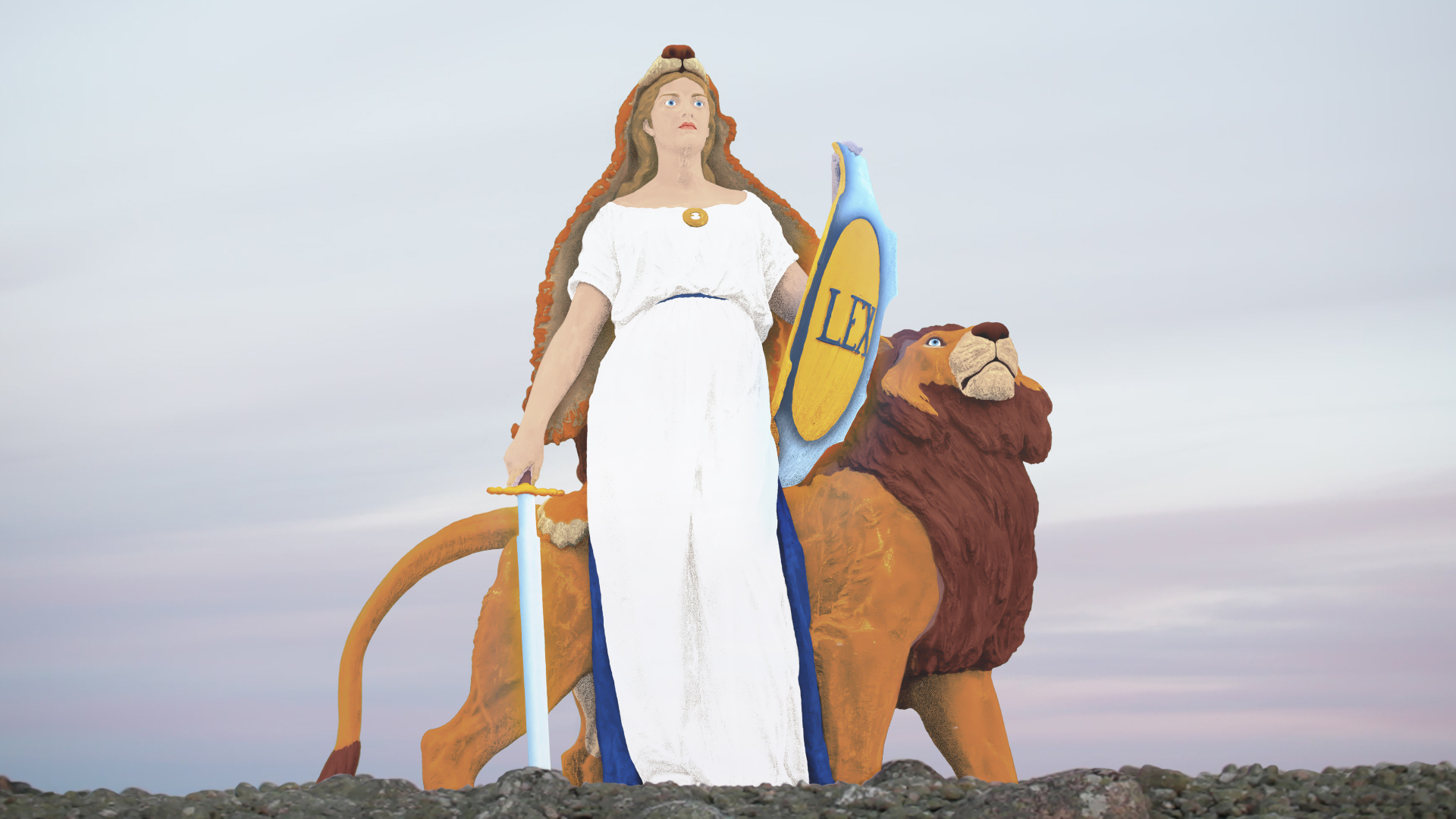
[Kuva/ Image: Jenni Luhta: 'Suomen henki]
JENNI LUHTA:
SUOMEN HENKI
[FIN] Suomen henki on kuvataiteilija Jenni Luhdan Suomen 100-vuotisajankohtaan valmistama 35-minuuttinen elokuva. Alkovin näyteikkunassa oli esillä viitenä kankaalle tulostettuna kuvanauhana kehyksiä elokuvan keskeisistä kohtauksista. Teos on Luhdan taiteellinen tulkinta niistä tekijöistä ja henkilöistä, joita ilman ei voi muodostaa kansallista itseymmärrystä Suomen viimeisestä 100 vuodesta. Näitä ovat hahmot kuten Muumipeikko, presidentit C. G. E. Mannerheim, J. K. Paasikivi ja Urho Kekkonen sekä kirjailija Paavo Haavikko. Teos kuvaa kunkin hahmon toisistaan erottamattomana kokonaisuutena, jonka ilmiasu on unenomainen, "henkien maailmassa" tapahtuva kuvaus. Elokuva valmistui Suomen 100-vuotisitsenäisyyspäiväksi 6.12.2017 ja se julkaistiin internetissä.
Jenni Luhta (o.s. Markkanen, s. 1986 Espoo) on helsinkiläinen kuvataiteilija. Hän tekee kuvia ensisijaisesti digitaalisella kuvankäsittelyllä. Kuvista hän koostaa video- ja installaatioteoksia, joiden käsikirjoittajana ja kertojana hän itse toimii. Lisäksi Luhta kirjoittaa mietelauseita, esittää puheenvuoroja sekä esittää ja säveltää musiikkia. Hän työskentelee yhdessä puolisonsa Lauri Luhdan kanssa, vuonna 2017 he osallistuivat yhteisellä sävellyksellään Lippulaulu 2017 -kilpailuun. Yksi Luhdan viimeisimmistä teoksista on antiikin ja kristinuskon moraalikäsitykset jäsentävä installaatioteos Jenni Luhdan Hyvän malli (Galleria Sinne, syyskuu 2016).
[ENG] 'Spirit of Finland' is a film work that artist Jenni Luhta has made in connection to the centennial of the Finnish independence. Some of the central scenes of the film were presented at Alkovi's display window as printed a picture strips. The work is Luhta's artistic interpretation of the factors and characters, "of which without one cannot form national self-awareness of Finland's last 100 years." These are characters such as Moomin Troll, the presidents C.G.E. Mannerheim, J.K. Paasikivi and Urho Kekkonen as well as author Paavo Haavikko. The film piece depicts each character as a inseparable entity, of which the appearance is dreamlike, depiction happening in the "spiritual realm". The film was made ready in order to mark the Finnish independence in 6th of December 2017 and published online.
Jenni Luhta (neé Markkanen, b. 1986 Espoo) is a Helsinki-based artist. She makes images mainly through digital image manipulation. From these images, she compiles video- and installation works, which she also scripts and narrates. In addition to this Luhta writes aphorisms, presents statements and also performs as well as composes music. She works together with her partner Lauri Luhta and in 2017 they participated together with a joined composition to Lippulaulu 2017 (The Flag Song) competition. One of Jenni Luhta's latest works was an installation about the moral conceptions of antique and christianity called 'Jenni Luhdan Hyvän malli' presented in Gallery Sinne at September 2016.
TOP / YLÖS

LADO DARAKHVELIDZE:
Cooking The New Planet
[FIN] "Teos rinnastaa historiallis-poliittisia henkilöitä ja ikonisia kuvia tämän ajan visuaalisen kulttuurin ja median hahmoihin. Ideologisesti ja poliittisesti latautuneet kuvat yhdistyvät massa- ja sosiaalisen median allegorioihin, niihin perustyökaluihin, jotka nykypäivänä "keittävät" maailmankuvamme ja mielipiteemme. Kuvien taustana toimiva raskas samettiverho saa katsojat pohtimaan, mitä se peittää - samalla tavalla kuin kyseenalaistamme, mitä manipuloivat mediastrategiat, poliittiset agendat ja niiden luomat lukuisat todellisuudet peittävät." - Kuraattorit Bitkina & Veits / TOK Teksti: Anna Bitkina & & Maria Veits
Lado Darakhvelidze (s. 1977 Kutaisi, Georgia) asuu ja työskentelee Arnhemissa, Alankomaissa. Darakhvelidzen taiteellinen työskentely keskittyy ensisijaisesti informaation ilmiöihin, mediaan ja sen sosiopoliittiseen vaikutukseen. Hän käsittelee työssään sosiaalisia ja poliittisia muutoksia, joita hän kuvaa omakohtaisten kertomusten kautta.
Darakhvelidze on opiskellut Hollannissa the Dutch Art Institute:ssa (DAI), hänen teoksiaan on esitetty muun muassa 11. Istanbulin Biennaalissa, What Keeps Mankind Alive (2009), Biennale Cuvee, Linz (2010), The Kitchen / One Big City (2013) ja Manifesta 10, Pietarissa (2014), Millennials, Museum Arnhem (2016).
Teos liittyy Anna Bitkinan ja Maria Veitsin (Creative Association of Curators TOK) kuratoimaan States of Control -hankkeeseen, joka käsitteli nykyistä ja historiallista mediatodellisuutta, propagandaa ja totuuden jälkeistä aikaa. States of Control -näyttely järjestettiin samaan aikaan Alkovissa ja HIAP:in Galleria Augustassa Suomenlinnassa, jossa näyttely oli avoinna 17.8.-01.10.2017.Darakhvelidzen näyttely toteutettiin yhteistyössä Kiasma Teatterin järjestämän URB 17 -festivaalin kanssa osana Connecting Points-ohjelmaa.
[ENG]"The work juxtaposes historical political figures and iconic images and characters of today's visual culture and media. Being extremely ideologically and politically charged, the images are combined with allegories of the mass and social media, the main tools of 'cooking' our worldview and opinions today. The heavy velvet curtain that serves as a background for images makes the audience wonder what it covers - the same way we question what is hidden by manipulative media strategies and political agendas and multiple realities they create" Text by Anna Bitkina & Maria Veits /TOK
Lado Darakhvelidze, (b. 1977, Kutaisi, Georgia) lives and works in Arnhem, the Netherlands. A hybrid artist-journalist-broadcaster, Lado Darakhvelidze (DAI 2010) creates flexible platforms for people to participate in his work which is an equal mixture of aesthetics and politics. Lado Darakhvelidze's artistic practice focuses primarily on the phenomena of information, media and its sociopolitical impacts. In his work he deals with social and political changes and represents these in personal narratives. Darakhvelidze studied at the Dutch Art Institute (DAI), his work was shown at the 11th Istanbul Biennial, What Keeps Mankind Alive (2009), Biennale Cuvee, Linz (2010), The Kitchen / One Big City (2013) and Manifesta 10, St Petersburg (2014), Millennials, Museum Arnhem (2016) among others.
The work was a part of the project called States of Control curated by Anna Bitkina and Maria Veits (Creative Association of Curators TOK) that deals with the current and historical context of media reality, propaganda, and post-truth. States of Control took place in Alkovi as well as HIAP / Augusta Gallery in Suomenlinna, where the exhibition was open 17.8.-1.10.2017. The exhibition was done collaboration with URB 17 - festival and as a part of HIAP's Connecting Points- Programme.
TOK is curatorial collective based in St Petersburg and founded by Anna Bitkina and Maria Veits in 2010 as a platform for conducting interdisciplinary projects in the fields of contemporary art and design and social sciences. TOK's projects have a strong social component and deal with current issues that are widely discussed both in Russia and internationally such as migration, public space and citizens, development of education, deprivation of social resources, forming collective memory, use of natural resources, growing role of the media in the global society, changing political climate and many others. For the last six years curators of TOK have been largely interested in exploring the concept of public space in post-Soviet Russia and the former Soviet Union, as well as perception, understanding and mechanisms of use of public spaces and open areas by residents of post-Soviet cities. One of the current interests of TOK is the repositioning of Russia at the global geopolitical arena and analysis of the processes that are related to it.
TOP / YLÖS

ILYA ORLOV:
1917: Weighed, Up-Measured, Divided
[FIN] Ilja Orlovin näyttely Alkovissa käsitteli vallankumouksen representaation mahdottomuutta - tässä tilanteessa liittyen vuoden 1917 vallankumouksiin, ja erityisesti maaliskuun 1917 mielenosoituksiin, jota Orlov on tutkinut. Näyttely käsittelee Orlovin sanomalehti-arkistosta löytämää kuvausta banderollista, jossa oli kuvattuna kolme sanaa 'punnittu, ylös-mitattu, jaettu (suomeksi vapaasti käännettynä.) Valokuvaa lipusta ei ole löytynyt, mutta 'lippu' on jättänyt vahvan jäljen mielenosoituksia kuvaaviin artikkeleihin.
[ENG] Orlov's exhibition in Alkovi examined the unrepresentable moment - in this case attached to the revolutions of 1917 which Orlov has studied already for a period of time. He came across a description of a banner in the newspapers reporting the demonstrations on March 1917. The image of the banner hasn't been found anywhere but it had left impression on the reporters - possibly due to the specific words it contained: Weighed, Up-Measured, Divided (here translated in english.)
"How to approach the experience and nature of revolution, the revolutionary moment of the 'rupture of time', giving the condition of the impossibility of [mimetic, metaphorical, sensual, etc.] representation in art, as well as that of the principal inaccessibility of time as a pure transcendental designation in our human perceptual experience? Perhaps, the answer lays somewhere in between object and word, image and enunciation.
The idea for this work came while I perused 1917's newspapers reports on the funeral of the victims of the February revolution in Petrograd on the 23rd March 1917 - a grandiose demonstration with more than one million participants involved, described by contemporaries as completely unprecedented - parade and review of all the revolutionary forces.Giving the apparently huge multitude of flags, slogans, and banners involved in the demonstration, it looked it was not by chance that three of the major newspapers described in details the same banner they have noticed among the revolutionary crowds. As reported, it was a huge banner with the image symbolically depicting the year of 1917 divided by the revolution into two parts: the Past with all its horrors - suppression, inequality, tyranny, and the Future, full of hope and happiness; the caption on the banner was: 1917: Weighed, Up-Measured, Divided.
I investigated the issue in the historical museums in St. Petersburg, but failed: there was even no photo-documentation of the banner remained. All I had was the 1917 newspapers reports.
On the other hand, I had no illusions about the artistic quality of the banner: I kept in mind that the visual culture of that time (between the February and October revolutions of 1917) was quite conservative - a neo-classicist and symbolist imagery combined with the Jugendstil fonts was the dominated visual morphology, even for the revolutionary banners of the period.
It was a time of economic crisis and instability, a hard situation at the front, universal euphoria over revolutionary liberation, total uncertainty about the future, and potential social fissure. Who among the artist of that time could reflect the proper way all that multiple political tensions and contradictions, that revolutionary 'rupture of time', that division the time into two parts? I guess it were the avant-garde artists, whose works were not recognized by the public of the period. The exemplary of the possible language came to my mind was V. Tatlin's Corner relief (1915) with its ropes stretched in tension between two walls, and the strange form hanging on it, in the corner. I think in March 1917 he could hold the same line. I decided to combine two approaches - that was to re-create the lost banner slogan 1917: Weighed, Up-Measured, Divided in Tatlin's way."
- Text by Ilya Orlov
Ilya Orlov (1973) is an artist and historian, a PhD candidate at the The Academy of Fine Arts, Helsinki. He graduated from the Faculty of Liberal Arts and Sciences (a partnership of St. Petersburg State University and Bard College, NY), where he majored in history, philosophy, political sciences and art. His undergraduate work focused on revolutionary mourning rituals in 1917, and he authored an MA-dissertation on aesthetics of nature and issues of landscape in contemporary curatorial studies. Orlov addresses artistic research from the standpoint of critical theory, the avant-garde, and neo-conceptual approaches. He has exhibited at the State Museum of Political History, St. Petersburg; the National Center for Contemporary Art, Moscow; the Moscow Museum of Modern Art, The State Tretiakov Gallery, Moscow. He also participated in the 4th Moscow Biennale; in the Manifesta 10, St. Petersburg and Checkpoint Helsinki's Finnish Landscape- exhibition in Seurasaari. In 2014 he shortlisted for Innovation Prize, the Russian state award for contemporary art. Ilya Orlov is a member of Rab-Rab committee, a board of Rab-Rab: Journal for Political and Formal Inquiries in Art.
TOP / YLÖS
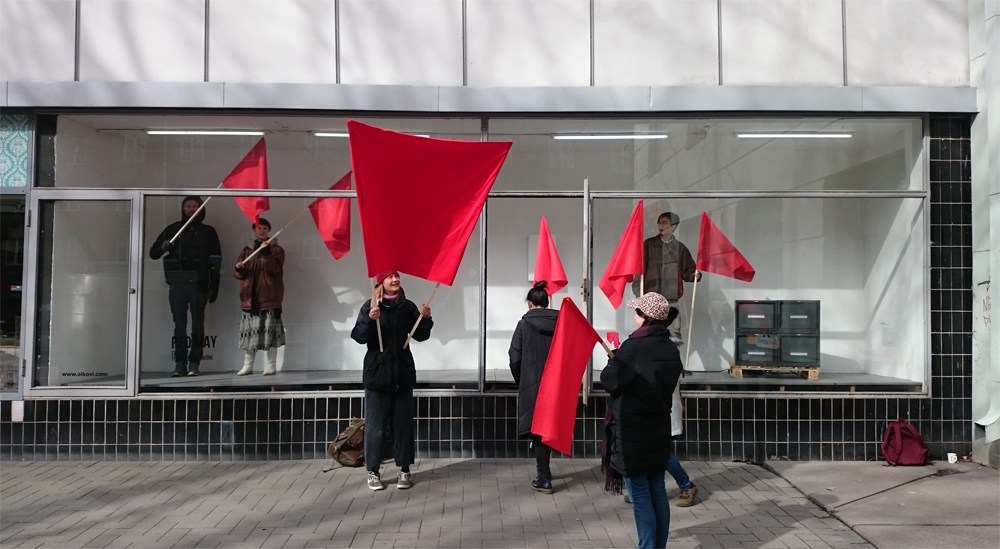
CURATED BY 'THIS MIGHT NOT WORK'
INSTALLATION BY HAMI BAHADORI & JO KJAERGAARD
The RED MAY events will happen during the month of May 2017 in Seattle and Helsinki. The works gathered by This Might Not Work will be an extension to the RED MAY festival, in order to support and promote these initiatives. The selected works have been either donated or made specifically for this platform by artists in regard to the current political situation of the world and United States. With the raise of far-right nationalism, fascism, and continuous war and destabilization of the Middle East, a part of the works gathered are addressing a frustration due to discrimination against various minorities, LGBTQ, migrant, nomad, Black Lives Matter, Native American, etc. The aim is to provide a space to generate conversations in analyzing the contemporary issues through Marxism, political economy, feminism, philosophy, and postcolonial theory in academic and non-academic settings in different locations in Seattle and Helsinki.
"MAYBE WE CAN'T MOVE BEYOND CAPITALISM BY NEXT WEEK BUT WE CAN SURE AS HELL TAKE A VACATION FROM IT."
Screening list:
#1 RED CATECHISM Philip Wohlstetter
#2 THE IDEAL UNIVERSITYÂ Hami Bahadori
#3 HE LOOKS PERFECTLY ALIVE AND WELL TO ME Timo Tuhkanen
#4 ARE YOU THINKING WHAT IM THINKING? Housemaid and The Fear
#5 BROWN RISE M. Jenea Sanchez
#6 UNLEASH YOUR CREATIVITY UPON THE WORLD Salinas and Bergman
#7 WALLS I, II Shoji Kato
#8 ROJO: EVENTOS Y APARICIONES Esther Planas
#9 RED ENVY Ellen Garvens
#10 THE CONQUEST OF NEW [_____] Brandon Aleson
#11 DARK ARCHIVE Matthew Schau Allen
#12 Y THO? Justyn Hegreberg
#13 RED Talena Lachelle Queen
#14 TRU TRUTH Gretchen Bennett
#15 RED_ARROW_POINTING_RIGHT Barrett White
#16 ASHDOD Tuukka Kaila
#17 MONITOR MAN Yassine Khaled
TOP / YLÖS

TANJA KIIVERI (ent.KOPONEN):
HOPE
(2016)
FRANK BRÜMMEL:
PALLAS
(2012)
[FIN] Alkovissa oli esillä kaksi teosta: Frank Brümmelin 'Pallas' (2012) ja Tanja Kiiverin (ent. Koposen) 'Hope' (2016). Brümmelin kivilaatassa lukee kolme sanaa 'Looking, Feeling, Deciding' - 'Katsoa, tuntea, päättää. Kiiverin (ent.Koposen) julisteen muotoinen teos on nimeltään Hope - Toivo.
"Olemme viime aikoina miettineet paljon sitä miten rakennamme arvoja yhteisesti sekä jäsennämme läsnäoloamme ja suuntaamme toimintaamme yhdessä? - kytkeytyen tai irtautuen siitä mitkä ovat vallitsevat arvot yhteiskunnassa. Teemme päätöksiä koko ajan mutta minkä pohjalta, minkä kautta suuntaamme toimintaamme ja ajatteluamme - miten toimimme yhdessä?
Joskus tuntuu että tarvitsemme erityisesti toivoa. Se ei ole mikään itsestäänselvä asia. Menettäessämme toivon menetämme näkymän tulevaisuudesta. Ilman suuntaa olemme eksyneitä, etsimme vain omia ääriviivojamme ja ne eivät vie meitä mihinkään. Ihmisen erityinen saavutus on olla jotain myös tulevaisuudelle. Muille kuin itselleen. Emme välttämättä näe aina kaikkea selvästi, tunteisiin luottaminen on vaikea asia, samalla kuin tunteet ovat puntari sille mikä on tärkeää, ovat ne myös kiihkoilun ja tuomitsemisen väline. Vaikka on oikeus ja mahdollisuus tuntea, ei tämä tarkoita oikeutusta toimia. Tässä tilanteessa tarvitaan oleellisesti sitä että teemme päätöksiä, yksin sekä yhdessä. Että ajattelemme, pohdimme, ja arvotamme. Että otamme kykymme huomioida ja tuntea vakavasti, että näemme toiset ja heidän kykynsä. Rebecca Solnit kirjoittaa teoksessaan 'Hope after dark' (josta tehtiin uusi painos viime vuonna) että kukaan ei voi tietää tekojensa kaikkia seurauksia, ja että joskus teoilla, (ja teoksilla, ja runoilla ja ajatuksilla) on yllättäviä, elämää mullistavia vaikutuksia. Hän kirjoittaa että jokainen teko vääjäämättä perustuu uskoon: "sinä vain toivot ottaen käyttöösi kaiken sen viisauden ja kokemuksen joka kaikkein todennäköisimmin vie sinut sinne minne olet menossa." Teksti: Miina Hujala
'Hope' teos oli ensi kertaa esitetty kesällä 2016 pietarilaiseen paikalliskirjastoon toteuttamassamme hankkeessa 'In Common'. 'Pallas' viittaa kreikkalaiseen mytologian viisauden ja tiedon jumalattareen Pallas Atheneen.
Tanja Kiiveri (ent.Koponen) helsinkiläinen kuvataiteilija. Hän valmistui kuvataiteen maisteriksi Kuvataideakatemian Tila- aikataiteen osastolta vuonna 2005. Koposen teokset ovat usein tila- ja paikkasidonnaisia liikkuvasta kuvasta, äänestä, valokuvista ja erilaisista objekteista koostuvia kokonaisuuksia. Koposen teoksia on on ollut esillä muun muassa yksityisnäyttelyissä Hippolyte galleriassa ja Galleri Sinnessä Helsingissä sekä Galerie Anhavan projektihuoneessa ja Suomen Valokuvataiteen museon Projekti-tilassa.Frank Brümmel asuu ja työskentelee Turussa. Hän opiskeli Akademie der Bildenden Künste Nürnberg:ssa ja valmistui kuvataiteen maisteriksi Kuvataideakatemiasta vuonna 2008. Brümmel on työskennellyt aiemmin kivenhakkaajana Saksassa, ja käyttää tätä taustaa usein lähtökohtana teoksilleen. Brümmelin teoksia on ollut esillä muun muassa Opelvillen Rüsselsheim:ssa, Lothringer13 München:ssa, Hämeenlinna taidemuseossa, Huuto Galleriassa, Titanik Galleriassa and Mäntän kuvataideviikoilla. Tänä keväänä hänellä on myös yksityisnäyttely Sculptor galleriassa Helsingissä. Brümmel on myös Puhekaraoke ryhmän jäse
[ENG] There were two pieces on display: Frank Brümmel's 'Pallas' (2012) and Tanja Koponen's 'Hope' (2016).
"Recently we have thought a lot about how we construct values together and how do we form our presence together and direct our actions? - in connection to or departing from what are the values present in the society at the moment. We make decisions together all the time but from what base do we direct our thinking and action - how do we act together?
Sometimes it feels that what we especially need is hope. And that is not a simple matter. ( A self evident matter). When loosing hope we loose a sight of the future. Without a direction we are lost - we are just looking for our own outlines and those won't take us anywhere. The specific ability of a human being is to be able to also be something for the future. For others than oneself. We don't necessarily see everything clearly always, and to trust one's feelings is a delicate (difficult) thing. At the same time as feelings are an essential factor on weighing in what is important, they are as well the means for arousal and judgement. Even though one might posses the right and ability to feel it doesn't validate the ways to act.
In this situation we essentially need to do decisions, alone and together. We need to think, assess, and valuate. We need to take our abilities to consider and feel seriously, and that we see each other and their abilities. Rebecca Solnit writes in her book 'Hope in the Dark' (which was re-published last year) that nobody can know the full consequence of their actions, and that sometimes actions, (and works, and poems, and thoughts) can have (and will have) supprising results and life-changing results. She writes that every act is inevitably an act of faith: you just hope and employ what ever wisdom and experience seems most likely to get you there. The stone slab that the written words are carved on as the eternal truths about eternal movement, the constant forms of change and the need to always deliberate anew. More than writing commandments into the stone, we should again and again come back to look, think and decide." Text by Miina Hujala
Tanja Kiiveri (ent. Koponen) is an artist based in Helsinki. She has graduated from the Department of Time and Space in The Academy of Fine Arts Helsinki in 2005. Her works are site- and situation specific installations that mostly consist of sound and video elements as well as photographs and objects. Recently Koponen has had solo shows at Hippolyte gallery and Galleri Sinne in Helsinki as well as in Galerie Anhava project room and the project space of the Finnish Museum of Photography.
Frank Brümmel lives and works in Turku, Finland. He studied at the Akademie der Bildenden Künste Nürnberg as well as in the Finnish Academy of Fine Arts, Helsinki where he got his MFA in 2008. Brümmel has a backgound working as a stonemason in Germany, and he often utilizes that as a formal reference in his work. Brümmel's works have been seen in exhibitions in Opelvillen Rüsselsheim, Lothringer13 München, Hämeenlinna Artmuseum, Huuto Gallery, Titanik Gallery and Mänttä Art Festival. This spring he will also have a solo show in Sculptor gallery in Helsinki. Brümmel is also a member of Speechkaraoke Action Group.
TOP / YLÖS
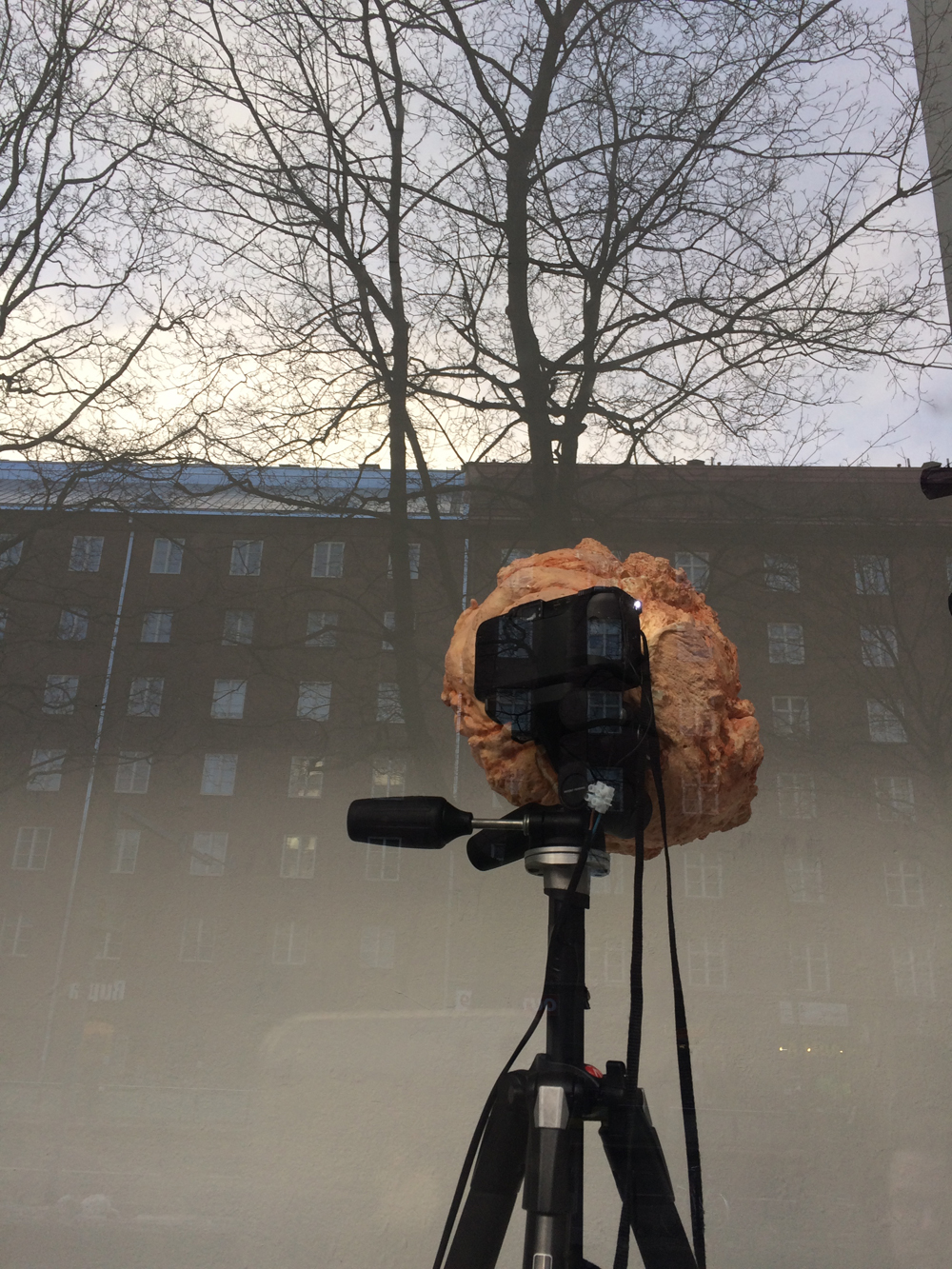
STEVE MAHER:
SOUL'S
[FIN] SOUL'S on Steve Maherin veistos/valo-installaatio Alkovissa, joka käsittelee sielun konseptia - liittäen sen kysymyksiin taika-uskosta sekä valokuvaamiseen liittyvästä totuus-arvon punnitsemisesta ja merkitsemisestä.
Steve Maher on Limerickistä Irlannista lähtöisin oleva kuvataiteilija, joka asuu tällä hetkellä Helsingissä. Maher osallistui 2016 Moskovan nuorten taiteilijoiden biennaaliin ja hän sai ensimmäisen Kieran Meagher Legacy Awardin vuonna 2014.
SOUL'S (2017) - Is a hyper-literal sculptural/light installation by Steve Maher, an interpretation of the metaphysical concept of the soul, a parasitic entity commonly featured in most world religions.
"The alchemy of light, phosphorus and silver never strayed far from the metaphysical dilemma of body and soul, the earliest photography was reviled for fear that it would somehow capture something unseen from ones fundamental self. In the Victorian era, this superstition became further entrenched by hoax spiritual photography, combinations of papier mâché, double exposures and cotton wool indistinguishable from the real thing.
Photography, as a chemical process has always been considered super-corporeal, even the suggestion of something ethereal through this frame is seemingly legitimised, more real than naked perception. Our eyes now see these forgeries for what they are, but we are no more advanced, we have not become more perceptive to truth just what is obscured has become more intricately hidden."
Text by Steve Maher.
Steve Maher is a visual artist from Limerick, Ireland based in Helsinki, Finland. Maher represented both Finland and Ireland in the V Moscow Biennale for Young Art and he was the Inaugural recipient of the Kierran Meagher Legacy Award 2014.
TOP / YLÖS
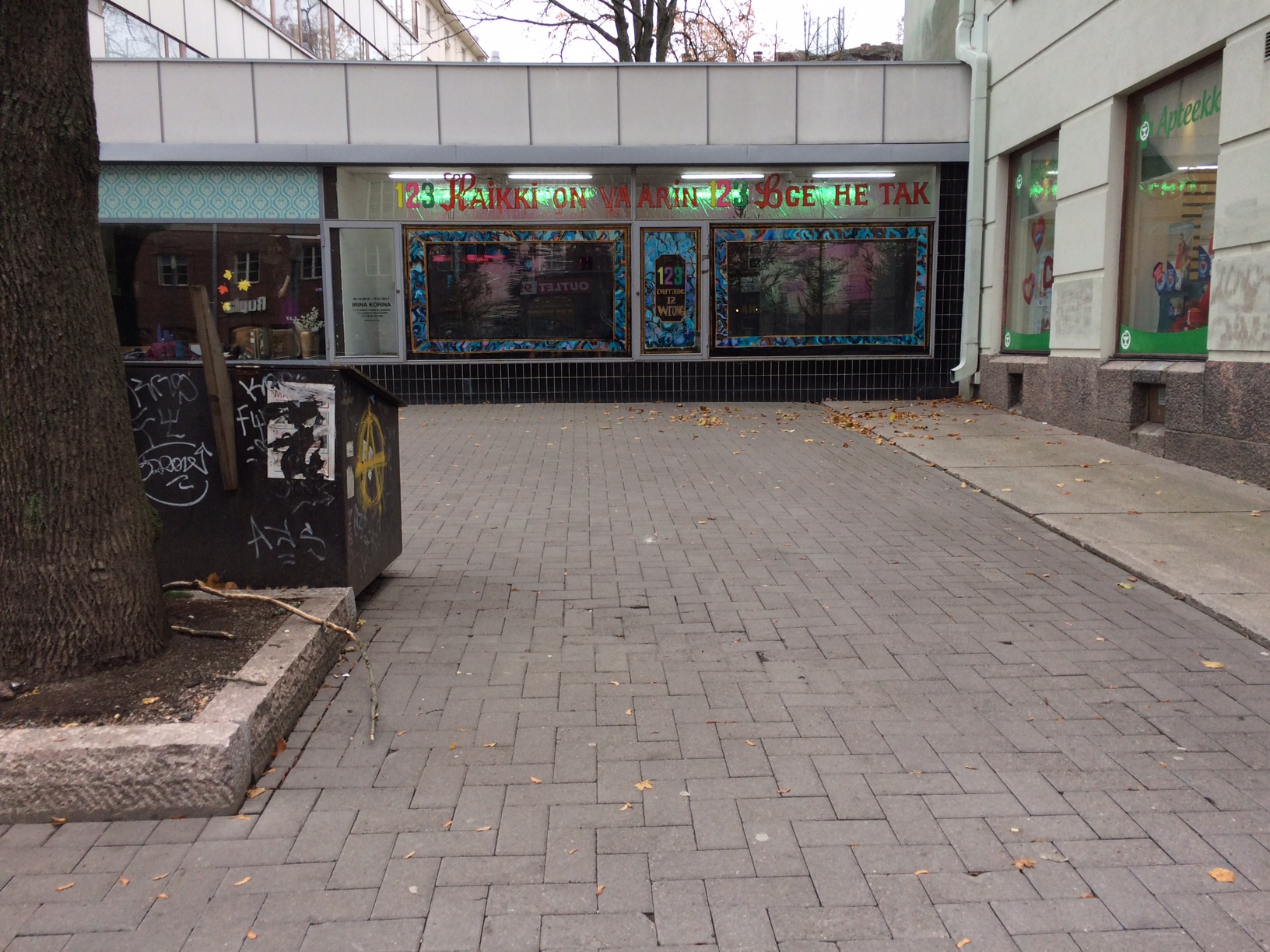
IRINA KORINA:
1 2 3 everything is wrong
[FIN] Irina Korina työskentelee käsitteellisesti tilojen, materiaalien ja ajallisten kerrostumien kanssa. Korinan teokset tuovat usein esiin viittauksia ja konsepteja, joissa yhdistyvat traditio ja nykyisyys. Vuonna 2009 Korina oli yksi Venetsian Biennaalin Venäjän paviljongin taiteilijoista. Hänen teoksiaan on esitetty muun muassa BAM:ssa (Brooklyn Academy of Music) New Yorkissa, Yhdysvalloissa ja Garage Center for Contemporary Art:ssa Moskovassa, Moskovan modernin taiteen museossa (MMOMA) Bloomberg Space:ssa ja Saatchi Gallery:ssä Lontoossa sekä PAC Milanissa. XL gallery edustaa häntä Moskovassa.
Korina työskentelee Helsingissä HIAP residenssissä Alkovin kutsumana osana HIAPin Connecting Points -ohjelmaan, jonka tarkoitus on tarkastella paikkoihin sidottua taiteen esittämistä sekä luoda yhteyksiä Suomessa ja Venäjällä toimivien taiteilijoiden, kuraattorien ja organisaatioiden välille. Miina Hujala ja Arttu Merimaa kuratoivat ohjelmaa vuonna 2016.
Alkoviin Korina valmisti uuden tilallisen kokonaisuuden, jossa nostalgian ja rappion teemat tulivat esiin tiettyjen kulttuuriin iskostuneiden viittauskohtien kautta.
[ENG] Irina Korina lives in Moscow and works conceptually with spaces, materials and temporal layers. Korina's work often brings forth references and concepts that merge together the traditional and the contemporary. In 2009 Korina was presented in the Russian pavillion in the Venice Biennale. Her works have been exhibited in BAM (Brooklyn Academy of Music) in New York and Garage Center for Contemporary Art in Moscow, Moscow Museum of Modern Art (MMOMA), Bloomberg Space and Saatchi Gallery in London and PAC Milan. XL gallery represents her in Moscow.
Korina was invited by Alkovi to work in Helsinki in the HIAP (Helsinki International Artists Programme) residency as a part of HIAP's Connecting Points program that functions as a platform for the exploring site-specific exhibiting practices and for creating relations between artists, curators and organisations in Finland and in Russia. Miina Hujala and Arttu Merimaa curated the programme in 2016.
For Alkovi Korina produced a new spacial installation that displed the themes of nostalgia and decay through specific cultural and visual reference points.
TOP / YLÖS
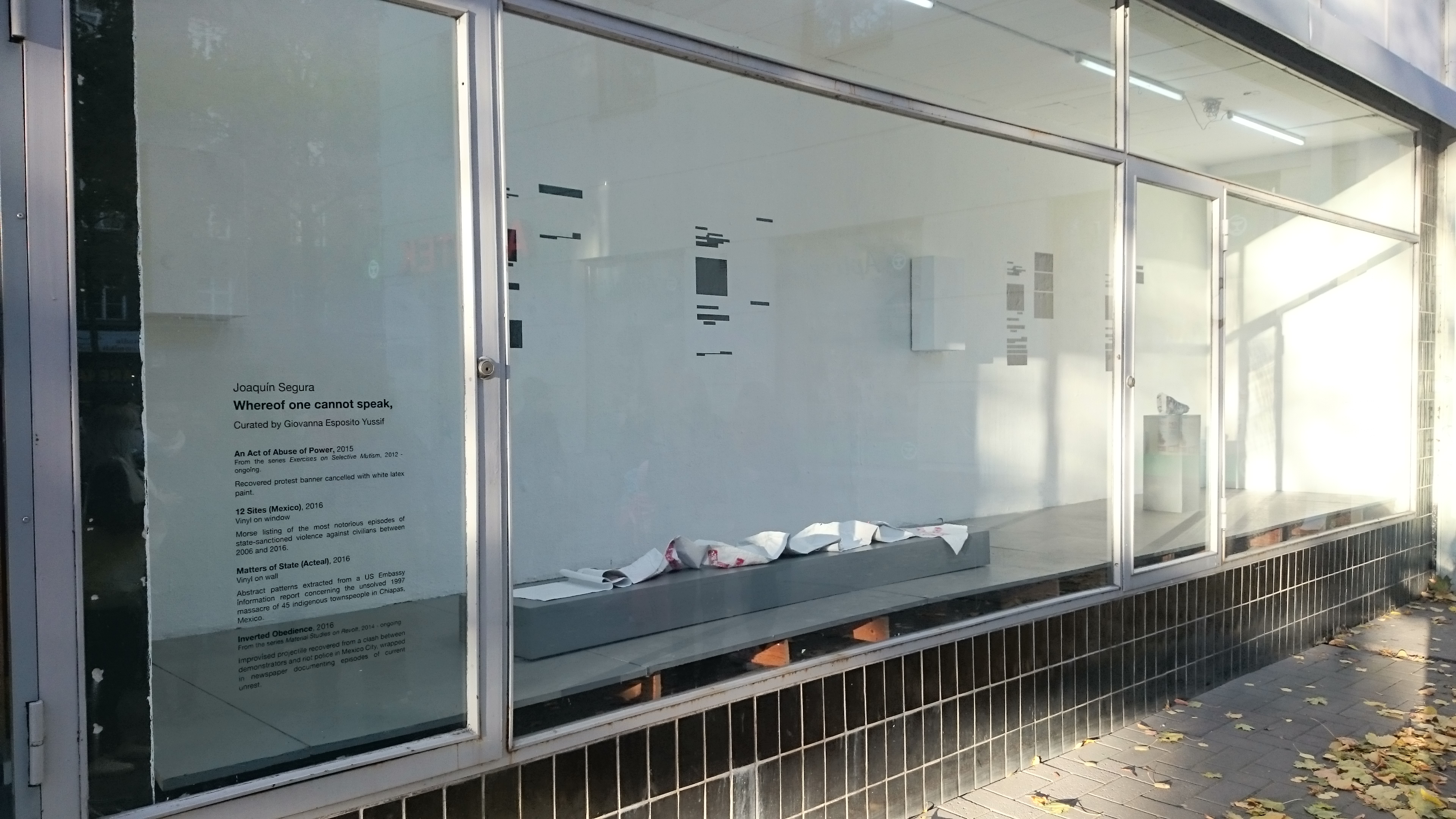
JOAQUÍN SEGURA:
Whereof one cannot speak, thereof one must be silent
Curated by Giovanna Esposito Yussif
[FIN] Alkovissa sekä Ingredients*-tilassa oli esillä kahteen eri osaan jakautuva näyttely taiteilija Joaquín Seguralta. Segura käsittelee työskentelyssään vihan ilmentymistä, sosiopoliittisia mikro-ilmastoja, epäsymmetrisen historian käsitettä ja ideologian roolia nykyhetkessä. Seguraa kiehtoo syvästi eri purkaumat, ristiriitaisuudet ja sosiaalisten megarakenteiden hajoamiset ja näiden oleellinen rooli globalisaation poliittisessa kriisissä, jota hänen töissään pääasiallisesti käsitellään arvioimalla yksityiskohtaisen historiallisesti merkittäviä ajanjaksoja ja niiden merkitystä nykyhetkeen.
'Whereof one cannot speak, thereof one must be silent' jatkaa Seguran tutkimusta vastarinnan ja epäonnistumisen ontologisesta merkityksestä esittämällä muodollisen analyysin kielestä jota käytetään sekä sosiaalisissa vastarintaliikkeissä että valtion sortotoimissa. Tässä viitekehyksessä teokset ovat myös erilaisten hiljentämisien, lopettamisten ja merkitysten muodostumisten tutkimista.
Perjantaina 7.10.2016 näyttelyiden avaamisen yhteydessä oli keskustelutilaisuus kuraattori ja taidehistorijoitsija Mariana Davidin kanssa Ingredients- tilassa.
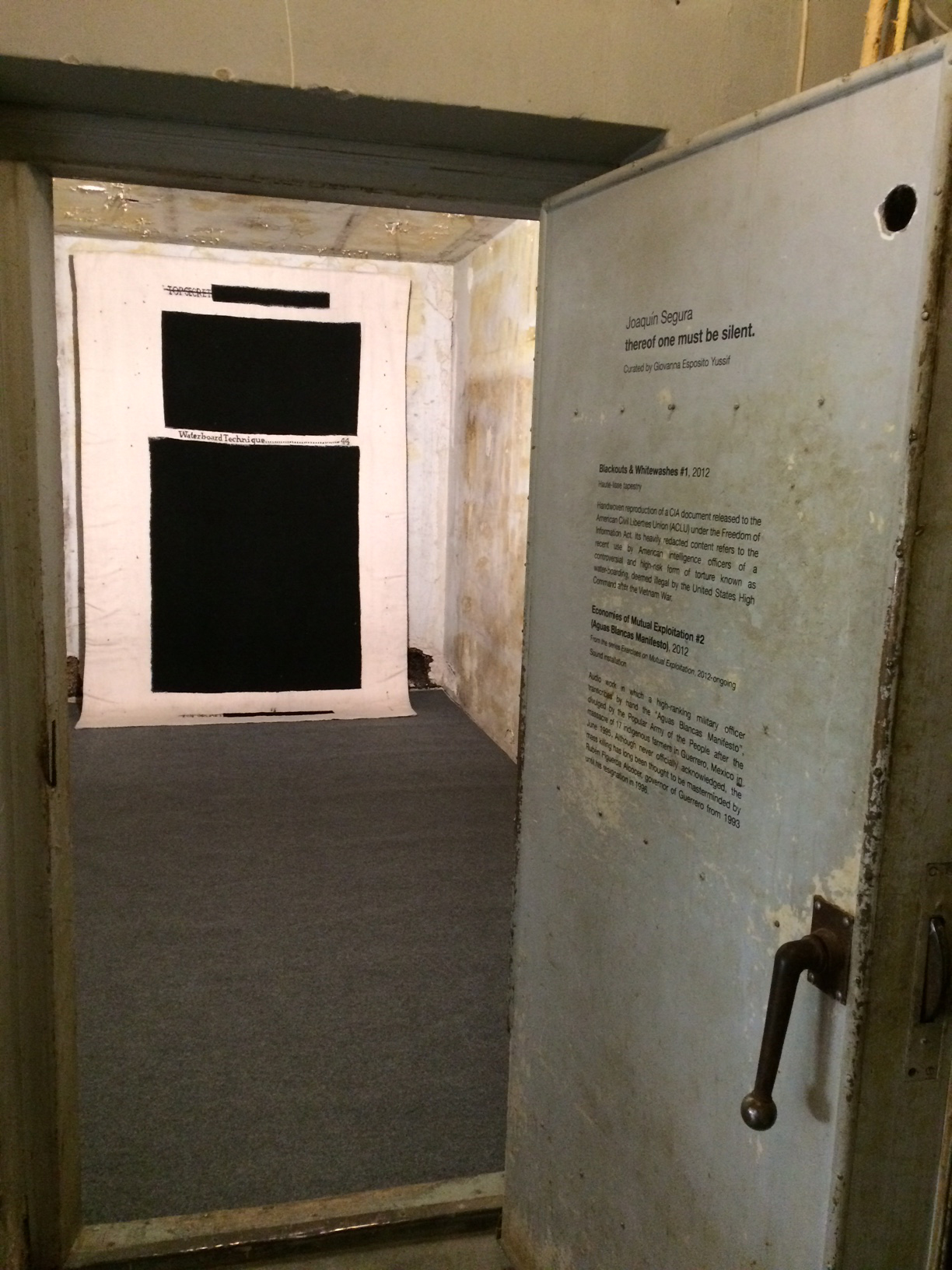
Joaquín Segura on kuvataiteilija joka työskentelee Meksiko Cityssa, Meksikossa. Hänen teoksiaan on esitetty yksityis- ja ryhmänäyttelyissä Meksikossa, Yhdysvalloissa, Euroopassa ja Aasiassa. Hänen teoksiaan ovat esittäneet muun muassa Sala de Arte Público Siqueiros, El Museo del Barrio, White Box, apexart, MoLAA, Museo Nacional Centro de Arte Reina Sofía, National Center for Contemporary Art Moscow, The Modern ja MCA Denver. Vuosien 2013 ja 2015 aikana hän on työskennellyt useissa residensseissä kuten Hangar - Centre de producció i Recerca d'Arts Visuals (Barcelona), MeetFactory - International Center of Contemporary Art (Prague), Impakt Foundation (Utrecht) sekä Casa Wabi (Oaxaca). Segura on Meksikolaisen taideorganisaatio SOMAn perustava jäsen sekä hallituksen neuvonantaja jäsen.
Mariana David on taidehistorijoitsija ja kuraattori, joka työskentelee Meksiko Cityssä. Hän on ollut vaihtoehtoisen taidetila La Panaderían koordinaattori, kuratoriaalinen assistentti Rufino Tamayo museossa sekä johtajana MUCA Roma, UNAM, jossa hän kehitti myös ohjelman The Right to the City. Freelance-kuraattorina hän on aloittanut Proyecto Juárez - hankkeen, joka on sarja taideresidenssejä ja julkaissut antologian Semefo 1990-1999: From the Morgue to the Museum.
Giovanna Esposito Yussif on kuraattori ja tutkija, joka työskentelee Helsingissä. Tällä hetkellä hän keskittyy toiminnassaan yhteyksien tuottamiseen tuotannon paikkojen, paikantuneen tiedon ja yhteistoiminnallisen tutkimuksen muotojen välille. Hän toimii aktiivisesti yhteistyössä erilaisten tahojen - kuten NÆS - Nomad Agency/Archive of Emergent Studies, Art Workers Helsinki, Night Schoolers, Rab-Rab Journal for Political sekä Another Road Map for Art Education- verkoston - kanssa. Hän on tehnyt myös yhteistyötä moninaisesti eri insituutioiden kuten HIAPin (Helsinki International Artists Program), Hanasaaren, Nykytaiteen keskus Framen, Sala de Arte Público Siqueiros, Galería OMR, Colección/Fundación Jumex, ja Laboratorio Arte Alamedan kanssa.
[ENG] Divided on two spaces and parts - Alkovi as well as in Ingredients* - an exhibition by Joaquín Segura was presented. Joaquín Segura's practice meditates on the phenomenology of violence, sociopolitical microclimates, the concept of asymmetrical history and the current role of ideology. Segura is deeply fascinated by the fissures, contradictions and collapses in the social superstructures and the crucial role these have played in the globalization of political crisis, which in his work are mainly explored through an intimate revision of historic significant episodes and their impact on the present moment.
'Whereof one cannot speak, thereof one must be silent' follows Segura's investigation on the ontological significance of dissent and failure by presenting a formal analysis on the language deployed by social contestation movements and state repression. In this frame, the works are as well an exploration of different forms of silencing, canceling and encoding.
On Friday 7.10. linked with the opening of the exhibitions there was a Q & A event at Ingredients with art historian and curator Mariana David.
Joaquín Segura is a visual artist based in Mexico City, MX. His work has been shown in solo and group exhibitions in Mexico, USA, Europe and Asia. Some spaces that have featured his work include Sala de Arte Público Siqueiros, El Museo del Barrio, White Box, apexart, MoLAA, Museo Nacional Centro de Arte Reina Sofía, National Center for Contemporary Art Moscow, The Modern, MCA Denver, among many others. Between 2012 and 2015 he undertook artistic residencies and research stays at Hangar - Centre de producció i Recerca d'Arts Visuals (Barcelona), MeetFactory - International Center of Contemporary Art (Prague), Impakt Foundation (Utrecht) , and Casa Wabi (Oaxaca). Joaquín Segura is a founding member and board advisor of SOMA, MX.
Mariana David is an art Historian and curator based in Mexico City. She has been coordinator of the alternative space La Panadería, curatorial assistant at the Rufino Tamayo Museum and director of MUCA Roma, UNAM, where she developed the Program The Right to the City. As a freelance curator, she launched Proyecto Juárez, a series of artistic residencies in the border town and published the anthology Semefo 1990-1999: From the Morgue to the Museum.
Giovanna Esposito Yussif is a curator and researcher based in Helsinki. Currently she focuses on rooting alliances between sites of production, situated knowledges and collaborative models of inquiry. She actively collaborates with different initiatives such as NÆS - Nomad Agency/Archive of Emergent Studies, Art Workers Helsinki, Night Schoolers, Rab-Rab Journal for Political and the network Another Road Map for Art Education. She has also collaborated with diverse art institutions such as Helsinki International Artists Program - HIAP, Hanasaari, Frame Visual Art Finland, Sala de Arte Público Siqueiros, Galería OMR, Colección/Fundación Jumex, and Laboratorio Arte Alameda among others.
TOP / YLÖS

ERÄS MARSSI
[FIN] Alkovissa esillä oleva printti oli lainassa Porin taidemuseosta. Valokuvadokumentti on porilaisen taiteilijaseura NYTE ry:n teoksesta 'Eräs marssi' vuodelta 1989. (Teos oli esillä Helsingin Kasarmitorilla 1980-luvulla sijainneessa galleriassa, joka oli nimeltään joko Kriittinen tila tai Vapauden aukio, lähteiden tiedot vaihtelevat.) Kuvan on ottanut taiteilija Kaisu Koivisto. Kuva on talletettu Porin taidemuseon tutkimusarkistoon: "Taiteilijaseura NYTEn arkisto vuosilta 1987-2001". Kyseinen printti oli kesällä 2016 esillä Porin taidemuseossa osana "Fluxus ny" -näyttelyä, jonka kuvataiteilija Henry Merimaa* koosti museon kokoelmista. Näyttely yhdisteli porilaisten NYTE -taiteilijoiden ja kansainvälisten Fluxus -taiteilijoiden teoksia.
Eräs marssi koostui suuresta laivan muotoon punotusta tekstiilikasasta, tuulettimista ja niiden synnyttämistä ilmavirroista sekä laboratoriolaitteiden laatutarkastuslappusista. Teos oli eräänlainen intuitiivinen materiaalikokoelma, jonka kautta tarkasteltiin tiettyä aikaan liittyvää tilannetta: venepakolaisuutta ja ihmisten liikkumista Suomeen 80-luvun lopulla, jolloin suurempi joukko pakolaisia saapui maahan Vietnamista ja myöhemmin Somaliasta.
Halusimme esittää Eräs marssi -teoksen Alkovissa nyt todetaksemme, että taiteen tekemisessä on läsnä sukupolvia läpäisevä tarve tarttua asioihin ja pyrkiä käsittelemään niitä - tuottaa ymmärrystä ja mahdollisuuksia muodostaa suhde aiheisiin, jotka toistuvat syklisesti suhteessa historiallisiin ja yhteiskunnallisiin tilanteisiin. Taiteen yhteiskunnallisuus perustuu nimenomaan tämän tarpeen jatkuvaan tunnistamiseen.
Porin taidemuseolle koottiin vuosina 1987-1990 Fluxus taiteilija Ken Friedmanin aloitteesta ja taidemuseon silloisen johtajan Marketta Seppälän toimesta kokoelma, joka pitää sisällään 131 yksikköä paperipohjaisia teoksia kansainvälisiltä Fluxus taiteilijoilta. 90-luvullä Porin taidemuseo myös järjesti useita suuren profiilin näyttelyitä Fluxus taiteilijoilta kuten Yoko Ono, Geoffrey Hendricks ja Dick Higgins. NYTE ry:n taiteilijat ottivat vaikutteita Fluxuksen käsitteellisyydestä, aktiivisesta suhteesta taiteeseen osana elämää ja arkea sekä luontaisesta taiteidenvälisyydestä. NYTEläiset myös osallistuivat muun muassa Yoko Onon ja Geoffrey Hendricksin näyttelyiden yhteydessä järjestettyihin performansseihin ja Fluxus aktioihin.
Fluxus oli (tai on) melko vapaamuotoinen, kansainvälinen ja poikkitaiteellinen taiteilijaryhmittymä, joka jatkoi dadan, anti-taiteen, kokeellisen musiikin, happeningien ja uusien taidemuotojen tarkastelun perinnettä Euroopassa ja Yhdysvalloissa 1960- ja -70-luvuilla. Enemmän kuin yhtenäinen joukko, Fluxus oli käsitteellinen ajattelu- ja toimintamalli tai taiteellisen praktiikan ilmentymä, jonka jakoivat useat eri paikoista ja taustoista tulevat taiteilijat eikä se näin ollen sijoittunut selvärajaisesti mihinkään tiettyyn historialliseen vaiheeseen.
NYTE ry on vuonna 1987 perustettu poikkitaiteellinen taiteilijaryhmittymä. Alussa NYTE ry keskittyi näyttelyiden ja performanssien järjestämiseen sekä taidetilossa että erilaisissa väliaikaisesti näyttelykäyttöön muokatuissa paikoissa ja julkisessa tilassa. [Teksti: Arttu Merimaa]
* Yksi NYTE ry:n perustajajäsenistä ja Eräs marssi -teoksen tekijöistä on isäni Henry Merimaa. Puhuessani isäni kanssa puhelimessa hän kuvaili NYTEn ja Fluxuksen tapaa tehdä taidetta "siivujen leikkaamisena elämästä ja niiden (siivujen) eriyttämisestä taideteoksiksi".
[ENG] The print on display in Alkovi was on loan from Pori Art Museum. It was a photographic document of an art work by Pori-based artist organization NYTE ry from 1989. (The work was originally exhibited in a gallery in Kasarmitori, Helsinki called either Kriittinen tila (Critical Space) or Vapauden aukio (Freedom Square), the source information varies here.) The picture is taken by artist Kaisu Koivisto. The picture is stored in the Pori Art Museum's Archives: "the archive of NYTE Artists' Association 1987 - 2001". The print in question was exhibited in Pori Art Museum in the summer of 2016 as a part of "Fluxus ny" exhibition that was put together from the museum's collection by artist Henry Merimaa* .The exhibition displayed works by the Pori-based NYTE artists as well as international artists from the Fluxus movement.
'Eräs Marssi' (A March) consisted of a pile of textiles woven into a shape of a ship, electronic fans and the airflow generated by them and quality control tickets from laboratory equipments. The work was sort of an intuitive material collection that examined a certain situation of that time: the boat people and in general the movement of people to Finland in the end of 1980's when a somewhat larger groups of refugees arrived into the country from Vietnam and later on from Somalia.
We wanted to present A March in Alkovi now to recognize that art-making withholds a need to grasp and to deal with issues that goes through generations - to create understanding and possibilities to have a relationship to things that recur cyclically in relation to historical and societal situations. The politicality of art is indeed based on the continual recognition of this need.
Pori Art Museum put together a collection of 131 items of mainly paper-based pieces of international Fluxus art in 1987 - 1990 initiated by Fluxus artist Ken Friedman and the then museum director Marketta Seppälä. In the 90's Pori Art Museum also organized multiple high profile exhibitions by Fluxus artists such as Yoko Ono, Geoffrey Hendricks and Dick Higgins. The artists in NYTE ry were influenced by the conceptuality, the active relation of art as a part of life and the inherent interdisciplinarity of Fluxus. NYTE artists also participayed in the performances and Fluxus actions that took place in for example Yoko Ono's and Geoffrey Hendricks' exhibitions.
Fluxus was (or is) a relatively free-formed, international and interdisciplinary gathering of artists that continued the traditions of dada, anti-art, experimental music, happenings and new art forms in Europe and United States in 1960's and 70's. Rather than a unified group Fluxus was was a conceptual movement or manifestation of certain artistic practices that were shared by artists coming from different places and backgrounds. Thus Fluxus was never tied clearly to a certain period in history.
NYTE ry is an artist association started in 1987 in Pori. In the beginning NYTE focused on making exhibitions and performances in art spaces as well as places made for temporary art exhibitions and in public space. [TEXT: Arttu Merimaa]
* One of the founding members and makers of A March is my father Henry Merimaa. While talking to him on the phone he described me the practices of both NYTE and Fluxus as "cutting slices from life and separating them (the slices) into works of art".
TOP / YLÖS
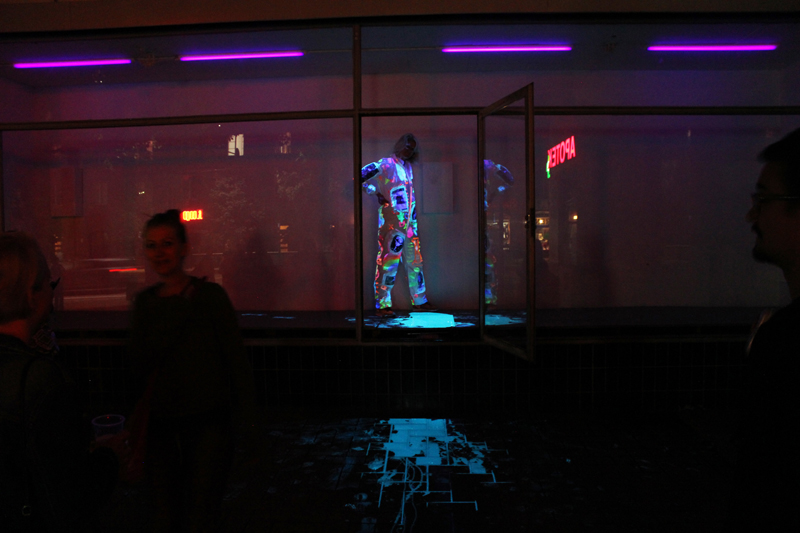
JOSEPHINE BAAN:
Nothing 2 C Here
walk along folks
jus walk along
nothing 2 c here me talk instead I mean
hear I mean her I mean hav a hard heart 2 <3
y'kno that driving force
the 1 u dont see n dont feel n dont understand rather
stand under n u jus follow n u dunno y but
we all kno how important it is 2 like, like, share n follow
but u dont c it u c it aint there
its a lie a line a phone a phony
n what once was is no more
so jus walk along folks
walk along
nothing 2 c
hear
n when I talk the talk u gotta walk the walk
Text by Josephine Baan

[FIN] Josephine Baanin näyttely Alkovissa koostui pimeän aikaan esiin tulevasta valoinstallaatiosta sekä Kallion alueelle laaditusta opastetusta kävelystä Esitys ja yökavely tapahtuivat 06.08.2016 kello 22:00.
Josephine Baanin työskentely keskittyy taiteen mahdollisuuksien nykymaailmassa tarkasteluun ja työstämiseen erilaisten käytäntöjen ja ajattelumallien kautta. Hän käyttää välineinään maalausta, kirjoittamista, videota, performanssia ja julkista tilaa.
Josephine Baan (s. 1987, Iso-Britannia, asuu ja työskentelee Rotterdamissa) on opiskellut media- ja kulttuuriteoriaa Amsterdamin yliopistossa, kuvataidetta Willem de Kooning Akatemiassa Rotterdamissa sekä suorittanut taiteen maisterin tutkinnon Goldsmiths:ssä Lontoossa. Hän on työskennellyt HIAPin residenssiohjelmassa toukokuusta heinäkuuhun. Kuluvana vuonna (2016) hänelle on myös myönnetty Mondrian rahaston Young Talent Working Grant apuraha. Viimeisimpinä hankkeina ja näyttelyinä voidaan mainita: t's a Dirty Job, Arc Residency Romainmôtier and Foound, Geneva; Miley Farage Presents... Matt's Gallery, Lontoo; Promenád, M?vel?dési Szint, Budapest; At the same place by coincidence... Studio Borgerstraat, Rotterdam; The Gallery Project, Long Museum, Shanghai; De Kamer, Galerie RAM, Rotterdam.
[ENG] The exhibition of Josephine Baan consisted of a light installation that appeared during the dark hours and of a guided walk composed specificly for the Kallio area. Performance and nightwalk took place at 10pm on 06.08.2016.
Josephine Baan's practice concerns itself with working and thinking through various disciplines and paradigms of what art is for in the world as we know it. She works in painting, writing, video, performance and the public space.
Josephine Baan (b. 1987, UK, lives and works in Rotterdam) holds a BA in Media and Culture Theory from the University of Amsterdam, received her BFA from the Willem de Kooning Academy in Rotterdam, and her MFA from Goldsmiths, London. She has been a resident at the Helsinki International Artist Program from May to July, and is a recipient of the Young Talent Working Grant from the Mondrian Fund in 2016. Recent projects and exhibitions include: It's a Dirty Job, Arc Residency Romainmôtier and Foound, Geneva; Miley Farage Presents... Matt's Gallery, London; Promenád, M?vel?dési Szint, Budapest; At the same place by coincidence... Studio Borgerstraat, Rotterdam; The Gallery Project, Long Museum, Shanghai; De Kamer, Galerie RAM, Rotterdam.
TOP / YLÖS
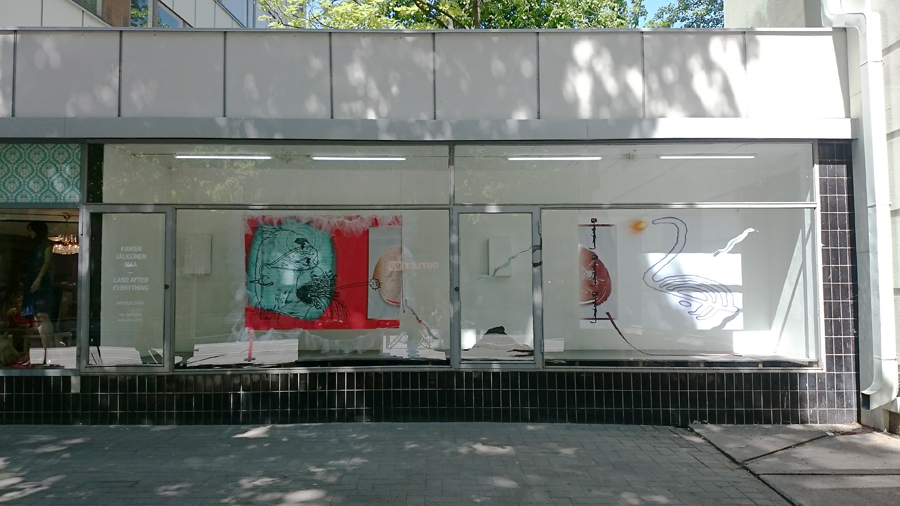
ANNI PUOLAKKA
Kaiken jälkeinen maa / Land After Everything
[FIN] Anni Puolakan näyttely 'Kaiken jälkeinen maa' koostui kahdesta kankaalle tulostetusta kuvasta, ikkunaan kiinnitetyistä silikonikäärmeistä, jotka ovat "syöneet" sisäänsä erilaisia materiaaleja (kuten tiedonsiirtojohtoja ja lääkkeitä), sekä kasasta multaa.
" ‘Kaiken jälkeinen maa’ on aika dramaattisesti sanottu. Mutta tykkään draamasta ja halusin kuvitella että voisin pysäyttää ajan.
www.urbandictionary.com määrittelee sanan ‘post-everything’ kuvauksena ympäröivästä maailmasta, joka näyttää siltä miltä se nyt vain näyttää.
Olen ajatellut Täällä Pohjantähden alla -trilogian avauslausetta “Alussa oli suo, kuokka ja Jussi.” Kansallisvaltio on muuttunut maatalousyhteiskunnasta modernimmaksi. Se on sijaitsee samalla maaperällä, mutt nyt on uusia kysymyksiä, kuten ydinjäte.
Kaiken jälkeen katson maata ja se on sotkuinen. Symboleista, materiaaleista, peloista, unelmista, kysymyksistä ja päätöksistä syntynyt sotku. Poimin joitakin asioita ylös, luottaen vaistooni ja uhmaten merkityksettömien valintojen pelkoa. Sulatan sen, minkä olen mieltymyksiltäni tai vahingossa niellyt samoillessani maan pinnalla ja netissä. Mutta valehtelisin, jos sanoisin että en toivo sulatuksen johtavan metaboliaan: jätteen ohella haluan tuottaa energiaa.
Et pitänyt sitä aikoinaan romanttisena kun etsin netistä rakkautta ja nyt, samalla tavalla, pidät näitä kuvia jotenkin liian digitaalisina, jotta ne tuntuisivat vartavastisilta, erityisen kokemuksen tuottamilta. Mutta eivät käärmeetkään välitä. Ne luikertelevat eteenpäin tapaamaan toisia käärmeitä, syövät asioita jotka tulevat eteen, käsittelevät ne ja jättävät taakseen jälkiä.
Löysin kuvan Karjalasta löytyneestä kalliopiirroksesta, joka esittää joutsenta ja munaa. Sen ovat oletettavasti tehneet tuhansia vuosia sitten ihmiset, jotka ovat maan, DNA:n ja kielen kautta suhteellisen sukulaisia minulle. Näiden linkkien kautta saatan ladata heimokuvastoa koneelleni olematta kulttuurinen anastaja. Ne saavat minut myös haluamaan luikerella pois, niistä vapaaksi, netin sulattamoihin.
Nielaisin joutsenen ja munan ja käytin Photoshoppia sulatukseen, instagrammasin (t)ulosteen. Tekemäni kuvan kautta lähetän värähtelyjä kohti esiäitejäni ja niitä olentoja, jotka saattavat katsella näitä pikseleitä tulevaisuudessa. Kohti ketä tahansa." Teksti: Anni Puolakka
Anni Puolakka työskentelee monialaisesti ja usein kollektiivisesti eri taiteilijoiden kanssa liikkuvan kuvan, äänen, performanssin, installaatioiden, tekstin ja graafisen suunnittelun parissa. Puolakan teokset purkavat ihmisyyteen liittyviä niin kehollisia kuin psyykkisiäkin potentiaalisuuksia ja rajoja suhteessa ympäröivään todellisuuteen, objekteihin ja olioihin. Puolakka on valmistunut graafiseksi suunnittelijaksi Aalto-yliopistosta ja suoritti näyttelyn aikaan kuvataiteen maisterin tutkintoaan Piet Zwart Intituutissa Rotterdamissa. Puolakan esityksiä, teoksia ja yhteistyöhankkeita on ollut esillä Euroopassa, Pohjois-Amerikassa ja Australiassa, muun muassa TENTissä (Rotterdam), Performance Spacessa (Sydney), The Contemporary Art Centre CAC:ssa (Vilna) sekä Helsingissä SICissä, Sorbuksessa ja Baltic Circle -festivaalilla.
Exhibition 'Land After Everything' by Anni Puolakka was composed of two images printed on canvas, silicone snakes attached to the window that have "eaten" various materials (like data transfer cables and medicine capsules) and of heap of soil.
"It’s rather dramatic to say ’land after everything’. But I’m into drama and I wanted to imagine I could stop time.
www.urbandictionary.com defines the word ‘post-everything’ as a description of the world around you that just looks like it does.
I’ve been thinking about the iconic opening line from a Finnish novel*: "In the beginning there were the marsh, the hoe - and Jussi (the male protagonist of the book).” The book tells the story of an archetypal yet heroic rural Finnish family from 1880 till the Second World War. It deals with the agricultural, political foundations of the nation state which is now a modern entity, still on the same soil but now with some new questions like nuclear waste.
After everything I look at the land and it’s messy. A mess of symbols, stories, materials, fears, dreams, questions and decisions. I lift some things out of the mess, trusting my instinct and defying the fear of meaningless choice. I digest what has entered me by a mix of preference and accident while I’ve roamed the surface of earth and online. But I’d be lying if I’d say I didn’t have hopes for digestion leading to metabolism: for production of energy and not just waste.
Once upon a time you didn’t find it romantic when I looked for love online, and now, similarly, you find the images somehow too digital for them to feel particular to a certain experience. But the snakes don’t care either, they slither on to meet other snakes, to eat up things and then digest them, leaving traces behind.
I found an image of a rock carving portraying a swan and an egg located in Karelia and presumably made thousands of years ago by people relatively related to me through soil, DNA and language. These links allow me to download tribal imagery without being a cultural appropriator. They also make me want to slither forward, free of them, to the smelters of the world wide web.
I swallowed the swan and the egg and used Photoshop for digestion, instagrammed the excretions. Through the image I made, I am sending vibrations towards my ancestors as well as those beings who might look at these pixels in the future. Towards anyone." Text by Anni Puolakka.
*) Väinö Linna: Under the North Star trilogy, published between 1959–1962.
Anni Puolakka works in a multidisciplinary and often collective way, using moving image, performance, installation and text. Puolakka’s works disseminate both the bodily and physical potentialities and boundaries that we as humans experience in relation to surrounding reality, objects and beings. Puolakka was doing her MFA at the Piet Zwart Institute in Rotterdam during the exhibition and had previously studied graphic design in Aalto University. Puolakka’s work has been presented in Europe, North-America and Australia – at TENT (Rotterdam), Performance Space (Sydney) and The Contemporary Art Centre CAC (Vilnius) as well as SIC, Sorbus and Baltic Circle festival in Helsinki.
TOP / YLÖS

HARRO KOSKINEN:
Suomi Kuivuu
LAURA LILJA:
Blackout (Siniristilippu)
[FIN] 28. helmikuuta vietetään vuosittain Kalevalan päivää ja liputetaan suomalaisen kulttuurin puolesta. Elias Lönnrot allekirjoitti Vanhan Kalevalan esipuheen 28.2.1935, ja vuonna 1978 päivä kirjattiin almanakkaan viralliseksi liputuspäiväksi, jolloin lisäys "suomalaisen kulttuurin päivä" niin ikään liitettiin päivän juhlakuvaukseen.
"Näyttely tarkastelee valtiollisten symbolien roolia nykykulttuurissa. Ydinkysymykset siitä, minkälaisia arvoja, ideologioita ja politiikkaa mitkäkin symbolit edustavat ovat akuutisti läsnä aina kun rajoittavia vaatimuksia niiden tulkinnalle ja käytölle esitetään. Valtion toiminnallisuuden kiinnittyminen talouskasvun resurssointiin, vetovoimatekijöiden määrittämiseen ja bruttokansantuotteen valjastaminen onnellisuuden mittariksi muuttaa kansalaisten suhdetta valtioon. Ajatus kansallisuudesta ja kansallisvaltiosta saa tunnerekisterissä vahvasti resonoivia, identiteettiin liittyviä piirteitä ja sen symbolit alkavat koskettelemaan ihmisten käsityksiä hyvästä/pahasta, sopivasta/epäsopivasta tai ylevästä/rappiollisesta. Ajatus valtion häviämisestä on muodostunut samanaikaisesti sekä kollektiiviseksi peloksi että fantasiaksi.
Harro Koskisen teos Suomi kuivuu on osa Koskisen teossarjaa Suomalainen elämänmuoto vuosilta 1970-72. Teossarja lainasi otsikkonsa kokoomuksen presidentinvaali ehdokkaan sloganista vuodelta 1970. Sarja esitteli Suomen lippuja erilaisissa olomuodoissa; palavina, sulavina, pingottuneina, lentävinä, sekä vuorovaikutuksessa eri yhtiöiden muunneltujen logojen tai arkisten esine-yhdistelmien kanssa. Harro Koskisen teokset joutuivat 1970-luvulla useampaan otteeseen sensuurin ja rikosoikeudellisten selvittelyjen kohteeksi. Nuorten näyttelyssä vuonna 1969 esillä olleet teokset Sikavaakuna ja Sikamessias toivat Koskiselle sakkorangaistuksen jumalanpilkasta ja Suomen vaakunan häpäisemisestä. Myös Suomalainen elämänmuoto sarjan teoksia syytettiin Suomen lipun häpäisemisestä, mutta tämä kanne lopulta hylättiin. Suomi kuivuu teos esittää Suomen lipun kuivumassa pyykkinarulla. Teos on valmistettu maalatusta kovalevystä, puusta ja köydestä.
Laura Liljan teos Blackout (Siniristilippu) esitettiin Helsingissä vastikään Liljan yksityisnäyttelyssä Galleria Huudossa osana Blackout nimistä teoskokonaisuutta. Näyttelyssä mustaksi muokattu ja varjona seinälle lankeava siniristilippu (kuten myös muun muassa sateenkaarilippu ja EU:n lippu) ikään kuin ylikirjoitettiin tai riisuttiin sen perinteisistä merkityksistä mustan värin kautta. Musta lippu on anarkistinen symboli, ja yhdistettynä Suomen valtion siniristilippuun se tuo väistämättä esiin anarkistisen asenteen valtion harjoittamaa patriarkaalista hegemoniaa ja valtaan alistamista kohtaan. Blackout (Siniristilippu) teos on valmistettu mustasta spandex-kankaasta ja lateksista.
Nämä kaksi, laajemmista teoskokonaisuuksista irroitettua, työtä esitetään rinnakkain Alkovissa. Teosten valmistumisajankohdan välinen aikaero osoittaa pohtimaan suomalaisessa yhteiskunnassa sekä keskusteluilmapiirissä vuosikymmenten aikana tapahtuneita muutoksia. Keskustelua valtiollisten symbolien käytöstä, itsenäisyyden tunteesta ja kansallisesta identiteetistä käydään nyt aktiivisesti. Kansallisuuteen liittyvä omistajuuden ja vastuun käsite on muuttunut kuvitteelliseksi - ajatus valtiosta yhteisen keskustelun ja demokraattisen päätöksenteon paikkana antaa tilaa käsitykselle valtiosta, jossa on samaan aikaan sekä vääjäämättömyyden tuntua että myyttisyyttä. Käsiteparit kuten "kansallisuus ja etnisyys" tai "kansallisuus ja uskonto" ovat palanneet jollain tavalla olennaisina tai jopa toisistaan riippuvaisina määritteinä keskusteluun valtion olemuksesta poissulkevana ja etuja valvovana rakenteena.
Harro Koskisen ja Laura Liljan teoksia ei voida purkaa käsitteillä kuten historiallinen tai ajankohtainen. Ne käsittelevät paitsi ihmisten suhdetta kansallisiin symboleihin ja niiden taustalla oleviin rakenteisiin myös näiden rakenteiden olemusta itsessään. Yhteiskuntakritiikki ja taide eivät kiinnity pelkästään ajallisiin tilanteisiin vaan myös ajatuskokonaisuuksiin ja ideologioihin. Kansalaisten suhde valtioon perustuu eräänlaiseen korrelaatioon. Tilanteessa, jossa kansalaisten riippuvuus valtiosta on pakotettu tai olematon - kun valtion ylläpitämä kontrolli- ja vaikutuskoneisto ylittää sen tuottamat yhteisöä ylläpitävät hyödyt - vaihtoehtoiset yhteisöllisyyden muodot (jotka voivat olla anarkistisia) valtaavat alaa. Näin ollen kysymys valtion tarpeellisuudesta kaikessa problemaattisuudessaan nousee jälleen esiin." Teksti: Arttu Merimaa
[ENG] Kalevala day - which is celebrated annually on 28th of February - is about Finnish culture. Elias Lönnrot dated and signed his preface to finnish epic the Old Kalevala on 28.2.1935, and in 1978 the day was marked into the calendar as an official flag day as the "day of Finnish culture" that was also included in the day's celebratory status.
"This exhibition explores the role of the state symbols in contemporary culture. The core questions of whose opinions, ideologies or politics these symbols represent is always acutely relevant when oppressive demands about their use and interpretation are being made. As the agency of the state is increasingly morphing into resourcing economic growth, defining the parameters for gaining attraction for investment and harnessing the GNP for a measurement of happiness - the citizens' relationship to the state alters. The idea of citizenship and nation state starts to resonate in a strongly emotive, identity-based register and its symbols are attached into people's conceptions of moral - appropriate/inappropriate or esteemed/decadent - behaviour. The annihilation of the state has become simultaneously a fear and a fantasy
The work Suomi kuivuu (in english Finland dries out) by Harro Koskinen is a part of a series of works called "Suomalainen elämänmuoto" (the Finnish way of living) from 1970-72. The series got its title from the National Coalition Party presidential campaign slogan from 1970. The series displayed Finnish flags in different conditions - burning, melting, stretched and flying as well as being in interaction with altered logos of various companies and together with everyday objects. For more than one occasion in the 1970's Harro Koskinen's works were censored and involved in criminal inquiry. Koskinen was fined for blasphemy and disgracing the Finnish emblem for his works "Sikamessias" (pig messiah) and "Sikavaakuna" (pig emblem) displayed in the young artists' exhibition in 1969. The works in "Suomalainen elämänmuoto" series were also accused of disgracing the Finnish flag, but these claims were later dropped. Suomi kuivuu work presents the Finnish flag drying up on a clothesline. It is made of painted hardboard, wood and rope.
Blackout (Siniristilippu) ['Siniristilippu' meaning "blue cross flag" aka name for the Finnish national flag] by Laura Lilja was recently presented in Lilja's solo show in the Huuto gallery in Helsinki as a part of a series of works called Blackout. In the exhibition, the Finnish flag (as well as the rainbow flag and the flag of EU) were rendered black or casted as shadows on the gallery walls - overwritten and stripped from their original meanings by the use of black color. Black flag is an anarchist symbol and in the combination with the Finnish flag the piece brings forward an anarchist attitude towards the patriarchal hegemony and subjection to power practiced by the state. Blackout (Siniristilippu) is made of black spandex and latex.
These two works - both removed from the context of the larger series - are presented side by side in Alkovi. The time that has passed between the making of these two works encourages to consider the changes that have happened in the Finnish society and the discourse that has taken place during the past decades. Charges against disgracing the flag aren't easily raised anymore. On the other hand people take actively part in the discussion about national symbols and identity and the sense of independency. The ownership and responsibility embedded citizenship has transferred into symbolical level. A thought of the state as a place of discourse and democratic decision making has given space for a conception of the state that is simultaneously both deterministic and mythical. Pairing of the terms such as "nationality and ethnicity" or "nationality and religion" have returned as attributes that are somehow relevant or even interrelated in the discussion about the state as an excluding organ oriented towards catering and monitoring specific interests.
These works by Harro Koskinen and Laura Lilja cannot simply be defined with concepts like historical or current. They don't only deal with people's relations to national structures but also point to the structures themselves. Societal critique and art do not only attach themselves into temporal situations but rather into patterns of thought and ideologies. The relationship between citizen and the state is based on a sort of a correlation. In a situation where people's dependency on the state is forced or non-existent - when the controlling and imposing machinery overseeds the benefits it brings for the community - alternative ways of communality gain ground (of which can be anarchist). Thus the problematic question about the necessity of the state arises again." Text by Arttu Merimaa
TOP / YLÖS

ANDRÉ ALVES:
Forming The Line
[FIN] André Alves toteutti näyttelyssään "Forming the Line" Alkoviin suurikokoisen piirros-installaation, jonka yhteydessä 5. - 17. joulukuuta galleria-tilassa tapahtui erinäisiä performanssi-akteja. Alves tarkasteli näyttelyssä jokapäiväisen arkitoiminnan eleiden ja taiteellisten praktiikoiden yhtymäkohtia.
'Forming the Line' tutkii sisäänkirjoittautumistamme siihen mitä pidetään toimivana sekä vakaana. Ensisijaisesti - ja kenties ilmeisimmin - se käsittelee viivan/jonon muodostumisen mekanismia joka sallii piirroksen ilmetä. Se tarkastelee myös kysymystä "olla linjassa jonkun kanssa" - odotusta normalisoida teot ja kokemukset, kyse on sopeutumisesta ja soveltamisesta sekä näiden kokemusten havainnoimisesta ja tunnistamisesta.
Tämä näyttely tarkkailee piirtämisen praktiikkaa tilallisena perfomanssina - sekä tässä tapauksessa katovana sosiaalisena ja kehollisena performanssina. Lähestymistavan tarkoitus on korostaa läsnäolon, toistuvan työn ja ajallisuuden olemuksia sekä purkaa piirtämistä objektin tekemisenä etsien yhteyttä suurien eleiden ja niiden lyhytkestoisten seurausten välillä.
André Alves (1981) asuu Leverissä Portugalissa sekä Helsingissä. Hän on tohtoriopiskelijana Kuvataideakatemiassa. Hän on tehnyt Fulbright-stipendiaattina kuvataiteen maisterin tutkinnon Cincinnatin yliopistosta (2011) ja taiteen maisterin taidekasvatuksesta (2009) sekä kuvataiteen kandidaatin (2005) tutkinnot Porton yliopistosta.
[ENG] André Alves in his exhibition "Forming the Line" created a large-scale drawing in Alkovi, in addition to which there were certain performance acts during 5th - 17th december. Alves explored parallels between representations of everyday gestures and artistic practices.
'Forming the Line' explores our inscription within the lines of operating and being recognized as functional and stable. It talks about the mechanism (making the line) that allows drawing to manifest. It also deals with the relation of "being in line with" - the expectation of normalizing actions and experiences, to conform and adjust - and the perception and recognition of such experiences.
The exhibition explores drawing practice as a spatial performance - and in this case - a bodily social performance of the ephemeral. The intentions of this approach is to highlight the qualities of presence, repetitive labor, the temporality of monumentality and the undoing of drawing as object-making practice, but also looking for a correlation with the enourmous gestures one makes and its short lasting effects.
His current research observes transitional spaces/objects/ situations and the renegotiation of meaning of the concepts of instability by looking at the potentiality of the concept of impasse through an approach crossing visual and textual forms.
André Alves lives between Lever (PT) and Helsinki (FIN). He is a doctoral student of Fine Arts at the Finnish Academy of Fine Arts. He holds an MFA in Drawing from the University of Cincinnati (2011) under a Fulbright fellowship, an MA in Art Education (2009) and a BFA (2005) from the University of Porto.
Some of his exhibitions include: Streaming Egos (PT) [2015], Lugares de Viagem (PT) [2015]; From Turbulence to Rule (PT) [2014]; Aesthetics Jam - 9th Taipei Biennial (CHI) [2014]; Contornar - FAC Peregrina (ES)[2013]; Estado d'Época - Galeria Sopro (PT) [2012]; Aproximações à profundidade - Sala do Veado, (PT) [2012]; Ex-cavação I - Sputenik the window, (PT) [2012]; Collecting Collections and Concepts - Fábrica Asa, (PT) [2012]; Massa Falhada - Galeria Dama Aflita, (PT) [2012]; Mute/ Motives - Semantics Gallery (USA) [2011]; MUSAO OPORTO -MASC Foundation, (A)[2011]; Surrounded - Reflexus Arte Contemporânea, (PT) [2009]; Thing ... - In.Transit, (PT) [2007]; Aunt Nell Gis - Kunstvlaai 06, (NL) [2006].
TOP / YLÖS
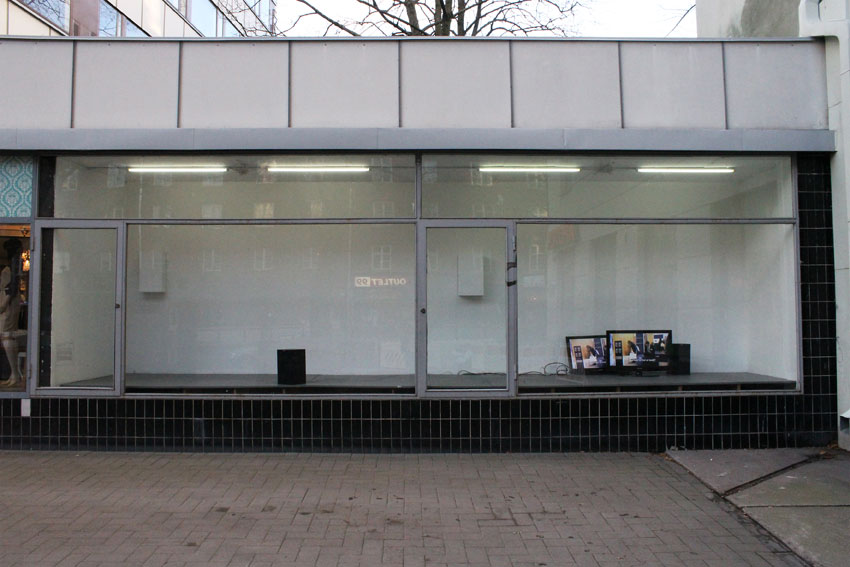
PILVI TAKALA & AMELIE BEFELDT:
Give a little bit
[FIN] Taiteilijoiden Takala ja Befeldt yhteistyönä tekemä videoteos toi esiin sosiaalisen kanssakäymisen puhumattomia säännönmukaisuuksia paljastaen vieraanvaraisuuden rajoja sekä antamiseen ja saamiseen liittyvää "kaupankäyntiä".
Takala ja Befeldt kirjoittavat teoksestaan:
"Give a little bit- videon karaokemuotoisuus on hienovarainen tapa kutsua katsoja osallistumaan, laulamaan mukana vaikka vain lausuen laulun lyriikat päässään. Videon tapahtumapaikka on uramessut, jossa yritysten edustajat seisovat koko pävän osastoissaan jakaen informaatiota uravaihtoehdoista ihmisille jotka ovat maksaneet sisäänpääsymaksun. He tarjoavat kyniä, suklaata, ja esitteitä mukaan otettavaksi. Nämä "kylkiäiset" eivät ole lahjoja puhtaimmassa merkityksessään - vierailijan odotetaan antavan aikansa ja huomionsa vaihtokaupassa sekä osoittavan kiinnostuksensa. Näissä messuissa on myös kyse vaihtokaupasta laajemmassa merkityksessä: ne esittävät kuinka työntekijän on annettava ensin jotain saadakseen vastinetta myöhemmin ammatillisella urallaan. Tuotteiden pelkkä hamstraaminen kunnioittamatta siten kirjoittamattomia sääntöjä rikkoo messuilla vallalla olevaa kulttuurillista koodia - vierailija joka toimii koodia vastaan alkaa näyttämään tunkeutujalta. Messutyöntekijät jotka saattavat itse toimia kuten tämä vierailija muussa tilanteessa tulevat ärtyneiksi ja suojelevaisiksi jaettavista tuotteistaan. Pelko siitä että joku mahdollisesti käyttää järjestelmää hyväkseen ja vaatimus sääntöjen noudattamisesta on usein suurempi kuin terve järki. Me helposti epäonnistumme arvioimaan todellisia hyötyjä ja haittoja jonkun ottaessa tarjotun omenan vain halustaan syödä sen mielummin tarjoten sitä henkilölle joka osoittaa sitoutumisensa sääntöjärjestelmiimme."
Antamisen ja ottamisen teemat resonoivat suhteessa Alkovin sijaintiin. Alkovi jakaa saman pienen aukion Hurstin ruokajakelun kanssa, joka jakaa elintarvikkeita kahdesti viikossa. Samalla aukiolla sijaitsee myös myös pieni pikaruokagrilli, apteekki, kristillisen järjestön kirpputori, otto-automaatti ja kulman takana Alko. Aukiolle on syntynyt oma sosiaalinen piirinsä, joka sulautuu sitä ympäröivään kaupunkiin ja tapahtumiin. Kysymys sopivasta käyttäytymisestä mallintaa sitä minkälaisen tilan ja mahdollisuuden toimia annamme tai sallimme muille.
Pilvi Takala työskentelee sosiaalisten tilanteiden, sääntöjen ja rakenteiden parissa. Takalan videoteokset käsittelevät sosiaaliseen käyttäytymiseen liittyviä toimintamalleja ja esittävät kysymyksiä toimintamme vapaudesta ja itsemääräämisoikeudestamme. Takala on yksi nykyhetken kansainvälisesti laajimmin esillä olevista suomalaistaiteilijoista. Vuonna 2013 hänelle myönnettiin Suomen Valtion taidepalkinto sekä Frieze Londonin Emdish Award. Takala valmistui kuvataiteen maisteriksi Kuvataideakatemiasta vuonna 2006, jonka jälkeen hän on on ollut mukana muun muassa Amsterdamin Rijksakademie van beeldende kunsten -, Lontoon Gasworks - sekä New Yorkin ISCP -residenssiohjelmissa.
Amelie Befeldt on vastikään valmistunut taiteen kandidaatiksi (Bachelor of Arts Photography & Media - University of Applied Science in Bielefeld). Hänen työskentelyssään ulkopuolisen ympäristön tarkkaileminen ilmenee monin eri tavoin. Julkisen tilan, yksityisen elämän ja vuorovaikutuksen mahdollisuuksien kysymykset esiintyvät hänen videoissaan sekä installaatioteoksissaan.
[ENG] The video piece presented in Alkovi was a collaboration between artists Takala and Befeldt. It presented the unspoken rules embedded in social conduct as well as reveals the limits of hospitality and shows the "trading" that goes on with giving and receiving.
Takala & Befeldt write about their piece:
"Give a little bit takes the format of a karaoke song video as a subtle means to invite the viewer to participate, to play along even if it's just by reading the lyrics of the song in their head. The video takes place at a career fair where corporate representatives stand at their booths all day, giving out information about career opportunities to people who have paid an entrance fee. They offer giveaways such as chocolates, pens and printed materials. These 'giveaways' are not gifts in the purest sense - the visitor is expected to give their time and attention in exchange and to show interest. These fairs are also about exchange in a larger sense: they delineate what the worker must give in order to receive something later on in their professional career. Just grabbing the giveaways without respecting this unwritten rule violates the 'cultural code' holding sway in the fair environment and the visitor who does so starts to appear as a perpetrator. Fair workers - who might themselves behave as the visitor does in another context - feel irritated and protective of their giveaways when at the fair. The fear of someone possibly exploiting the system and a requirement that we follow the rules of is often greater than common sense. We easily fail to asses the real losses or benefits in someone just taking a giveaway apple because they want to eat it - and prefer to offer it to a person who presents their commitment to our rule system."
The themes of giving and receiving find resonance in Alkovi's location. Alkovi is situated on a little square that is shared also by a Hursti's food donation organization that distributes food supplies twice a week. Located on the same square are also a small fast-food kiosk, pharmacy, a second hand store run by a christian organization, ATM - and around the corner - a liqueur store. The square has formed its own social circle that nonetheless blends into the surrounding city and events. The question about the proper conduct depicts what kind of space and what kind of possibilities for action we enable and allow.
Pilvi Takala works with social situations, rules and constructions. Takala's video works deal with the norms of the expected conduct that guides our social behavior and present questions considering our freedom of action and self-determination. In 2013 Takala received the State Prize For Visual Arts in Finland as well as the Frieze London Emdish Award. Takala graduated as a Master of Fine Arts from the Finnish Academy of Fine Arts in 2006 and has since then participated in the residency programs of Rijksakademie van beeldende kunsten in Amsterdam, Gasworks in London and ISCP in New York among others.
Amelie Befeldt is a recent graduate as a Bachelor of Arts Photography & Media (University of Applied Science in Bielefeld). In her work observing the surrounding environment is depicted in multiple ways. The questions of public space, the private life, and the possibilities of interaction are dealt with in her video as well as installation works.
Näyttelyä tuki Goethe-insituutti. / The exhibition was supported by Goethe-institut.TOP / YLÖS
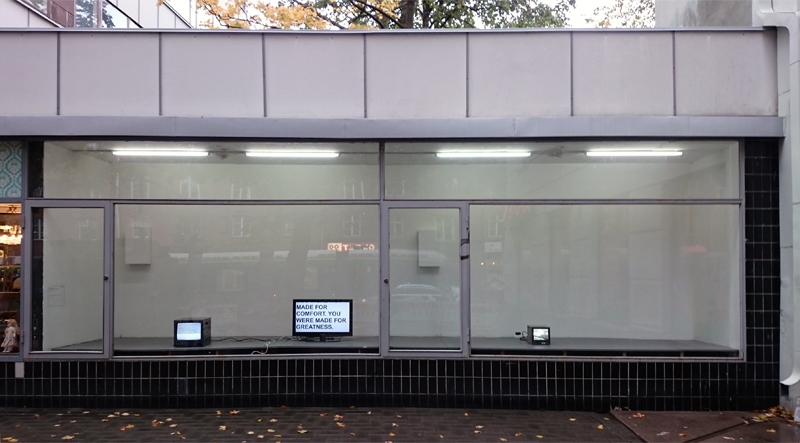
VAPPU JALONEN:
TÄMÄ ON SINULLE, TÄMÄ EI OLE SINULLE / THIS IS FOR YOU, THIS IS NOT FOR YOU
[FIN] Vappu Jalosen tekstilähtöinen installaatio This Is For You, This Is Not For You (Tämä on sinulle, tämä ei ole sinulle) tarkasteli kehojen, esineiden, tilojen ja sanojen sopimista ja sovittamista sekä siihen sisältyvää valtaa ja etuoikeuksia
Teoksen osat on esitetty kolmella erilaisella näytöllä, joissa tekstit scrollautuvat tökkivästi - välillä nopeammin ja välillä hitaammin. Yksi näytöistä kertoo fragmentaarisia tarinoita kehoista ja vaatteista, kehoista ja kuvakennoista, kävelemisestä veitsi taskussa, puheen pitämisestä Otaniemessä sekä sanoista ja niihin vastaamisesta. Toinen näyttö esittää affirmaatioita, joissa kaikki esitetään mahdollisena kaikille ja jotka aggressiivisessa oikeistolaisessa uusliberalismissaan vaativat koko ajan jotakin enemmän. Kolmas näyttää kuvan EU:n rajasta.
Rajojen määrittämiseen keskittyvässä kulttuurissamme rajat ovat oikeutuksien kiinnittäjiä. Jalosen teos esittää kontrollin tarpeen "sisäisen ja ulkoisen" ristivalotuksena. Mahtuminen rakenteisiin, mekkoihin, hyvinvoinnin parametreihin aiheuttaa alituista kitkaa, jonka tuntee niin kehonsa kuin "itseen ja muihin" kiinnittyvien asenteiden, termien ja liikkeiden tukosten ja virtojen kautta. Teksti: Miina Hujala
Vappu Jalonen on taiteilija ja kirjoittaja. Jalonen asuu ja työskentelee Berliinissä ja Helsingissä. Hän tekee väitöskirjaa Aalto-yliopiston Taiteiden ja suunnittelun korkeakoulun Taiteen laitokselle. Alkovin teos on osa Jalosen taiteellista tutkimusta.
[ENG]The text-based installation 'This Is For You, This Is Not For You' by Vappu Jalonen dealt with the fitting of bodies, things, spaces and words and the power relations and privileges embedded in this.
The different parts of the work were shown in three different screens in which the text scrolled down clumsily - sometimes faster, sometimes slower. One of the screens told fragmental stories of bodies and clothes, bodies and image sensors, walking with a knife in your pocket, giving a talk at Otaniemi, and words and replying to them. The second screen showed affirmations in which everything is portrayed possible for everyone and that in their aggressive right-wing neoliberalism continuously demand something more. The third screen showed an image of the EU border.
In our culture focused on defining borders, these borders are seen as the attachers of rights. Jalonen's piece portrays the need for control as a layered entanglement between "the inner and the outer". Fitting in structures, dresses or the parameters of well-being causes constant friction that one feels through one's body as well as through the attitudes, terms and the streams and blockages of movement that cling to "oneself and the others". Text: Miina Hujala
Vappu Jalonen is an artist and writer. She lives and works in Berlin and Helsinki. She is doing her doctorate in the Department of Art at Aalto University School of Arts, Design and Architecture. The work shown in Alkovi is a part of Jalonen's artistic research.
TOP / YLÖS
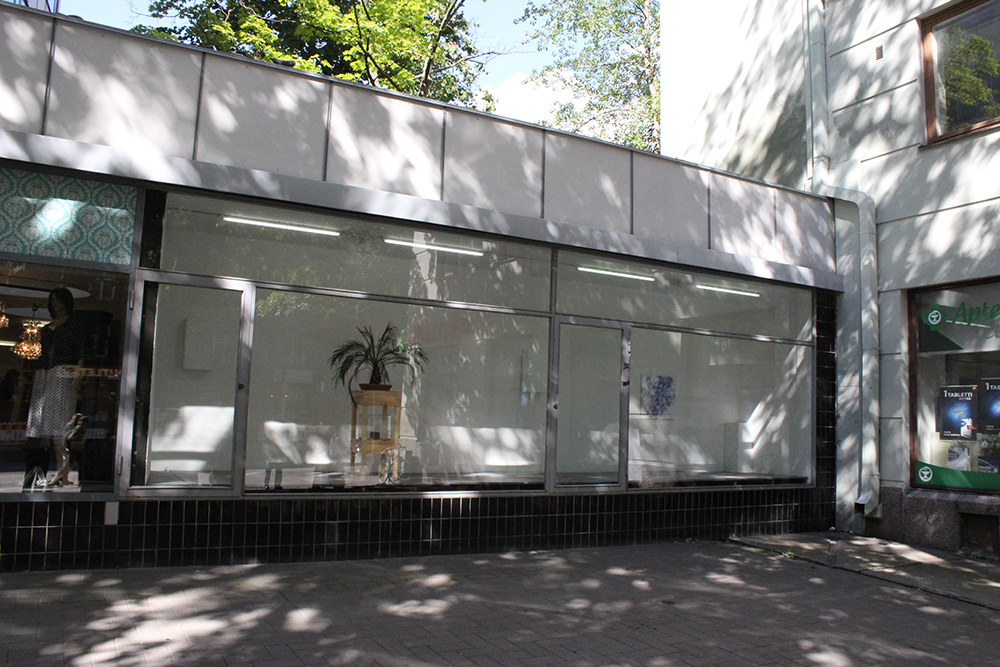
Essi Kausalainen:
TIMANTIT JA HELMET / Diamonds & Pearls
[FIN] Esillä oli Essi Kausalaisen performanssiprojektin 'Timantit ja Helmet' dokumentaatio, joka perustui miltei vuoden kestäneeseen projektiin, jota dokumentoivat esineet olivat lainassa Valtion taideteostoimikunnalta (jonka tilaamana - ja Muu ry:n tuottamana - hanke oli toteutettu).
Projekti perustui yhteistyölle Kausalaisen ja Helsingin kaupungin rakentamispalvelu Staran kanssa. Prosessista jäljelle jääneet dokumentaariset jäänteet olivat esillä tilassamme; neljä lumiauran kuljettamaa timanttia, jotka myöhemmin kätkettiin asfalttipalan sisälle Katu- ja Maalaboratorion henkilökunnan toimesta, aurojen reittien kuvannos kylttinä samoin kuin maahan upotettujen helmien kairausreikien kairausprofiilit (mekaaninen poikkileikkaus reikää ympäröivän maan koostumuksesta) ja huonekasvi puupajalla rakennetussa vitriinissä.
Kausalaisen ja Staran yhteistyöprosessi sisälsi arvokkuutta joka liittyy paitsi huolenpidon lahjaan myös yhteiseen tilaan liittyvään toiminnallisuuteen sekä aikaan. Teos on eräänlaista aarteen etsintää, jossa aarre on paitsi kätkeytynyt miljardien vuosien prosesseihin myös kauneuden hahmottamiseen hoitamisessa, ylläpidossa ja (ihmis)toiminnan muodostelmissa joista kaupunki rakentuu aina uudelleen.
[ENG] Presented was a documentation of objects of the performance project by Essi Kausalainen called 'Diamonds and Pearls'. Objects - that documented a project that lasted almost for duration of one year - were on loan from the Finnish State Art Commission who commissioned the piece that was produced by Artists' Association MUU.
Project is based on collaboration between Stara (construction service provider of the City of Helsinki) and Kausalainen. The documentary remnants of the project are presented in our space; four diamonds that have been traveling with a snow plow later hidden by the staff of Street and Soil laboratory inside an asphalt, the graphics of the routes of the plows made into a plaque, as well as a plaque of the drilling profiles (mechanical crosscut of the consistence of the soil that surrounds the hole) of the holes that pearls were dropped into and a houseplant in a vitrine that was built at Stara woodshop.
The collaboration process between Stara and Kausalainen entails dignity that is attached to the gift of maintenance as well as the activity and time connected to common space. The piece is a sort of a treasure hunt, in where the treasure is hidden in the processes of billions of years but also in the beauty of upkeeping, caring and the formations of (human)action, that the city is built upon again and again constantly.
TOP / YLÖS

[Kuva/ Image: Rune Peitersen: Safe Distance]
RUNE PEITERSEN:
Safe Distance & Safe Distance: High Ground
[FIN] Esillä oli editio Rune Peitersenin 'Safe Distance' ja 'Safe Distance: High Ground' valokuvasarjoista. Peitersen on Amsterdamissa asuva kuvataiteilija, jonka teokset käsittelevät monimuotoisesti katsomisen tematiikkaa: miten näemme ja miten suhteutamme omamme muiden kokemuksiin maailmasta.
Safe Distance (2014) koostuu Internetin live-stream sivustoilta otetuista kuvakaappauksista, joissa mielenosoituksiin osallistuvat henkilöt ympäri maailmaa jakavat verkkoon reaaliaikaisesti kuvaamaansa materiaalia. Peitersenin estetisoidut kuvat osoittavat verkosta tilannetta seuraavan katsojan etääntyneen ja voyeristisen position niihin tapahtumiin, jotka parhaillaan ravistelevat koko globaalia maailmaa. Safe Distance: High Ground (2015) puolestaan kierrättää niin ikään Internetiin ladattuja Yhdysvaltojen sotaoperaatioissa käytettyjen drone-lennokkien ja kopterien kuvaamia live-videoita. Peitersenin kuvakaapauksista on pyyhitty pois niiden mukana tuleva data, jäljelle on jätetty ainoastaan kuvallinen informaatio. Tällainen esteettinen ele kääntää fokuksen jälleen katsojaan.
Safe Distance -valokuvasarjat esittävät siis kaksi tavallaan vastakkaista toimijuutta: kaduilla ja aukioilla tapahtuvan itse organisoidun liikehdinnän sekä järjestelmällisen ilmasta käsin tapahtuvan hallinnoidun vallankäytön. Esittämällä valikoiman näistä kahdesta kuvasarjasta Alkovissa - joka on ikkunavitriininä osa julkista tilaa - haluamme pohtia passiivisen sivustakatsojan roolia tietynlaisena arvottajana. Meidän tulee muistaa, että jatkuvan kuvavirran alaisuudessa katsojan positio ei ole neutraali.
Rune Peitersen (s. 1971 Tanskassa) suoritti BA tutkinnon Haagin Royal Academy:ssa vuonna 1999 ja maisterin tutkinnon Frank Mohr instituutissa Groningenissa 2001. Gallery Ellen de Bruijne Projects edustaa Peitersenia Amsterdamissa. Hänen teoksiaan on esitetty lukuisissa yksityis- ja ryhmänäyttelyissä Hollannissa ja muualla Euroopassa, viimeisimpänä On The Move -näyttelyssä Stedelijk Museumissa Amsterdamissa. Peitersen on ollut mukana perustamassa useita taiteilijaorganisaatioita kuten Platform de Beeldende Kunstia (PBK). Hän myös opettaa Amsterdamissa St. Joost taideakatemiassa.
[ENG] Prsented was an edition of Rune Peitersen's 'Safe Distance' and 'Safe Distance: High Ground' photography series. Peitersen is an artist based in Amsterdam whose work deals with the thematics of looking in various ways: how we perceive and how we relate our own experience of the world to that of others.
Safe Distance (2014) consists of screen captures from Internet live-stream platforms where people participating in demonstrations share the material they film in real time. The aesthetisized images of Peitersen's point out the alienated and voyeuristic position of the viewer to those events that currently shake the entire global situation. Safe Distance: High Ground (2015) on the other hand recycles the live-videos captured by the drones and copters used in US military operations that have been uploaded to the Internet. In Peitersen's screen captures, the data normally attached to the image is wiped out leaving intact only the pictorial information. Through this kind of erasing gesture the focus is again turned towards the viewer.
The Safe Distance photography series' portray two apparently opposite agencies: the self-organized movement in the streets and the governed, systematic use of power. By presenting a selection of these two series' in Alkovi, which as a window vitrine is a part of the public space, we want to reconsider the alleged passivity in the role of the spectator. Especially in the current image overflow, we need to remember that the viewer position is never disengaged.
Rune Peitersen (b. 1971 in Denmark) received his BA from the Royal Academy of The Hague in 1999 and MA from the Frank Mohr Institute in Groningen in 2001. He is represented by the Gallery Ellen de Bruijne in Amsterdam. Peitersen's works have been on display in various solo and group shows throughout Netherlands and Europe, most lately in a show On The Move in Stedelijk Museum, Amsterdam. Peitersen has been a founding member of various artist initiatives such as the Platform de Beeldende Kunst (PBK). He also teaches in the St. Joost Art Academy in Amsterdam.
TOP / YLÖS
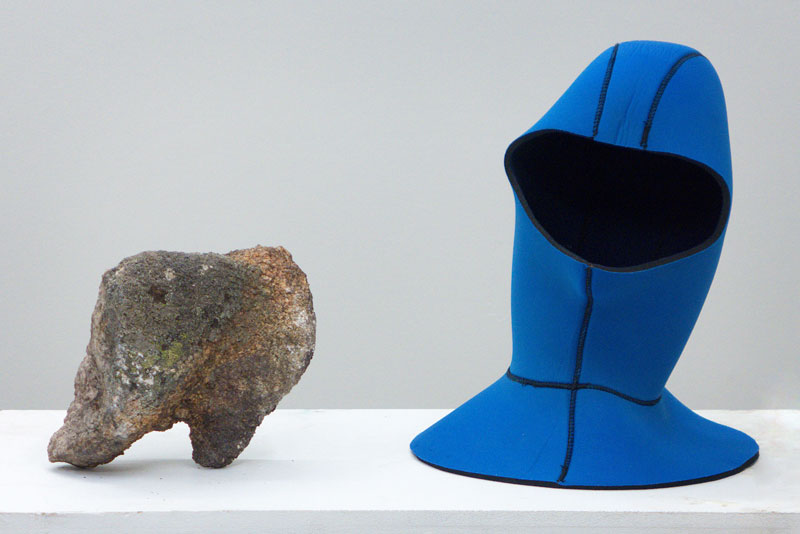
[Kuva/ Image: Nestori Syrjälä]
NESTORI SYRJÄLÄ:
"You need to have a brain because you need to be able to move"
[FIN]Näyttelyn nimi tulee Ray Brassierin esseestä (1), jossa hän pohtii ihmisen ja eläinten kognitiivisten kykyjen suhdetta tarpeeseen liikkua suunnitelmallisesti tilassa - siis tarpeeseen tehdä mentaalisia karttoja ja representaatioita.
Sosiaalisesti muovautuvana ja ulkoista ympäristöään muokkaamaan kykenevänä olentona ihminen pystyy ylittämään välittömät luonnonehdot ja kiertämään väliaikaisesti myös termodynamiikan vääjäämättömyydet. Tätä kykyä edustaa näyttelyn objekteista mm. minijääkaappi. Ei ehkä ole minkäänlaisia rajoja sille missä määrin kykenemme muuttamaan itseämme ja ympäristöämme. Joskus luonnolait tuntuvat kuitenkin iskevän takaisin ja kohtaamme olemassaoloa uhkaavia poliittisesti lamaannuttavia ja psykologisesti masentavia ongelmia. Tätä nurjaa puolta edustaa näyttelyssä mm. Mobil 1 Peak Life -moottoriöljykanisteri. Teknologisen kehityksen vähän nolojakin heijastumia edustavat näyttelyssä myös melatoniinitabletit ja hien tahrimat tyynyt.
Nestori Syrjälän (s. 1983) videon, installaation ja toiminnallisten objektien muodon saavat teokset nostavat esiin ihmisen hankalan suhteen ympäristöön, teknologiaan ja materiaaleihin. Meneillään olevan ympäristökriisin keskellä tapahtuva pyrkimys tunnistaa vuorovaikutus ympäristömme kanssa on keskeistä Syrjälän työskentelyssä. Syrjälä on valmistunut Kuvataideakatemiasta vuonna 2009 ja on esiintynyt laajasti yksityis- ja yhteisnäyttelyissä Suomessa ja ulkomailla, kuten Helsingin taidemuseon Kluuvin galleriassa 2011, Galleri Sinnessä 2012 ja viime vuonna Helsinki Photography Biennalessa Suomen Valokuvataiteen museossa sekä HIAPin Dissolving Frontiers-näyttelyssä Galleria Augustassa. Yhteistyö on olennainen osa Syrjälän praktiikkaa, hän on myös Mustarinda-seuran jäsen.
[ENG]The title comes from Ray Brassier's essay (1) where he ponders the cognitive capacities of human beings and animals in relation to the need to move systematically in space - the need to make mental maps and representations.
As a socially malleable being capable of transforming one?s environment, humans can surpass the immediate natural conditions and even temporarily bypass the laws of thermodynamics. In the exhibition, a refrigerator represents this ability. Maybe there is no limit to the extent in which we can transform ourselves and our environment. But sometimes nature seems to strike back and we are faced with politically paralyzing and psychologically depressing problems. Mobil 1 Peak Life - motor oil canister represent this downside. The somewhat embarrassing implications of technological progress are presented also through melatonin tablets and sweat stained pillows.
Nestori Syrjälä's (b. 1983) works - that take the form of video, installation and functional objects - deal with our difficult relationship to the environment, technology and materials. A central theme in Syrjälä's work is the attempt to recognize oneself in relation to our surroundings amidst the ongoing environmental crisis. Syrjälä graduated from the Finnish Academy of Fine Arts in 2009 and has taken part to a great number of exhibitions in Finland and abroad, such as in the Kluuvi gallery of Helsinki Art Museum in 2011, Galleri Sinne in 2012 and last year in the Helsinki Photography Biennale in The Finnish Museum of Photography and in HIAP's Dissolving Frontiers exhibition in Galleria Augusta. Collaboration is an essential part of Syrjälä's practice, he is also a member of Mustarinda association.
1) Brassier, Ray: 'Prometheanism and Real Abstraction' kirjasta / from the book Speculative Aesthetics (2014).TOP / YLÖS
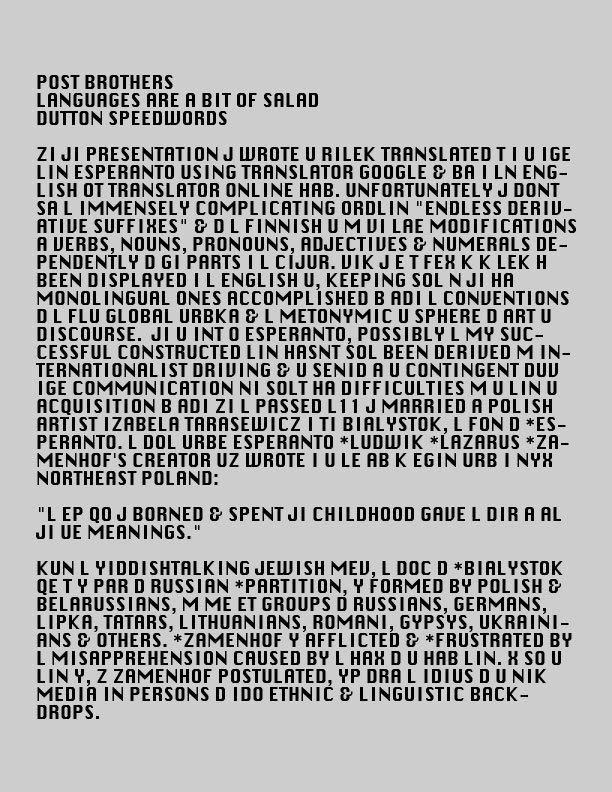
POST BROTHERS:
Languages Are A Bit Of Salad
[FIN]Languages Are A Bit Of Salad on englanniksi kirjoitettu - ja sittemmin esperantoksi ja siitä takaisin englanniksi Google Translate -palvelulla käännetty - teksti, josta Alkovissa esillä on edelleen käännetty versio käyttäen tällä kertaa kansainvälistä keinotekoista kielisysteemiä: Dutton Speedwordsiä. Reginald J. G. Duttonin vuonna 1922 keksimä kieli toimii sekä pikakirjoituksena että kansainvälisenä kielenä. Dutton Speedwords:ssä yleisimmin esiintyviä sanoja korvataan yhden, kahden tai kolmen kirjaimen yhdistelmillä ja pyritään näin nopeuttamaan kommunikaatiota.
Alunperin keväällä 2014 Suomenlinnassa Galleria Augustassa järjestettyä Festival of Positive Misunderstanding -tapahtumaa varten kirjoitettu essee ja puhe-esitys käsittelee universaalien rakennettujen kielten mahdollisuuksia ja ongelmia suhteessa kielen käytön monimuotoisuuteen, ymmärrykseen ja kommunikaation rajoihin. Tekstissä Post Brothers nostaa esiin useita keinotekoisia kieliä, jotka ovat rakentuneet eri tarkoitusperien johdosta; pyrkien joko laajempaan universaaliuteen, loogisuuteen, tehokkuuteen tai muodostaen outoudessaan ja esteettisyydessään kiehtovia kokonaisuuksia.
Languages Are A Bit Of A Salad viittaa myös kielen mekaaniseen kääntämiseen liittyvään eroosioon - kielen yksinkertaistumiseen ja konventionalisoitumiseen sekä suoranaiseen sisällölliseen vääristymiseen erityisesti internetin käännöskoneita käytettäessä. Esiin nousee kysymys: kielestä puhuttaessa, onko yksinkertaisuus mikään hyve?
Post Brothersin tekstiteos Languages Are A Bit Of Salad esittelee erilaisia rakennettuja universaaleja kieliä. Tekstin rakenteeseen kuuluu olennaisesti sen uudelleenmuotoutuminen Google Translate-kääntäjän kautta. Teos on käännetty englannista esperantoksi ja tämän jälkeen taas englanniksi. Käänsimme sen myös tätä sivustoa varten suomeksi käyttäen niin sanottua älykästä käännösalustaa: ihmistä. Post Brothers on Matthew Postin fasilitoima kriittinen hanke, joka keskittyy julkaisuihin, näyttelykuratointeihin ja luentoihin.
[ENG]The text - written in English and translated to Esperanto and then back to English using Google Translate - is here translated again into an international auxiliary language: Dutton Speedwords. A language invented by Reginald J.G. Dutton in 1922 functions both as a shorthand writing system as well as an international language. In Dutton Speedwords frequently used words are replaced with one-, two- or three-letter combinations in order to speed up communication.
The essay originally presented as a Skype reading in the event 'A Festival of Positive Misunderstanding' in Galleria Augusta in Suomenlinna deals with universal auxiliary languages and their possibilities and problems in relation to linguistic plurality, understanding and the limits of communication. In the text, Post Brothers brings up various artificial languages that have been constructed according to different purposes; either aiming for a broader universiality, logic or efficiency, or forming fascinating entities in their oddity and aesthetics. Languages Are A Bit Of Salad also refers to the erosion that is evident in the mechanical translation of language - the simplification and conventionalization of language as well as the downright distortion of content when using the translation machines in the internet. Question arises: when talking about language, is simplicity any virtue?
Post Brothers' text piece Languages Are A Bit Of Salad presents different international auxiliary languages. The text and its structure is heavily based on being translated and retranslated (from English to Esperanto and back to English) via Google Translate. For this publication we translated it again into Finnish using a so called intelligent translation system: a human being. Post Brothers is a critical enterprise facilitated by Matthew Post that focuses on publishing, exhibition making and curating and lecturing.
TOP / YLÖS
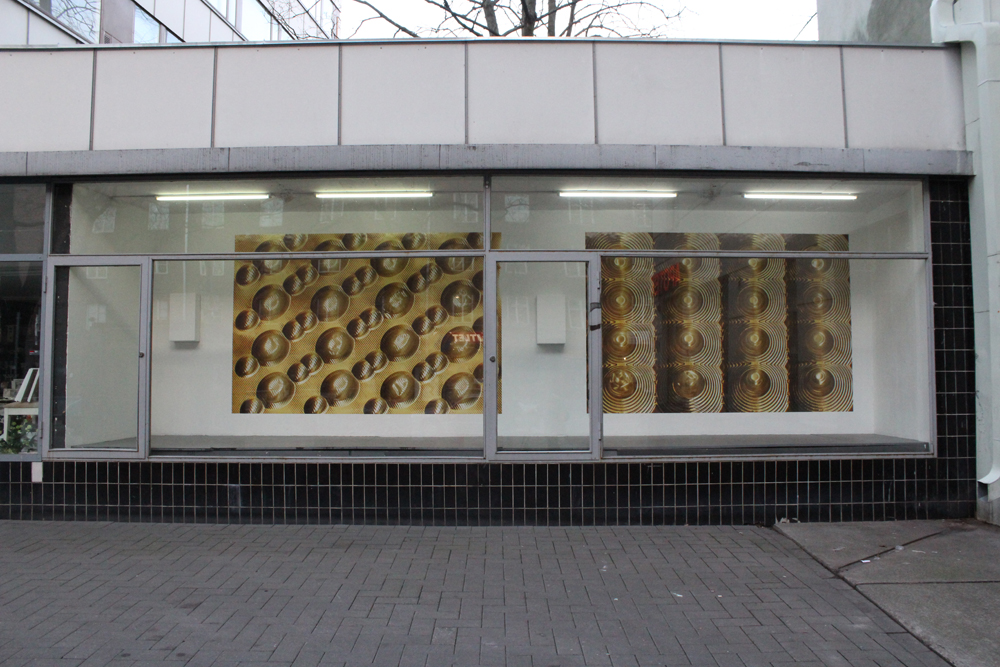
JOUNI KUJANSUU:
Köyhän joulu / A Poor Man's Christmas
[FIN] 'Köyhän joulu' koostuu kahdesta tyhjistä konvehtirasioiden kuorista otetusta valokuvasta. Kujansuu viittaa näyttelytekstissään Charles Dickensin kirjaan "Saiturin joulu" (1843) ja nostaa tarkasteluun sosiaalisen epätasa-arvon sekä köyhyyden kysymyksen suhteessa materiaan / henkeen.
Jouni Kujansuun käsitteellinen taide rinnastaa erilaisia kuvia ja materiaaleja. Teosten teemat osuvat monitulkintaisuudessaan usein arkeen, ihmisyyteen ja presentaatiohin liittyviin peruskysymyksiin. Kujansuun teoksia on ollut laajasti esillä ympäri Suomea kahdeksankymmentäluvun lopusta alkaen; muun muassa Titanic galleriassa Turussa; Muu galleriassa, Kluuvin galleriassa ja Helsingin taidemuseossa Helsingissä sekä viimeisimpänä Galleri Sinnessä Helsingissä tammikuussa 2014. Kujansuun teoksia on Helsingin taidemuseon ja Porin taidemuseon kokoelmissa.
"Mutta miten kovasti hän tekikään töitä! Scrooge! Se häikäilemätön, tyly, kovaotteinen, julma, ahne vanha syntisäkki! Kova ja terävä kuin piinkivi, jolla ei ollut kertaakaan sytytetty tulta kenen tahansa lämmitellä. Hän oli sulkeutunut ja itseensä kääriytynyt kuin osteri. Sisäinen kylmyys jäykisti hänen piirteensä, puraisi hänen terävää nenäänsä, kurtisti hänen kulmansa, jäykisti hänen askeleensa, punasi silmät, sinersi huulet ja hyyti jokaisen sanan, jonka hänen viiltävä äänensä lausui. Hänen päänsä oli kuurassa samoin kuin hänen kulmansa ja sänkinen leukansa. Hän kuljetti pakkasensa aina mukanaan, jääti toimistonsa mätäkuussa eikä lämmittänyt sitä asteen vertaa edes jouluaikaan." Charles Dickens: Saiturin joulu (1843)
|ENG] "A Poor Man's Christmas" consists of two photographs of empty chocolate boxes. In his exhibition text Kujansuu refers to Charles Dickens' book A Christmas Carrol (1843) and brings under consideration social inequality and the question of poverty in relation to materia / spirit.
The conceptual art of Jouni Kujansuu apposes different kinds of images and materials. The multiple themes in his works often touch upon the basic questions of everyday life, humanity and presentations. Kujansuu's works have been presented widely around Finland since the late 80's; for example in Titanic gallery in Turku, Muu and Kluuvi galleries in Helsinki as well as in the Helsinki Art Museum and most recently in Galleri Sinne in Helsinki in January 2014. Kujansuu's works are in the collections of Pori Art Museum and Helsinki Art Museum.
"Oh! But he was a tight-fisted hand at the grindstone, Scrooge! A squeezing, wrenching, grasping. scraping, clutching, covetous old sinner! Hard and harp as flint, from which no steel had ever struck out generous fire; secret, and self-contained, and solitary as an oyster. The cold within him froze his old features, nipped his pointed nose, shrivelled his cheek, stiffened his gait; made his eyes red, his thin lips blue; and spoke out shrewdly in his grating voice. A frosty rime was on his head, and on his eyebrows, and his wiry chin. He carried his own low termperture always about with him; he iced his office in the dog-days; and didn 't thaw it one degree at Christmas."
Charles Dickens: A Christmas Carrol (1843)
TOP / YLÖS

DIEGO BRUNO:
The Problem Of Intersection Remains
[FIN] Diego Brunon teos Alkovissa oli seurasta työskentelyn jatkumosta - prosessista, jossa aineisto (tekstit, kuvat, arkistomateriaali, informaatio) tuottaa havaintoja, ajattelua, teosaihioita ja keskusteluja. Tässä yhteydessä Brunon taiteellinen työskentely ja Alkovin tila sekä ajatuksemme tuon tilan käytöstä yhdistyvät eräänlaiseksi keskustelun alustaksi. Lopulta näyttely koostuu nimenomaan tilasta itsestään sekä lauseesta, joka toimii myös näyttelyn nimenä: ulko- ja sisätilän toisistaan erottavasta ja ne samalla määrittävästä lasilevystä "ulkoisen" ja "sisäisen" leikkauspisteessä sekä lauseesta, joka sekä tarkentaa että purkaa tätä tilallista suhdetta.
Argentiinalaistaustainen, vuonna 1978 syntynyt Diego Bruno asuu ja työskentelee Helsingissä. Hän opiskeli taidehistoriaa Buenos Airesin yliopistossa, suoritti kuvataiteen kandidaatin tutkinnon Escola Massanossa Espanjassa ja maisterin tutkinnon Kuvataideakatemiassa Helsingissä. Bruno on osallistunut useisiin kansainvälisiin studio-ohjelmiin joista mainittakoon Het Wilde Weten Rotterdamissa, Hangar Barcelonassa ja Wiels Brysselissä. Brunon teoksia on esitetty mm. Wiels Center for Contemporary Art:ssa, Buenos Airesin Museum of Latin American Art:ssa, Centre d'Art Santa Monicassa Barcelonassa, Manifesta 08 Murciassa, Hudson Valley Center for Contemporary Art:ssa New Yorkissa, Lokaal 01:ssä ja Lls387:ssä Antverpenissä, Mirta Demare Galleryssa, Ruth Benzacar Galleryssa, Center for Contemporary Art Celjessä, The Solo Project Baselissa sekä Malmö Konsthallissa. 2014 Brunolle myönnettiin Arco Art Fair Madridin Illy-palkinto työstään Solo Project Focus Latinoaméricassa.
[ENG] Diego Bruno's work in Alkovi is a consequence of a work in progress. A process that consists of material - texts, images, archival footage, information - that generate perceptions, thinking, concepts for works and discussions. Here Bruno's practice launches a discursive circle where the aforementioned variables become a shape-shifting and relinking entity functioning as a starting point for a communicative platform. The exhibition brings together Bruno's critical artistic work and Alkovi's conceptions of the gallery space and it's use. Ultimately, the work consist of displaying the Alkovi space itself, and the sentence that title the work: the interior and exterior of the gallery separated but at the same time defined by the implicit manifestation of the glass window in between - and the sentence determining as well as deconstructing this spatial relationship. You can see and understand the existence of both as separates through the intersection that creates them. We nurture this division, it presents us with a source of departure or a locus of action, allowing us to be aware that things are taking place.
Born in 1978 in Argentina, Diego Bruno lives and works in Helsinki. He studied History of Art at the University of Buenos Aires, holds a BA in Fine Arts from the Escola Massana, Barcelona and a MFA in Fine Arts from the Finnish Academy of Fine Arts. Diego Bruno participated in several international studio programs such as Het Wilde Weten in Rotterdam, Hangar in Barcelona and Wiels, Brussels.
Bruno's work has been shown at Wiels, Center for Contemporary Art, Museum of Latin American Art, Buenos Aires. Centre d?Art Santa Monica, Barcelona, Manifesta 08 Murcia, Hudson Valley Center for Contemporary Art, New York. Lokaal 01 Antwerp, Lls387 Antwerp, Mirta Demare Gallery, Ruth Benzacar Gallery, Center for Contemporary Art Celje, Extra City, The Solo Project, Basel, Malmö Konsthall among others. In 2014 he was awarded the Illy prize for his work at Solo Project Focus Latinoamérica, Arco Art Fair in Madrid.
TOP / YLÖS

ANGELA WASHKO & ALEX YOUNG:
SERF-NET
[FIN] Yhteisnäyttelyssään Galleria Alkovissa Angela Washko ja Alex Young esittelevät SerfNetin - projektin joka keskittyy joukkoistettuihin työskentely alustoihin ja yksityisen työntekijän suhteeseen oman työnsä tuloksiin, tuotanto-ympäristöön, laajemman tuotantorakenteen ymmärtämiseen, ja siihen ajattelevatko he toimintaansa työnteoksi lainkaan. Verkossa tapahtuvasta työstä jo olemassaolevien tilostollisten tutkimuksien toistamisen sijaan Washko ja Young päättivät luoda yrityksen Amazonin Mechanical Turk:in sisälle.
Toimimalla SerfNettinä Washko ja Young loivat pieniä rahaa vastaan toimitettavia tehtäviä, joita kutsutaan nimellä HIT (Human Intellegence Task). Ne ovat pieniä tehtäviä, joihin yritys tai tutkija tarvitsee ihmisiä, usein luonteeltaan sellaisia, joita tietokoneen algoritmit eivät vielä pysty tekemään, vaihdellen erilaisista tutkimuksellisista kyselyistä tekstin ja kuullun puhtaaksikirjoittamiseen. Kaikki tehtävät välitettiin mturk.com:in ja Amazon Marketplace- sivuston kautta. Taiteilijoiden luomat työtehtävät (HITs) tavoittelivat ja palkitsivat yksittäisten työntekijöiden oman työnsä arvon mietintää sekä oman suhteensa pohtimista suhteessa näihin osallistumiinsa järjestelmiin.
Yli 150 näissä rakenteissa työskentelevää henkilöä osallistui SerfNet:in kyselyihin raporoiden pääasiassa Yhdysvalloista ja Intiasta. SerfNetin kautta Washko ja Young myös pyrkivät tutkimaan englannin kielen hegemonista asemaa globaalissa liiketoiminnassa ja sen vaikutusta parempaan yhteiskunnalliseen asemaan pyrkimiseen (samanaikaisesti kun englannin kieli on mTurkin vaadittu kieli HIT -tehtäville, niistä saatetaan maksaa vain pari senttiä tunti).
Katsoen menneisyyteen ja tulevaisuuteen kuvitaakseen englannin kielen etymologiaa työn käsityksestä, ja sen linkittyneisyydestä muunmuassa piinan, uurastuksen ja liikkumisen konseptien kanssa. SerfNet esittää tämänpäiväisen joukkoistetun työn ilmiön Eurooppalaisen keskiaikaisen feodolismin kautta nähtynä.
Alex Young (USA) on tutkijataustainen taiteilija, muotoilija ja kuraattori, jonka työt sisältävät kriittistä ja kokeellista historiankirjoitusta ja analysoivat ristiriitaisia ideologioita.
[ENG] In their collaborative exhibition at Alkovi Galleria, Angela Washko and Alex Young present SerfNet - a project which focuses on crowd-sourced labor platforms and the individual worker's relationship to the products of their labor, the environment in which they produce it, their understanding of the larger framework they're producing in, and whether or not they consider what they are doing labor at all. Instead of replicating existing statistical research about online networked labor, Washko and Young decided to create a business within Amazon Mechanical Turk. Operating as SerfNet, Washko and Young created Human Intelligence Tasks or HITs (small tasks that a business or researcher might need humans for, often things computer algorithms cannot do yet, ranging from research surveys to transcribing text from receipts or audio) for Mechanical Turk Workers to complete in exchange for money - all mediated through mturk.com's interfaces and the Amazon Marketplace pay site. The jobs (HITs) the artists created solicited and rewarded individual workers' contemplation and reflection on the value of their own work within and their personal relationship to the systems in which they are participating.
Over 150 individuals working within this labor platform participated in SerfNet's surveys - reporting bases in the United States and India. Through SerfNet, Washko and Young also sought out to examine the English language's hegemonic position within global business and its impact on aspirations toward upward mobility (while simultaneously being a requirement for mTurk HITs which may only pay a few cents per hour). Looking to the past and future to animate the etymology of the English conception of labor and the interconnectedness of concepts of pain, toil, travel, and more... SerfNet presents this contemporary crowd-sourced labor phenomenon under the lens of medieval European feudalism.
Angela Washko (USA) is an artist and facilitator devoted to mobilizing communities and creating new forums for discussions of feminism where they do not exist.
Alex Young (USA) is a research-based artist, designer, and curator whose works employs critical and experimental historiography in analyzing the often contradictory ideologies that fuel the future present.
TOP / YLÖS
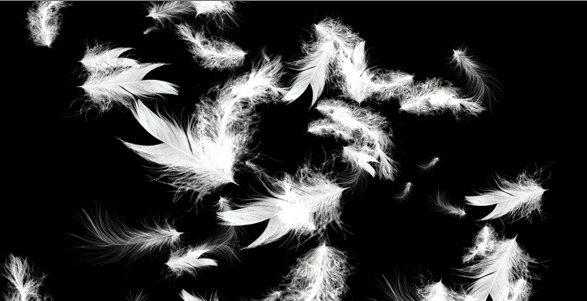
JOHANNES RANTAPUSKA:
Stormy Feather
Johannes Rantapuska installoi ikkunatilaan höyhenistä ja tuulettimista koostuvan installaation.
Johannes Rantapuska (s. 1984) työskentelee visuaalisen kulttuurin parissa. Tämä oli hänen toinen installaationsa Alkovissa. Vuonna 2012 hän rakensi hiustenkuivaajasta ja styroksipalloista teoksen nimeltä 'Mood Swinger'.
Johannes Rantapuska installed an artificial storm by using fans and feathers to Alkovi.
Johannes Rantapuska (b. 1984) works with visual culture and this was his second installation in Alkovi. In 2012 he built a work called 'Mood Swinger' consisting of hair dryers and styrofoam balls.
TOP / YLÖS
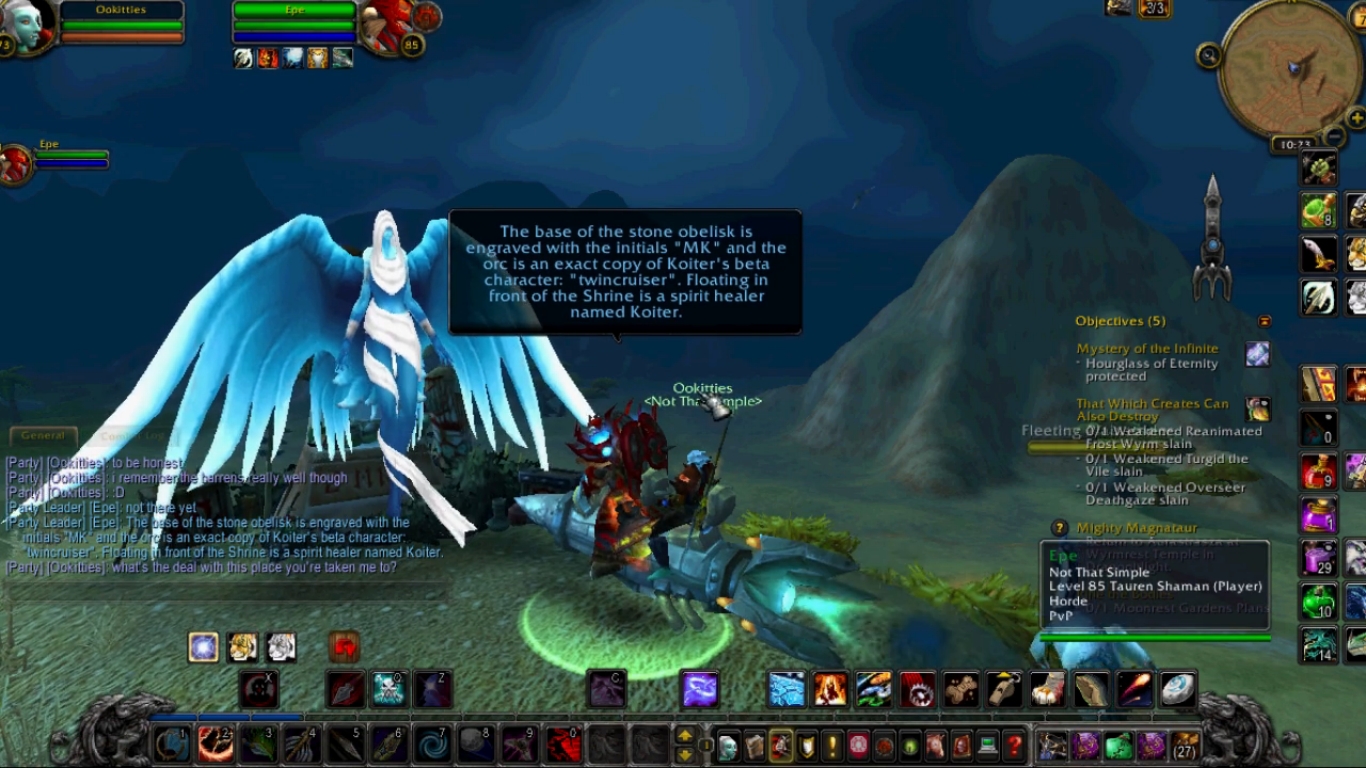 [Kuva/ Image: Angela Washko]
[Kuva/ Image: Angela Washko] URB 14 FESTIVAL:
Alkovi toteutti yhteistyössä Kiasma teatterin URB-festivaalin kanssa kaksi esitystä.
8.8. 2014 Angela Washko (USA): The World of Warcraft Psychogeographical Association: Helsinki Drift
[FIN]Angela Washko lensi läpi nettipeli World of Warcraftin eeppisen maiseman seuraten muita pelaajia ja yrittäen selvittää heidän suosikkipaikkojaan pelin sisällä, sekä keskustellen heidän tietämyksestään kaupungista jossa Washko fyysisesti sijaitsi (Helsinki). Washko etsi piilotettuja muistomerkkejä pelimaailman hetkellisyydessä ja tutki, mitä elämä on virtuaalisessa kaupungissa. Pelin toiminnallisuuksia tarkoituksellisesti väärinkäyttäen hän loi virtuaalipelistä julkisen esityksen, ja vei tapahtuman seuraajat psykograafiselle matkalle World of Warcraftin maailmaan. Tapahtuma live-streamattiin Kalliossa sijaitsevan Alkovin ikkunaan.
9.8.2014 Alex Young (USA): THE CITY AGAINST ITSELF, 15 min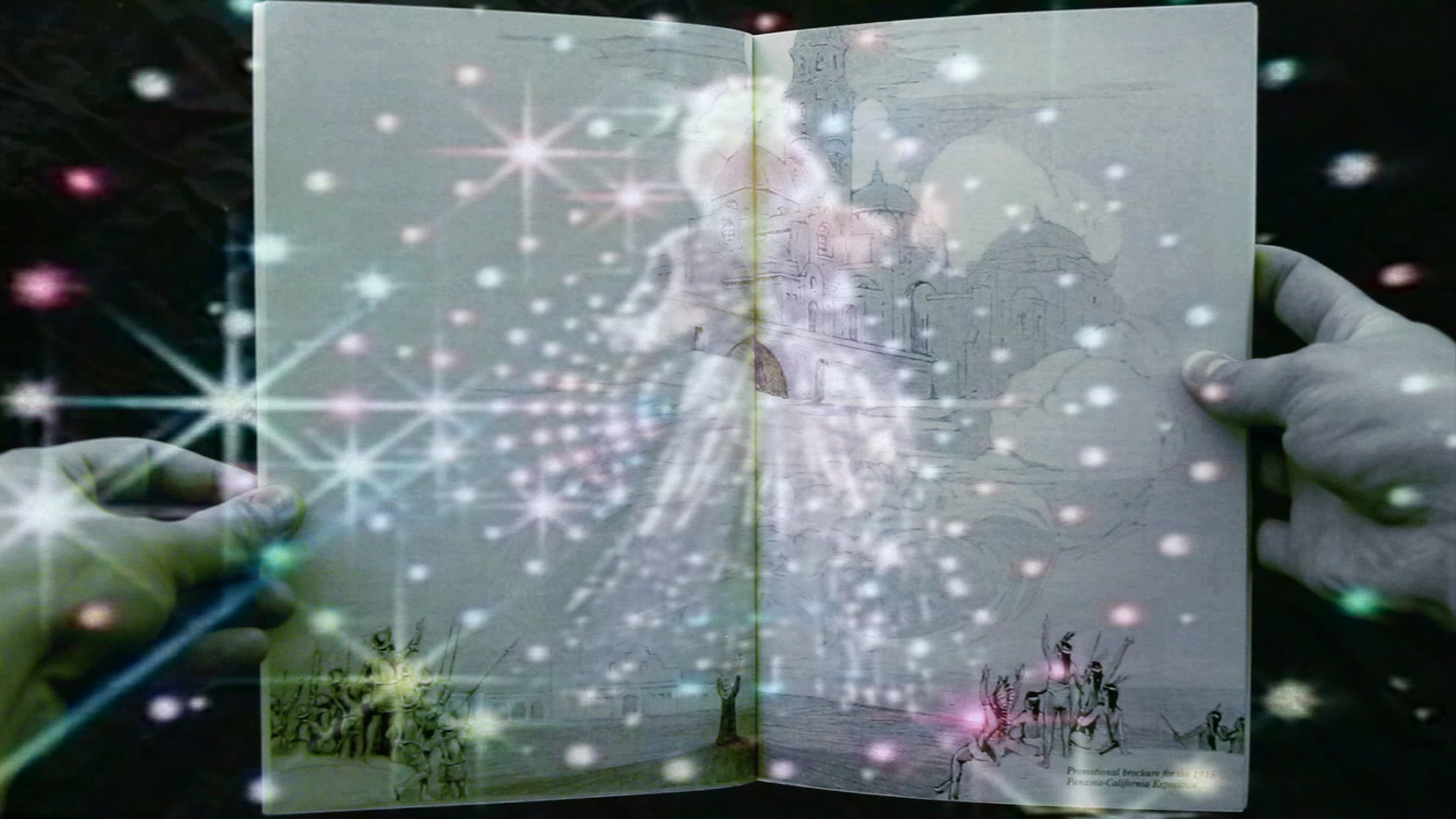 [Kuva/ Image: Alex Young]
[Kuva/ Image: Alex Young]
San Diego on paratiisimainen pakopaikka, joka on liitetty myös paon tematiikkaa sisältäviin, ulkoavaruuden yhteyksiin uskoviin kultteihin. Mielikuva San Diegosta pakopaikkana rinnastuu myös todellisuuteen: mm. kodittomien määrä on USA:n suurimpia ja kaupunkiin valuun laittomia maahanmuuttajia etelästä, toisaalta kaupunki tarjoaa huomattavat mahdollisuudet kouluttautua laivastossa, merijalkaväessä ja kotimaan turvallisuusjoukoissa. Projekti tutkii mitä San Diegosta voidaan oppia sekä pureutuu paon ideologiaan niin maanpäällisellä kuin maan ulkopuolisellakin tasolla.
[ENG]Alkovi presented in collaboration with the Kiasma theatre's urban art festival URB two works.
8.8. 2014 Angela Washko (USA): The World of Warcraft Psychogeographical Association: Helsinki DriftAngela Washko flew through the epic landscape in a virtual game World of Warcraft, following players around, finding out their favorite locations within the game, and discussing their knowledge of the city Washko physically inhabited (Helsinki). They seeked out hidden memorials in this ephemeral space and investigate urban life in virtual cities. By intentionally misusing the functionality of the game, she turned the depths of the game into fruitful territory for public performance, leading the audience to a psychogeographical drift inside World of Warcraft. A live stream of the WoW performance was screened in the window of Alkovi, in Kallio, simultaneously with the event.
9.8.2014 Alex Young (USA): THE CITY AGAINST ITSELF, 15 minVideo project inspects the dualities of the city of San Diego: a paradisiacal escape that has also been associated with various cults claiming a direct connection to the heavens. San Diego negotiates its image of escape with reality: featuring one of the US' highest populations of both homeless people and 'illegal' immigrants from the south and living right next to prominent facilities for the Navy, Marine, and Homeland Security training. This project explores what can be learned from San Diego, and from the politics of its ideology of escape, moving from the terrestrial to the extraterrestrial.
TOP / YLÖS
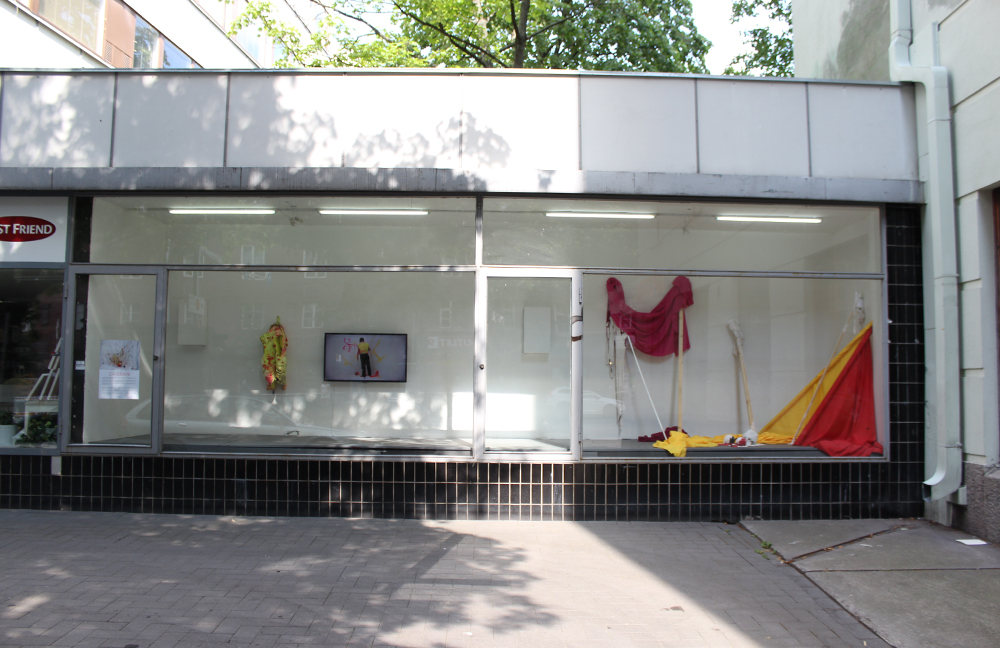
HEINI AHO:
CAVEMAN
[FIN] "Caveman videon lähtökohtana on konkreettinen objekti, lasketteluliivi, jonka innoittamana rakennan videossa tilallista teosta. Työstän kuvaa nopeilla päätöksillä ja ensimmäisinä mieleen juolahtavilla asioilla. Valittu esine menettää nopeasti muotonsa ja merkityksensä ja toimii virikkeenä mielikuvitukselle, jonkin uuden hahmottamiselle.
Värikäs liivi kummastutti pintakuvioineen, se näyttäytyi samanaikaisesti mitättömänä ja merkittävänä. Kiinnittäydyin tähän kappaleeseen ja aloin työskennellä sen pohjalta. Ensimmäinen assosiaatio vaatteen kuvioinneista oli luolamaalaukset. Miettiessäni materiaalia tai välinettä päädyin spray maaliin. Muinaiset luolamaalaukset ja vimmattu värikäs liivi; tästä ajatusparista lähdin rakentamaan tarinaa.
Rakensin kuvaa pienessä, noin kahdeksan neliön valkoiseksi maalatussa huoneessa. Kamera otti kuvan tilasta tasaisin väliajoin. Caveman on dokumentaatio työn etenemisestä, se on valokuvista ja pienistä videonpätkistä koottu yksinkertainen animaatio. Videon lopussa tyhjentynyt huone on täynnä jälkiä tapahtuneesta.
Kuvan rakentamiseen kului noin vuorokausi." Teksti: Heini Aho
Heini Aho (1979) on valmistunut Turun Taideakatemiasta ja jatkanut maisterinopintoja Helsingin Kuvataideakatemiassa vuonna 2009. Hän rakentaa pääasiallisesti installaatioita joissa valot ja varjot ovat keskeisellä sijalla. Videotallenne on usein osana installaatiota tuoden esille jonkin teon tai tapahtuman. Aho on osallistunut aktiivisesti kansainvälisiin näyttelyihin mm. Cyberfestiin Pietarissa, Mediations biennaaliin Puolassa, Jakartan biennaalin Indonesiassa, Luleån kesäbiennaaliin Ruotsissa ja pitänyt yksityisnäyttelyjä mm. Muu galleriassa ja galleria Anhavan Projektitilassa vuonna 2012, Small Projects galleriassa Tromssassa vuonna 2013. Viimeksi Ahon teoksia oli esillä Helsingin Taidehallissa (työryhmä Metsästäjät Aho, Piilola, Ketola). Aho on työskennellyt useissa residensseisssä ulkomailla, joista mainittakoon The Arctic Circle, kolmen viikon mittainen purjehdus Huippuvuorilla sekä Pro Artibus Air residenssi Tammisaaressa.
[ENG]
"The starting point to the Caveman video is a concrete object - a skiing vest - that inspires me to build a spatial art work within the video. I work the image through quick decisions and things that spring to mind. The selected object quickly looses its form and meaning and instead functions as a stimulant for the imagination - for perceiving something new.
The colorful vest puzzled me with its pattern, it appeared at the same time as trivial and meaningful. I attached myself to this object and started working according to it. The first assosiation about the pattern was cave paintings. As I thought about the material and medium I ended up with spray paint. Ancient cave paintings and the wild colorful vest; from these two thoughts I started to build up a story.
I structured the image in a small, about eight square meter room painted all white. The camera recorded images at even intervals. Caveman is a documentation of a work in progress, it is a simple animation consisting of still images and short video clips. At the end of the video stands the empty room that is full of traces of what went on.
It took about a day to build up the image." Text: Heini Aho
Heini Aho (b.1979) has graduated from Turku Art Academy and continued to do her MFA at the Helsinki Academy of Fine Arts in 2009. Mostly she builds installations that place strong emphasis on the use of light and shadow. A video recording is often brought in to the installation to present an action or an event.
Aho has actively participated to international exhibitions such as Cyberfest in St Petersburg, Mediations Biennale in Poland, Jacarta Biennale in Indonesia and LuleÃ¥ summer Biennale in Sweden as well as to solo exhibitions in Muu gallery and the Project space of Anhava Gallery in 2012 and Small Projects Gallery in Tromssa at 2013, to name few. Aho's works have been seen in Kunsthalle Helsinki (working group Metsästäjät : Aho, Piilola, Ketola).
Aho has taken part to several residencies, for example The Arctic Circle - a three week sailing trip in Svalbard - and Pro Artibus Air residency in Tammisaari.
TOP / YLÖS
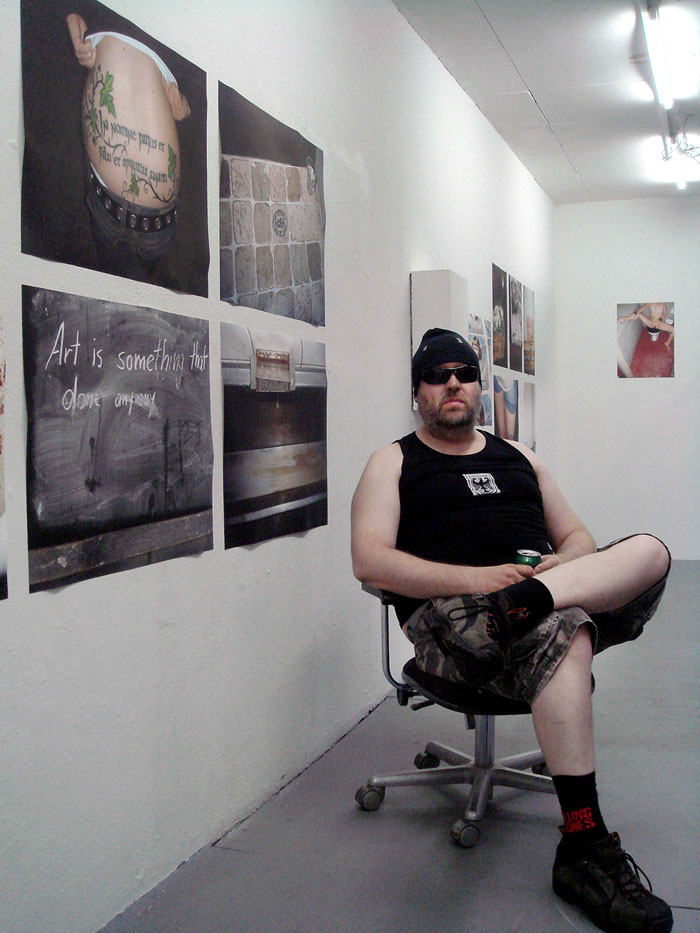
PER SONNE:
HALOO LUUSERI Osa 1: Provokaatio Helsinginkadulla / HELLO, LOOSER Part One: A Provocation in Helsinginkatu
[FIN] Per Sonnen paikkasidonnaisen teoskokonaisuuden HALOO LUUSERI Osa 1: Provokaatio Helsinginkadulla "pääosassa on taiteilija, joka ei oikein ole saavuttanut apurahakauden tavoitteitaan ja alkaa loppusuoralla hyytyä." Lainaus: Per Sonne
Näyttelyn valokuvateokset esittävät satunnaisia otoksia taiteilijan elämästä apurahavuoden aikana, työskentelypyrkimyksiä, paikkoja sekä tiloja, yksityiskohtia. Niissä taiteilijan omaelämänkerrallinen todellisuus, yleensä ei-porvarillinen (muttei aina) asioiden loputtoman tarkastelun lakonisuus ja tirkistelemisen peittelemätön himo ovat läsnä pakkomielteen omaisesti. Projektilla ei sinänsä ole mitään varsinaista tarkoitusta tai päämäärää.
Näyttelyn kuluessa taiteilija ilmestyy vitriiniin juhlimaan sadatta näyttelyään, ripustamaan uusia tai vaihtamaan huonosti valittuja teoksia, katsomaan televisio ohjelmia, juomaan keskiolutta, kuluttamaan aikaa tai olemaan muuten vain epäsosiaalinen. Nämä interventiot tapahtuvat yleisölle ilman ennakko-ilmoituksia erilaisiin vuorokauden aikoihin.
HALOO LUUSERI:ssa Alkovin tilaa käytetään projektissa osin galleriana, osin julkisena live-art tapahtumien alustana kokonaisteoksen sijoittuessa jonnekin nykyvalokuvan, julkisen taideinstallaation ja live-artin väliseen määrittelemättömään tilaan.
/ Teoksen Osa 2: Sovitus ja anteeksipyyntö esitettiin turkulaisessa vitriinigalleria Jäniksessä osin päällekkäin Alkovi (gallerian) esityksen kanssa.
Sonne, Per (s.1965) on suomalainen valokuvaaja ja visuaalinen taiteilija, jonka teoksia on Suomessa nähty mm. Turku 2011 Euroopan kulttuuripääkaupunki - hankkeessa, yksityisprojektissa Bonnissa.
Hän on osallistunut yli 60:een yhteis- ja ryhmänäyttelyyn sekä taideprojekteihin Suomessa ja Euroopassa sekä pitänyt yhteensä yli 30 yksityisnäyttelyä. Per Sonnen teoksia on 12:ssa taidekokoelmassa Suomessa, USA:ssa ja Saksassa.
[ENG]Per Sonne?s site-spesific work HELLO, LOOSER Part One: A Provocation in Helsinginkatu attributes the leading role to an artist "who never actually reached his goals during his time of grant, and is getting exhausted on the finish line." Quote: Per Sonne
The photographic works in the exhibition are random pictures of the artist?s life during his scholarship year. In the images one can recognize the artist?s aims, random sites, spaces and details. The artist?s autobiographical reality, most of the time non-bourgeois (if not always), the laconism of constant observation of subjects and the uncovered lust for peeping are present like an obsession. The project itself is not actually aiming anywhere nor has a specific goal.
During the exhibition the artist becomes present in the gallery in order to celebrate his 100th exhibition, to replace badly chosen works or to add brand new ones, to look at the TV, to drink some beer or just to act unsocially. These interventions happen to the audience without any notice at different times of day or night.
In HELLO, LOOSER the space at Alkovi is used partly as a gallery space, partly as a public live-art working ground, the entity forming itself somewhere in the open-ended state of contemporary photography, public art and live-art.
/ The Part Two: Atonement and Apology, was seen at Gallery Jänis in Turku partly at the same time with the show in Alkovi.
Sonne, Per (b.1965) is a Finnish photographer and a visual artist. His works has been seen in Finland a.o. in Turku 2011 European City of Culture programme and lately as a personal project in Bonn, Germany.
He has participated in over 60 group exhibitions and art-projects in Finland and in Europe. In addition to that he has held close to 40 solo-exhibitions and art projects. Per Sonne?s work is represented in 12 art collections in Finland, USA and Germany.
TOP / YLÖS
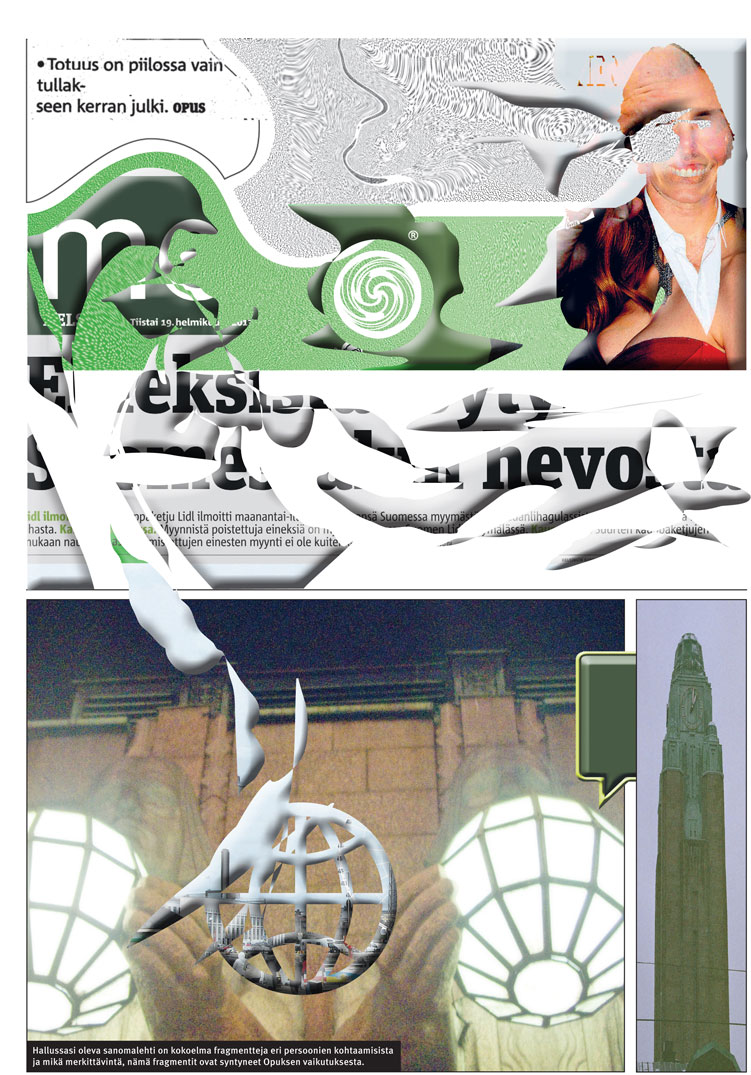
SAULI SIRVIÖ:
Se kuuntelee sun puhelinta, hymyilee sulle tiedotusvälineissä ja pyytää sulta rahaa /
It listens to your phone, smiles at you in media and asks you for money
[FIN] Sauli Sirviön teos "Se kuuntelee sun puhelinta, hymyilee sulle tiedotusvälineissä ja pyytää sulta rahaa" on sanomalehti, joka levittäytyi julkiseen tilaan sekä samanaikaisiin näyttelyihin Galleria Alkovissa ja Kuvan Kevät tutkintotyönäyttelyssä Kuva/Tilassa.
Prologi:
Tämän sanomalehden materiaali on dokumentoitu välillä 2013 -2014 Sampo pankin (nykyinen Danske Bank) konttorissa Hakaniemessä (suljettu), ravintola Elielissä (nykyinen Burger King) Pielisen maisemien alla, käytöstä poistetussa pitkänmatkan junassa Turussa (romutettu), hylätyssä väestönsuojassa Kallion kaupunginosan alla, 3T ja 3B raitiovaunuissa (nykyinen 2 ja 3), Ilmalan kivilinnassa (osittain tuhopoltettu), Kaartin maneesissa (nykyinen parkkihalli), autiossa Kakolan rangaistusvankilassa sekä muissa lukemattomissa paikoissa jotka ovat ehkä vielä olemassa jossain aineellisessa muodossa. Tekstit ovat olleet hajallaan sadoissa paperilapuissa, välillä myös tussilla käteen kirjoitettuna. Negatiivit ovat olleet mappien kätköissä todisteena menneistä ajoista. Materiaali oli koottava yksiin kansiin, sillä tieto on siirrettävä eteenpäin sen virallisessa muodossa. Hallussasi oleva sanomalehti on kokoelma fragmentteja eri persoonien kohtaamisista ja mikä merkittävintä, nämä fragmentit ovat syntyneet Opuksen vaikutuksesta. Ilman häntä tämä etsintäkuulutus ja siihen liittyvä odysseia ei olisi koskaan tapahtunut. Itse sanomalehti on tuotteena fyysinen ja katoava, se sijoitetaan Helsingin infrastruktuuriin ja sen on määrä tulla sattumalta löydetyksi. Se ilmestyy Lyhdynkantajien vartiomana Kompassin kaikissa ilmansuunnissa. Mikäli et saa lehteä fyysisesti itsellesi, saatat kuitenkin tulevaisuudessa tulla törmäämään siihen kansantaruissa ja urbaaneissa legendoissa. Jotta kaikki informaatio säilyisi tuleville jälkipolville, on sanomalehden sisältämä tieto spreijattu aineettomina bittihieroglyfeina kohti kaukaisia galakseja, paikkoihin joissa vielä saattaa olla toivoa. Lukiessasi tämän tekstin on allekirjoittanut astunut rautaisen ratsunsa selkään aloittaen matkansa uuteen päämäärään nykyteknologian tavoittamattomiin.
Opukselle, Helsingin päärautatieaseman raiteella 11,
tiistaina 22. huhtikuuta 2014
[ENG] Sauli Sirviö's work "It listens to your phone, smiles at you in media and asks you for money" was a newspaper that spread around public space as well as into two simultaneous exhibitions in Alkovi and Kuvan Kevät 2014 - The Degree Show of the Academy of Fine Arts' in Kuva/Tila.
Prologue:
The material of this newspaper is documented between years 2013- 2014.
The documentation has taken place at Sampo bank ?s (the current Danske Bank) office in Hakaniemi, below the landscape of Pielinen in restaurant Eliel (the current Burger King), on a long distance train that has been taken out of service in Turku (demolished), in abandoned shelter underneath the district Kallio, in the tram number 3T and 3B (nowadays 2 and 3), in Stone castle at Ilmala location (partly arsoned), in Kaarti riding hall (the current parking hall), in Kakola ?s abandoned prison and other countless places that still perhaps exist in some material form. The texts have been scattered in hundreds of pieces of paper. Also written by ink on the palm of hands. Negatives have been in the archives as an evidence of past times. The material was compiled into one folder, because the data must be passed forward in its official form. The newspaper that you have in your possession is a collection of fragments. The fragments consist of encounters of different personalities. Most importantly, these fragments were born under the influence of Opus. Without him or her, this bulletin and the associated odyssey never would have happened. The newspaper itself is the product of physical and ephemeral. It is placed in Helsinki ?s infrastructure and is expected to come discovered by chance. It appears guarded by the statues of Lyhdynkantajat. If you do not get the newspaper physically to yourself in the future you may run into it in folk stories and urban legends. In order to maintain all the information for future generations the newspaper ?s content has been sprayed towards distant galaxies in the form of digital hieroglyphs to places where there might still be hope. While you are reading this text the author of this newspaper has climbed on the back of his medallic steed and started his journey somewhere away from the modern technology.
To Opus at Helsinki central railway station, track 11.
Tuesday 22nd of April 2014
TOP / YLÖS

Niina Tervo:
ELÄVÄ KUVA / A PICTURE ALIVE
[FIN] Teos koostui maalatuista elävistä puista ja termiittikeon näköisistä saviruukuista.
"Näen teoksen kolmiulotteisena kuvana, jonka neljäs ulottuvuus on aika.
Kuvamaisuus syntyy lasin litistävästä vaikutuksesta, sillä vaikka teos on fyysisesti kolmiulotteinen ikkunalasi estää teokseen sisään pääsyn ja luo samankaltaisen
tunnelman kuin katsottaessa kaksiulotteista kuvaa.
Teos eroaa kuitenkin paikallaan olevasta kuvasta sen ajallisuuden vuoksi; koska puut ovat eläviä, ne silmuavat ja kasvavat näyttelyn ajan, kuva muuttuu.
Hidastempoinen muutos muistuttaa elokuvaa, joka hiljalleen kertoo tarinaansa ja antaa samalla katsojan omille ajatuksilleen tilaa yhtyä siihen." Teksti: Niina Tervo
[ENG] Work consisted of painted living trees and termite nest like clay pots.
Tervo saw the work as a tree dimensional image with its fourth dimension being time.
The picture-like feeling was created by the flattening effect of the windo - because even though the work itself is physically three dimensional - the window glass obstructs the viewer from entering the work and creates a two dimensional feeling.
Tervo also saw that the work differed from an ordinary image because of its temporal nature. The trees which are living organisms open their leaf buds and grow for the duration of the exhibition changing the image. The slow paced change was reminiscent of a movie which slowly tells its story and at the same time allows space for the viewers thoughts to combine with it.
The artist Niina Tervo (b.1983) is a bachelor of science (biology) and was a fourth year student in the Academy of Fine Arts Helsinki during the exhibition.
TOP / YLÖS
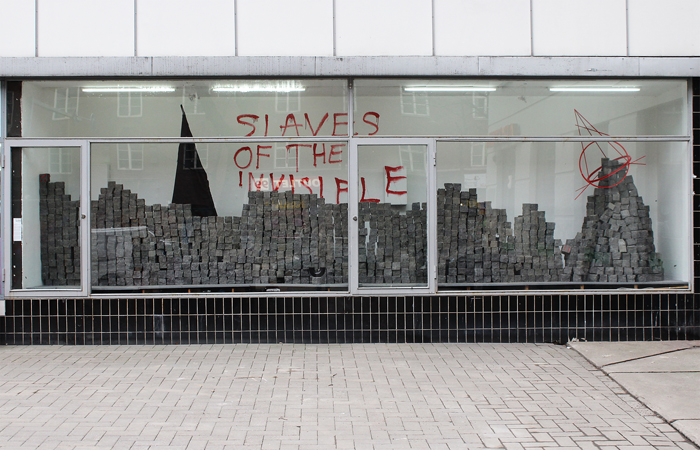
GIAN LUIGI BIAGINI:
THE FATAL STRATEGY OF A PURE EVENT
[FIN]Katukivistä ja symboleista koostuva installaatio toi esiin ajatuksen esoteerisestä anarkismista. Siinä anarkismi vertautuu muihin hermeettisiin liikkeisiin kuten vapaamuurauriuteen ja sen symboleihin sekä materiaalisiin viittauksiin. Esimerkiksi muurarin tiili solidina rakenteena vertautuu katukiveen, joka on yhtäältä julkista tilaa rakentava mutta toisaalta myös ambivalentti "irrotettava" ja olemuksellisesti muuttuva anarkismin väline. Teos on osa taiteellista tutkimusta, joka pureutuu kapitalismin sisään rakennetun vallankumouksellisuuden halun mytologioihin. Näyttelyn tekivät Gian Luigi Biagini yhteistyössä John Dunnin kanssa.
Gian Luigi Biagini on italialaislähtöinen taiteilija, joka yhdistää teoksissaan eräänlaista poliittista shamanismia ja anarkismin tutkimusta käsitteelliseen ja performatiiviseen taiteen tekemiseen.
[ENG] An installation consisted of cobblestones and symbols and brought forward an idea of esoteric anarchism. Here anarchism is compared with other hermetic movements such as freemasonry and it's symbols and materialistic references. For example, a masons brick as a solid constructive element is being compared with a cobblestone which on one hand can be seen as something that builds up public space but also as an implement of anarchism that is ambivalent and disjoint in it's essence. The piece is a part of artistic research that seizes the mythologies of revolutionary desire built in capitalism. The exhibition was made by Gian Luigi Biagini in collaboration with John Dunn.
Gian Luigi Biagini is an artist from Italy that combines in his artworks a certain kind of political shamanism and research of anarchism into conceptual and performative art making.
"The installation is a singular multiplicity of sensual resonances catalyzed by the orbit-perceptual of the esoteric anarchism. The artwork takes inspiration from the magnetism of the masonic compass, that the anarchist symbol was derived from, and then radicalized to the extreme of a darkdimensional Alef-object. The composition is a shamanistic reflection on the obscure flows of knowledge and experimental practices which underrun the centuries; a tribute to the huge challenging wave of potentials excluded by the clear axiomatic of the institutional apparatuses of repression. Through this artwork a distinct obscure flux of spectral intensities, outside of any representation, finds its way to disrupt through the sensual presence of symbols and materials, as a political possession of a surplus-code transmission.
In fact if masons and secret anarchism, throughout the centuries, share a conspiratorial intertwined field, a sectarian dark area of migration and exchange, a common aristocratic refusal of monarchy, churches and representative democracy, they take antithetic exits. If masons oligarchic political aim is to build (using masonry work) the architecture of a new order inside the order taking possession of the institutions to secretly pilot them toward the bourgeoise public progress (and their bourgeois private business), the anarchists and today post-anarchists want instead to produce a society-flow where chaosmosis, a tonomy, heterogenesis, and direct democracy prevails on the compulsive order of the institutions, where the magnetism of the singular prevails over the representation of the general and the particular, where the fractal schism or schizo prevails over the signifier of a total structure (that is also the main difference with communism).
The distance between the masonic architectural project and the anarchitectural desiring production is well expressed by two materials: the masonry brick and the black cobblestone. If the masonry brick is a material of construction, the black cobblestone is a disruptive material extracted from the streets to produce barricades as in the case of the Paris Commune or as a spontaneous weapon of counter-attack in a long history of riots. Besides, if the brick is a private or institutional material for the stability of an order, the cobblestone is a public, always available ambiguous material that one can find in urban streets and public squares to build the actual order of the City, but which contain in itself the potentiality to subvert that order. It is the symbol of the power of the common citizen in the City, the power it has to contest without an organized force the established edifice of the authority and its monopoly of violence. In fact if masonry brick and cobblestone share a shadowy underterritory, they symbolize an opposite approach and an antithetic vision of the world and its political bases. The masonry brick founds a base for a stable institution, the cobblestone ungrounds the foundation.
This artwork is part of an artistic research that, using singular expressions, remodulates the mythological flows produced by the revolutionary desiring machine installed inside, outside, and beside the capitalist body considered as the over-coding super institution. The ethic and aesthetic strategy of this research is in adding virtual surpluscode to the actual difference produced by theantagonist phantom that persists, insists, and haunts, as a specter, the capitalist medium from the inside in the form of an outside-resistant-challenging-body. This obscure heterotopy is expressed by the intensification and re-injection of materials and symbols taken as re-combinatorial markers of a rhizome not completely subsumable by the axiomatic valorization of the capitalist code-machine. In this secret and subterranean affirmative tide the multiple schizo-concatenation of additional difference will disseminate a wave of new differences and will push fresh assemblages of revolutionary percepts into the emergence. In this becoming-tide the artists delete themselves as identities to become singularities in a field of potential, renewing and re-enacting the mystic presence of an indeterminate event yet to come, an act of belonging to a fatal strategy beyond any calculable finitude that challenges the mise en scene of capitalist power s empty heart.
The work is realized by the micro-field Anartistas formed by Gian Luigi Biagini and John Dunn."
TOP / YLÖS

KAISA LUUKKONEN:
KEEP ON DREAMING
[FIN]
"Teemme joka päivä sarjan valintoja, joilla jatkamme arkea. Päätämme nousta aamulla töihin, käytämme samaa hammasharjaa vielä kerran ja jatkamme edelleen samaa ihmissuhdetta. Arjen rutiini suojaa meitä todellisuudelta, joka vyöryää televisiostamme sotakuvina ja dokumentteina. Arjessa keplottelemme hetkestä toiseen siten, että toistamme itsellemme jotakin tuttua tekoa. Toisto saa meidät uskomaan elämän pysyvyyteen. Kuitenkin elämä on sarja hetkiä, joihin vaikuttaa meidän vaikutusvaltamme ulkopuolella olevat tekijät. Arjen kontrolli on illuusio, jota tarvitsemme uskoaksemme omaan autonomiaamme.
Jokaisessa hetkessä on potentiaali herättää meidät arjen unesta. Useimmilla meistä on myös kokemuksia tapahtumista, jotka rikkovat arjen hauraan rytmin. Koemme silloin itsemme erillisimmiksi ja elämän kaaottisuus paljastuu. Noina hetkinä tapahtuu heräämisiä. Voimme nähdä elämämme triviaalisuuden. Suuret uhraukset tuntuvat hukkaan heitetyiltä, ja sanomatta jääneet sanat merkittäviltä. Kaikki heräämiset eivät kuitenkaan ole raastavia ja tuhoavia. Jotkut heräävät arjestaan hetkeksi: he muuttavat elämän suunnan siedettäväksi ja palaavat arjen unelmien suojaan." Teksti: Kaisa Luukkonen
Keep On Dreaming on kuhunkin näyttelytilaan sovitettava installaatio, jossa materiaalina on valkoiset heliumpallot, parsinneulat ja näyttelyaika.
Kaisa Luukkonen on vuonna 1974 Kuopiossa syntynyt kuvataiteilija. Hän asuu ja työskentelee Tampereella. valmistuttuaan Kankaanpään taidekoulusta 2005 (Kuvataiteilija AMK) hän on työskennellyt sekä installaatioiden että performanssin parissa. Taidejärjestötoiminta ja tapahtumakoordinaattorina toimiminen on myös hänelle tuttua. Edellisen kerran hänen teoksiaan on ollut esillä yksityisnäyttelyssä Galleri Boxissa Göteborissa, Ruotsissa. Hän on myös yksi Perfo! -tapahtuman tuottajista.
[ENG]
"Every day we make a series of choices with which we continue our everyday life. We decide to go to work in the morning and decide to use the same tooth brush. These routines protect us from the reality that billow over us from in form of threatening news. We wangle through our lives repeating actions we are familiar with. Repetition makes us believe in stability of life. Nevertheless life is a chain of moments that are effected by forces outside our control. The containment of our everyday life is an illusion we need to be able to feel autonomous. In every moment there is a possibility to wake up from the dream of everyday life. Most of us even have experienced moments, when our realities are fractured. Moments when we feel ourselves separate and the arbitrararity our lives is exposed. In those moments a wakening happens. We see our grand sacrifices as trivial and the meaning of those words that were left unspoken. In our lives presuming that we are in contact with reality. This sense of reality is extremely fragile and often not even so anchored to our surroundings but in our need to survive. We need some sense of continuity and security to be able to go on with the routines of daily life. We, as humans, need to feel there is sense to go on with living.
This same illusion of order can obscure us from seeing the possible alternative choices that we have. When we are confronted with a crises that brakes this illusion of reality we face also a possibility to wake up from it. Sometimes this helps us see what is trivial and what is essential in our lives. Other times it just shows us truths too ugly and unbearable. Whatever it is that crises lays bare about our lives, eventually we turn back to haven of everyday dream. Some of us act upon these moments and some of us shun from the ugliness of reality but we all return to the daydream haven of everyday life." Text by: Kaisa Luukkonen
Keep On Dreamng is an installation that is fitted to the given space. The materials used in it are white balloons, sharp darning needels and exhibition time.
Kaisa Luukkonen is a Kuopio born artist. She lives and works in Tampere. Since she has graduated from Kankaanpää Art School 2005 ( BA- fine art ) she has worked with installations and performance. Working with artist run organizations and event co-ordination is familiar to her. Her intallation works were previously shown in Galleri Box in Gothenburg. She is also one of the organizers of Perfo!-event in Tampere.
TOP / YLÖS
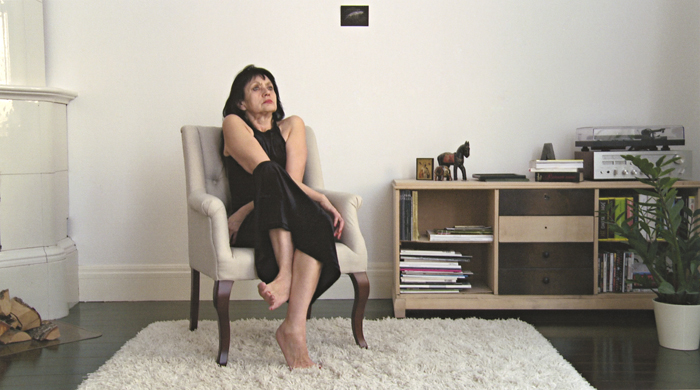
Aino-Marjatta Mäki ja työryhmä / Aino-Marjatta Mäki and working group:
YHDEKSÄN ETÄISYYTTÄ / NINE DISTANCES
[FIN] Tanssijat / Dancers: Helena Ratinen, Ken Mai, Leena Ritva Koskinen, Minja Mertanen, Mirva Mattila, Reija Stenius, Saara Holmberg, Sanni Priha ja Terhi Lilja
Yhdeksän etäisyyttä on teos masennuksesta. Teoksessa yhdeksän tanssijaa toisintaa yhdeksän masennuksen läpi käyneen henkilön elekieltä. Jokainen tanssija työskentelee yhden henkilön liikekielen kautta.
"Keväästä 2011 kevääseen 2012 työskentelin projektin parissa, joka toi yhteen ryhmän masennuksen kanssa eläviä ihmisiä. Keskustelimme toistuvasti kahdeksan ihmisen kanssa masennuksen kokemuksesta. Videoimme jokaisen henkilön kanssa yhden keskusteluistamme. Teoksessa tanssijat jäljittelevät videoiduissa haastatteluissa käytettyä elekieltä. Videot on kuvattu helsinkiläisissä kodeissa."
Yhdeksän etäisyyttä käsittelee masennusta subjektiivisten kokemusten kautta, kiinnittymättä vain kliiniseen määritelmään masennuksesta sairautena. Teoksen kontekstissa masennus on fragmentaarinen ja pysyviä merkityksiä pakeneva paikaton kärsimys. Se on aina jossain välissä. Masennuksen kokeminen on yhteisöllistä, aktiivista, kehollista sekä ennen kaikkea poliittista.
[ENG]Nine distances is a work about depression. In the work nine dancers re-enact gestures of nine people who have gone through depression. Each dancer works with the body language of one person.
"From the spring 2011 to spring 2012 I worked with the project which brought together a group of people who were living with depression. With eight people we repeatedly discussed about the experience of depression. With each participant we recorded one of the discussions on video. The dancers imitate gestures used in the recorded interviews. The videos have been shot in home environments in Helsinki."
Nine distances deals with depression through subjective experiences without trying to connect it only to the clinical definition of depression as a disease. Within the context of the work depression appears as fragmentary and placeless suffering which constantly escapes permanent meaning. It is always somewhere in between. Experiencing depression is communal, active, embodied and especially political.
TOP / YLÖS
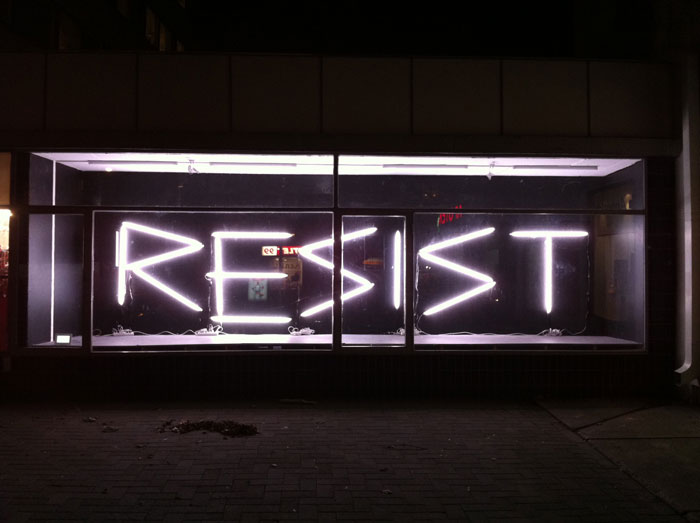
JON IRIGOYEN:
RESIST
Where there is power, there is resistance.
"The History of Sexuality". Michel Foucault
Only those capable of embodying utopia will be fit for the final battle,
to take back all the humanity we have lost.
"The Resistance". Ernesto Sabato
[FIN]
"Sanalla resistanssi on monia merkityksiä. Fysiikassa ja kemiassa tai aktivismissa ja taiteessa se helpottaa selittämään todellisuutta, joka sekä syleilee että hylkii Tämänhetkisen, fasististen ja neoliberaalien liikeiden sekä oikeuksien menettämisen värittämän globaalin kriisin aikana tästä sanasta tulee poliittinen voima. Resistanssi, kestävänä ja perustavanlaatuisena ihmisyyden piirteenä, on juuri nyt olennaista kohdatessamme aktuaalisen globaalin kriisin ja sen katastrofaaliset poliittiset ja sosiaaliset seuraukset. Installaatio Alkovissa on ilmaus tästä nykytilanteesta." Teksti: Irigoyen
Jon Irigoyen (s. Bilbaossa, Espanjassa) on itsenäinen kuraattori, taiteilija, ja kulttuuri-agitaattori, joka työskentelee tällä hetkellä Helsingissä. Hänen tutkimuksellinet kiinnostuksen kohteensa ja projektinsa laajentavat taiteilijaa ja katsojaa läpileikkaavia suhteita; yhteistyötä julkisen sekä kaupunkitilan välillä; todelllisuuden havainnointia kuin myös autonomian, vastustamisen ja muistin konsepteja.
[ENG]"Resistance has multiple meanings. Used in Physics and Chemistry or Activism and Art, it helps to explain a reality that both embraces and rejects. During the current global crisis, characterized by fascist and neoliberal movements and loss of rights, this word becomes a political force. Resistance, as a persevering and fundamental characteristic of the human spirit, is now more than ever essential to confronting our actual global crisis and its catastrophic political and social consequences. The light installation in Alkovi is an expression of the present situation." Text by: Irigoyen
Jon Irigoyen is an independent curator, artist and cultural agitator born in Bilbao, Spain, and currently based in Helsinki. His research interests and projects span the intersecting relationships between artist and spectator; the interaction between public and urban space; the perception of reality; as well as concepts such as autonomy, resistance and memory.
TOP / YLÖS
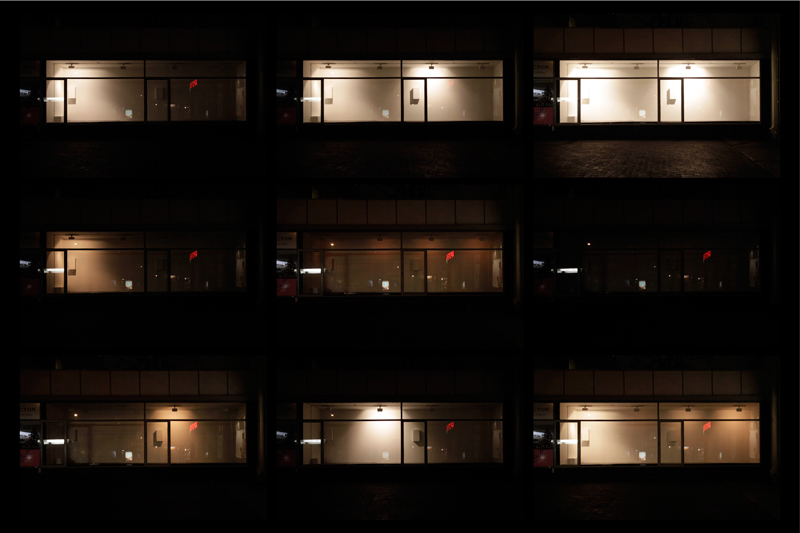
TANELI RAUTIAINEN:
N°8
[FIN]Taneli Rautiaisen teos n°8 oli "kaupunkisinfonia marraskuisen Helsingin pimeille ja autioille kaduille". Teos oli yhtäaikaisesti esillä galleria Alkovissa sekä Oksasenkatu 11 galleriassa 6.11. ja 24.11.2013 välisenä aikana.
Taneli Rautiainen (1983) on Kuvataideakatemiasta valmistunut kuvanveistäjä, joka käyttää materiaaleinaan tilaa, valoa ja ääntä. Hänen teoksiaan on nähty muun muassa yksityisnäyttelyissä Galleria Anhavan projektitilassa, Kluuvin galleriassa ja Amos Andersonin taidemuseossa sekä yhteisnäyttelyissä Mäntän kuvataideviikoilla, Rovaniemen taidemuseossa ja Nuoret 2009-näyttelyssä Taidehallissa. Rautiaisen teoksia on hankittu Valtion taidekokoelmiin sekä Amos Andersonin museon, Rovaniemen taidemuseon (Wihuri), EMMAn (Saastamoisen säätiö) ja Porin taidemuseon kokoelmiin.
[ENG] Artwork NO°8 by Taneli Rautiainen was "a city symphony for the dark and empty streets of Helsinki in November". The work was simultaneously presented in gallery Alkovi and gallery Oksasenkatu11 from 6 to 24 November 2013.
Taneli Rautiainen (1983) is a sculptor graduated from the Finnish Academy of Fine Arts who uses space, light and sound as his materials. His works have been seen in solo shows in Gallery Anhava project space, Kluuvi gallery and Amos Anderson Art Museum as well as in group exhibitions in Mänttä Art Festival, Rovaniemi Art Museum and Young Artists 2009 show in Kunsthalle Helsinki, to name few. Rautiainen's works are presented in the State Art Collection as well as in the collections of Amos Anderson Art Museum, Rovaniemi Art Museum, EMMA and Pori Art Museum.
TOP / YLÖS
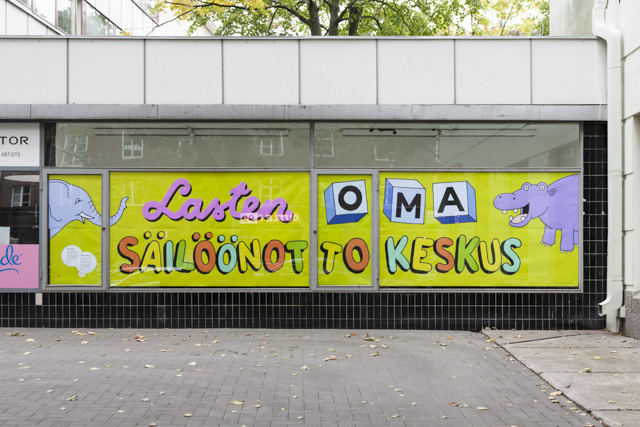
OTTO KARVONEN:
"SIIS HÄH?"/ WHAT THE...?"
[FIN] Otto Karvonen valmisti Alkovin ikkunaan värikkään graafisen installaation, joka liittyi ajankohtaiseen keskusteluun Suomeen saapuvien lasten säilöönotosta.
Taustaa:
Suomessa laitetaan lapsia vankilaan. Ulkomaalaislaki sallii ulkomaalaisen - myös lapsen - säilöön ottamisen esimerkiksi henkilöllisyyden selvittämiseksi tai maasta poistamisen turvaamiseksi. Säilöönottokeskukseen, joka on käytännössä vankila, voi siis joutua vaikkei olisi syyllistynyt mihinkään rikokseen.
Vuonna 2012 Suomessa otettiin säilöön 26 lasta, joista neljä oli saapunut maahan yksin. YK:n lapsen oikeuksien komitea on todennut, että lasten säilöönotto loukkaa lasten ihmisoikeuksia ja että kaikkien valtioiden tulisi siksi luopua käytännöstä.
Suomen hallitus lupasi vuonna 2011 kieltää yksin maahan tulleiden lasten säilöönoton ja kehittää säilölle vaihtoehtoja. Lupaus kirjattiin hallitusohjelmaan, mutta se on edelleen lunastamatta: vaihtoehtoja ei ole kehitetty eikä lasten säilöönottoa ole vieläkään kielletty.
Lähteet:
Amnesty International, Sisäasiainministeriö
Otto Karvonen on helsinkiläinen kuvataiteilija, joka on työssään erikoistunut julkiseen tilaan sijoittuviin tilapäisiin veistoksiin, installaatioihin ja performansseihin. Hänen teoksensa ovat tilannesidonnaisia; ne syntyvät tiiviissä vuorovaikutussuhteessa ympäristöönsä, hyödyntäen sen tilallisia ja ajallisia ulottuvuuksia.
Karvonen tunnetaan mm. pienimuotoisista, humoristisista ja ironisista interventioista, jotka hämmentävät ja sekoittavat käsitystämme arkitodellisuudesta. Hänen teoksensa kommentoivat usein ajankohtaisia poliittisia, taloudellisia, sosiaalisia ja uskonnollisia aiheita, julistavuutta ja alleviivaavuutta kuitenkin hienovaraisesti vältellen.
Karvonen on opiskellut Helsingissä Taideteollisessa korkeakoulussa sekä Amsterdamissa Sandberg Instituutissa. Hänen teoksiaan on ollut esillä lukuisissa kotimaisissa sekä kansainvälisissä näyttelyissä ja instituutioissa: Kiasma, de Appel Amsterdam, Copenhagen Art Festival 2012, Liverpool Biennial 2008, Göteborg Biennale 2007 ja Singapore Biennale 2006.
[ENG] Otto Karvonen covered the windows of Gallery Alkovi with a colourful graphic installation. The work related to a recent discussion about detention of child immigrants arriving in Finland.
Background:
The Finnish state puts children behind bars. The aliens act allows the detention of foreigners, adults and infants equally, in order to identify them or secure their expulsion process. Even if you have not committed a crime of any kind you may end up in a detention centre which is practically a prison.
Last year 26 children were detained, of whom four had arrived in the country alone. The United Nations Committee on the Rights of the Child has stated that the detention of children is a violation against human rights and that every country should abandon the policy.
In 2011 the Finnish government promised to prohibit the detention of child immigrants arriving alone and develop alternatives to detention. The promise was registered in the Government Program, yet nothing has been done so far. The detention of children has not been prohibited and no alternatives to detention have been developed.
Sources:
Amnesty International, Ministry of the Interior
Otto Karvonen is a visual artist based in Helsinki, Finland. He is specialized in temporary installations, performances and sculptures in public spaces. His works can be described as situation-specific: they are developed in close interaction with their surroundings, taking into account their spatial and temporal dimensions. Karvonen has gained a reputation for modest, humorous and ironic interventions that mix and confuse our perception of everyday reality. His works often comment on urgent political, economic, social and religious topics, carefully avoiding obvious or forced statements.
Karvonen has studied in the University of Art and Design Helsinki and Sandberg Institute in Amsterdam. His works have been shown for example in following exhibitions and venues: Kiasma Helsinki, de Appel Amsterdam, Copenhagen Art Festival 2012, Liverpool Biennial 2008, Gothenburg Biennial 2007 and Singapore Biennial 2006.
TOP / YLÖS
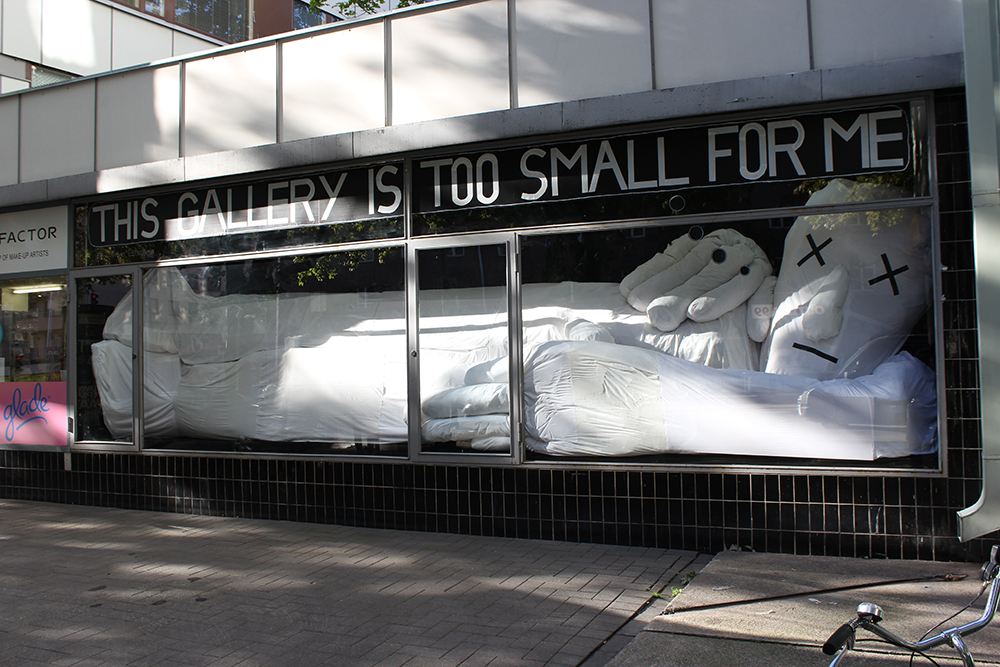
ANNA ESTARRIOLA:
"This gallery is too small for me"
"But I am happy to be exhibited."
"I am interested in intuitively envisaged exchanges and interactions between the visual and media arts and other disciplines, such as performing arts and technology. The themes of my work revolve around perception of reality, emotions, individual and communal behavior, and communication. I am fascinated and disturbed by human beings, and mesmerized and puzzled by moving images, moving bodies and moving objects. I work with cross-disciplinary narrative structures that explore and question the union of content, medium and context.
Over the last years I have created media installation works combining sculptures and moving image with dance, dramaturgy, mechanics and electronics. I have also been directing dance pieces, performances and short film projects. Further I have worked in several internationally touring theatre and dance productions as a video artist and performed as a dancer for other choreographers." Text by Anna Estarriola.
[FIN] Anna Estarriola asetti näytteille suuren pehmeän lelumaisen veistoksen joka puristautui ikkunagallerian sisälle. Video-puhekupla päivitti hahmon ajatuksia esillä olemisesta. Installoitu asetelma viittasi taiteilijan identifikaation teoksensa kanssa sekä paikka-sidoinnaisiin esitysolosuhteisiin Alkovissa.
Estarriola syntyi Kataloniassa (Espanja), mutta on asunut ja työskennellyt Helsingissä vuodesta 2004. Hänellä on Kuvataiteen maisterin tutkinto sekä Kuvanveiston osastolta Barcelonan yliopistosta (2004), että Kuvataideakatemiasta Tila-aika taiteiden laitokselta (2009). Tämän lisäksi hän on tehnyt opintoja nykytanssista Barcelonassa sekä Helsingissä.
[ENG]Anna Estarriola exhibited a large soft toy-like sculpture, squeezed inside the window gallery. A videoed 'speech-bubble' updated the character's thoughts about being displayed. The installed scene refered to the artist's identification with her work, and to the site-specific exhibiting conditions in Alkovi.
Estarriola was born in Catalonia (Spain), but has lived and worked in Helsinki since 2004. She has a Master of Fine Arts degrees from both the University of Barcelona, sculpture department (2004) and the Finnish Academy of Fine Arts, Time and Space department (2009). In addition, she has done some studies on contemporary dance in Barcelona and Helsinki.
TOP / YLÖS
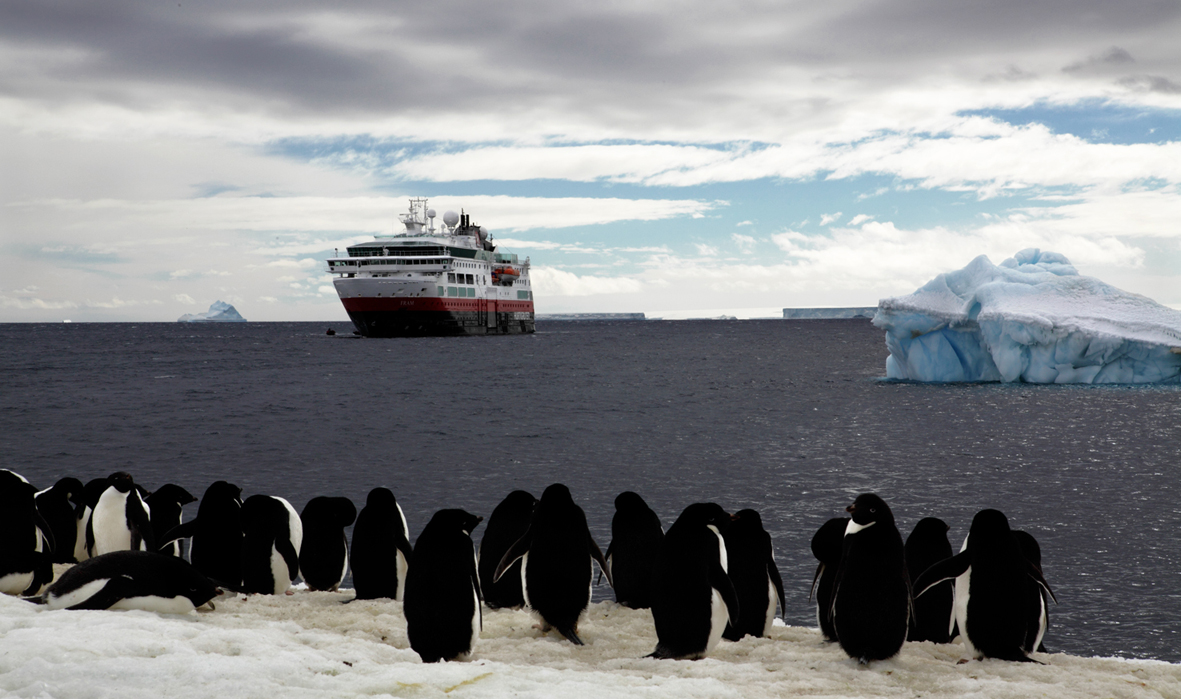
PEKKA NISKANEN:
South by Southeast
[FIN] "Matkustin Etelämantereelle norjalaisella Fram-aluksella, jolla oli filippiiniläinen alipäällystö. Teoksessani tiedemies, Markku T Kurkinen, ja laivan matruusi Protacio Mabunga ystävystyvät matkalla Antarktiksen niemimaahan. Pyörätuolilla liikkuva Kurkinen halusi nähdä pingviinit ja Etelämantereen. Mabunga joutui Antarktikselle elättääkseen perheensä. Miehet unohtavat aluksen kirjoittamattoman säännön, jonka mukaan laivan alipäällystön tulisi pitää kunnioittavaa etäisyyttä matkustajiin.
Filippiinien haasteena on länsimaiden uuskolonialismi, jonka seurauksena kaakkoisaasialaisista on tullut haluttua halpatyövoimaa myös risteilyaluksille, eikä turismi Etelämantereelle olisi mahdollista ilman risteilyaluksilla työskenteleviä aasialaisia siirtotyöläisiä. Kaakkoisaasiasta lennätetyt työntekijät asuvat Etelämantereelle kulkevalla laivalla lähes puolet vuodesta. He kutsuivat Antarktista tyhjyydeksi, paikaksi "ei missään".
Videoinstallaation musiikin on tehnyt Burmassa tapaamani äänitaitelija Tay Wai Aye Chan. Äänisuunnittelun on toteuttanut Juuso Oksala.
Kiitos: AVEK / Elena Näsänen, Taiteen edistämiskeskus, Uudenmaan taidetoimikunta."Teksti: Niskanen
[ENG]"I traveled to Antarctica with the Norwegian cruise vessel Fram that had Philippine petty officers. In my work the scientist Markku T. Kurkinen and the ship's sailor Protacio Mabunga become friends during the trip to the Antarctic Peninsula. Kurkinen, who uses a wheelchair, wanted to see the penguins and the Antarctic. Mabunga had ended up on Antarctica in order to provide for his family. The men set aside the unwritten rule, according to which the ships petty officers are to keep a respectful distance to the passengers.
Western neo-colonialism presents a challenge for the Philippines. As its consequence, South-East Asians have become cheap and sought after labor also for cruise ships. Tourism to the Antarctic would not even be possible without Asian migrant workers on the cruise ships. The workers, flown in from South East Asia, live almost half of the year on board the ships. They call Antarctica the emptiness, the "nowhere" place.
The music in the video installation is made by the sound artist Tay Wai Aye Chan. Sound design by Juuso Oksala." Text by: Niskanen
TOP / YLÖS

SARI PALOSAARI & THOMAS WESTPHAL:
ENCORE
[FIN]"Encore juhlistaa tilannetta, jossa katsoja, teos ja paikka kohtaavat. Se pokkaa edessään näkyvälle, ohikulkijoille ja yleisölleen - kirjaimellisesti."
Sari Palosaari työskentelee arkkitehtuuristen rakennelmien, veistosten ja videoiden parissa. Thomas Westphalin teokset käsittelevät pelejä ja leikkejä sosiaalisina ilmiöinä kineettisten installaatioiden ja videoiden kautta. Alkovin näyttely on pariskunnan yhteistuotanto.
[ENG]Encore celebrates the situation that takes place between the viewer, the work and the place. It bows towards what is in front of it, to passers-by and to spectators - literally."
Sari Palosaari works with architectural constructions, sculptures and videos. Thomas Westphal's works deal with the social phenomenas of play and sports through kinetic installations and videos. The exhibition in Alkovi is a joined effort from the couple.
TOP / YLÖS
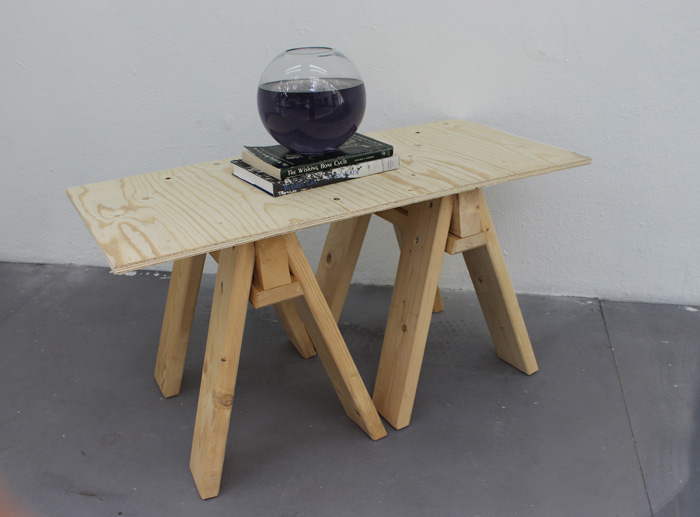
HAPPY MAGIC SOCIETY
presents Ghost trap
Life forms a surface that acts as if it could not be otherwise, but under its skin things are pounding and pulsing.*
Materials: Styrofoam box, aluminium tape, electricity, soil, magnet, metal, orgasms, telepathy, wood, distance, apple seeds, unidentified organic materials, glass bowl, water from botanic garden, Wishing Bone Cycle -book, Robert Lax -book, steel wool, plywood, energy, obsidians, pink quartz.
Happy Magic Society was founded in 2009 in the forest of Jyderup. The collective executes actions and events, which often are spontaneous, unannounced and private. All the actions are site-specific and aim for magic, happiness and liberation. Since foundation Happy Magic Society has presented events, manifactured objects and organized guerilla screenings in Jyderup, Seoul, Frankfurt, Den Haag, Lund and in Nordkapp.
* Robert Musil (The Man Without Qualities Vol. 1: A Sort of Introduction and Pseudo Reality Prevails).
TOP / YLÖS

RIIKKA ARESALO:
MISSÄ RUOHO ON VIHREÄMPÄÄ / WHERE THE GRASS IS GREENER
[FIN]"Ihminen ostaa tavaraa, palveluita, autoja ja asuntoja. Ihminen on asiakas, on aina oikeassa ja tuntee näin osallisuutta maailmanmenoon valintojensa ja tekojensa kautta. Ihminen on mukana ja olemassa. Ihminen on oppinut: koska olen sen arvoinen.
Kun ihmisellä on tänään kaikki, mitä hän eilen halusi, huomenna se ei enää riitä. Jossain on aina jotain parempaa, uudempaa ja kauniimpaa - enemmän.
Mikään ei riitä. Kenellekään. Ruoho näyttää vihreämmältä aidan toisella puolen. Vihreä vihertyy aita aidan jälkeen ja aidat eivät lopu koskaan." Teksti: Aresalo
Riikka Aresalo on helsinkiläinen kuvataiteilija ja valmistunut Taideteollisesta korkeakoulusta Ympäristötaiteen maisteriohjelmasta 2012. Uusimmissa teoksissaan Aresalo on tutkinut ihmisen, rahan ja kaupungin välisiä suhteita. Teokset ovat olleet esillä pääosin kaupunkitilassa.
[ENG]In her exhibition Riikka Aresalo describes a human being as a customer - a consumer who buys things. She asks what is enough, what is sufficient. When we have everything, the things we wanted yesterday is too little by tomorrow. "The grass is always greener on the other side of the fence. The green gets greener after each fence and the fences never end."
Riikka Aresalo is a Helsinki-based visual artist graduated from the Department of Environmental Art in The Helsinki University of Art and Design in 2012. In her most recent works she has been dealing with the relationships between people, money and the city. The artworks have been mostly presented in the urban space.
TOP / YLÖS

TATU ENGESTRÖM:
DISPLAY
[FIN]Display oli rekonstruktio Helsingin Vallilassa sijaitsevan asunnon esine-sommitelmista. Näyttelytilassa olivat asunnon alkuperäiset esineet asunnossa sijaitsevilla paikoillaan. Osana teosta oli valokuva-triptyykki, joka koostui kolmesta valolaatikosta. Kuvat oli otettu asunnosta ennen esineiden siirtämistä. Näyttelyn päätyttyä esineet palautettiin takaisin asuntoon tarkasti merkityille paikoilleen.
Tatu Engeström (s.1984) on Helsinkiläinen kuvataiteilija, joka viimeistelee maisterintutkintoa Kuvataideakatemiaan. Engeström on ollut mukana näyttelyissä Suomessa ja ulkomailla vuodesta 2006 lähtien. Viimeisin näyttely oli yksityisnäyttely The Space in Between Kuvatai- deakatemian galleriassa keväällä 2012. Engeströmin taiteellinen tuotanto vaihtelee julkisessa tilassa tapahtuvista interventioista gallerioissa ja museoissa esitettäviin installointeihin. Konteksti jossa lopullinen teos esitetään on olennainen osa Engeströmin taidetta. Julkisen ja yksity- isen tilan hämärtyvä raja alue on teoksissa aina läsnä.
[ENG] Display was a reconstruction of object arrangements from an apartment locating in Vallila Helsinki. The reconstruction showed the original objects displayed in the exact same positions as they were in the apartment. The exhibition included a photography triptych with three light boxes showing the apartment before the objects were removed. After the exhibition the objects were returned to their exact marked locations in the apartment.
Tatu Engeström (born 1984) is a visual artist based in Helsinki, who is currently finishing his MFA in the Academy of Fine Arts. He has exhib- ited in Finland and abroad since 2006, his latest exhibition being a solo show "The Space in Between" in the gallery of the Academy of Fine Arts in the spring 2012. The artistic production on Engeström's work varies from interventions in public spaces to installations presented in galler- ies and museums. Context in which the final work is presented is an essential part of Engeström's practice. The diffusing line between public and private space is constantly present in his works.
TOP / YLÖS
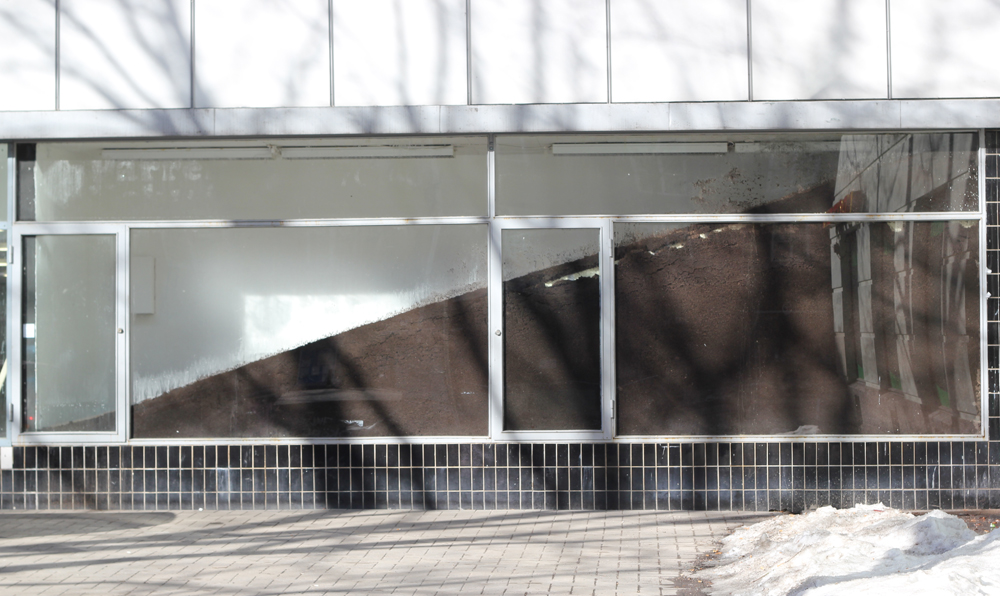
SAARA-MARIA KARIRANTA & PEKKA NIITTYVIRTA:
LANDSLIDE VICTORY / MAANVYÖRYMÄVOITTO
[FIN] "Syntyvätkö yhteiskunnalliset päätökset samankaltaisesti kuin luonnonmullistukset, vääjäämättöminä? Asioina, joihin yksittäiset poliitikot/ kansalaiset eivät voi vaikuttaa."
Näyttelytila täytettiin puoliksi mullalla. Multavyörymä kulki näyteikkunan poikki katonrajasta lattiaan. Päivällä teos oli multakasauma sisätilassa. Tila syttyi illan pimetessä loistamaan kilpaa ympäristön mainosvalojen kanssa.
Saara-Maria Kariranta (s.1974) on Helsinkiläinen kuvanveistäjä. Hän on valmistunut Taiteen Maisteriksi Kuvataideakatemiasta 2012.
Pekka Niittyvirta (s.1974) on Helsinkiläinen valokuvataiteilija. Hän on valmistunut Taideteollisesta korkeakoulusta Valokuvataiteen osastolta 2007.
[ENG] Are societal decisions born in a similar manner to natural catastrophes - inevitable? As concepts that are unreachable to individual politicians/citizens.
The exhibition space was filled half with soil. The landslide went through the window from the corner of the cealing to the floor. During daytime the artwork was a pile of soil inside the space. When dark, the space light up to shine in competition with the surrounding commercial neon lights.
Saara-Maria Kariranta (s.1974) is a Helsinki-based sculptor. She craduated from the Finnish Academy of Fine Arts in 2012.
Pekka Niittyvirta (s.1974) is a Helsinki-based photographer. He craduated from the Photography departement of the Helsinki School of Art and Design in 2007.
Näyttelyä tuki Uudenmaan taidetoimikunta. / The exhibition was supported by the Uusimaa Arts Council.
TOP / YLÖS
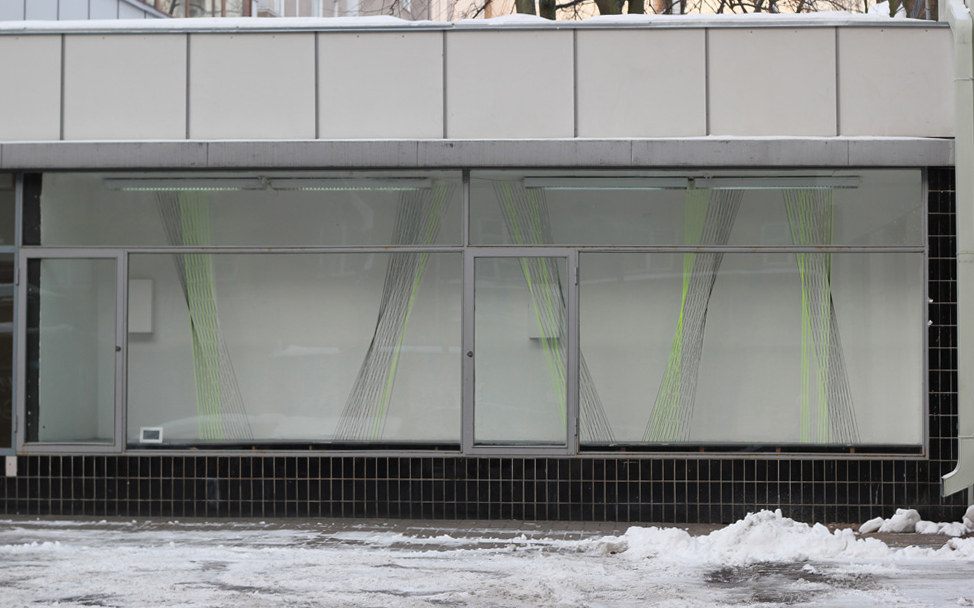
WONA CHO
[FIN] Korealaislähtöinen taiteilija Wona Cho valmisti Alkoviin pingotetuista valkoisista, mustista ja keltaisista langoista koostuvan installaation. Wona Chon teoksissa langat valtaavat ja määrittävät tilaa, synnyttävät muotoja ja luovat oman järjestyksensä. Cho on opskellut kuvataidetta Soulissa Etelä-Koreassa sekä Saksassa Munchenin taideakatemiassa, mistä hän valmistui vuonna 2011.
"Minun näkökulmastani hyvinvointiyhteiskunta on sulatusuuni, jossa kaikenlaiset eri näkemyksiä ja etnisiä taustoja omaavat ihmiset - jotka muodostavat yhteiskunnan - elävät yhdessä vieraantumatta toisistaan. Se sisältää paradokseja kuten harmonia-ristiriita, läheisyys-konflikti ja syleily-eristys.
Konseptit "harmonia", "sekaannus", ja "monimuotoisuus" ilmaistaan installaatiossani illuusion kautta. Narut, jotka yhdistävät katon ja lattian, ovat sijoitettu geometristä objektia seuraavan johdonmukaisuuden kautta. Mustan, valkoisen ja keltaisen värin kautta kontrastoidut narut tekevät sekalaisen tai yksinkertaisen illusorisen muodostelman lähenemisensä ja hajaantumisensa kautta.
Nämä naru-installaatiot käsittelevät paradoksaaleja konsepteja kuten "todellisuus-illuusio", "materiaalinen-
immateriaalinen" ja "järjestys-epäjärjestys". Todellinen fyysinen tila (eli installaatio) koostuen naruista on yhdenmukainen epätodellisen fiktiivisen tilan kanssa, joka nousee "illuusiosta" johtuen narujen leikkaamisesta keskenään. Sen lisäksi nämä langat installoituna yksinkertaiseen järjestykseen esittävät loppujen lopuksi monimuotoisen muodon antaen tilaa järjestykselle ja kuviolle kuin myös jakamiselle ja sekaannukselle." Teksti: Wona Cho
[ENG]Korean artist Wona Cho build to Alkovi an installation consisting of black, white and yellow strings. In Wona Cho's art the strings occupy and determine space, develope forms and create their own order. Cho has studied art in Soul, South Korea and in Germany in the Munich Art Academy where she graduated from in 2011.
"From my perspective the welfare society is a melting pot in which all the class of people having different ideas and ethnic background who constitute the society live all together without alienation. In it, there are paradoxes such as harmony-contradiction, embrace-conflict, and connection-isolation.
The concepts of 'harmony', 'confusion', and 'diversity' are expressed in my installation via illusion. The strings connecting ceiling to floor are aligned with a specific rule following a geometric object. The strings contrasted with black, white, and yellow colors make fussy or simple illusive conformation by their convergence and dispersion.
These string installations encompass paradoxical concepts such as 'reality-illusion', 'material-immaterial' and 'order-disorder'. A real physical space (i.e. installation) consisting of strings is in line with an unreal fictitious space that arises from 'illusion' due to the intersection of the strings. Furthermore, these strings installed in a simple order eventually exhibit a complex form, giving rise to order and pattern as well as division and confusion."
TOP / YLÖS

TANJA KIIVERI
[FIN] Tanja Kiiverin ikkunainterventio. Koponen tunnetaan käsitteellisistä paikka- ja tilannesidonnaisista teoksistaan, joissa objektit, kuvat ja videot muodostavat omaa olemustaan ja sitä kautta ympäröivää maailmaa kyseenalaistavia ja analysoivia tilanteita.
[ENG] An intervention in the gallery window by a visual artist Tanja Kiiveri. Kiiveri is known for her site- and situation specific artworks where the objects, images and videos - through the questioning and analysing of their being - create situations that place the surrounding world under inspection.
TOP / YLÖS

Jenni Lahtinen ja Liina Mäki-Patola:
I SEE FOUNTAINS
[FIN]I See Fountains oli kuvataiteilija Jenni Lahtisen (s.1984) ja Liina Mäki-Patolan (s.1985) yhteinen installaatio. Teoksen lähtökohtana on ollut veden äärellä koettu visuaalinen elämys.
"Näyttelyprojektimme sai alkunsa viime keväänä Portugalissa, jossa kuvasimme suihkulähteitä vehreissä puutarhoissa. Nyt rakennamme galleriaan oman putouksemme, joka tuo valoa ja värejä keskelle talven pimeintä aikaa."
Lahtinen ja Mäki-Patola ovat valmistuneet kuvataiteilijoiksi Tampereen Ammattikorkeakoulusta ja ovat aiemmin tehneet yhteistyönä mm. taiteilijakirjan X, joka julkaistiin syksyllä 2012.
[ENG]I See Fountains was an installation realized by visual artists Jenni Lahtinen and Liina Mäki-Patola. The starting point of the work was the experience of water: light, transparency and movement.
"Last spring in Portugal we were photographing fountains in green gardens. Now we are building our own fountain in the gallery, a fountain that will bring colour to the dark winter."
Lahtinen and Mäki-Patola have gratuated from Tampere University of Applied Sciences and have published the artist's book "X" together in 2012.
TOP / YLÖS
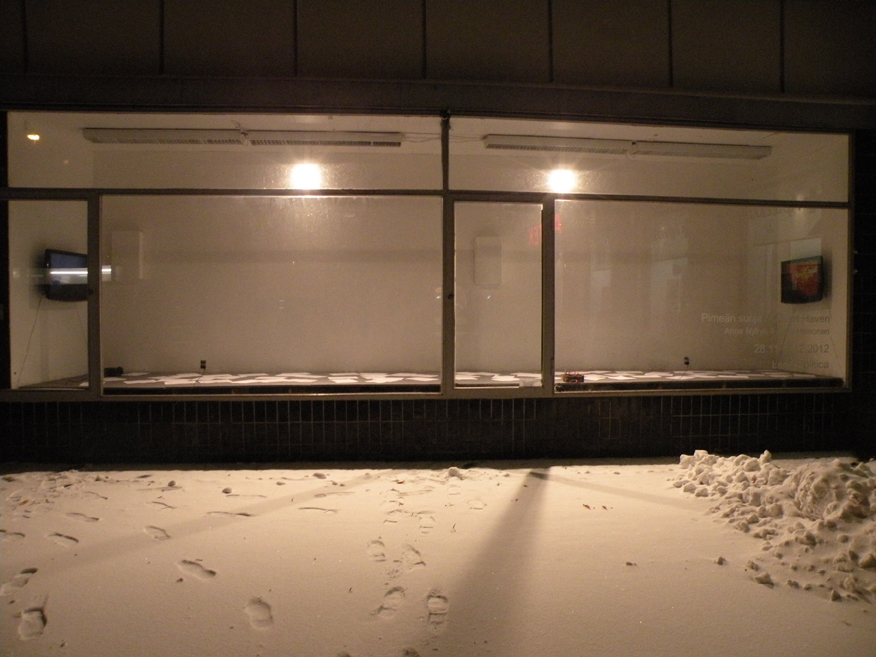
Anna Nykyri & Timo Heinonen:
PIMEÄN SUOJA / COVERT HAVEN
[FIN] Kuvataiteilija ja elokuvaohjaaja Anna Nykyrin (1981, TaM) ja äänitaiteilija/esitysdramaturgi Timo Heinosen (1967, FM) video- ja ääni-installaatio "Pimeän suoja" käsitteli arkisia pelkojamme. Mitä ihmiset pelkäävät Suomen kaltaisessa hyvinvointiyhteiskunnassa? Terrorismia? Väkivaltaa? Vieraiden kulttuurien edustajia? Pimeyttä? Yksinäisyyttä? Sairautta? Korkeita paikkoja? Taiteilijat pyrkivät näyttämään, kuinka erilaisia ja silti samankaltaisia samassa yhteisössä elävien ihmisten pelot ovat ja kuinka ne kytkeytyvät politiikkaan, kätkettyihin vallan jäsentymiin sekä kontrollin rakenteisiin. Pelko on luonteeltaan paradoksaalista - yhdelle ihmiselle pelkoa tuottava asia tuottaa toiselle turvallisuuden tunteen. Pelolla on myös yhteys eläimellisiin vaistoihimme, atavistisiin kerroksiimme. Teos kysyy pelon mieltä: Missä kulkee fobian ja pelon raja? Onko olemassa rationaalisen pelon käsitettä? Onko syytä pelätä?
Teoksen valosuunnittelun toteutti suomalaisen teatterin ja tanssin kentällä tunnettu, "Valo-Säde 2011" -palkittukin valosuunnittelija Heikki Paasonen. Teoksessa käytetty liikkuvan kuvan arkistomateriaali on Johannes Malmin kuvaamaa riistakameran kuvaa Kokemäen metsistä sekä NASA:n tekijänoikeusvapaata kuvamateriaalia.
Anna Nykyri (KuM, s.1981) työskentelee kuvataiteilijana ja ohjaajana liikkuvan kuvan parissa teatterin, elokuvan, kuvataiteen ja television alueilla. Nykyri käyttää filmiä ja arkistomateriaalia luodakseen dokumentaarisia elokuvia ja elokuvallisia videoinstallaatioita. Nykyrin teosten teemat ovat usein poliittisia, kuten ovat vallan ja kontrollin kysymykset, propagandan rakenteet ja piilotettu väkivalta. Teokset sisältävät tanssin kaltaisia ominaisuuksia: taiteilija pyrkii rakentamaan elokuvat niin, että ne vaikuttavat kuvien tanssilta, koreografin kädenjäljeltä. Hän on kiinnostunut myös filmin maalauksellisista ominaisuuksista, elokuvasta tilallisena maalauksena. Nykyrin töitä on esitetty museoissa, gallerioissa ja elokuvafestivaaleilla Suomessa ja kansainvälisesti. Vuonna 2012 Nykyrin ohjaus "Viisi fragmenttia empatian luonteesta" voitti parhaan dokumentaarisen lyhytelokuvan palkinnon arvostetulla Hot Docs -elokuvafestivaalilla Torontossa, Kanadassa.
Timo Heinonen (TaM, s.) on kirjoittaja/esitysdramaturgi, äänitaiteilija ja esitysteoreetikko. Hän työskentelee teksti- ja äänitilojen parissa teatteri-, esitys- ja äänitaiteen saralla. Kysymykset ihmisestä, teknologiasta, valtarakenteista, yhteisöstä, ympäristöstä sekä estetiikan ja etiikan lähtökohdista ja esityksen ehdoista ovat Heinosen toistuvia teemoja. Hän on työskennellyt mm. teatterin, esitystaiteen, graafisen suunnittelun ja television kentällä. Heinonen on julkaissut, opettanut ja luennoinut useissa korkeakouluissa ja yliopistoissa Suomessa (mm. Helsingin yliopisto, Taideteollinen korkeakoulu, Teatterikorkeakoulu) ja ulkomailla. Heinoselta on vastikään ilmestynyt dramaturgian, filosofian ja antiikin tutkimuksen alan yliopistollinen oppikirja Aristoteleen Runousoppi (yhdessä työryhmän kanssa, Kustannusosakeyhtiö Teos).
[ENG] The video & sound installation "Covert Haven" by visual artist and film director Anna Nykyri (b.1981, MFA) and sound artist/dramaturge Timo Heinonen (b. 1967, MA) shed light on our daily fears. What are people afraid of in a welfare society like Finland? Terrorism? Violent attacks? People from different cultures? Darkness? Loneliness? Sickness? High places? The aim of the artists is to show how different and yet similar the fears of different people in the same community are and how they relate to politics, illusion of power and to the intrinsic limits of control. Fear is paradoxical - the thing another person is afraid of, another feels safe around with. It also reflects our animal instincts. Several crucial questions arise: Where is the border line between a phobia and fear? Is there a concept of rational fear? Is it necessary to be afraid?
The light design of the piece was by a light designer Heikki Paasonen, who is well-known in the fields of Finnish theatre and dance and also won a recognized "Säde Prize 2011". The found footage in moving image was shot by Johannes Malmi with a trail camera in Kokemäki woods and also videomaterial free of copyrights by NASA.
Anna Nykyri (b.1981) is a visual artist and a film director. She works with moving images in the fields of film industry, theatre, visual arts and television. She uses film and archive material to create documentary films and cinematic video installations. The themes of her works are often political, covering questions of power and control, the structures of propaganda qualities: her intention is to construct the films in a way that they give the appearance of a dance of images, the handiwork of a choreographer. She is also interested in the pictorial properties of film - the film as a spatial painting. Nykyri's artistic works have been screened in various film festivals, museums and galleries in Finland and abroad. 2012 Nykyri's short film "Five Fragments of the Extinct Empathy" won the best short documentary award at Hot Docs, Canadian International Documentary festival.
Timo Heinonen is a writer/dramaturge, a sound artist and a performance theoretician. He works with text and soundscapes in the fields of theatre, performance, and sound art. The themes of his works are often politico-philosophical like questions about human, technology, society, environment and political control. He intentionally mixes elusive language with sounds and images in order to deconstruct and examine the aesthetic and ethical conventions and conditions of the used medium. Heinonen has been working in the fields of theatre, television, radio, graphic design as well as contributing to independent arts projects. He has also published a lot in his field and been lecturing for example at the University of Helsinki, University of Art and Design and Theatre Academy.
TOP / YLÖS
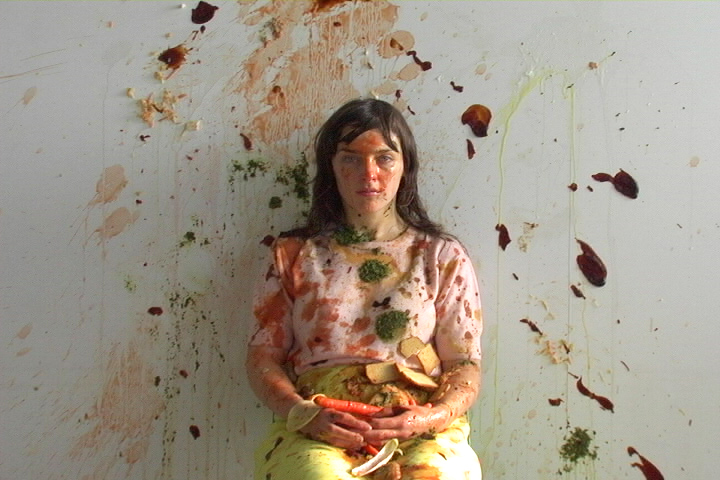
CREATE, OBSERVE, PERFORM
[FIN] Cardifflaiset kuvataiteilija/kuraattorit Dawn Woolley ja James Moore kokosivat Alkoviin kansainvälisen videoesityksen tuoden esiin videontekemisen laajan skaalan mm. animaatiosta dokumentaariseen ja performatiiviseen liikkuvaan kuvaan. Jotkut taiteilijoista valokoituivat ohjelmaan avoimen haun kautta, toiset ovat työskennelleet kuraattorien kanssa aiemmissa hankkeissa ja jotkut valikoituivat Outcasting-liikkuvan kuvan verkkogallerian kautta.
[ENG]Create, Observe, Perform forms curated by Cardiff based artists Dawn Woolley and James Moore was shown in Alkovi from 27th October to 4th November 2012. The programme didn't have theme or central idea but brought together a wealth of artistic approaches to video art. From animation and construction to documentary and performance the artists explored the creative potential of moving image. Some of the artists featured in this programme have responded to an open call, others have worked with the curators on previous projects, further selections were made in collaboration with Outcasting (online moving image gallery).
TEOKSET / WORKS:Picture Frame 1
Emilie Collins, In Their Hands
30 mins, 4:3
Documentation of a performance where the audience feed the artist.
Picture Frame 2
Nina Mangalanayagam, Lacuna
11 min, 4:3
Video showing portrait shot with subtitles.
Monitor
Noemi McComber, Under Assault
9 min, 4:3
Performance of the artist being assaulted with food substances.
Screen 1
Adam Buick, Earth to Earth
16 min 10 sec, 16:9
Time-lapse landscape with clay pot.
Screen 2
Stefan Gant, Crossing the Line: Honesty
2 min 4:3
Diagramatic drawing with audio.
Erica Scourti, Trailer Truths
2 min 30sec, 4:3
Appropriated film trailer extracts.
Patricia Pinsker, Davey
3 min, 4:3
Video portrait of a man dressed in Native American clothes with Elvis Presley soundtrack.
Dawn Woolley, Interloper
1 min 11sec, 4:3
Video showing cut-out figure stood near mirror.
Annalisa Sonzogni, Wild: The Need to Leave the Cage of Love
5 min 30 sec, 4:3
Split screen film showing cityscapes and portraits.
Ted Sonnenschein, Coming Home
2 min, 4:3 format, No audio
Reflections filmed in a moving train widow.
James Moore, Levels
1 min 20sec, 16:9, No Audio
Animation of rolling camera shot through sequence of scenes.
Gwenn Joyaux, Volcan
3 min, 16:9
Video of disused factory.
Anton Hecht, One Note Band
2 min 45 sec, 4:3
Video of a band composed of one note samples, filmed in a church.
Jan Hakon Erichsen, Seek & Destroy
4 min 17sec, 16:9
Performance of hunt involving an easy chair.
Barry Andersson, Junk Yard
6min 20 sec.
Panorama
Sean Vicary, Re-Tolled ii
2 min 40 sec, 16:9
Poetic Animation
Peter Bobby, Curtain
5 min 12 sec
TOP / YLÖS

HEINI PARTANEN:
Taggeja!
[FIN]"Olen kuvannut seiniin, sähkökaappeihin, siltoihin ym. paikkoihin piirreltyjä tageja Kalliossa ja sitä ympäröivillä kaupunkialueilla Helsingissä kuten Pasilassa, Vallilassa, Hermannissa ja Kalasatamassa. Sitten olen ommellut niitä miesten puvuntakkeihin ottaen mallia tagattujen harmaiden sähkökaappien estetiikasta, sillä sähkökaapit vaikuttavat olevan hyvin suosittu tagausalusta. Tulos on luonnollisesti takin ja tagin yhdistelmä: Taggi!
Taggeihin olen rakentanut rungot kanaverkosta, jolloin ne poseeraavat Alkovi galleriassa vähän kuten mallinuket vaatekaupan näyteikkunassa.
Taggeihin ommeltuja tageja voi löytää paljon myös Alkovi gallerian lähistön seiniltä, joten näyteikkunamainen tila ja sijainti ovat mielenkiintoinen konteksti esittää valmistamani Taggit. Näyttelyssä sekoittuu ja yhdistyy kaksi erilaista näkyvää kaupunkikulttuurin osaa lähiympäristöstä: kaupallinen ja virallinen sekä lainsuojaton ja omaehtoinen. Taggien avulla pyrin myös lisäämään ihmisten tagitietoisuutta osana merkkitietoisuutta." Teksti: Partanen
[ENG]"I have photographed tags written on the walls, electric cabinets, bridges etc. in Kallio and surrounding areas in Helsinki. Then I have sewn them into suit coats inspired by the esthetics of the grey electric posts that seem to be very popular places to write tags to. As the word for suit coat in finnish is takki and a tag is a tag, the combination of these two is naturally: Taggi!
For the Taggis I have built bodies using chicken wire to make them pose in Alkovi gallery in a similar way as mannequins are posing in shop windows.
Many of the Tags I have sewn to the coats are also easily found on the walls nearby Alkovi gallery which make the shop window -like space and the location an interesting context to present the Taggis. The work mixes and combines two different visible parts of urban culture: commercial and formal, and outlawish and spontaneus." Text by:Partanen
TOP / YLÖS
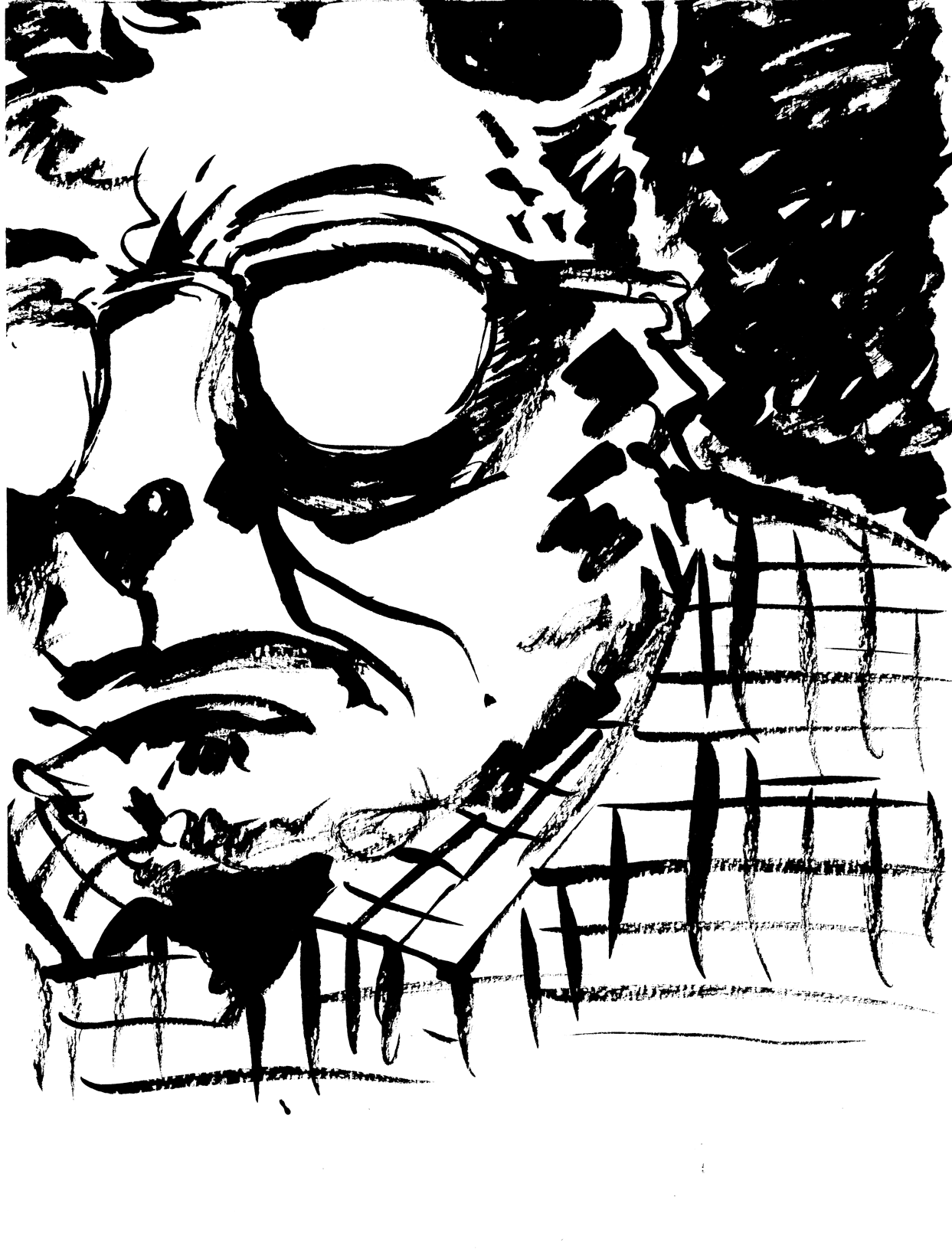
ARTTU HEIKKINEN:
Laserkokija + minun onneks.
[FIN] Syyskyyssa Sarjakuvafestivaalien aikaan Alkovissa oli esillä Arttu Heikkisen ikkunaan installoitu sarjakuvamainen teos. "Laserkokija + minun onneks on sarjakuvamaista aivoverenvuotoa. Se on ajatuksen varaan rakennettu mielikuvista syntynyt keinotekoinen 2D-maailma. Tussia, papereita, nallekarhuja ja kissoja. Sananhelinää." Teksti: Heikkinen
[ENG] In September during the Helsinki Comic Festival Alkovi presented the exhibition by artist Arttu Heikkinen. The window was be occupied by Heikkinen's darkly humorous imaginative 2D world of cartoons - ink, paper, teddybears and cats.
TOP / YLÖS
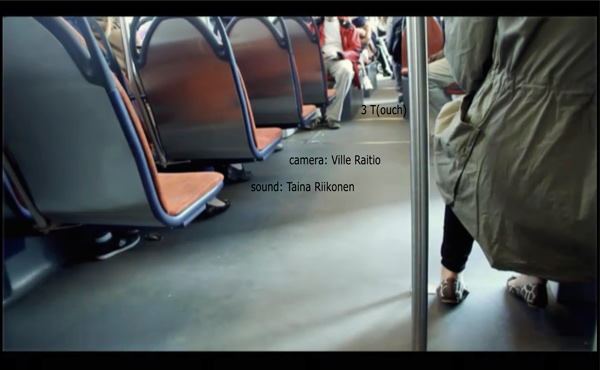
TAINA RIIKONEN & VILLE RAITIO:
3T(ouch)
[FIN] Raitiovaunussa tapahtuva pienoiselokuva 3T(ouch) käsitteli kosketusta ja sen välttämistä julkisessa liikenevälineessä. Teos tutki helsinkiläisessä kaupunkitilassa ja joukkoliikennekulttuurissa alati neuvoteltavia läheisyyksien ja etäisyyksien välisiä liikahduksia ventovieraisen ihmisten välillä. Teoksen pyrkimyksenä oli tuoda esille niitä lukuisia hienojakoisia eroja, joilla ihmiset kommmunikoivat toisilleen erilaisten kosketusrekistereiden käytöstä. Liikkessä olevan raitiovaunun sisälle syntyy mikro-ja makroliikkeessä olevia kohtaamisia, joiden keskiössä ovat erilaiset paikkaspesifit kosketuksen ja koskemattomuuden politiikat.
Ville Raitio on helsinkiläinen multimedia ammattilainen, joka työskentelee televisiossa, elokuvissa, radiossa ja erilaisissa monimediaprojekteissa.
Taina Riikonen on helsinkiläinen äänitutkimusmatkailija, joka käyttää medioinaan äänitystä, ääntä ja kirjoittamista.
[ENG] 3T(ouch) was a video work that dealt with distance and intimacy between people in city space and on communal traffic. The work aspired to bring forward those subtle differences with what people communicate to each other about using different sorts of registers of touch.
Ville Raitio is a Helsinki based multimedia professional, that works on television, radio as well as different sorts of multimedia productions.
Taina Riikonen is Helsinki based soundexplorer, who uses recording, sound and writing as her media.
TOP / YLÖS

MAIJA SAKSMAN:
Juhlat / TrashXmas / Roskaushartaus
[FIN]
Näyttelyssä oli esillä Saksmanin vuosien varrella maasta keräämiä roskia sekä löytämiä esineitä ja vaatteita nyt näyteikkunaan sommiteltuna roska- ja esine improvisaationa.
"Minua kiehtoo roskien ja löytöjeni tarina ja samalla vaivaa kertakäytöisen kulttuurin krapula, joka vertauu tässä henkilökohtaiseen haikeuteen ja muistumaan eilisestä ilosta.
Rikkinäisiä ilmapalloja, littaantuneita juhlamukeja, tupakka aski tolloja seinänraoista, sekä pesemätön juhlapöytäliina maasta löydetty pitsihanska & hieno hattu vähän rispaantunut." Teksti: Maija Saksman
Näyttelyn aikana oli myös yllätysikkunaesityksiä.
[ENG] Exhibited was artworks made from trash that Saksman had collected throughout the years.
"I am intrigued by the story of the trash and the findings I make, at the same time I am bothered by the hangover that comes from this disposable culture, that is here on this occasion juxtaposed to personal nostalgia and the memory of past joys. From the broken balloons, squashed party cups, cigarette packs, paper pieces from the cracks of the walls, as well as unwashed celebratory table cloth that is found from the ground, lace glove, and a fine, little bit broken, hat." Text by: Saksman.
There was also suprise window performances during the exhibition.
TOP / YLÖS
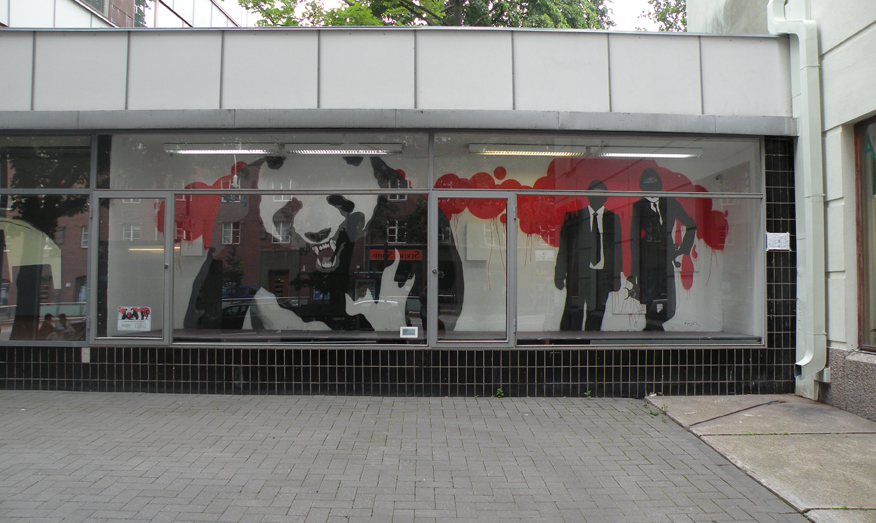
ANTTI MÄNNYNVÄLI :
PANDA HITS THE STREETS!
[FIN] Spray-akryylitekniikalla toteutettu teos muotoutui palapelimäisesti osittain uniikiksi kokemukseksi, osittain pysyviksi maalauksiksi. Männynväli hakee vaikutteensa kaduilta, graffitista ja sarjakuvista. Tulokseksi "muotoutuu modernia urbaania taidetta."
[ENG]
The piece is done with acrylics and spray paint. Männynväli is influenced by streets, graffiti and comics. The result can be described as "modern urban art"
TOP / YLÖS
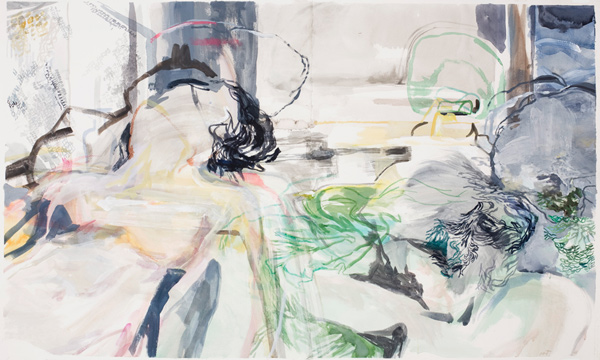
MILLA TOUKKARI:
Chatam Sófer - ¦tefánikova 24
[FIN]"Maalauksissani tutkin muistini toimintaa, ja sitä, minkälaisen muodon
muisto saa muisteluprosessissa. Maalaukset sijoittuvat noin kolmen
kilometrin matkalle Bratislavaan, Slovakiaan, jossa vietin noin
yhdeksän kuukautta syksyn 2010 alusta kevään 2011 loppuun. Kuljin
kyseistä matkaa ja sen variaatioita lukemattomia kertoja, ja matkan
varrella minulle kehittyi paljon siirtymiseen, lähentymiseen,
etääntymiseen ja luopumiseen liittyviä muistoja.
Tietyt paikat konkretisoivat muistoja erityisen osuvasti. Muistelu
toimintana on kuitenkin vähintään yhtä tärkeä aihe töissäni kuin itse
muistelun aihe; miten aika katoaa mielestäni, miten menneet tapahtuvat
kiinnittyvät yhteen hetkeen lomittuen toisiinsa erottumattomasti.
Muisti ei ole lineaarinen niinkuin oli se matka, joka sitoo muistot
toisiinsa. Tuo lineaarinen reitti on kuitenkin avain muistojen ja
muistelemisen vyyhtiin." Teksti: Toukkari
[ENG]"In my paintings I aim at discovering the functioning of my memory, and
the form a single memory gains in the process of reminiscence. The
paintings can be situated on a 3-kilometer-route in Bratislava,
Slovakia, were I spent nine moths from the beginning of the autumn
2010 till the end of the spring 2011. I travelled the journey and its
variations innumerable times, and on the route I developed several
memories related to transit, drawing closer, alienation and
renunciation.
Some places concretize some memories especially aptly. However,
recollection as action is as important theme in my works as the actual
subject of the memory; how time disappears in the mind of the
reminiscent, and how the past events tangle and interlock inseparably.
Memory is not as linear as was the journey that binds the memories
together. Nonetheless, that linear route provides a key to the web of
reminiscing and memories." Text by Toukkari.
TOP / YLÖS

RIIKKA KERÄNEN:
Kohtaus kaupungissa / Encounter in a city
[FIN]"Kotipihaltani on matkaa 607km Helsinkiin. Se on minusta aika kaukana. Asun maatilalla, jota ympäröi kaksi järveä. Nyt kun asun täällä, teoksiini on alkanut ilmestyä pesiä, hirvenkarvoja, lintuja ja muita eläimiä. Kaupunkielämä tuntuu etäiseltä sekä teoriassa että käytännössä. Galleria Alkoviin rakentuvan teoskokonaisuuden voi nähdä eräänlaisena dioramana, joka johdattaa pois kaupunkiympäristöstä jonnekin toisaalle. Tarinan asetelman taustalle voi jokainen luoda itse." Teksti: Keränen
[ENG]"The distance between my home and Helsinki is 607km. It's a long way, I think. I live in a farm which is surrounded by two lakes. Since I came to live here nests, elk fur, birds and other animals have started to appear in my works. City life feels very distant both in theory and in practice. My upcoming work in Alkovi Gallery is going to be a one kind of diorama, which leads a viewer away from the city environment. Every viewer can create their own story to the scene in front of them." Text by Keränen.
TOP / YLÖS
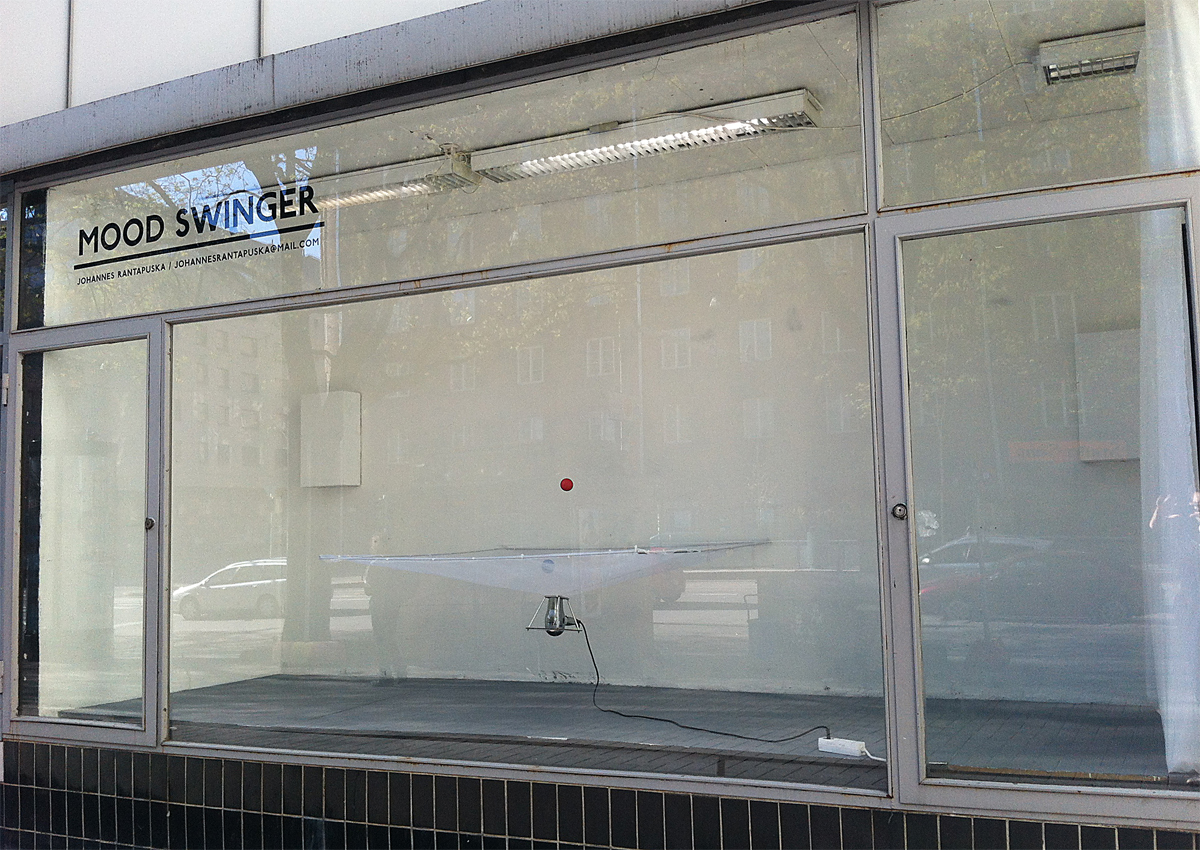
JOHANNES RANTAPUSKA
Mood Swinger
"lausunto: Mood Swinger pyrkii valottamaan kaksisuuntaista mielialahäiriötä sairastavan ihmisen mieltä; jatkuva tasapainon löytäminen & kadottaminen manian & depression välillä.
tekniset tiedot:Installaatio koostuu hiustenkuivaajasta & kahdesta värillisestä styroksipallosta. Verkko on tehty hyttysverkosta ja rautalangasta.
bio: taiteen kandidaatti, Taideteollinen Korkeakoulu Helsinki, graafisen suunnittelun osasto, 2010
statement: Mood Swinger tries to capture the mind of a person with bipolar disorder; the continuous finding & losing the balance between mania & depression.
technical data:The installation consists of regular hair dryer & two colored styrofoam balls. The net is made out of mosquito net and iron wire.
bio:bachelor of arts, University of Art and Design Helsinki, department of graphic design, 2010
TOP / YLÖS
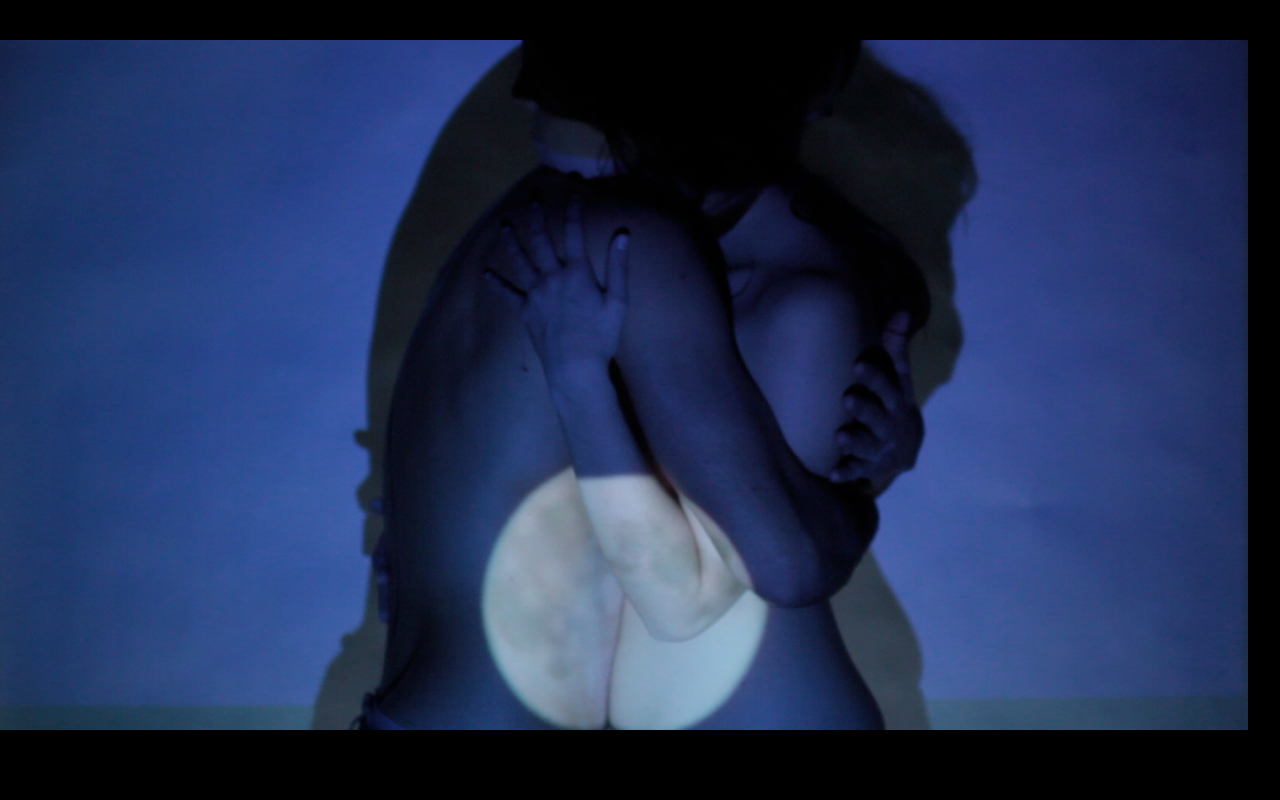
11.59
4 videoteosta / four videoworks
*Ariadna Dot Casanovas: Comptine
2012
2'50 min
Video
Comptine is a cinematic artwork that outlines the relationship between two person and how a pregnancy and an abortion can shake it.
*Riikka Gröndahl ja Elsa Trzaska: Maanantain jälkeinen tiistai
2012
8min
Video
Elämä on kuoleman odottamista, eikä siinä mitään. Kaikki on hyvin.
*Marie Syrjälä: good morning
2012
2,50min
Video
Kokeellinen lyhytelokuva good morning kertoo aamuista, elämästä, hajoamisesta.
*Tanja Glad ja Raila Hänninen: suudelma
2012
2,03min
super 8mm
joskus oikea suudelma tuntuu.
[FIN] Tampereen ammattikorkeakoulun opiskelijoiden teoksia. Tekijät tutkivat teoksissaan muotoa rikkovaa elokuvallista työskentelyä ja pyrkivät rakentamaan perinteistä kerrontaa uudella tavalla. Osallistuvat taiteilijat olivat: Ariadna Dot Casanovas, Riikka Gröndahl ja Elsa Trzaska, Marie Syrjälä, Tanja Glad ja Raila Hänninen. Työskentelyn tutoreina ovat toimineet Fanni Niemi-Junkola ja Sari Tervaniemi.
[ENG] The exhibition 11.59 presented four cinematic artworks made by art and media students of Tampere University of Applied Sciences. Artists explored cinematic work that breaks the form, and tried to find new ways of building narration. Participating artists are: Ariadna Dot Casanovas, Riikka Gröndahl ja Elsa Trzaska, Marie Syrjälä, Tanja Glad ja Raila Hänninen. Fanni Niemi-Junkola and Sari Tervaniemi acted as tutors for the works.
TOP / YLÖS
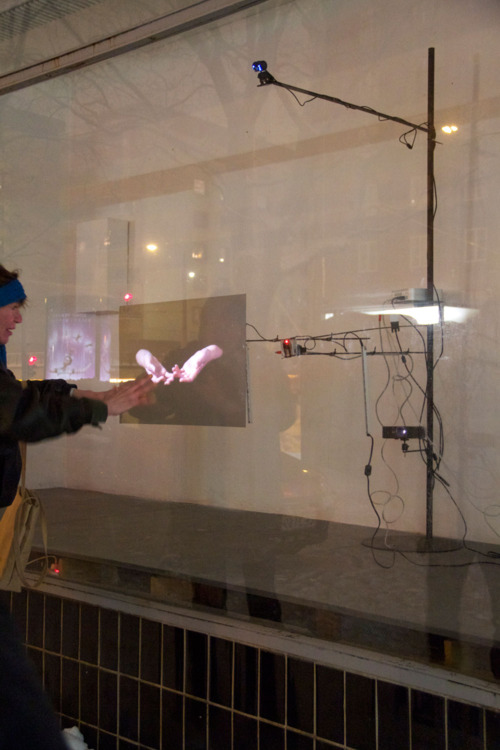
At Hand Movable Places installaatio - Interaktiivinen videoteos. / An interactive video work.
Toteuttajina on työryhmä / Created by: Heidi Tikka, Jaakko Pesonen, Teemu Korpilahti.
[FIN] Teoksen taustalla olevan projektin tavoitteena on mahdollistaa kosketukseen perustuvan vuorovaikututteisen installaation esittäminen julkisella paikalla, teoksen käsitellessä kysymyksiä toiseudesta. Se kysyy millaiset ovat kaupungissa olemisen ehdot nykypäivän Helsingissä ? Olemmeko vaarassa menettää kykymme kohdata toinen ihminen inhimillisyydessään ainutlaatuisena olentona? Teos käyttää materiaalinaan mediataiteilija Heidi Tikan kuvaaman arkiston kuvia, joissa hän on kuvannut erilaisia ihmisiä toteuttamassa performatiivisen tapahtuman kameran edessä; kuvittelemaan itsensä odottamassa jossain arkipäivän tilanteessa ja kuvannut sitten heidän käsiään. Ikkunaan projisoidaan satunnaisesti valittua videokuvaa tuntemattomien käsistä. Kun katsoja koskettaa ikkunassa olevia käsiä tilaan avautuu rajattu lähikuva tarkkailtavan henkilön käden ihosta, jota voi tutkia eri etäisyyksiltä ja eri kohdista.
[ENG]An interactive video work 'At Hand Movable Places' was on display during one night. The aim of project that was behind the presentation of the piece was to enable touch based interactive installation in a public space, as the piece itself dealt with the questions of otherness. It asked what are the conditions of being in the city like contemporary Helsinki? Are we in danger of losing our abilities to face another human being as a humanly unique being? The work used as its material the images from the archive of media artist Heidi Tikka, in which she had depicted different human beings acting a performative happening in front of the camera; imagining themselves waiting in some mundane situation and then taken images of their hands. Randomly selected video image of the hands of these unknown people was then projected to the window. When the viewer touched the hands on the screen a cropped close-up image presented itself to the space showing the skin of the person that is being viewed, and that could be examined from different distances and parts.
TOP / YLÖS
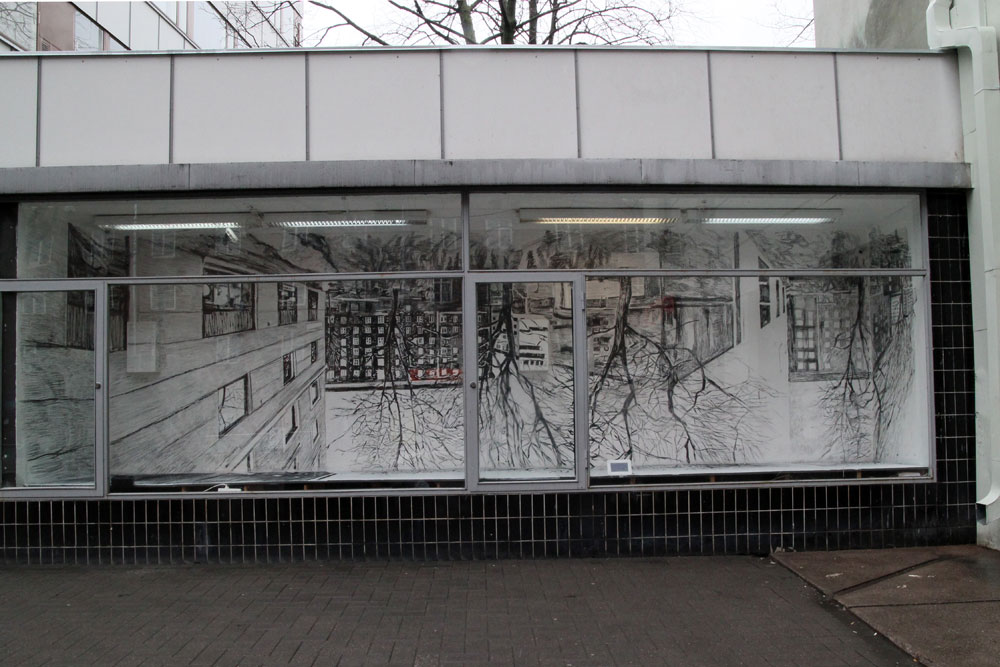
SANNA HÄRKONEN:
Sisältä ylösalaisin / Inside upside down
[FIN]"Näyttelyäni varten muutan Alkovin camera obscuraksi ja toteutan siellä koko näyttelytilan kokoisen, ulkoa heijastuvaan katumaisemaan perustuvan seinämaalauksen.
Camera obscurassa huoneen ikkunat peitetään lukuunottamatta pientä aukkoa, jonka kautta näkymä ulkoa heijastuu ylösalaisin tilan seinille. Kun ikkunoiden peitteet poistetaan, päivänvalo täyttää tilan ja heijastus katoaa. Maalaus tuo kuitenkin ulkona näkyvän kaupunkimaiseman osaksi huoneen sisätilaa myös valossa. Maalausprosessin aikana valokuvantarkka heijastus muokkautuu ja alkaa elää omaa elämäänsä." Teksti: Härkönen
Sanna Härkönen (s.1979) on kuvataitelija
[ENG] "For my exhibition in Alkovi, I'll change the gallery space to camera obscura and realize there a wall painting, using the projection from the street as my departure point.
In camera obscura a room is darkened except a tiny hole through which an image of outside surroundings projects upside down all over the room. When windows uncovered, daylight fills the room and the projection disappears, but painting shows the urban landscape inside the room even then. However, during process of painting, always somewhat unpredictable, the photography-like reflection will be modified and starts to obey the rules of painting." Text by Härkönen
Sanna Härkönen (b.1979) is a visual artist.
TOP / YLÖS
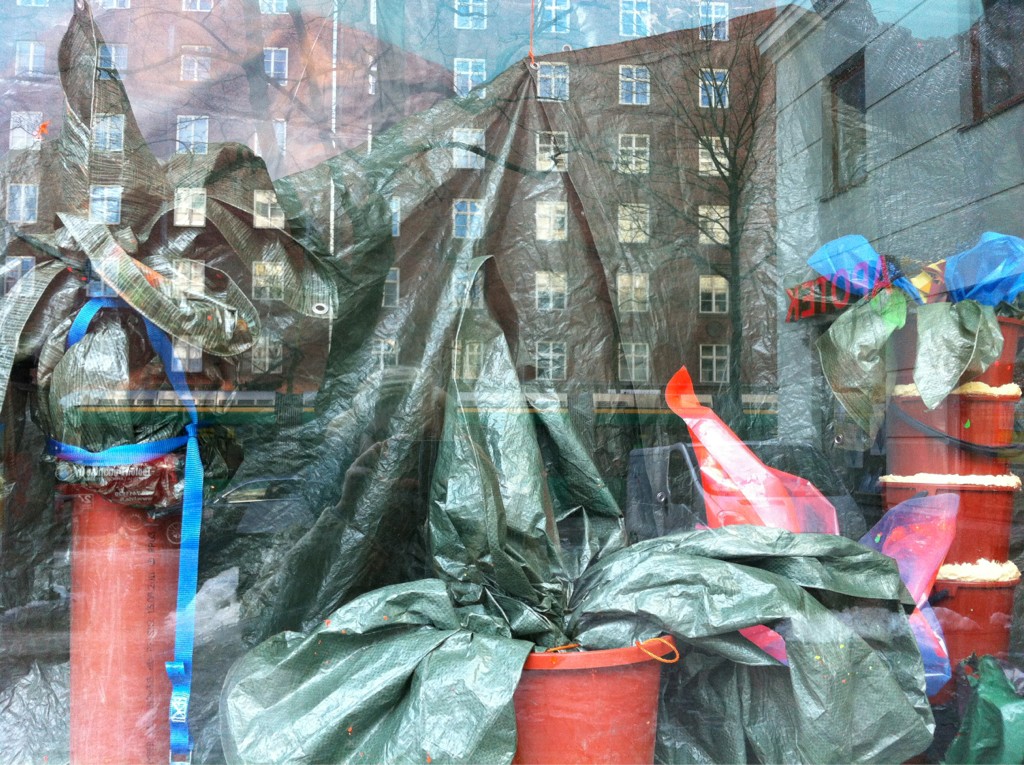
PIA SIRÉN:
DIORAMA [osana Contemporary Trash- näyttelysarjaa / As a part of Contemporary Transh- exhibition series]
[FIN]Pia Sirén (1982) on Helsingissä asuva kuvanveistäjä joka työskentelee paikkasidonnaisten
tilateosten parissa. Töissään Sirén on rakentanut luontokokemuksia
keinotekoisin välinein, käyttäen pääasiassa rakennusmateriaaleja. Teoksissaan Sirén luo
kokonaisvaltaisia tilallisia kokemuksia ja käyttää materiaaleja luovasti väärin. Teokset ovat
tee-se-itse-maisemia joissa kaunis ja epätodellinen tunnelma rakentuu mahdollisimman
karuilla ja arkisilla välineillä. Sirén on kiinnostunut ihmisten suhteesta ympäristöönsä;
miten luontoa rakennetaan ja muokataan, sekä luonnon kokemisen mahdollisuuksista
kaupunkiympäristössä.
"Dioraama määritellään osittain kolmiulotteiseksi maisemamalliksi tai asetelmaksi,
joka esittää esimerkiksi historiallista tapahtumaa tai tilannetta luonnossa. Dioraamat
ovat ikkunoita toiseen todellisuuteen. Niissä käytetään tavallisesti kaarevia pintoja ja
taustamaalauksia, jotta voidaan antaa katsojille vaikutelma todellista suuremmasta
tilasta. Taemmas sijoitetut esineet voidaan myös tehdä normaalia pienemmiksi, jolloin
vahvistetaan syvyysvaikutelman illuusiota.
Alkovi galleriassa maaliskuun ajan esillä oleva DIORAMA on maisema-tilateos. Rakennan
muovista, pahvista, köysistä, ämpäreistä, tyhjistä maalipurkeista, pressuista, ja muista
rakennusmateriaaleista kolmiulotteisen trooppisen maiseman. Tyhjistä maalipurkeista
muotoilen palmunrunkoja, lehdet pressuista, ja kasveja värikkäästi maalatusta pahvista
ja muovista. Galleriaan katonrajassa roikkuvat eksoottiset linnut muotoilen erivärisistä
köysistä ja muovipusseista. Tilan takaseinään luon kaukaisen vuoristomaiseman erivärisiä
pressuja käyttäen." Teksti: Sirén
Näyttely kuului Contemporary Trash näyttelysarjaan, johon olimme kutsuneet viisi taiteilijaa/taiteilijaryhmää, joiden olemme kokeneet käsittelevän tiettyä aihepiiriä eri lähtökohdista. 'Contemporary Trash'in voidaan ymmärtää tarkoittavan mitä tahansa "roskan" ilmenemismuotoja nykyajassa. Tämä pitää sisällään muun muassa koko roskakulttuurin kirjon mediassa, ekologiset kysymykset, roskan taideteoksen materiaalina ja laajemmin käsitteellisesti ajateltuna kulttuurillisesti epämiellyttävien, siis "likaisten", asioiden esiin nostamisen. Pia Sirénin näyttely oli sarjan viimeinen otos.
[ENG]Pia Sirén (b. 1984) is Helsinki-based sculptor who works with site-specific installations. In her works Sirén has build nature experiences thru artificial methods using mainly materials used normally for construction purposes. In her works she creates overall special experience using materials creatively wrong. The pieces are DIY-sceneries in which a beautiful and unreal atmosphere is made with mundane and harsh tools. Sirén is interested in human beings relationship with its surroundings; how nature is being build and modified and about the possibilities in experiencing nature in urban environment.
"Diorama is defined as partly three dimensional scenery or composition which portrays for instance a historical event or situation in nature. Dioramas are windows to another reality. Curved surfaces and painted backdrops are used in order to give viewers an impression of a larger space than in reality. Objects placed farthest can be made smaller than normally for the purpose of fortifying the illusion of a perspective.
Diorama that is placed in Alkovi gallery during March is a landscape-space piece. I will build a three dimensional tropical scene made of plastic, cardboard, buckets, empty paint cans and tarps. From empty paint cans I will form palm trunks, make leafs from tarps and vegetation from colorfully painted cardboard and plastic. I will form exotic birds hanging from the gallery's ceiling from different colored ropes and plastic bags. To the back wall of the space I will create a distant mountain scenery using different colored tarps." Text by Sirén
The exhibition was a part of the 'Contemporary Trash' exhibition series in which we had invited 5 artists/artist groups that we felt to have been dealing with a certain theme from different starting points. 'Contemporary Trash' can be defined to mean whatever form of "trash" possible - from the whole trash culture in media, ecological questions, junk as a material for art piece as well as conceptually the culturally unpleasant, so called "dirty" subjects and issues. This was the last part of the exhibition series.
TOP / YLÖS
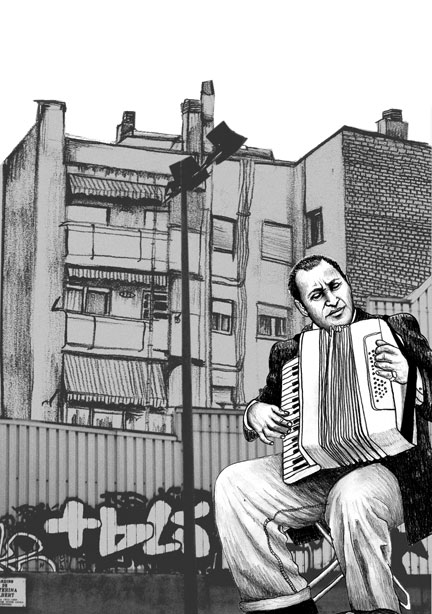
Kukka Ranta & Laura Lehtinen [osana Contemporary Trash- näyttelysarjaa / As a part of Contemporary Transh- exhibition series]
[FIN] Osana Contemporary Trash -näyttelysarjaa taiteilijapari Kukka Ranta ja Laura Lehtinen kiinnittävät huomionsa kaupunkitilan "eläviin roskiin". Taiteilijoiden tarkastelun kohteena oli Helsingin kansanosa, jonka yksityiset asunnonomistajat kokevat rasitteeksi, ja jota ei haluta nähdä omassa elinympäristössä - not in my backyard!
"Tuloerot syvenevät, tukijärjestelmät ovat riittämättömiä, velkataakat ajavat lapsiperheitä asunnottomuuteen ja leipäjonot pitenevät entisestään. Myös kerjääminen on palannut katukuvaan. Ihmiset eivät ole roskia, heitä ei voi lakaista piiloon. Köyhyys on seurausta tuloeroja kasvattavasta politiikasta."
Perjantaina 10.2 klo 12 -14 Hurstin leipäjonon vieressä Galleria Alkovin Contemporary Trash - näyttelyn avajaisten yhteydessä jaettiin ruokaa siirtolaisille, kodittomille ja vähävaraisille - kaupunkitilan eläviksi roskiksi leimautuneille.
Yhteistyössä mukana oli Heikki Hursti, Kallio-liike ja VVA - Vailla vakinaista asuntoa ry.
LAURA LEHTINEN on helsinkiläinen kuvataiteilija ja kuvittaja. Tasa-arvo, globaali eriarvoisuus ja urbaanit kulttuurit ovat keskeisiä teemoja Lehtisen työskentelyssä. Barcelonassa opiskelleen ja työskennelleen Lehtisen kuvituksia on julkaistu useissa eri medioissa Suomessa ja Espanjassa. Kuvittajan työssään Lehtinen pitää tärkeänä kaupunkikulttuurien ja yhteiskunnallisten aiheiden käsittelemistä.
[ENG]Gallery Alkovi presented as a part of 'Contemporary Trash' exhibition series and exhibition by artists Laura Lehtinen and Kukka Ranta. They have studied what they call "live trash" - the dropouts of Helsinki.
"The bread lines are longer than ever due to growing income gaps and insufficient support systems. More and more families are in danger of losing their homes because they can't find a way out of debt. Begging has become again part of our street view. People are not garbage. You can't just sweep them under the rug. Poverty is the outcome of politics that increase inequality."
Free food was served to immigrants, homeless people and the needy at the opening on Friday, February 10th from 12pm to 2pm.
The event was done cooperation with Heikki Hursti, Kallio-liike and Vailla vakinaista asuntoa VVA ry.
TOP / YLÖS
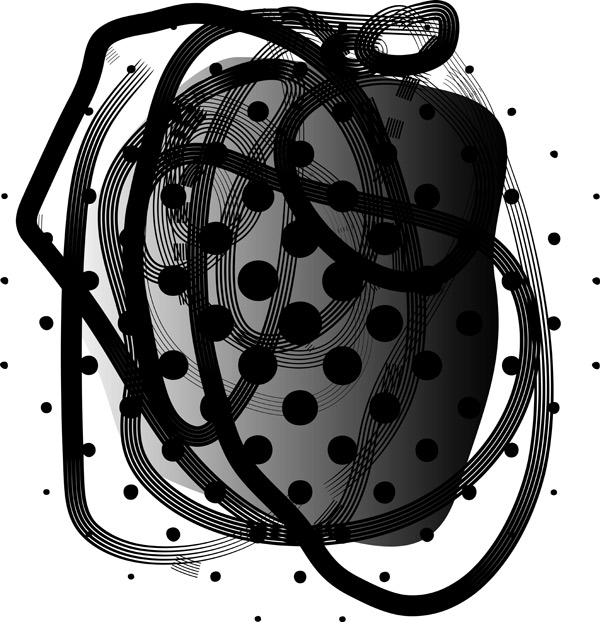
MIKE ANDREWS
[osana Contemporary Trash- näyttelysarjaa / As a part of Contemporary Transh- exhibition series]
"Mike Andrews is a young artist from Chicago, whose paintings and sculptures share a remarkable DNA that renders them so closely related that they could be mistaken for separated-at-birth identical twins. Andrews seems to jump effortlessly from flat surfaces to engaging, sculptural, interlocking materials, such as nets and rope, which are all visually connected and related with recognizable lines and odd-ball forms. The artist seems at ease moving in any direction, and is a first-rate explorer who needs no trail guide or maps to find his way. He is at his best when he twists flat works that seem sculptural and utilizes negative space for positive results. He "builds" his compositions on a shallow foundation section by section, without a blue print or plan of action, except to move forward in any direction. The real secret of his appealing freshness and intriguing wacky shapes is that he makes unconscious decisions on his own idiosyncratic private meandering road, with loaded brush in hand that could serve as a steering wheel, allowing Andrews to navigate abrupt U-turns and sharp left and right turns without directional signals. His strange original works change course like an unlicensed driver looking for a short-cut through rush hour for the first time, and with a determined smile and one arm out the window, the artist navigates a busy interstate cloverleaf as he inadvertently creates a scenic overlook. When it comes to maneuvering color and form, Andrews throws in everything, including the spare tire. When this guy finally takes off with a permanent license to create much larger paintings, look out for dangerous and enjoyable curves ahead." -Bruce Helander, Huffington Post, April 2011
[FIN]Mike Andrews on Chicagolainen kuvataiteilija, joka työskentelee käyttäen välineinään niin villalankaa kuin tietokonettakin, joiden avulla hän muotoilee visuaalisia tekstuureja ja dynaamisia kuvapintoja. Alkovin näyttelyssä hän esitti 'Contemporary Trash' -teeman mukaiseen estetiikkaan pohjautuvan mustavalkoisista kuvamuodoista koostuvan printtiteoksen, jonka installointi galleriatilaan oli ainutkertainen - muotojen toistaessa tyylillisesti hänen aiempaa tuotantoaan. Andrews toimii pääasiallisesti Chicagossa Yhdysvalloissa, jossa hänen töitään on ollut esillä Chicagon nykytaiteen museossa, ja jossa hän on opettanut Chicagon Art Institutessa.
[ENG]Mike Andrews is a Chicago based visual artist who uses yarn as well as computer as his tools in creating unique visual textures and dynamic image surfaces. In the exhibition created to Alkovi he presented an installation consisting of black and white prints following the aesthetic theme of 'Contemporary Trash' and continuing as well as being consistent with his earlier style and works. Andrews lives and works mainly in Chicago United States in where he has presented his works in the Chicago Contemporary Art Museum and where he has taught in the Chicago Art Institute.
TOP / YLÖS

JOONAS JOKIRANTA [osana Contemporary Trash- näyttelysarjaa / As a part of Contemporary Transh- exhibition series]
Taiteilija Joonas Jokiranta (s. 1980), joka käyttää välineinään valoa, tilaa, ääntä, liikkuvaa kuvaa, sekä omaa kehoaan.
"Ensimmäisessä videossa ajattelen kaikkia niitä asioita, jotka olen nähnyt. Toisessa videossa olen kylvyssä Taidekeskus Salmelassa. Teoksen nimi on Kylpijä. Kolmas video pyörii loputonta silmukkaa. Lisäksi tyhjensin asuntoani ja varastoin, sekä asettelin esineitä galleriatilaan. Tyhjässä asunnossani aion kuvata videoteoksen.
Punainen valo symboloi verta, joulua ja marlboroaskia." Teksti: Jokiranta
[ENG] Joonas Jokiranta (born 1980) uses light, space, sound, moving image and his own body as methods of working.
"In the first video, I am thinking about all the things I have seen. In the second video, I am taking a bath in Art Center Salmela. The name of the work is 'The Bather.' The third video is an endless loop. I was also emptying my apartment, putting things to storage, and placing items in the gallery space. In my empty apartment, I plan to shoot a video piece. The red light symbolizes blood, Christmas, and a Marlboro package." Text by Joonas Jokiranta.
TOP / YLÖS

JANNE NABB JA MARIA TEERI:
TIENVARSIMAINOS / ROADSIDE ADVERTISEMENT [osana Contemporary Trash- näyttelysarjaa / As a part of Contemporary Transh- exhibition series]
[FIN] Alkovi (gallerian) joka kuukautinen toiminta oli perustunut tilan käyttöön antamiselle erilaisille taiteilijoiden projekteille. Emme olleet 2009-2012 harjoittaneet varsinaista kuratoriaalista toimintaa vaan olimme haluanneet mahdollistaa moninaisia hankkeita ja taiteilijoiden kokeiluja, sillä varauksella toki että hanke oli jollain tapaa ajateltu Alkovin tilaa ja konseptia varten. Contemporary Trash -näyttelysarja oli ensimmäinen itsemme määrittämä näyttelyhanke, johon olimme kutsuneet viisi taiteilijaa/taiteilijaryhmää, joiden olemme kokeneet käsittelevän tiettyä aihepiiriä eri lähtökohdista. 'Contemporary Trash' sarjan voidaan ymmärtää tarkoittavan mitä tahansa "roskan" ilmenemismuotoja nykyajassa. Tämä pitää sisällään muun muassa koko roskakulttuurin kirjon mediassa, ekologiset kysymykset, roskan taideteoksen materiaalina ja laajemmin käsitteellisesti ajateltuna kulttuurillisesti epämiellyttävien siis "likaisten", asioiden esiinnostamisen.
Nättelysarjan aloittivat taiteilijat Janne Nabb ja Maria Teeri teoksellaan 'Tienvarsimainos - Roadside advertisement', jonka lähtökohtana oli toiminut pieni sateenkaaren värinen päiväkirja.
12.10.2011
"Meillä on kulkenut kaiken muun rojun seassa pieni sateenkaaren värinen päiväkirja. Kirjan ensimmäisellä sivulla lukee Minun päiväkirja. Kirjasin on kömpelö, mutta tunnistettavan geneerinen. Se voisi olla jokin vakiofontti, sellainen joka löytyisi jokaisen tietokoneen tekstieditorista. Kirjan keskiaukeamalla oleva päiväkirjamerkintä eroaa toisista tänään on joulu, tänään alkoi koulu ja tänään on viimeinen koulupäivä -merkinnöistä arkipäiväisyydessään. Se on (kuin muutkin) lyhyt, toteava, informatiivinen ja runollinen. Siihen on helppo samaistua. Jokainen on nähnyt kyseisen asian tapahtuvan kymmeniä kertoja, aina yhtä vangitsevana." Teksti: Nabb & Teeri
[ENG]
Alkovi (Gallery)'s monthly activity was based on giving the space for the use of different artistic projects. We weren't working with a actual curatorial practice during 2009-2012 - instead we wanted to make different projects and artists' experiments possible with the mindset that the exhibition plan would somehow have to have been thought for Alkovi's display window space and concept. 'Contemporary Trash' was the first exhibition series in which we defined the setting points. We invited 5 artists/artist groups that we felt to have been dealing with a certain theme from different starting points. 'Contemporary Trash' series can be defined to mean whatever form of "trash" possible - from the whole trash culture in media, ecological questions, junk as a material for art piece as well as conceptually the culturally unpleasant, so called "dirty" subjects and issues. The series began with the exhibition by Janne Nabb and Maria Teeri with their piece 'Roadside advertisement' of which a starting point was a small rainbow colored journal.
October 12th, 2011
We've had a small rainbow coloured diary with us amongst all other junk. The first page is titled My diary. Type is clumsy yet recognizably generic. It could be some standard font, the kind which is found from any computer's text editor. Entry in the centerfold of the diary differs from the other today it's Christmas, school starts today and today's the last school day -entries in its mundanity. It is (as other entries) short, declaratory, informative and poetic. It's easy to identify with. Everyone's seen that kind of thing happen dozens of times, always as compelling. Text by: Nabb & Teeri
TOP / YLÖS

SWAPPING THE PRACTICES
Swapping Swapping the Practices oli taiteilijoiden ammattikäytäntöjä sekä kollegiaalista tiedon jakamista ja oppimista kartoittava projekti, joka koostui työpajasta ja sitä taltioivasta tosi-tv muotoon rakennetusta dokumentaatiosta. Tarkoituksena oli tarkastella kuvataiteen olemassaoloa nyky-yhteiskunnassa. Projektissa käsiteltiin sitä, miten kuvataidetta tehdään, miten siitä puhutaan ja mille kuvataitelijuus rakentuu juuri nyt - nimenomaan kuvataiteilijoiden omista näkemyksistä ja kokemuksista lähtien. Tätä varten järjestämme työpajan 14.-16.10.2011, jossa taiteilijat toivat esiin tekemistään ja ajatuksiaan. Koimme, että on olennaista järjestää taiteilijalähtöisiä projekteja, joissa taiteilijat itse määrittelevät asemansa instituutioiden ja organisaatioiden ulkopuolella.
Viikonlopun aikana tapahtuvaan työpajaan osallistuu 10 taiteilijaa, jotka jakautuen pareihin vaihtoivat ja "opettivat" toisilleen omaa taiteellista toimintaansa käytännön tekemisen kautta. Projektiin osallistuvat taiteilijat olivat: Pari Autio, Diego Bruno, Wilma Hurskainen, Jaakko Karhunen, Essi Kausalainen, Jussi Koitela, Kati Ruohomäki, Iidu Tikkanen, Lauri Wuolio. Työpajaa järjestivät ja dokumentaatiosta vastasivat Galleria Alkovia pyörittävät taiteilijat Miina Hujala ja Arttu Merimaa, joista Hujala on myös mukana yhtenä projektin taiteilijoista.
Projektissa tutustuttiin toisen taiteilijan tapaan tehdä taidetta eli siis konkreettisesti myös tehtiin "teosta" - miten se kunkin taiteilijan kohdalla ilmenikin - käyttäen itselleen vieraita välineitä tai metodeja. Lopputulokset esitettiin Galleria Alkovissa työpajaviikonlopun jälkeen. Pyrkimyksenä ei ollut osallistujien siirtyminen toisen välineen tai toimintatavan käyttäjäksi sinänsä, vaan pikemminkin mahdollisuus kokeilla ja avata omaa tekemistään, selittäessään ja yrittäessään välittää toiselle miten oma prosessi rakentuu samalla kokeillen miten toisen lähestymistapa taiteen tekemiseen muodostuu. Prosessin aikana pohdittiin miten taiteellinen ajattelu ilmenee ja kuinka opitaan taiteelliseksi toimijaksi, miten oma ammattikuva on rakentunut ja minkälaiseen osaamiseen se pohjaa. Taiteilijoiden reflektion stimuloimiseen, ja projektin taltioimiseen, käytimme tosi-tv formaattiin rakennettua dokumentaatiota. Sen tarkoituksena oli taltioida ja esittää prosessi pohdintoineen selkeällä ja mielenkiintoisella tavalla.
[ENG]The project called Swapping the Practices dealt with artistic practices and collegial distribution of knowledge and learning - consisting of workshop and a video documentary. Our goal was to observe the value and presence of art in contemporary society. In order to do so we observed how art is made, what we speak about it and to what - being an artist - is based on right now. We wanted to deal with this subject matter especially based on the experiences and viewpoints of artists. We organized a workshop 14.-16.10 where artists brought their thoughts forward. We felt that it was important to set up projects where artists define themselves their position outside from institutions and organisations.
A "workspace-installation" was constructed to Alkovi's display window, which consisted of the elements and results involved in the process.
10 artists participated and "swapped" their practices during the weekend. Discussions in pairs as well as together as a group were an integral part of the project. The participating artists were: Pasi Autio, Diego Bruno, Wilma Hurskainen, Jaakko Karhunen, Essi Kausalainen, Jussi Koitela, Kati Ruohomäki, Iidu Tikkanen, Lauri Wuolio. Organising the workshop were artists Miina Hujala and Arttu Merimaa who run Alkovi gallery of which Hujala participated also in the workshop. Also artist Eero Yli-Vakkuri participated in documenting the workshop as well to the discussions.
TOP / YLÖS

TELLERVO VIITANIEMI:
Taivas on täällä tänään / Heaven is here today
[FIN] Esillä oli Tellervo Viitaniemen teos "Taivas on täällä tänään" jonka lähtökohtana on valokuva 1930-luvun Kallion nälkäjonosta.
Alkovi sijaitsee Veikko ja Lahja Hurstin Laupeudentyö -hyväntekeväisyysorganisaation naapurina, ja vuonna 2011 halusi osoittaa tukensa sekä ottaa kantaa tilanteeseen, jossa Hurstin organisaatio etsi uusia tiloja. Viitaniemen teos esitettiin haluna muistuttaa, että vaikka jono siirtyisi pois Helsinginkadulta ei nälkä ja köyhyys poistu elämästä. Hurstin organisaatio onneksi sai 2012 alkaen isommat tilat aiemman tilan vierestä ja pystyi siten jatkamaan toimintaansa alueella tukien tarvitsevia.
Avajaisissa perjantaina 30.9. klo 13.30 Maija Saksman esitti lauluja "puille, kukille ja ohikulkeville ihmisille."
[ENG] A photo of a breadline from 1930's Kallio served as a setting point for Tellervo Viitaniemi's work. Alkovi that has been situated as a neighbour to the food donation organization Veikko ja Lahja Hursti wanted to support the goodwill organisation in a situation where the organization was searching for new space. Viitaniemi's work presentad at Alkovi aimed at reminding that - even though the organization would leave Helsinginkatu - hunger and poverty wouldn't vanish from people's lives. Fortunately Hursti's organization got a bigger space right next door to the previous one and could then continue supporting the deserving in the area.
In the opening 30.9. at 1.30 p.m. Maija Saksman sang songs according to her own words to "trees, flowers and all the passers-by".
TOP / YLÖS

JUHANI KOIVUMÄKI:
Perisynti
[FIN] Valokuvia ja videoita siitä kuinka "Ihmistä hallitseva nautintokeskeisyys ja tarve kielletyn toteuttamiseen luo alkulähtökohdan rajoja rikkovalle ja kehittyvälle ihmiselle pitäen samalla sisällään taipumuksen hitaaseen itsetuhoon.
Perustarpeet ja riippuvuudet sekoittuvat toisiinsa kertoen tarpeestamme turvaan ympäröivää maailmaa kohtaan. Näyttelyn valokuvat ja videoteokset käsittelevät riippuvuuden syitä ja esittelevät sen seurauksia ihmisen fyysisessä ja henkisessä olemisessa. Ihminen on luonut jalkojensa alle suon johon hän uppoaa. Lisäksi hän on luonut ympärilleen muurin, jonka takia kukaan muu ei voi häntä auttaa, kuin hän itse. Näyttely avaa keskustelua siitä, että miksi tällaisia suojamuureja on olemassa ja voimmeko asettua niiden yläpuolelle." Teksti: Koivumäki
Juhani Koivumäki (s.1981) on video- ja valokuvataiteilija.
[ENG] Photographs and videos about how "The pleasure-centerness and the need to actualize the forbidden that dominates human-beings creates the starting point for the - boundary breaking and developping - human and at the same time including the tendency for a slow self destruction. Basic need and addictions mix together telling of our need to safety from the surrounding world. The photographs and videos of the exhibition deal with the cases of addiction and present its concequances in the physical and spiritual being of human. A human being has created a swamp underneath its feet where it is sinking. In addition he has created a wall around himself, which is the reason that no one else can help him but himself. The exhibition opens up a discussion about why do these proctective walls exist and can we set ourselves over them?" Text by Koivumäki
Juhani Koivumaki (b.1981) is a video and photography artist.
TOP / YLÖS
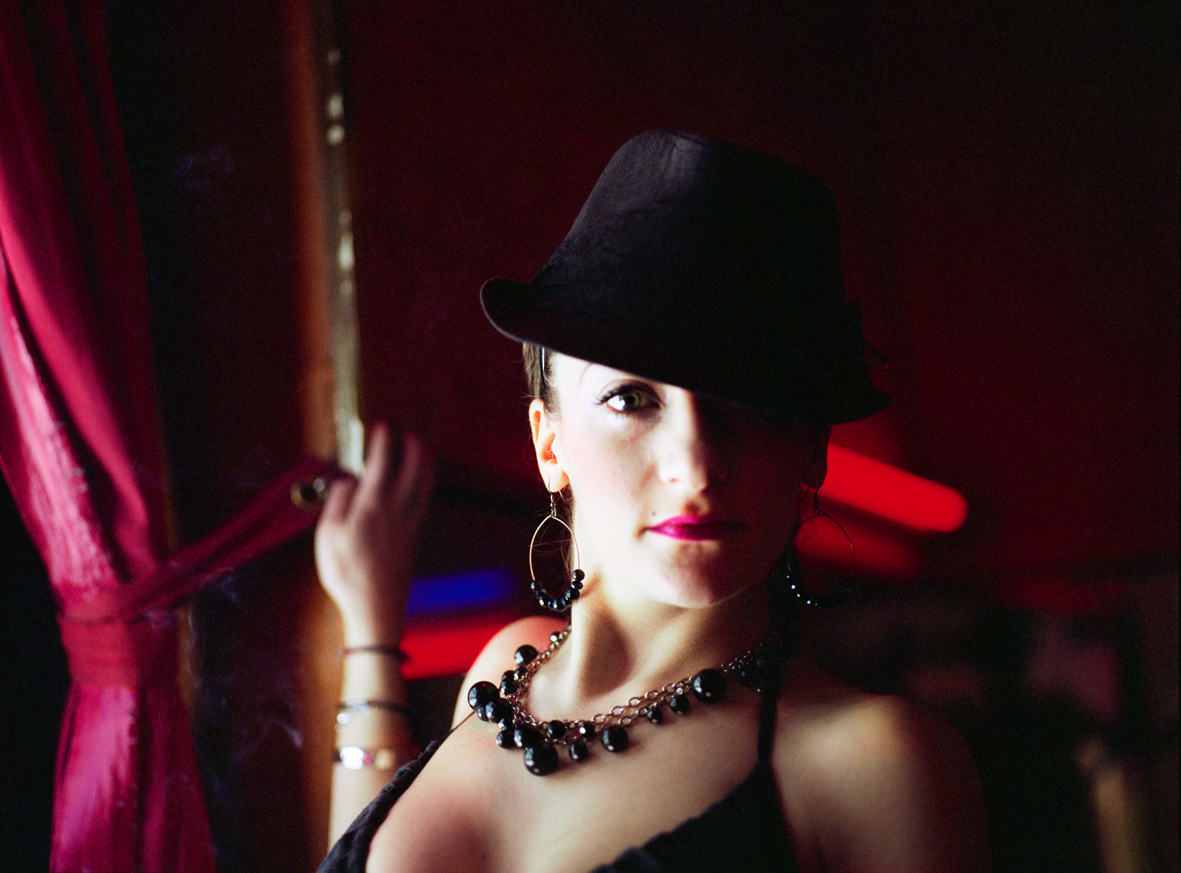
KAARINA SALMI:
Punaisen lyhdyn viereltä / By the red lights
[FIN] Esillä oli Kaarina Salmen valokuvia, jotka hän otti Hollannissa seksityötä tehneistä naisista. Hänen päämääränään oli löytää henkilöitä jotka työskentelevät tai ovat työskennelleet alalla omasta tahdostaan ja vailla salailun tarvetta.
"Xaviera on kirjoittanut kirjan kokemuksistaan ja emännöi nykyään B&B-hotellia, Mariska perusti PIC:in (Prostitution information Center) Amsterdamin keskustaan ja Metje toimii paitsi valo- ja videokuvaajana, myös seksityöntekijöiden etujärjestö De Rode Draad:in tiedottajana. Josje ja Iina työskentelevät ikkunoissa punaisten lyhtyjen alueella.
Elämään saattaa seksityön ohella kuulua perhe, parisuhde, harrastuksia ja mieleisekseen laittama koti. Aivan kuten heidän asiakkaillaankin, aivan kuten tuhansilla ihmisillä jotka vaeltavat punaisten lyhtyjen ikkunoiden ohi kännykkäkameroineen." Teksti: Salmi"
[ENG] Kaarina Salmi had photographed female sex workers in Holland. Her aim was to find people who work or used to work within the industry, and who have done this independently and openly. "Xaviera has written a book about her experiences and nowadays she runs a B&B in Amsterdam and Marbella. Mariska established PIC (Prostitution Information Center) in central Amsterdam and Metje is the press officer for "De Rode Draad" as well as a photographer and videographer. Josje and Iina work in the red light district. In addition to work, their lives may include families, relationships, hobbies and a nice house with a perfect garden. Just like the lives of their customers, and just like the lives of the thousands of people who wander around the red light district with their mobile cameras." Text by Salmi.
TOP / YLÖS

IIU SUSIRAJA:
TAIDE LÖYTYY JÄÄKAAPISTA
Halaan ympärilläsi olevaa
ilmaa.
Otan syliin.
Tehden siitä hattaraa.
[FIN] "Valokuvia siitä kun kansallismaisema ja inspiraation lähde on jääkaapin sisältö. Näyttelyn teoksia tehdessä rikostovereina oli kirpeät kirsikat ja notkeasti juokseva toffee. Prosessin aikana sokeriset ja jauhoiset aamiaiset olivat kaipauksilla täytetyt." Teksti: Susiraja
Iiu Susiraja (s. 1975, Turku) on valokuvaaja, joka tunnetaan henkilökohtaisesta ja huumoripitoisen intiimistä otteestaan valokuvaan. Hän käyttää itseään ja kotiympäristöään kohteinaan.
[ENG] Photographs about when "national landscape and the source of inspiration is the content of the refridgerator." As a part of the exhibition "conspirators were sour cherries and fluid toffee. During the process sugary and flowery breakfasts were filled with longing". Text by: Iiu Susiraja.
Iiu Susiraja (b.1975, Turku, Finland) is a photographer that is known for personal and intime as well as humourous perspective towards photography. Utilizing herself and domestic surroundings as her subject matter.
TOP / YLÖS
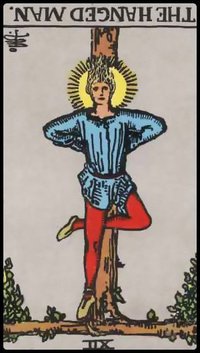
AHLQVIST:
We will show you fear in a handful of dust
London Bridge is falling down falling down falling down
Poi s'ascose nel foco che gli affina
Quando fiam ceu chelidon--O swallow swallow
Le Prince d'Aquitaine à la tour abolie
These fragments I have shored against my ruins
Why then Ile fit you. Hieronymo's mad againe.
Datta. Dayadhvam. Damyata.
Piiloitti hänet tuleen joka puhdistaa heidät
koska tulee minusta kuin pääsky -- Oi pääsky pääsky
Aquitanen prinssi sortuneessa tornissa
Näillä fragmenteilla tuen raunioni
Minä varustan teidät. Hieronymo on hullu taas.
Datta. Dayadhvam. Damyata
Shanti Shanti Shanti
Text by Ahlqvist
Installaatio peitti suurimman osan Alkovin ikkunasta mustalla.
/ An installation that covered most of Alkovi's window in black.
TOP / YLÖS
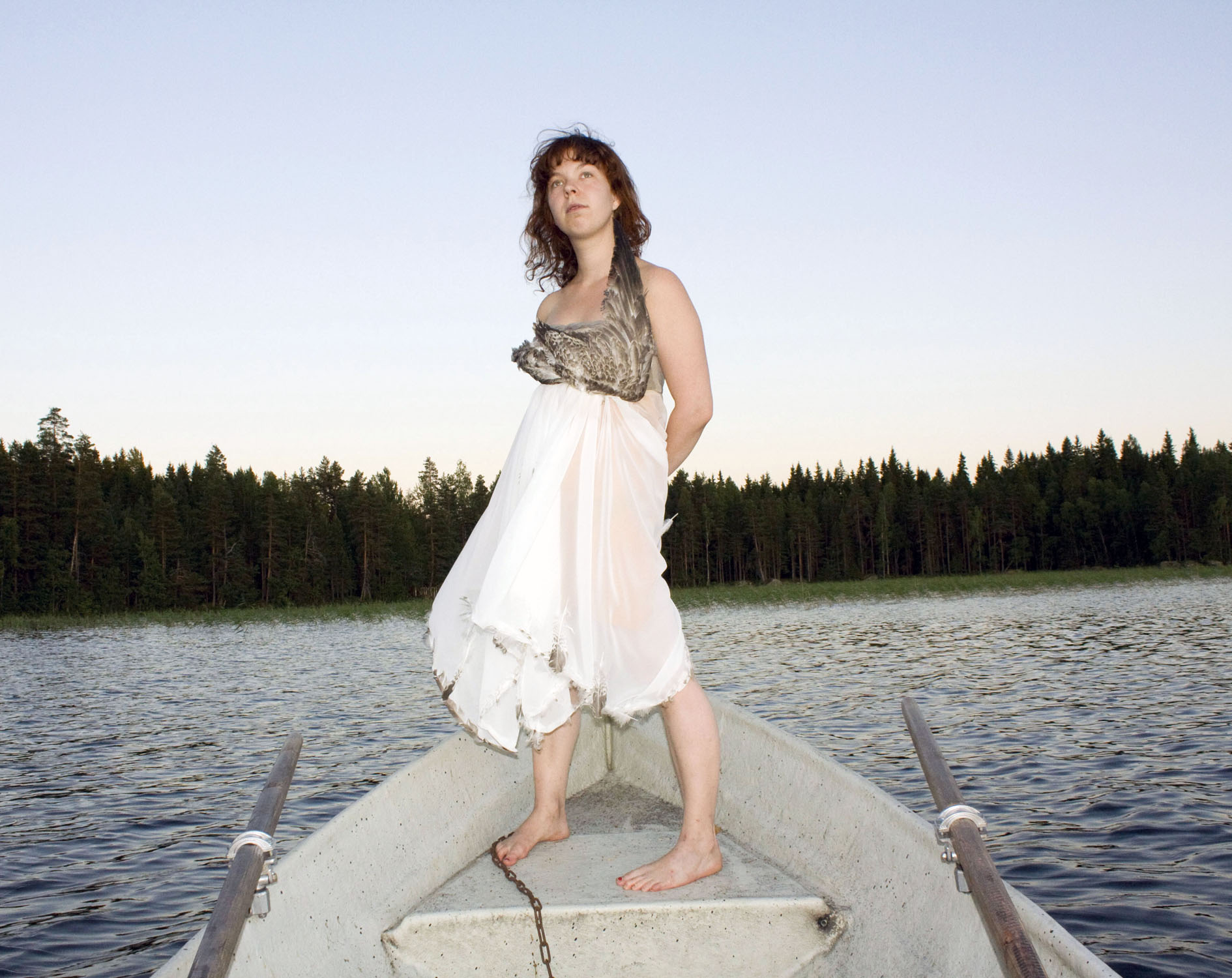
ROUTE COUTURE:
Fox On The Beach
[FIN] Route Couture -ryhmän teosten materiaalina ovat valtateiden varsilta kerättyjen yliajettujen eläinten nahat, sulat ja turkikset. Ryhmä nostaa roskana kohdellut kuolleet eläimet teiden varsilta muoti- ja taidekontekstiin. Teokset haastavat yleisön katsomaan mielikuvamainonnan ja tuotteelle imagoa rakentavan markkinointikoneiston lävitse. Route couture -projekti koostuu ryhmään kuuluvien taiteilijoiden yhdessä tai erikseen luomista teoskokonaisuuksista. Projektiin sisältyy esimerkiksi uniikkeja vaatemallistoja ja korusarjoja sekä muoti- ja taidevalokuvasarjoja. Ryhmä pyrkii kommentoimaan teoksillaan muotiteollisuutta, markkinataloutta, eläinten tehotuotantoa sekä nykyihmisen luontosuhdetta. Route Couture -ryhmän jäsenet Karoliina Paappa ja Leena Pukki esittivät Galleria Alkovissa ranta-asukokoelman, joka kului osana Spring Summer 2011 - On the Road -mallistoon. Route Couture -ryhmään kuuluvat Leena Pukki, Karoliina Paappa, Lari Lätti ja Stina Riikonen.
[ENG] Route Couture group uses as material the skins, feathers and furs of the roadkills collected from the highway offsides. The group brings dead animals considered as trash into context of fashion and art. The works challenge the audience to look beyond the illusion based advertisements and image building practices of the marketing machine. Route Couture project consists of the individual and communal contributions of the groups's artists. The project includes unique clothing lines and jewelry as well as fashion and art photography. Through its artwork group aims to comment fashion industry, market economy, mass production of animals, and peoples contemporary relationship to nature. To Alkovi the groups members Karoliina Paappa and Leena Pukki presented a beach wear collection as a part of Spring/Summer 2011 - On the Road -line. Members of the Route Couture group are Leena Pukki, Karoliina Paappa, Lari Lätti and Stina Riikonen.
TOP / YLÖS

JAANA LAAKKONEN:
Samalla seinällä
[FIN]"Kovin vallankumouksellinen en ole tähän mennessä ollut. Olen lukuisia kertoja levittänyt muutaman millimetrin paksuisen muovimaalikerroksen kuitulevypohjalle, asetellut väriläntit erijärjestykseen, lisännyt vettä väriin tai hangannut maalia pois. Välillä olen peittänyt kaikki värit valkoisella ja aloittanut alusta vaikka maalaushan voi olla millainen hyvänsä. Minua kiinnostaa suunnattoman paljon tämä järjestelytyö. Välillä löydän itseni häpeilemästä tekemääni järjestystä tai tuhoan järjestyksen ennen kuin kerkeän havaita sen hyväksi. Olen erittäin mielissäni kun löydän hyvän järjestyksen odottamattomalla tavalla. Olen tyytyväinen tähän hurjastelun muotoon, jossa maalia yritetään levittää ennakkoluulottomasti levylle ja aika-ajoin levyt järjestetään seinälle. Maalaaminen on ehdottamista itselleni, näyttely ja maalaukset ovat ehdotukseni katsojalle." Teksti: Laakkonen
Jaana Laakkonen on valmistunut Tampereen ammattikorkeakoulusta keväällä 2010. Vuonna 2011 hänen teoksiaan nähtiin B-Galleriassa, Turussa, yhteisnÃ?yttelyssä Taidehalli TR1 Projektitilassa ja yksityisnäyttelyssä TILANNE-galleriassa Tampereella.
[ENG] "A very revolutionary I haven't been so far. I have several times spread out a layer od a few millimeters of plastic paint on a fibreboard surface, placed various paint smudges in different orders, added water to the pigment or rubbed paint of. At times I have covered all the colors with white and started again afresh, even though, a painting can be whatever kind. I am terribly interested in this organizatory work. At times I find myself being ashamed of the order I have created or I destroy the order before I have achance to perceive it as good one. I am very pleased when I discover a good order in unexpected way. I am very pleased with this mode of frolicking in where paint is aspired to be spread on to the board without prejudice and at time to time the boards are arranged to a wall. Painting is making suggestions to myself, exhibition and painting are my suggestions to the viewer." Text by Laakkonen.
Jaana Laakkonen has graduated from Tampere University of Applied Sciences in 2010. Her works have been presented in solo shows , In the year 2011 her works were shown in Gallery B in Turku, at TR1 Kunsthalle in Tampere and in a solo show at TILANNE Gallery in Tampere.
TOP / YLÖS

IHO ON KEVYT VANKILA / SKIN IS A LIGHT PRISON
[FIN] Screening
9 videoteosta
"Iho on raja, ensimmäinen ja välitön pinta ulkoisen ja sisäisen tilan välillä. Se on tuntoherkkä muistutus fyysisestä ulottuvuudellisuudestamme, mutta myös sisäisiin tiloihin reagoiva elin. Keholla ja mielellä on omat intressit ja iho sitoo ne yhteen eläväksi kokonaisuudeksi. Teoksissa kaupunki hengittää ja hallinnanmenetys tuo rauhan. Kontaktia toisiin ihmisiin samanaikaisesti kaivataan ja kammotaan. Pakkomielteiden verkko tuo elämään turvallisuuden. Ruumis aina lopulta pettää ihmisen, mutta joskus mieli pettää ennen ruumista. Iho on kevyt vankila -näyttelyn teoksissa toistuvat ihmisen olotilaa tutkivat teemat. Ahdistuneen ensi-ilmeen alta löytyy vihjeitä vapautumisesta, rauhallisista eksymisistä ja suojelevista neurooseista."
Elokuvalliset taideteokset olivat Tampereen ammattikorkeakoulun kuvataiteen ja viestinnän opiskelijoiden vuonna 2011 toteuttamia. Ohjaajina ovat toimineet Fanni Niemi-Junkola ja Sari Tervaniemi.
Taiteilijat:
Teemu Riihelä. Tiina Lehikoinen, Nina Forsman, Irene Stachon, Laura Rytkönen, Jaakko Sorja, Minna Orvokki Korhonen, Anne Lehtelä, Katti E. Hellman
[ENG] Screening
9 video works
"Skin is the limit, the first and the most immediate boundary in between external and internal modes. It is a delicate reminder of the physical dimension of our existence, but it also reacts to the states of mind. As the body and the mind have their own interests, virtues, and inclinations, the skin bounds them together into one living entity. In the artworks the city is breathing and the loss of self-control brings peace. Contact with other people is graved after and avoided at the same time. Body will eventually let you down, sometimes the mind fails before the body. Skin is a light prison -screening shows works that explore recurring themes of human presence. After the pressing first appearences, there can be found clues of liberation, calm straying and protective neuroses.""
The cinematic artworks presented were created by the students of Tampere University of Applied Sciences, Shool of Art and Media, during the year 2011. The instructors were Fanni Niemi-Junkola and Sari Tervaniemi.
Artists:
Teemu Riihelä, Tiina Lehikoinen, Nina Forsman, Irene Stachon, Laura Rytkönen, Jaakko Sorja, Minna Orvokki Korhonen, Anne Lehtelä, Katti E. Hellman
TOP / YLÖS
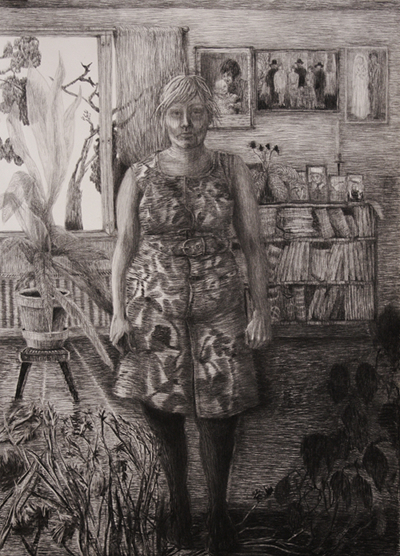
LAURA UKKONEN:
Turvallinen elämä / A safe life
[FIN] "Ympärilläni on seiniä. Ikkunoista ei vedä, haen lähikaupasta ruokaa, tilillä on rahaa. Verhot on ripustettu. Olen rakentanut kodin, odottelen onnea."
Näyttely koostui piirustuksista, joissa tarkastelun kohteena oli koti pyrkimyksenä kohti odotusten mukaista elämää sekä naiset näiden seinien sisällä. Ukkonen työskentelee dokumentaarisesti sekä piirtäen että kirjoittaen, seuraten itseään, perheenjäseniään ja ystäviään. Piirtämisen tuloksena syntyy anonyymejä henkilökuvia, joissa on palasia monista tiloista, henkilöistä ja sukupolvista. Koti voi toimia sekä suojana että eristäytymisen tilana. Se on perinteisesti myös ollut naisten tila, huone, jota on rakennettu kertomaan muille hyvästä elämästä: sekä saavutetusta elintasosta että emotionaalisesti turvallisesta elinympäristöstä. Sillä on siis (ollut) yksityisen, muiden näkymättömissä olevan luonteensa lisäksi julkinen tehtävä niin sanotusti onnellisen elämän näyttämönä. Paradoksaalisesti aineellisesti hyvinvoiva yhteiskuntamme tuottaa kuitenkin myös yksinäisyyden tiloja ja tähän liittyen mm. syömishäiriöitä. Näyttelytilana Alkovi mahdollistaa kodin sisätilojen kääntämisen kadulle nähtäviksi.
Laura Ukkonen (s.1977) on helsinkiläinen kuvataiteilija. Näyttelyn toteutusajankohtana Ukkonen opiskeli Aalto-yliopiston Taideteollisessa korkeakoulussa kuvataiteen maisteriohjelmassa. Aiemmin Ukkonen on opiskellut mm. taidehistoriaa, naistutkimusta ja vaatesuunnittelua. Tämä muodostaa taustan työskentelylle, joka keskittyy feminiinin maailman ilmiöiden tutkimiseen.
[ENG]"I am surrounded by walls. There is no draught from my windows, I buy my food from the closest supermarket, I have money on my bank account. I've built myself a home, now I am waiting for happiness to come."
The exhibition consisted of drawings that observed home as an attempt to reach a life that you are expected to live. The drawings were also portraits of women living inside these walls. Ukkonen works in a documentary way by writing and drawing. She observes herself, her family members and her friends. Because she uses drawing the results are anonymous portraits consisting of many spaces, characters, and generations. A home can be a shelter as well as a place of isolation. It has traditionally also been a space of feminine power that women have built up in order to tell their community about a life well spent: about certain living standards and an emotionally safe living environment. Thus, a home has also (had) its public nature as a stage for the so called good life. As a paradox, our welfare state also produces states of loneliness, and linked to this for example eating disorders. As an exhibition space Galleria Alkovi enables turning private interiors visible to the public space of the street.
Laura Ukkonen (s.1977) is an artist based in Helsinki. During the time of the exhibition (2011) she studied in the Master's degree programme for fine arts in the Aalto University, School of Art and Design. Her previous studies consist of art history, women studies and fashion design. This forms a background for her work that focuses on the research of different phenomena of the feminine world.
TOP / YLÖS
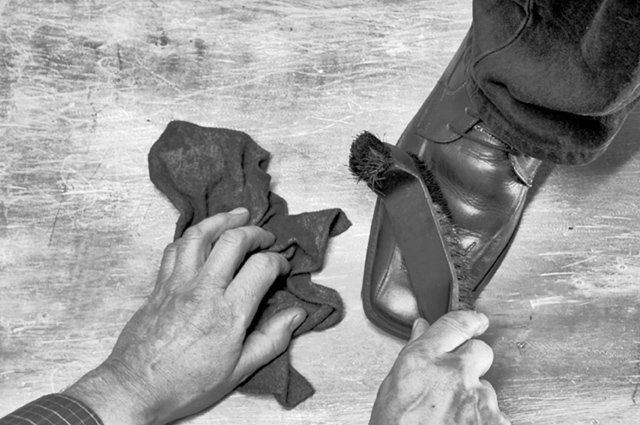
AULISJAHEIKKI
[FIN] Näyttelyssä tekijät - yhteisnimellä 'AulisjaHeikki' - kysyivät: Mitkä ovat yhdessä olemisen minimivaatimukset? Ja onko hedonistisessa maailmassa kykyä ja halua toimia yhdessä? Tekijät vastasivat, että "yhdessä kulkeminen voi olla välttämättömyyttä ja pakkoa tai itsenäisyyttä ja riippumattomuutta. Se voi olla oikeus tai velvollisuus. Yhteisen hyvän näkeminen ja rakentaminen edellyttää samaan suuntaan kulkemista. Auttamisen halun lisäksi tarvitaan kykyä toimia muillakin kuin omilla ehdoilla." Näyttelyn yhteydessä tarjottiin taidepalveluna kengänlankkausta ohikulkijoille.
'Aulisjaheikki' on taide- ja elämänkumppanuus duo. Aulisjaheikin taiteellinen yhteistyö alkoi vuonna 2010 tapahtumassa 'Parisuhdeveistos omassa kodissa', joka oli myös taiteilija Aulis Harmaalan maisterin lopputyön osa Aalto Yliopistossa.
[ENG]In the exhibition the working duo under the name 'Aulisjaheikki' inquired what are the minumum requirements for 'going together'? They asked also: do we have the ability and the will to work in mutual co-operation in this hedonistic world? The artists answered themselves that "To traverse together may be a necessity and a force, or independence and freedom. It may, as well, be a right or an oblication. A prerequisite to see and to build up common well-being, is the sense of going into the same direction. In addition, to the desire of assisting, we need the talent to work not only according to our own conditions but to take the co-travellers into account." During the exhibition the duo also offered shoe polishing on the passers-by. Aulis and Heikki are partners in art as well as in every-day-life. The alter ego 'Aulisjaheikki' states that it "seeks for a harmonious way to picture the world of dissonance." Their artistic cooperation started in their installation 'A Sculpture on the Theme of Relatioships, 2010.' which was the thesis piece of artist Aulis Harmaala for his M.A. degree in the School of Art and Design / Aalto university.
TOP / YLÖS

ARTELES: Satellite Platform
RICHARD IBGHY & MARILOU LEMMENS:
Demand Curves for Transcendence
[FIN]Yhteistyössä Hämeenkyrössä toimivan Arteles residenssin kanssa toteutettiin sekä Satellite Platform -tapahtuma, että residenssissä vierailevien taiteilijoiden Richard Ibghyn & Marilou Lemmensin näyttely.
"Satellite Platfrom on esitysformaatti, jossa eri taidealojen toimijat ja asiasta kiinnostuneet henkilöt esittelevät työskentelyään ja tutustuvat toisiinsa. Satellite Platform on kannanotto ja ehdotus sille miten galleriatiloista voitaisiin tehdä ihmisten paikkoja ja aktiivisia olohuoneita. Mihin tarvitsemme galleriaa, jossa vierailijoita on vain avajaisissa ja sen jälkeen tila on kolme viikkoa tyhjillään? Ja avajaisissakin 95% vieraista vain harva jaksaa puhua enää itse pääkohteesta eli esitettävästä taiteesta. Postmodernismin jälkeen estetiikasta on tullut henkilökohtainen makuasia jota ei tulisi voida arvostella. Siksi kentän painoarvo on makaa verkostoitumisessa ja olemassa olevien kontaktien ylläpitämisessä. Se on ok, mutta asioista pitäisi pystyä rehellisesti ja selkeästi, jotta asiat voisivat mennä eteenpäin. Loppupeleistä se on kaikkien etu, josta hyötyvät kaikki." Teksti: Arteles
Satellite Platformissa oli esillä teoksia neljältä taiteilijalta:
Derek Larsonin (Yale School of Art, MFA) videoteokset yhdistelevät sekä rationaalisia, että absurdeja elementtejä uudella tavalla keskenään. Usein hän käyttää myös itseään yhteneä elementtinä osana videoidensa esittämistilaisuutta.
Japanilainen Takeshi Moro (The School of the Art Institute of Chicago, MFA) on soluttautunut Suomessa yksityishenkilöiden saunoissa lehti-ilmoitusten perusteella. Saunonut isäntäväen kanssa ja napannut heistä sielukkaita kuvia.
Emese Hruska on nuori ja nouseva unkarilainen viulusti joka on tehnyt uuden alue valtauksen kriittisen radio-ohjelman parissa, joka kuullaan Alkovissa kuulokkeiden kautta.
Carol Müller toimii lehtikuvaajana Pariisilaiselle Le Monde sanomalehdelle. Residenssin aikana hän on keskittynyt muuttumaan osaksi suomalaista luontoa ja tehnyt analogista ja digitaalista valokuvaa yhdistäviä kokeiluja.
[ENG]Two events were organized in collaboration with the Arteles residency in Hämeenkyrö; Satellite Platform event and an exhibition by the artists Richard Ibghy & Marilou Lemmens that were visiting the recidency.
SATELLITE PLATFORM was a presentation format that inhabited (Gallery) Alkovi for two days in 28th and 29th of December. In satellite platform different actors on the art scene and people interested on the field meet, discuss, present their work and get to know each other. It is a statement and proposition on how to make galleries into places for people, to work as active living rooms. In these presentations there are works from four artists: Derek Larson (Yale School of Art, MFA) makes videoworks combining rational and absurd elements in a new way. Japanese Takeshi Moro (The School of the Art Institute of Chicago, MFA) has infiltrated private saunas. Emese Hruska in a Hungarian violinist, who has made a critical radio show. Carol Müller has made experiments combining analog and digital photography.
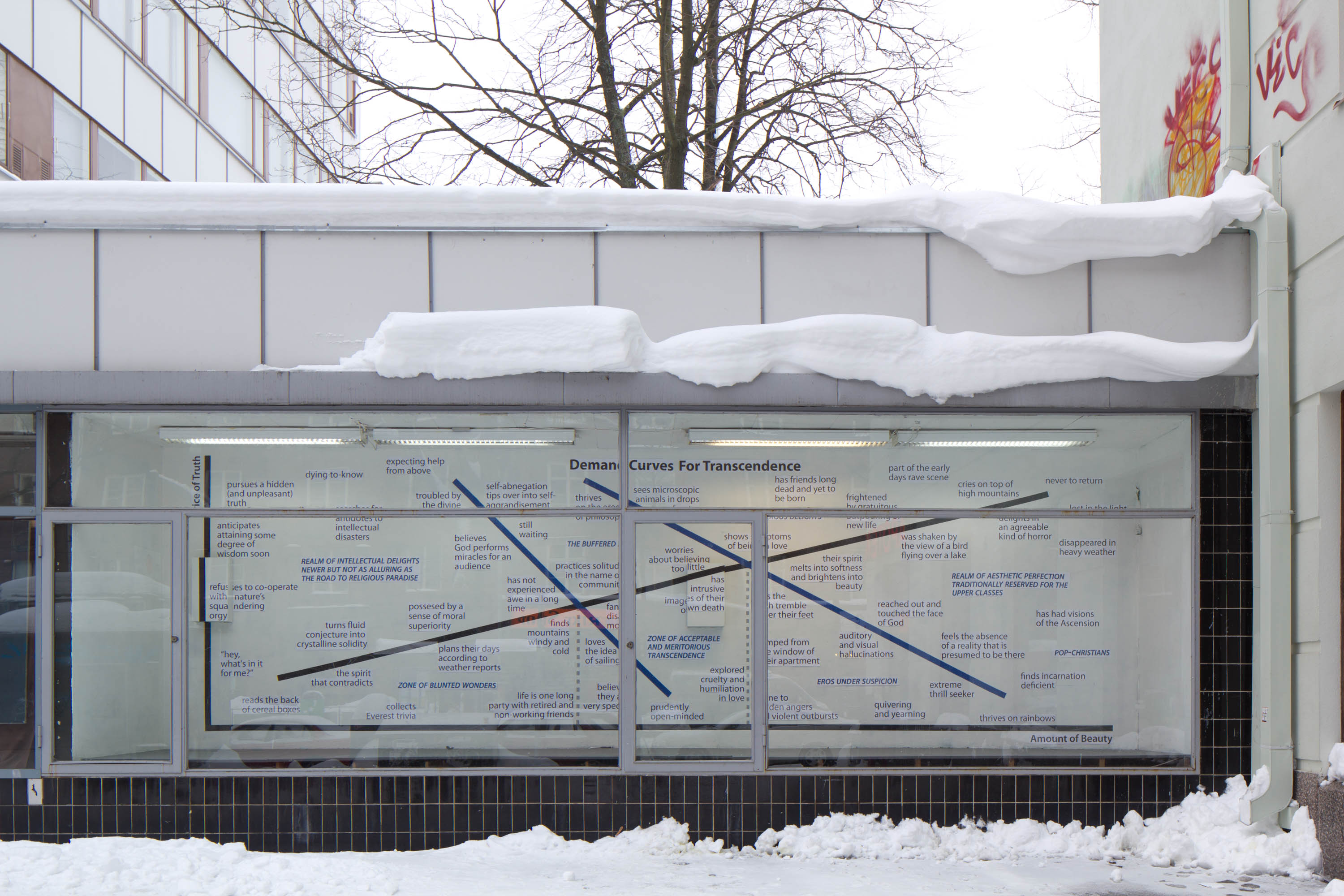
[FIN] "Demand Curves for Transcendence" oli Richard Ibghyn & Marilou Lemmensin projekti, joka oli kehitetty heidän vierailunsa aikana Arteles -residenssissä Hämeenkyrössä. Idghy & Lemmens muuttivat gallerian ikkunan spekulatiiviseksi mittaustyökaluksi tehdäkseen nähtäväksi yhteiskunnallisia uskomuksia ja yksityisiä intohimoja, jotka ylläpitävät nykytaloutta.
[ENG] In "Demand Curves for Transcendence" Richard Ibghy & Marilou Lemmens have collected an array of contemporary attitudes towards the desire for transcendence from everyday life, popular culture, historical sources, and academic scholarship, and have mapped these onto an economic demand curve. This new work will transform the gallery front window into a speculative measurement device able to make visible and readable social beliefs and individual passions that sustain current economies, but also able to carry the potential for inciting new forms of understanding and doing economy." Text by Ibghy & Lemmens.
TOP / YLÖS

OLGA PALOMÄKI:
Huone
[FIN] Autiotalot ovat kuin museoituja ajankuvia. Niiden tunnelma on unenomainen - ne vangitsevat sisälleen arvoituksia. Kun ihmisen rakentama ympäristö palautuu kohti luonnontilaa, jokin vääristyy, ja rakennus muuttuu kiehtovaksi. Rakennetun ympäristön jatkuva muuttuminen ei välttämättä kerro uudistusten tarpeellisuudesta. Taloudellisen hyödyn maksimoiva arkkitehtuuri ei muistuta meitä ajan kerroksista. Autiotalojen hiljaisuus on puhuttelevaa. Installaatio- ja valokuvanäyttely 'Huone' jatkaa autiotalojen keskeneräisiä tarinoita. Teksti: Olga Palomäki
[ENG] Abandonned houses are like zeitgeist 'museumed'. Their atmosphere is dreamlike, they encapture mysteries inside them. When human-built environment returns back to natural state, something is distorted and a building becomes interesting. The constant changing of the constructed environment doesn't necessarily tell about the need of improvement.Architecture that maximises ecnoomic gain doesn't remind us of the layers of time. The silence of abandonned houses is influensal. Installation and photography exhibition Room shares the unfinished stories of those abandonned houses. Text by Olga Palomäki.
TOP / YLÖS
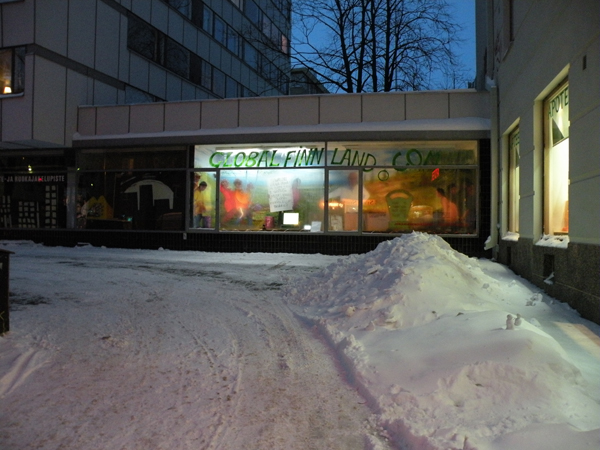
WILD-BERRY POSTCARD FROM SELF-EMPLOYED TOURISTS
Second Forest -project together with Mikko Lipiäinen, Richard Thompson Coonin and Junya Lek Yimprasert as a part of international X-op -art event
Wild-Berry Postcard from Self-Employed Tourists
An installation about the exploitation of the Finnish Everyman's Right and global migrant labour by the globalizing Finnish wild-berry industry.
"Why must small-scale farmers from north Thailand travel to Finland to pick wild-berries and their daughters sell their souls in Pattaya?*
Because, in the on-going neo-liberal globalizing of food supplies, agricultural policies in Thailand are still no exception to the overall trend to terminate small-scale farming and force, all around the world, hundreds of millions of rural people off the land into desperate struggle with cycles of poverty and debt.
For some years thousands of neglected Thai farmers have been travelling to Sweden and Finland to pick wild forest berries for Scandinavia's expanding wild-berry industry but, despite high expectations, when their 2-3 month stint of virtual slave-labour ends, more than half these pickers find themselves in worse financial debt than when they left home.
"What kind of industry bases profitability on the massive work input of ready-made oppressed small farmers?"*
Recent heavy investment by the Finnish wild-berry processing companies is entirely based, and dependent upon, the importation of cheap Asian labour: rural workers that are seduced and invited to come to Finland as 'self-employed tourists' to work 15 hours a day for the berry-processing companies on tourist visas. The companies, and the state authorities, are eager to present themselves as good hosts - as hosts for example of exciting Scandinavian berry-safaris.
In reality these companies, and the state authorities, are just exercising a tired corporate logic that values money above human beings and nature. They are, furthermore, ruthlessly exploiting the Finnish Everyman's Right: turning our forests into corporate playgrounds.
The naïve logic of the Finnish wild-berry industry and the growing scale of the commercial exploitation is becoming unbearable and stands, now, in direct confrontation with our common, cultural heritage, notably the free and peaceful exercise of the Everyman's Right in rural areas.
The rapid, uncontrolled growth and globalization of the Finnish wild-berry industry is impacting directly on many core aspects of Finnish society and culture and requires immediate attention. The state must be held to account for promoting this corporate abuse of Labour Law and the Everyman's Right.
For the well-being of small farmers and poor people everywhere, for the future of Finnish culture, in the name of the spirit of our Everyman's Right, artists and cultural thinkers must engage, now, in the future of our forest resources - not only in terms of documenting, analyzing and criticising, but through envisioning the pathways that society could take. This means much more active engagement in the exploration and examination of ways and means that could produce healthy, new, sustainable balances between 'Nature and Employment' that fully respect the spirit of our Everyman's Right.
Designed and produced by artist-activist Richard Thompson Coon and labour-activist Junya Yimprasert in collaboration with the Art Collective Hirvitalo in Tampere, with assistance from Mikko Lipiäinen, Teemu Takatalo, Suva, Ismo Torvinen, Ben and Anton Thompson Coon, Kristiina Puukari.
Curated by Second Forest Project, Hirvitalo Art Collective / Mikko Lipiäinen.
Sponsored by SASK, Taidekoulu MAA, Alfred Kordelinin säätiö, Diivari Oy, Oy FF Filmfotograferna AB.
The installation formed a part of the X-OP Platform Helsinki which presents the international X-OP network to the art scene in Helsinki, and gathers local artists to reflect on current societal questions
TOP / YLÖS
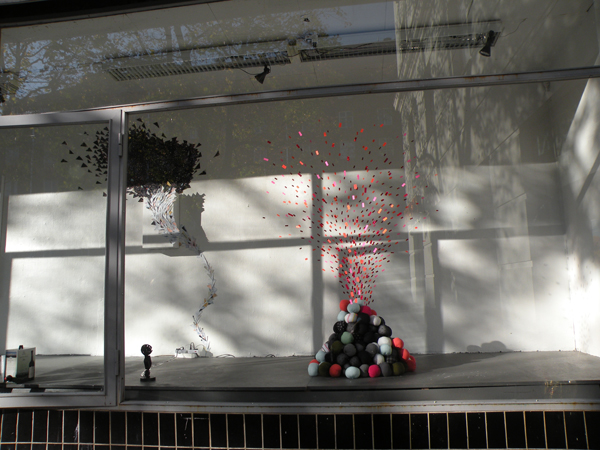
AINO LOUHI:
Hasardimaantiede
[FIN]"Hasardimaantiede oli lempikurssini lukiossa. Neljännen kerroksen hapettomassa luokkahuoneessa, paksujen verhojen pölyntuoksussa, uurteiseen pulpetinkanteen nojaten oli turvallista kuulla ihmistä suuremmasta tuhovoimasta. Pelko oli abstraktia ja jännittävää, kärsimykset kaukaisia ja epätodellisia. On mahdotonta edes yrittää toistaa sitä tuhoa, mitä luonto voi saada aikaan. Siksi oma maantiedon oppituntini on leikkisä ja kaunis; purkaukset ovat onnellisia roiskeita seinillä, vuoret pieniä ja vyöryt pehmeitä. Tornado on pysähtynyt huokaisemaan vihaisella matkallaan kylästä toiseen." Teksti: Aino Louhi
Aino Louhi (s.1981) on tamperelainen kuvataiteilija, joka kävi lukionsa Torkkelinmäellä. Hän palasi tuttuihin maisemiin ja koulumuistoihin ensimmäisellä Helsingin näyttelyllään Hasardimaantiede (Galleria) Alkovissa.
[ENG]" 'Hazardimaantiede' (Hazardgeography) was my favourite class in high school. It was safe to listen about the destructive powers larger than human being in the oxygen-less class room on the fourth floor, in the musty smell of the curtains, leaning on the carved cover of the desk. Fear was abstract and exciting, sufferings far away and unreal. It is impossible to even try to repeat all the havoc that nature can make. That is why my own lecture of geography is playful and beautiful; the eruptions are happy spurts on the wall, mountains small and avalanches soft. Tornado has stopped in order to sigh on its angry way from village to village." Text by Aino Louhi. [Translation: Miina Hujala]
A Tampere based visual artist Aino Louhi (b.1981) presented her first exhibition in Helsinki at (Gallery) Alkovi. In the exhibition called 'Hazardgeography' she returned to familiar scenery and memories of her high school times (the school is situated nearby Alkovi at Torkkelinmäki in Kallio).
TOP / YLÖS

Media Facades -Festival:
KALLION 25. TUNTI / 25th hour of kallio
Yhteistyössä mediakulttuuriyhdistys m-cultin kanssa. / In collaboration with m-cult Media Art organization
[FIN] Alkovi (galleria) osallistui Media Facades -festivaaliin kutsumalla ryhmän liikkuvan kuvan tekijöitä työskentelemään viikonlopun ajaksi Kallion kaupunginosan alueelle. Tämän videoprosessin tarkoituksena oli tarkkailla kaupunkitilaa sosiaalisena paikkana, poliittisena kenttänä, mediatilana ja urbaanina rakennelmana. Teosten tuottaminen viikonlopun nopealla aikataululla rohkaisi taiteilijoita reagoimaan intuitiivisesti kaupunkiympäristöön ja tarttumaan välittömiin kokemuksiin. Kaupunki toimi paitsi teosten lähtökohtana myös lavana tai lavasteena ja kaupungin asukkaat sekä katsojina että myös materiaalina teoksille. Vaikka teosten toteutus tapahtui vain muutaman päivän sisällä, oli prosessi pantu jo käytiin kesän aikana useissa keskustelutapaamisissa ryhmän kesken. Keskustelut sivusivat kaupunkitilan olemuksen tarkastelua ja kaupunkikulttuuria, paikkasidonnaisuutta taiteessa, taiteen sosiaalisia ulottuvuuksia, liikkuvaa kuvaa mediana. Lähtökohtanamme on ollut käsitellä taiteen tekemistä myös avoimena ja yhteisenä luovana prosessina, jossa ajatuksen vaihto on vapaata ja aiheet voivat sekoittua keskenään.
Viikonlopun aikana oli mukana vaatteidenvaihtoa, "jäniksenä" ihmisten matkassa liikkumista,mainoksia, arkkitehtuuria, internet kuvamateriaalia, puita ja muita liikkuvan kuva kautta ilmaistuja visualisointeja. TheNeverland.fi -projekti etsi uusia näkökulmia maahanmuuttokeskusteluun keskustelu järjestettin Sörnäisten metroasemalla, keskustelusta esilllä dokumentaatiotraileri.
KALLION 25. TUNTI taiteilijat: Maria Candia, Miina Hujala, Mikko Keskiivari,Hannele Kirjavainen, Mari Keski-Korsu, Kalle Kuisma, Arttu Merimaa, Sari Palosaari, Kristiina Puukari, Johanna Raekallio, Sari Tervaniemi, Tytti Viljanen, Eero Yli-Vakkuri
[ENG] Alkovi (gallery) participated in Media Facades -festival by inviting artists working with moving image to produce pieces in Kallio during a weekend. This process was meant to explore the city space as a social place, political field, media environment and as a urban construction. The pieces and project have been fueled by discussons and meetings with the group.
During the workshop group made all kinds of works about about city environment, for example The Neverland.fi project searched for new viewpoints to the dicussion about immigration and organized discussion at Sörnäinen metro station. The works involved clothes swapping, "travelling with strangers", internet fused imaginary, architecture, life of trees, adverts, sexuality and reserch among other things.
Artists of 25th hour of Kallio: Maria Candia, Miina Hujala, Mikko Keskiivari,Hannele Kirjavainen, Mari Keski-Korsu, Kalle Kuisma, Arttu Merimaa, Sari Palosaari,Kristiina Puukari, Johanna Raekallio, Sari Tervaniemi, Tytti Viljanen, Eero Yli-Vakkuri.
TOP / YLÖS

ADIOS
"I went to pick my cousin up from preschool and there stuff was way better than this" - E-mail from Kyle Barker
Taiteilijat / Artists: Konsta Ojala, Timo Vaittinen, Mark Kuivanen, Janne Martola
[FIN] 'Adios' oli taiteilija Konsta Ojalan toimittama uuden, alakulttuureissa kasvaneen taiteen teossarja. Siinä yhdistyvät villi katutaide, fanzine-kulttuurin röyhkeys sekä vaihtoehtoinen tapa tehdä, kokea ja elää. Sarjan tekijät edustavat pääosin uutta suomalaista gallerioiden ohi kasvanutta taiteilijuutta, joka on kerännyt huomiota kotimaan sijaan enemmän ulkomailla, eri puolilla maailmaa. Adios-kirjan, sekä näyttelyn taiteilijat: Germes, Mark Kuivanen, Janne Martola, Tommi Musturi, Samu Nyholm, Konsta Ojala, Sauli Sirviö, Timo Vaittinen ja Vilunki3000.
[ENG] 'Adios' was art series for the new and undergroud activities within art. The works were edited by artist Konsta Ojala. It combined wild street art, the arrogant fanzine-culture and alternative way of doing, experiencing and living. The artists in the series represent mainly new finnish art scene that is out-grown from galleries and gather attention more abroad than in homeland. Artists of Adios-publication as well as the exhibition at Alkovi were: Germes, Mark Kuivanen, Janne Martola, Tommi Musturi, Samu Nyholm, Konsta Ojala, Sauli Sirviö, Timo Vaittinen ja Vilunki3000.
TOP / YLÖS

UNELMIEN HELSINKI / HELSINKI OF DREAMS
Työpaja / Workshop
[FIN] Omaiset huumetyön tukena ry:n jälkipolku ohjelman 'Unelmien Helsinki'-taidetyöpaja, jossa nuorten tehtävänä oli kuvata unelmiensa Helsinki välineenään valokuva, piirustus ja maalaus. Työpajan vetäjinä toimivat valokuvaaja Marek Sabogal ja taiteilija Konsta Ojala
[ENG]'Helsinki of Dreams' art workshop was organized by the Family Supported Drug Rehabilitation Association. The youth were given a mission to picture the Helsinki of their dreams by using photography, drawing or painting. The workshop was led by photographer Marek Sabogal and artist Konsta Ojala.
TOP / YLÖS
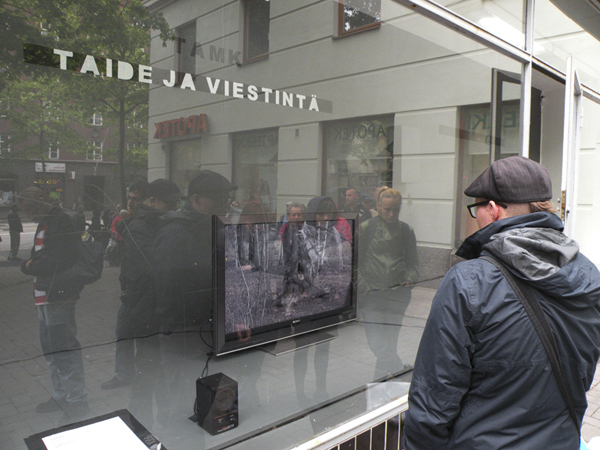
KÄTKETTY -SCREENING
7 videoteosta / 7 video works
[FIN]Tampereen ammattikorkeakoulun kuvataiteen ja viestinnän opiskelijoiden elokuvallisia teoksia. Janne Keräsen, Outi Tienhaaran, Aino Sunin ja Nalle Mielosen teokset käsittelevät kukin omasta näkökulmastaan paljastuksen, löytämisen ja vapautumisen teemoja. Teokset leikittelevät todellisuuden eri tasojen limittymisellä ja niiden ylityksillä. Laura Rytkönen tarkastelee perheen sisäisiä voimasuhteita videoteoksessaan Perhe-esitys. Päivi Viinikaisen ja Mikko Keskiivarin video BURN-IN kyseenalaistaa työyhteisössä tapahtuvan sosiaalisen käyttäytymisen rajat. Mitä tapahtuu kun lapsenomainen käytös muuntuu todeksi, hyväksyttäväksi ongelmanratkaisuksi? Karoliina Paapan A Small Study of Woe (Woe is me!) on surrealistinen animaatio, jonka kautta tekijä tutkii itsetuhoista käyttäytymistä ääritilanteissa. Teokset ovat syntyneet pääasiassa osana taiteen koulutusohjelman elokuvallisen taideteoksen kurssia vuonna 2009-10. Kurssin ohjaavina opettajina toimivat taiteilijat Fanni Niemi-Junkola ja Tellervo Kalleinen.
[ENG] Students from the University of Applied Sciences in Tampere present their works in a screening in Alkovi Gallery. Janne Keränen, Outi Tiehaara, Aino Suni and Nalle Mielonen deal each from their own perpective the issues of revealing, finding and liberelizing. The pieces play with the interlacing of different levels of reality and of the crossing of those layers. Laura Rytkönen examines the inner power relationships of a family in her video piece Perhe-esitys. Päivi Viinikainen ja Mikko Keskiivari present a video called BURN-IN that questiones the borders of social conduct in a a work community.What happens when a child-like behaviour turns into reality as an acceptable solution. Karoliina Paappas A small study of Woe (Woe is me!) is a surrealistic animation, thru which the she studies selfdestructive behaviour in extreme situations. The works have been made mainly as a part of a course of cinematic studies in the years 2009-2010. The instructive teachers for the course were Fanni Niemi- Junkola and Tellervo Kalleinen.
TOP / YLÖS

FANNI NIEMI-JUNKOLA & MINNA SUONIEMI:
Luontokuvia / Wild life
[FIN] Näyttely esittelee videoteokset 'Lepakko' , jonka tekijä on Minna Suoniemi (2008) ja 'Torni', jonka tekijänä on Fanni Niemi-Junkola,2008). Molemmissa teoksissa ihminen nähdään sekä osana ympäristöä että yhteisöstä vieraantuneena. Teoksia katsoessa herätellään kysymystä paikan ja ihmisten välisistä jännitteistä - Miksi he ovat siellä?
Minna Suoniemi (s.1972) työskentee liikkuvan kuvan ja valokuvan installaatioiden parissa.
Fanni Niemi-Junkola (s.1962) on tehnyt useita video installaatioita ja filmi teoksia.
[ENG] The exhibition presents two video works 'Bat' by Suoniemi (2008) and 'Tower' by Niemi-Junkola (2008) of two artists. In both pieces the individual is seen as part of the environment, but simultaneously alienated from society. The exhibition awakes a question of tension between a place and its people - Why are they there?
Minna Suoniemi (b. 1972) works with moving image and photography installations.
Fanni Niemi-Junkola (b.1962) has made video installations and film works.
TOP / YLÖS
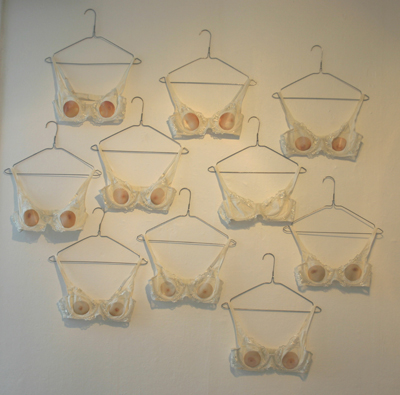
MARGARITA ROSSELLÓ RAMÓN:
A New and improved you
[FIN] Rosselló Ramónin (s.1982) päämateriaali on tekstiili, jota hän käyttää eri tavoin. Alkoviin hän toi esille teoksia, joissa pohdittiin mitä mainokset meille tarjoavat ja mitä ne meiltä odottavat.
[ENG] Rosselló Ramón (born 1982) uses textile as her main material which she uses in different ways. In Alkovi she presented works that reflected on the question of what advertisements offer to us and what they expect from us.
TOP / YLÖS
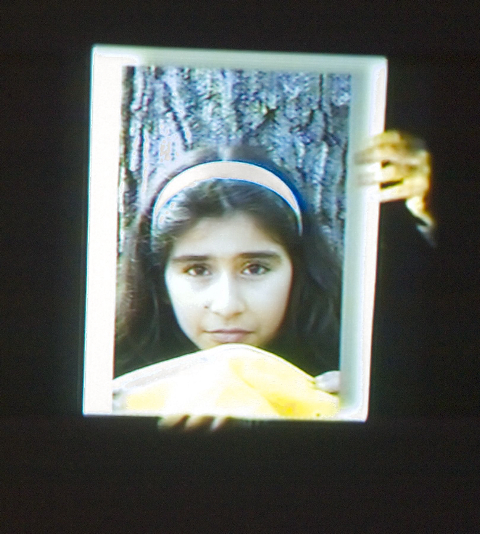
RAMAN HUSSAIN:
Toivoin hymyjä! / I wished for smiles!
[FIN] "Olen kuvannut kymmentä pakolaislasta (irakilaisia, iältään 8-16v) toissa kesänä pakolaisen kesäleirillä. Tarkoitukseni oli saada esiin heidän kadoksissa ollut ilonsa, hymy kasvoilla, joka ei kuitenkaan onnistunut. Toiveeni on kuitenkin nähdä jälleen hymy heidän kasvoillaan joten olen halunnut piirtää sen heille. Näyttely koostuu video-installaatioista, veistoksista, piirustuksista sekä valokuvista." Teksti: Raman Hussain
Raman Hussain on irakilaissyntyinen, Suomessa asuva kuvataiteilija. Hän opiskeli kuvataidetta Bagdadin kuvataideakatemiassa ja Tampereen ammattikorkeakoulussa ja on lisäksi suorittanut pedagogiset opinnot Tampereen yliopistossa. Hän on asunut Suomessa vuodesta 2003.
[ENG] "I have photographed ten refugees (from Iraq, aged 8 - 16 years) at the refugee summer camp on the previous year. My intent was to bring forth their missing happiness, the smile on the face. This did not succeed. Nevertheless, my hope is again to see the smile on their faces so I wanted to draw it for them. The exhibition consists of a videoinstallation, sculptures, drawings and photographs."Text by Raman Hussain
Raman Hussain is irak-born artist that currently lives in Finland. He has studied Fine Arts at Bagdad Fine Art Academy and in Tampere University of Applied Sciences, in addition to these he has done pedagogical studies from Tampere University. He has lived in Finland from 2003.
TOP / YLÖS
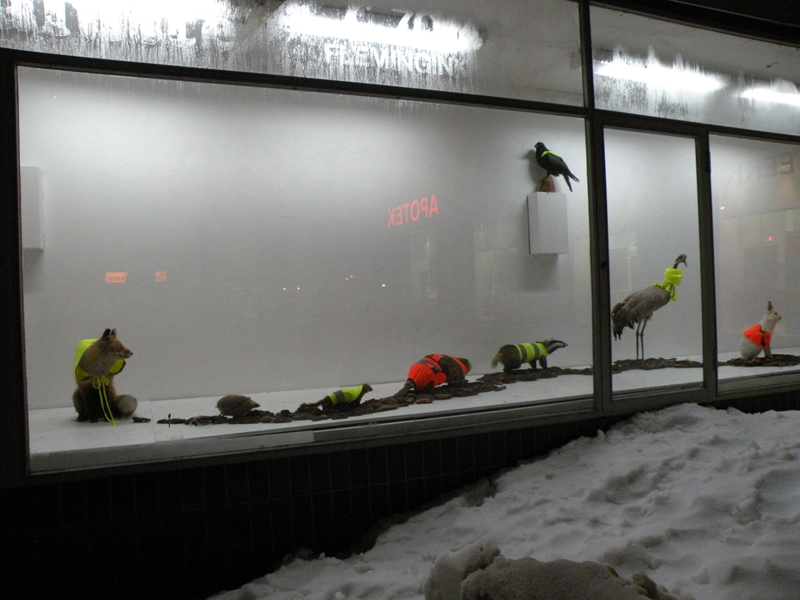
TIINA VEHKAPERÄ:
Vaellus
[FIN] Kuvanveistäjä Tiina Vehkaperän teos Vaellus koostui kymmenestä täytetystä eläimestä, kankaasta ja kaarnasta. Teos oli valmistunut Seinäjoen Taidehallin Kokous-ryhmänäyttelyyn joulukuuksi 2009.
[ENG]Sculptor Tiina Vehkaperä's work Vaellus (The Wandering) consisted of ten stuffed animals, cloth, and bark. The work has been made for Seinäjoki Kunsthalle's Kokous (Meeting)-group exhibition in December 2009.
TOP / YLÖS
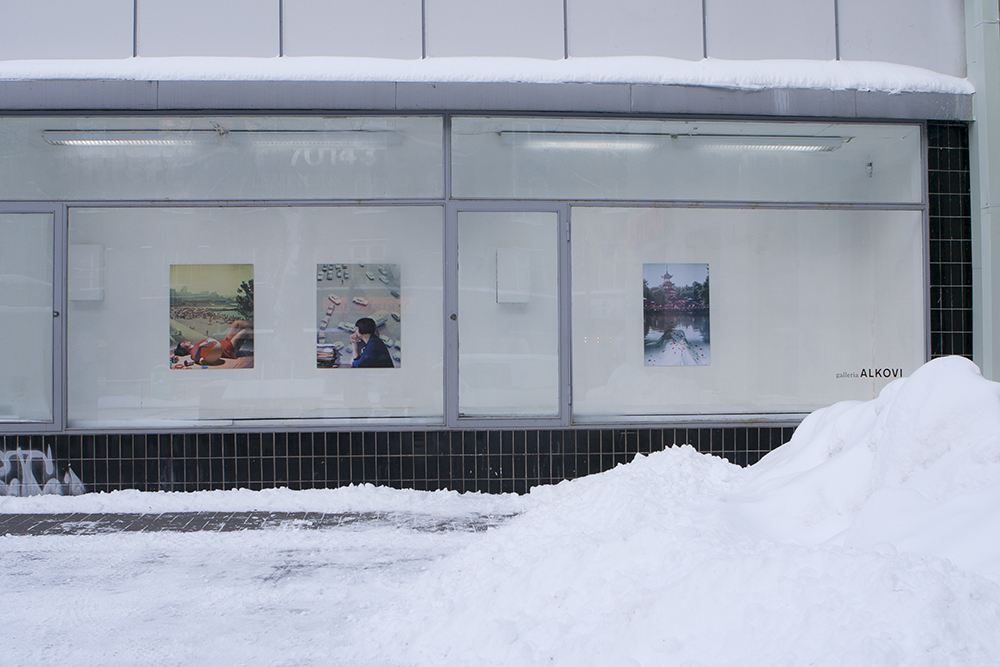
TIINA RIUTTA:
Meaning in Life
[FIN] Kolmen valokuvan sarja 'Meaning in Life' tekee lyhyen tiivistelmän elämästä ja sen mahdollisuuksista.
"Eräänä päivänä teen löydön: sata kappaletta tuntemattoman matkailijan valokuvaamia dioja 1960-luvulta. Ostan ne. Siitä tulee minulle enemmän kuin matka - seikkailu. Katselen kuvia. Näen vieraita kaupunkeja, outoja katuja, rantoja, lumiset Alpit, tuntemattomia ihmisiä. Katson niitä yhä uudelleen pysähtyen hetkeksi joihinkin paikkoihin. Alan miettiä, mitä siellä tapahtuu. Aluksi rakennan näyttämön heijastamalla diakuvat suurelle taustakankaalle. Minä olen ohjaaja, ystäväni toimii mallina. Vaatetan, kampaan, valaisen, valokuvaan. Se muistuttaa esitystä vaihtuvine näyttämöineen, yleisönä vain minä ja hetket pysäyttävä kamerani. Meille se on kuin leikki, jossa kohtaavat mennyt aika ja nykyisyys. Molemmat ajat saavatkin näkyä; se oli totta ja tapahtui." Teksti: Tiina Riutta
Tiina Riutta (s. 1970) on opiskellut valokuvausta Ylöjärvellä, Tampereella sekä Taideteollisessa korkeakoulussa Porissa.
[ENG] The photography series 'Meaning of Life' consists of three pictures. It`s a short synopsis of life and the possibilities in life.
"One day I find unexpectedly a box including one hundred slides photographed by an unknown traveller in 1960`s. I buy them. For me it becomes more than a travel - an adventure. I watch pictures and see foreign towns, strange streets, beaches, snowy Alps, unknown people. I watch them again, and I stay for a while in some places. I start to imagine what is happening in there. At first I make a stage by projecting the slides to a huge background. I`m a director, and a friend of mine is performing. I`m clothing, and combing, I`m lighting, I`m photographing. It seems a play with changing scenes, the audience is just me and the time stopping camera of mine. For us it is like a play, where two different periods, the past time and the present are facing. Both periods are allowed to be seen; that is what happened and what was real." Text by Tiina Riutta
Tiina Riutta (1970) has studied photographing in Ylöjärvi, Tampere and in the University of Art and Design in Pori.
TOP / YLÖS
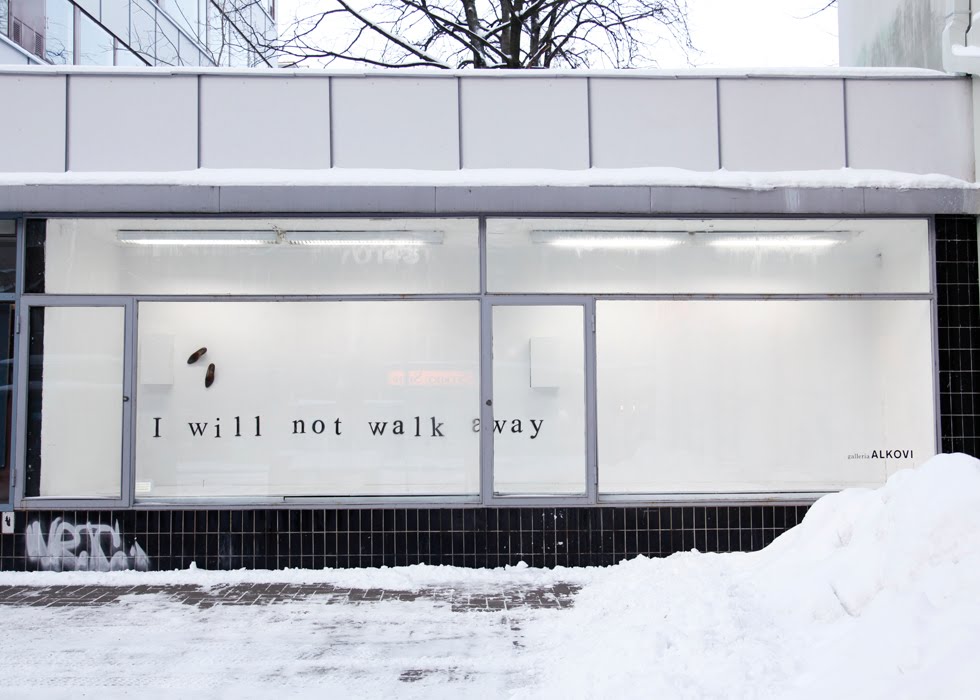
KETTU 2000: Emma Suominen, Pinja Sormunen (nyk.Valja) & Vanessa Virmajoki
'I will not walk away'
[FIN] Joulukuun aikana jouluun saakka joka päivä (Galleria) Alkoviin ilmestyi uusi pari kenkiä. Kengät asettautuivat jonoon gallerian sisällä. Kengät oli kerätty lahjoituksina ja 24.päivä joulukuuta jono purettiin ja kengät lahjoitettiin joulupataan.
[ENG]In December 2009 Kettu 2000 - collective presented an installation in Alkovi (Gallery) called 'I will not walk away'. Every day until christmas a new pair of shoes appeared. They were placed in to an installation that was demolished at 24.12 and shoes were donated to a charity christmas pot.
TOP / YLÖS
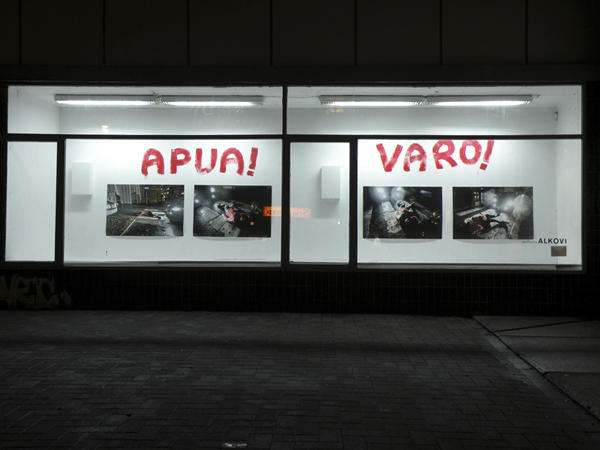
SARI TERVANIEMI:
Memento Mori [Latin, = remember you must die]
[FIN] Sari Tervaniemen Memento Mori -valokuvasarja käsitteli liikenneturvattomuutta. Päivittäin aggressiiviset autoilijat muistuttavat jalankulkijoita ihmisen kuolevaisuudesta. Helsingin Kaupunkisuunnitteluviraston mukaan Helsingissä tapahtui vuonna 2008 yhteensä 562 henkilövahinkoihin johtanutta liikenneonnettomuutta. Edellisvuodesta henkilövahinko-onnettomuudet lisääntyivät 7 %. Liikenne väheni vastaavana ajankohtana vajaa 2 %. Vuoden 2006 jälkeen henkilövahinkojen määrä on alkanut kasvaa. Vuonna 2008 Suomessa kuoli liikenteessä ennakkotietojen mukaan 343 henkilöä.
[ENG] Sari Tervaniemi's photography series Memento Mori dealt with unsafety in traffic. Aggressive drivers remind pedestrians daily of human mortality. According to Helsinki City planning department there was 562 accidents leading to bodily injuries in 2008. From previous year accidents with bodily injuries increased by 7 %.Traffic decreased in the same period about 2 %. After year 2006 there has been a increase in bodily injuries. In the year 2008 according to preliminary records 343 people died in traffic.
TOP / YLÖS
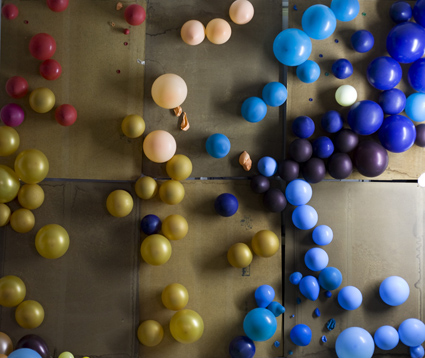
PAULA LEHTO:
Matka Mustaan
[FIN] Matka mustaan [The way to black] oli biologisesti muuntuva installaatio. 'Matka mustaan' oli rakennettu banaaneista Kazimir Malevitsin Mustaa neliötä mukaillen. Banaaninkuoriin muodostui jatkuvasti uusia kuvioita ja lopulta kuviot katosivat kaiken imevään mustaan.
Kesäkukat [Summer flowers]lakastuvat ja maatuvat talven tullen. Teoksessa ilmapallot tyhjenevät kuukauden kuluessa jääden lepäämään lakastuneiksi pusseiksi vaneripeltoon.
[ENG] 'The way to black' was a biologically changing installation. It was constructed of bananas as to imitate Kazimir Malevit¨ Black Square in the end turning entirely black.
Summer Flowers fade away in to the ground as summer ends. In the work 'Summer Flowers' balloons deinflate within a month, in the end remaining lying on the field of cardboard.
TOP / YLÖS

KONSTA OJALA
[FIN] Kuvataiteilija Konsta Ojalan valokuvia sisältävä näyttely.
[ENG] A photography exhibition by artist Konsta Ojala.
TOP / YLÖS

PAULA LEHTONEN & SAARA PIISPA:
A Landscape Called Bandung
[FIN]Bandungissa Indonesiassa keväällä 2009 toteutetun työpajan aikana Piispa ja Lehtonen etsivät oppilaidensa kanssa kaupungista henkilökohtaisesti merkityksellisä paikkoja ja valmistuvat näihin paikkoihin omatoimisesti tehtyjä monumentteja. Monumentit saatoivat olla esineitä, veistoksia tai eleitä, jotka kertoivat paikasta jotain oleellista. Se mikä on paikalle oleellista määräytyi henkilökohtaisten kokemusten kautta. Tuottamalla monumentteja näihin paikkoihin Piispa ja Lehtonen antoivat kaupunkilaisille mahdollisuuden vaikuttaa kaupunkikuvan hallintaa. Monumentit dokumentoitiin valokuvin. Alkovissa toteutuva näyttely koostuu työpajan aikana tehdyistä valokuvista.
[ENG]The exhibition featured works from "A Landscape called Bandung" workshop. Artists from the workshop in Indonesia explored their hometowns for places that held a personal significance for them, and created temporary monuments there. Loosely defined, a monument could be anything from an object to a sculpture, to a gesture; as long as it related a feel for the place it was in. These artists took part in constructing their own cityscape and explored different ways of experiencing the city. These monuments were seen as photographs in Alkovi gallery.
TOP / YLÖS
xxx_ryhmä:
Momentteja xxx_ryhmä: / xxx_group: Paula Lehtonen, Pekka Ruuska, Eero Yli-Vakkuri, Inga Mustakallio.
[FIN] Alkovi (galleriassa) toteutui URB 2009 -festivaalin aikana kaksiosainen Momentteja-kaupunkitapahtuma. URBin avajaispäivänä 30.09.2009 xxx_ryhmä teki pitkäkestoisen Kallioon soluttautuvan esityssarjan, jossa esitykset kehittyivät Kallion ehdoilla. xxx_ryhmä etsi kaupunginosasta paikkoja, jotka toivat esiin kalliolaisille merkityksellisiä yksityiskohtia ja paikallisia tapoja. Paikkojen innoittamana ryhmä tekei niihin sopivia ja tilapäisiksi monumenteiksi muotoutuvia esityksiä. Työt videoitiin, editoitiin ja esitettettiin Alkovissa, joka toimi kohtaamispaikkana tapahtuman ajan. Esitysten paikkatiedot välittyivät Alkovin ikkunan GPS-laitteilla.
[ENG] As part of URB 2009 -festival programme, Alkovi (gallery) featured a two-part urban event called MOMENTTEJA (Moments). On July 30th, at the festival's opening day, XXX_ group put on a set of performances, immersed in the Kallio neighbourhood. Performances progressed on Kallio's terms: XXX_ group searched for sites and venues in the Kallio district that held meaning for its inhabitants. Inspired by these places, the group created a performance that took the form of a temporary monument befitting its surroundings. Captured on film and edited, performances were then displayed at Alkovi. In addition to screening the videos, Alkovi acted as a meeting ground for anyone interested in talking to the group behind the performances.
TOP / YLÖS
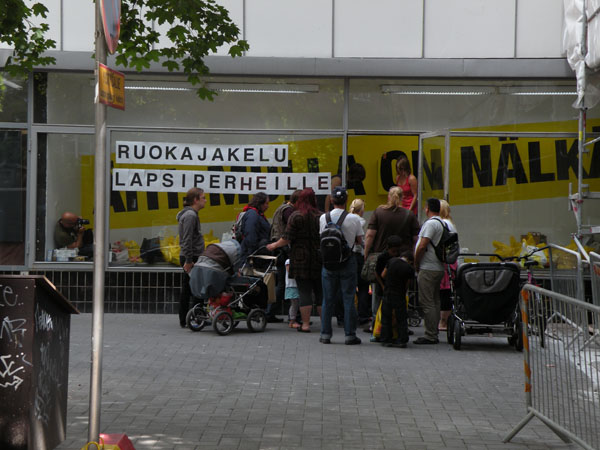
RIIKKA KUOPPALA:
Äiti, mulla on nälkä! / Mom, I'm hungry!
[FIN] 'Äiti, mulla on nälkä!' näyttely kiinnitti huomiota lasten köyhyyden lisääntymiseen Suomessa. Ikkunagalleria Alkovi sijaitsee Kallion Helsinginkadulla Veikko ja Lahja Hurstin laupeudentyö ry:n ruuan jakelupisteen vieressä, missä kesäkuun 2009 viimeinen ruokajakelu keräsi ennätysmäärän jonottajia. Leipäjonon ollessa kesätauolla kuvataiteilija Riikka Kuoppala keräsi Alkovin näyteikkunaan lahjoituksista koostuvan ruokainstallaation, joka näyttelyn lopuksi jaetaan apua tarvitseville lapsiperheille. Teoksella Kuoppala pyrki nostamaan esille kysymyksen Suomeen kehittyvästä lasten luokkayhteiskunnasta. Kuoppala kysyi kenen vastuulla on pitää huolta siitä, että kaikilla Suomen lapsillaon ruokaa? Kun joka kymmenes suomalaislapsi elää köyhyysrajan alapuolella. Ja kun leipäjono on kesätauolla, kuka ruokkii köyhät? Ikkunaan kerätty ruoka jaettiin perjantaina 24.7.2009 klo 12.
[ENG] People were invited to take part in buiding an installation by donating dried or canned food which does not require cold temperature in order to keep eateable. on July 2009 the exhibition in Galleria Alkovi paid attention to the increasing poverty of children in Finland. The window (gallery) Alkovi is situated next to the food donation organization of Veikko and Lahja Hursti on Helsinginkatu. While the center was taking a break in July, the artist Riikka Kuoppala collected food to the Alkovi's window space. At the end of the exhibition, the food was distributed to families with small children. Kuoppala wanted to raise questions about childrens' class society that is developing in Finland. She inquired that who is responsible of providing food to all the children? When more than ten percent of Finnish children are already living below the poverty level. And when the private organizations go on holidays, who will take care of the poor? The food in the window was distributed on July 24th 2009 at noon.
TOP / YLÖS
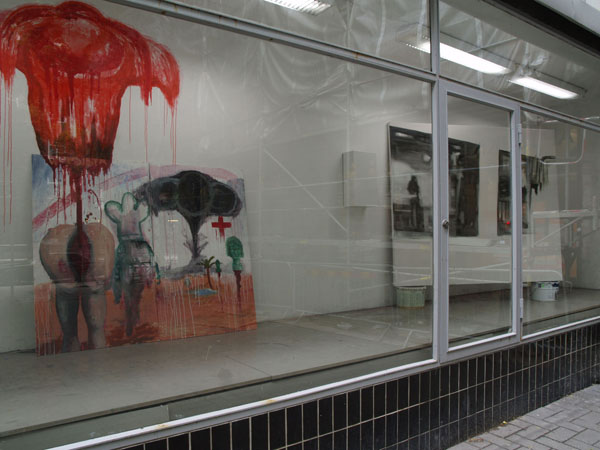
IIDU TIKKANEN & JUHANI TUOMI
Maalauksia / Paintings
[FIN] Kuvataiteilijat Iidu Tikkanen (s.1983) ja Juhani Tuomi (s.1983) pitivät yhteisnäyttelyn, jossa kummallakin oli esillä yksi teos. Tikkanen, sekä Tuomi ovat kummatkin valmistuneet Tampereen ammattikorkeakoulusta kuvataiteilijoiksi (2007) sekä myöskin tehneet Kuvataiteen Maisterin tutkinnon Kuvataideakatemiasta - Tuomi vuonna 2009 ja Tikkanen vuonna 2014.
[ENG] Artists Iidu Tikkanen and Juhani Tuomi joined in an exhibition by both presenting one painting. Tuomi and Tikkanen have graduated from Tampere University of Applied Sciences in 2007, and done their M.F.A degrees in The Academy of Fine Art in Helsinki - Tuomi at 2009 and Tikkanen at 2014.
TOP / YLÖS